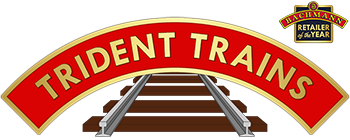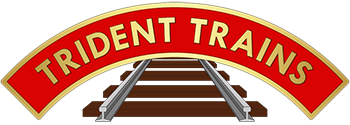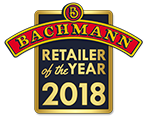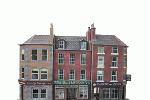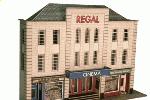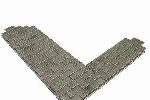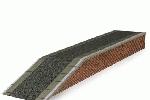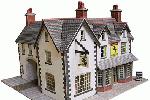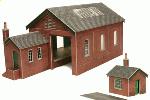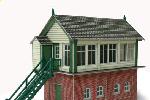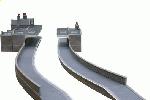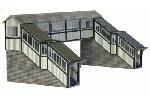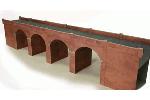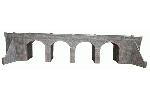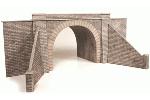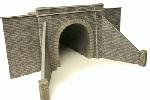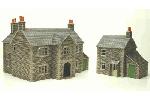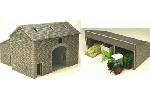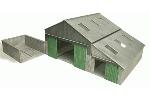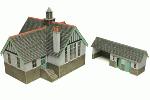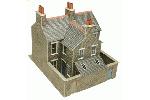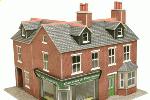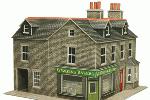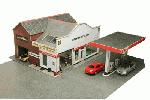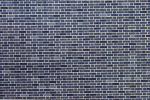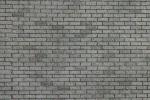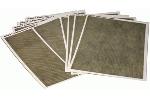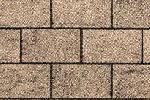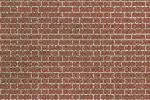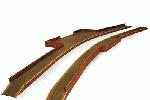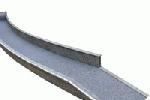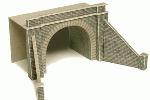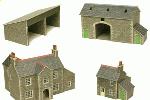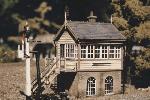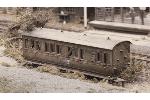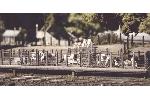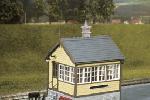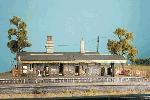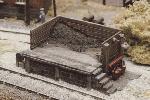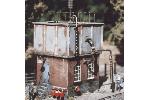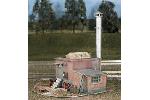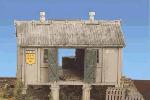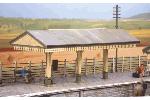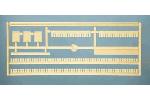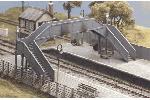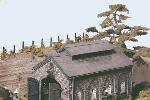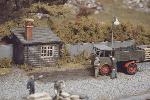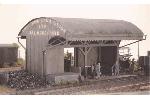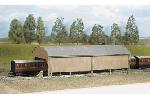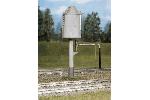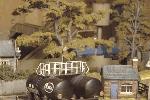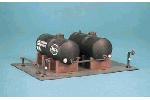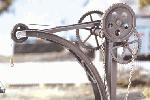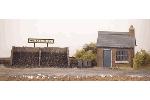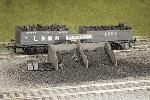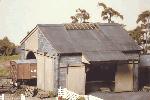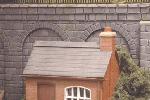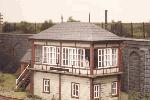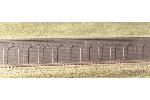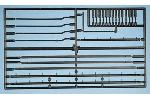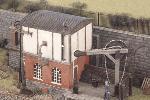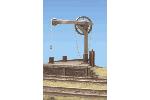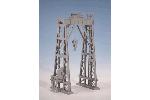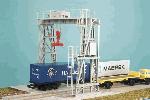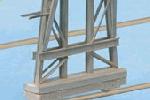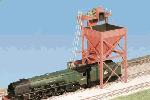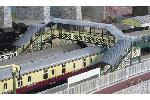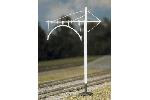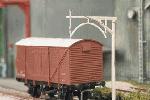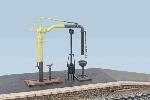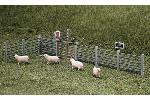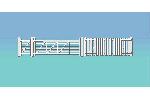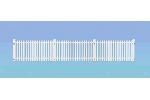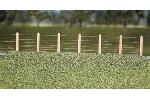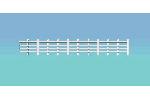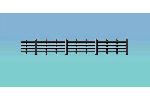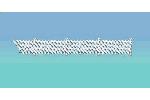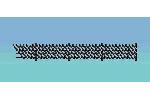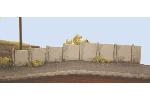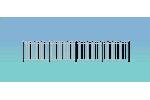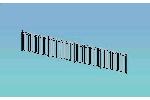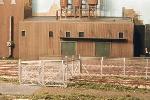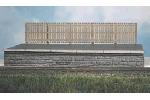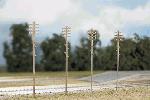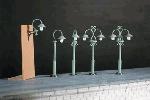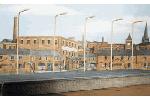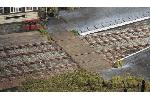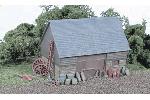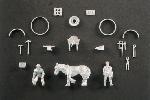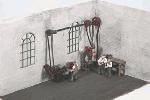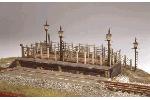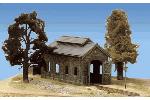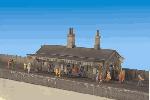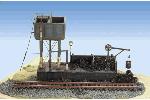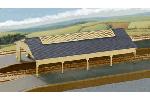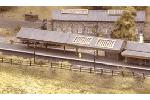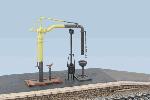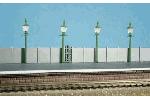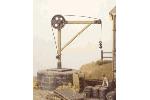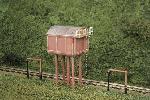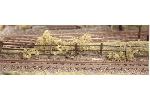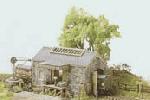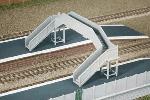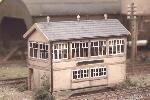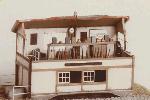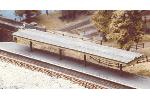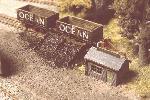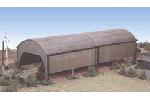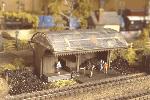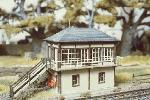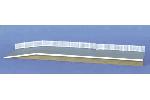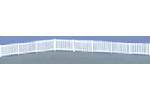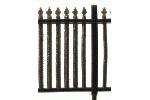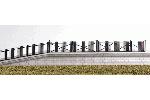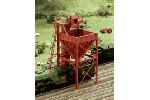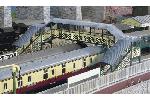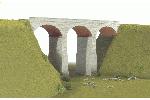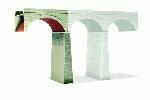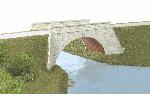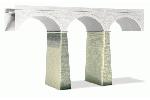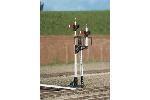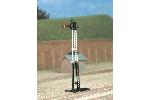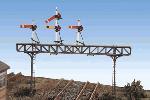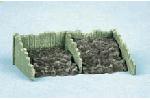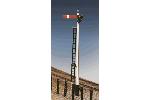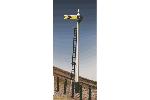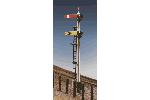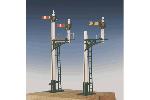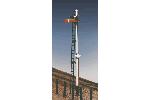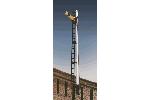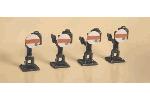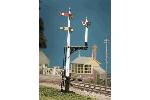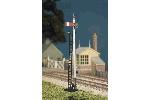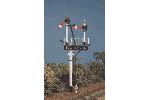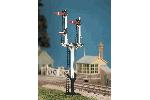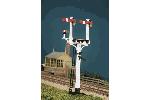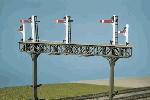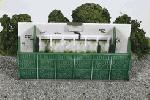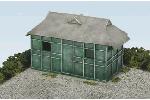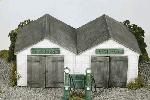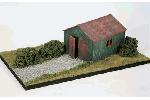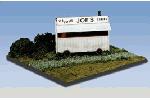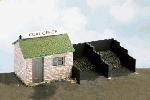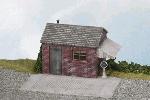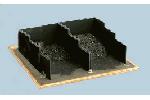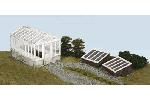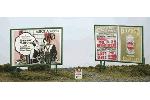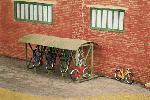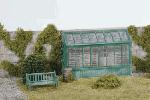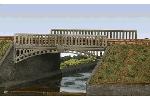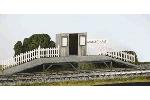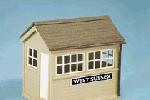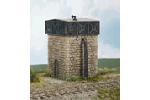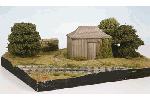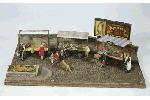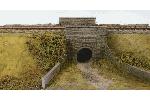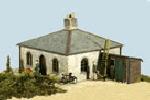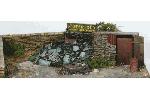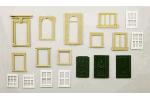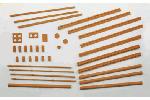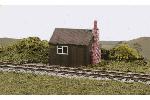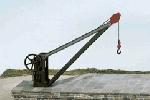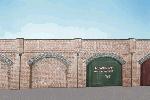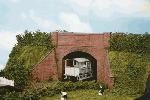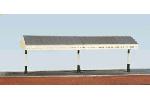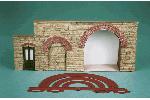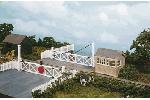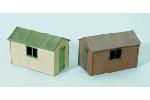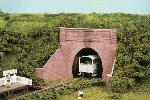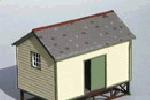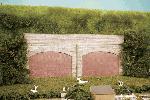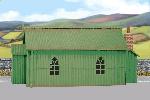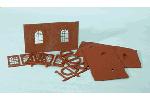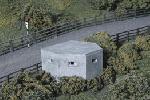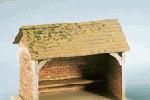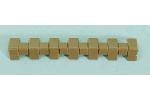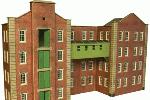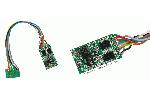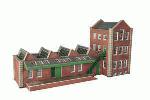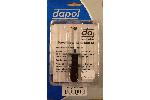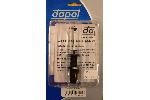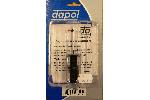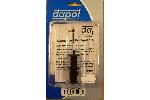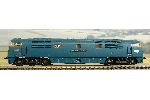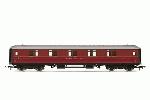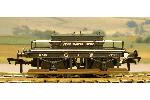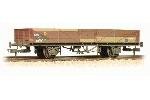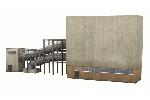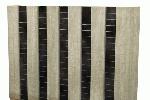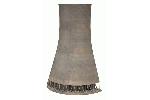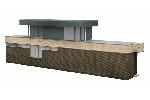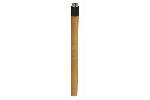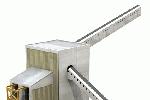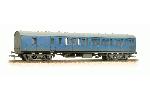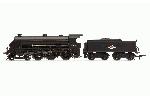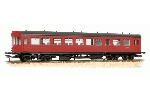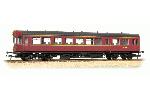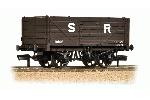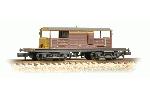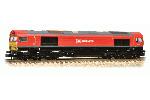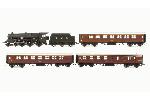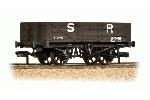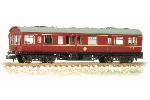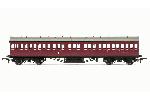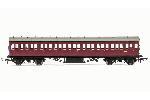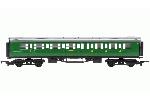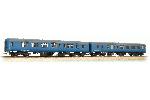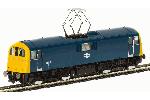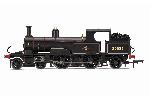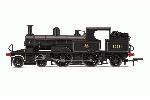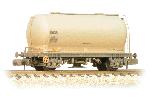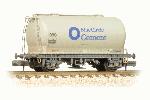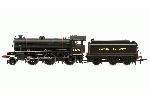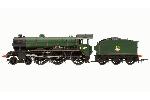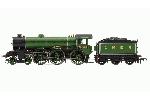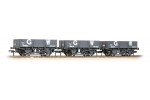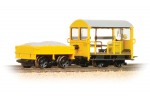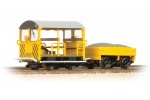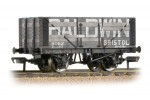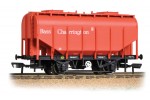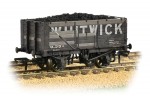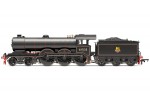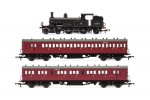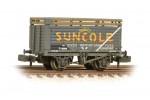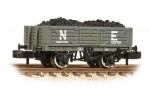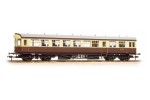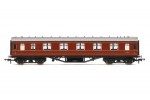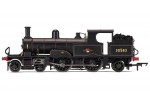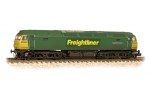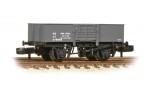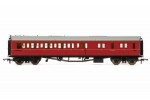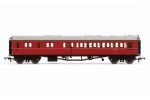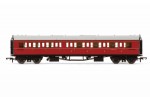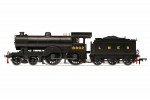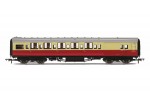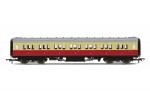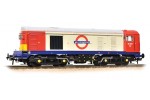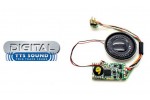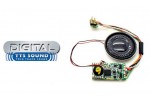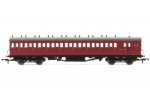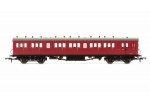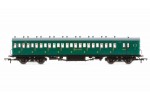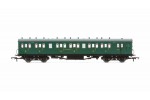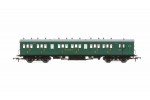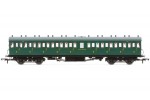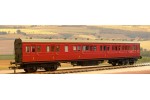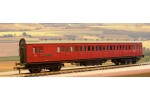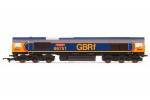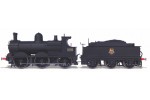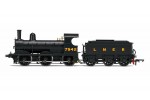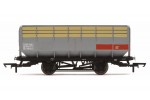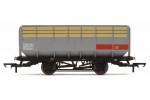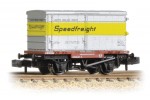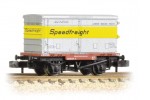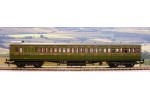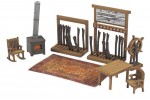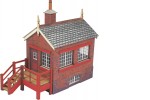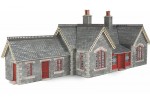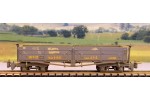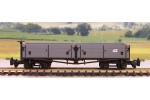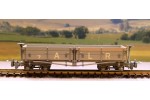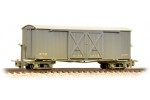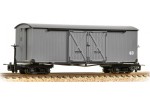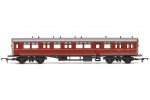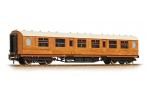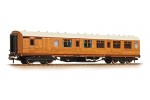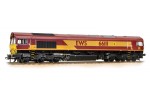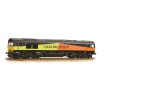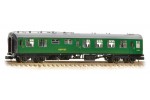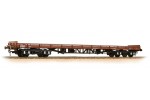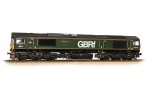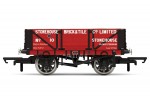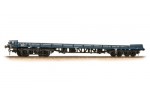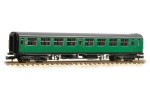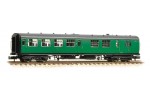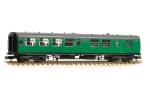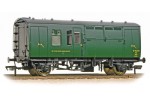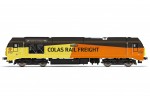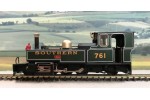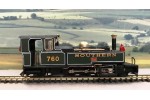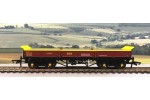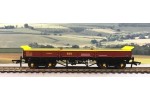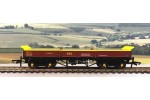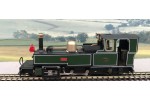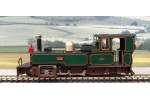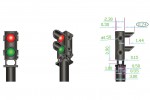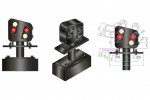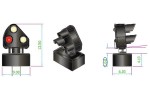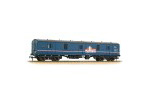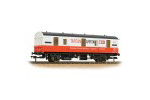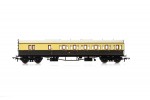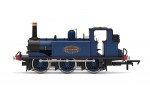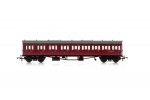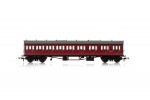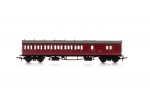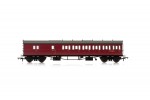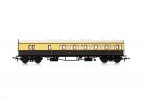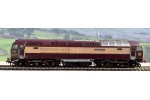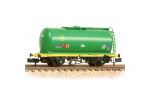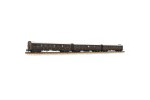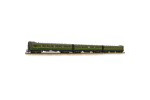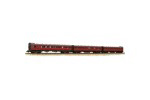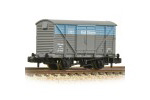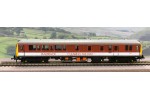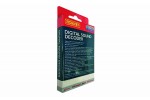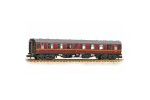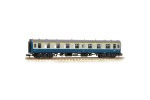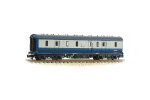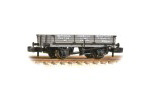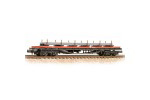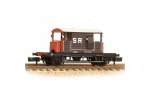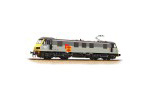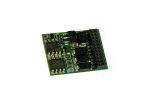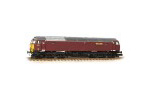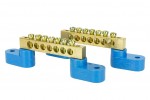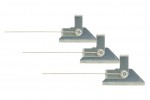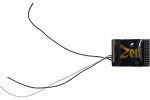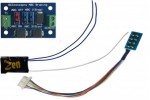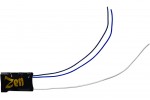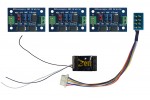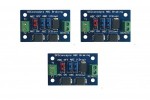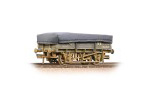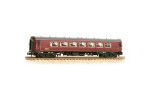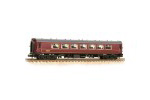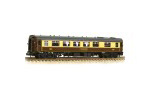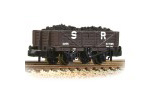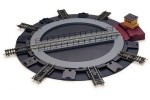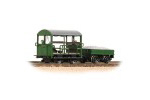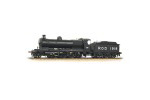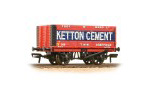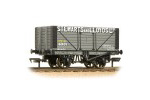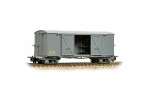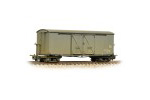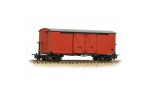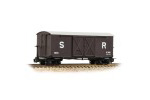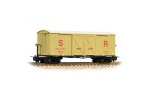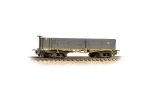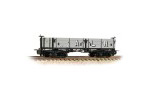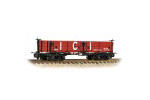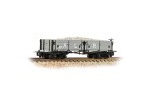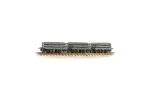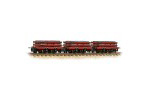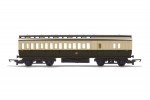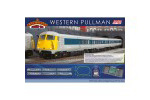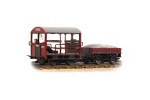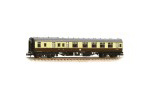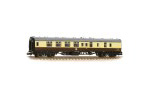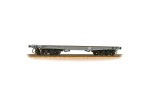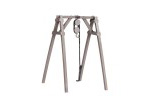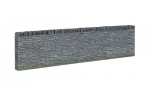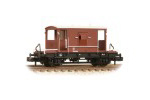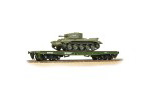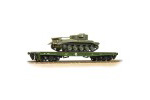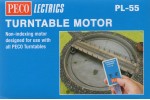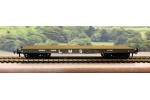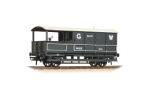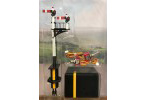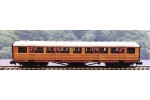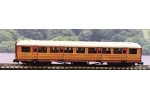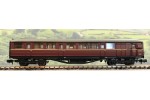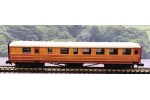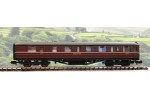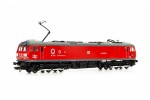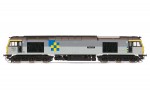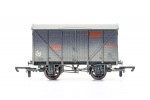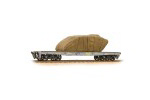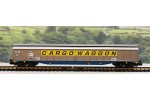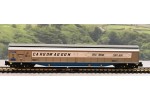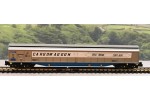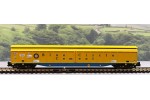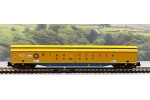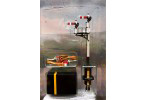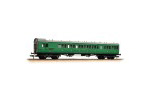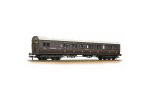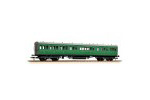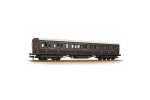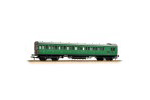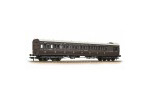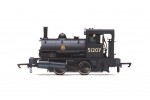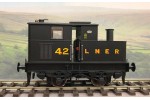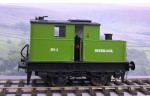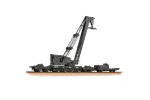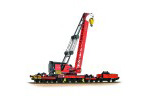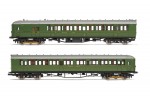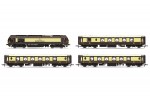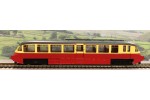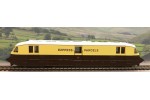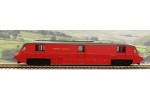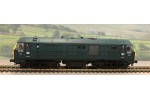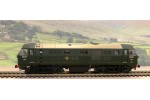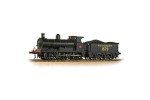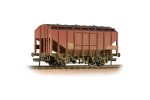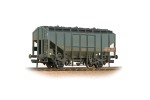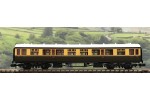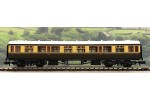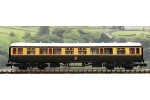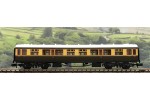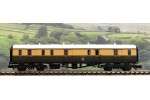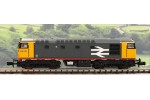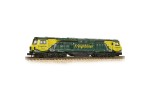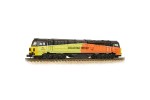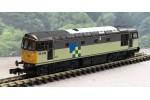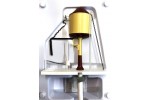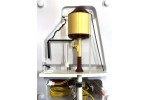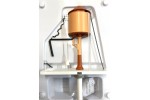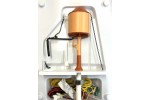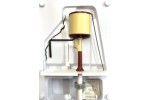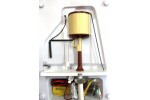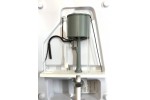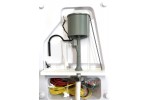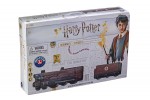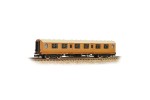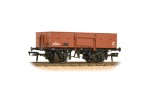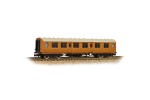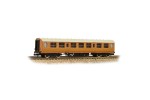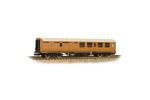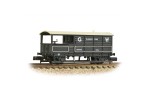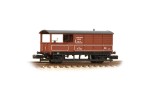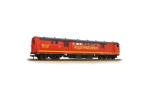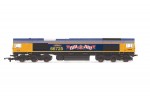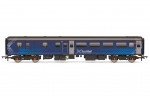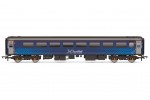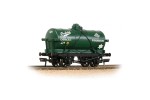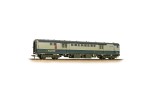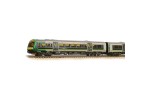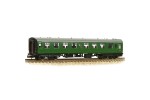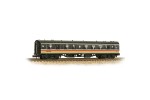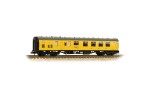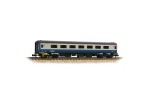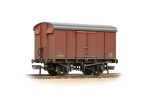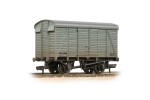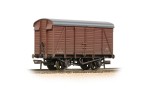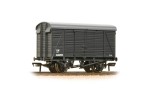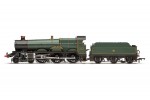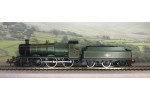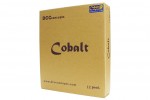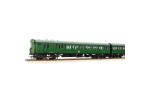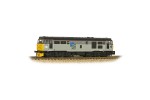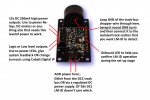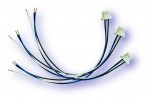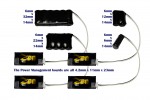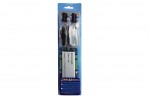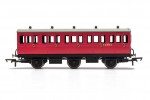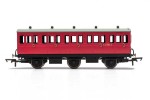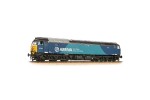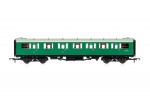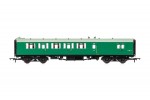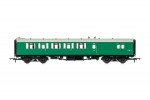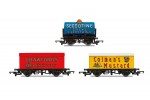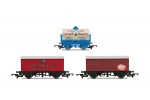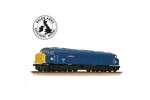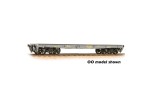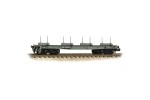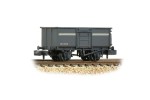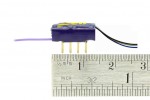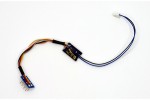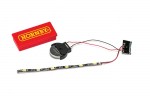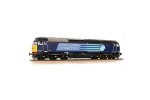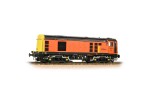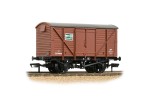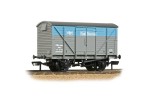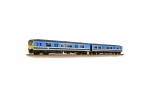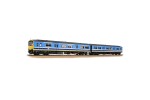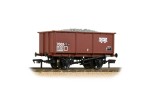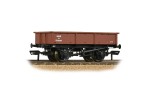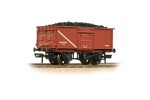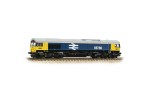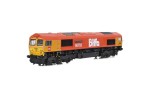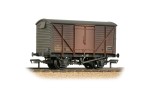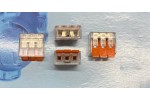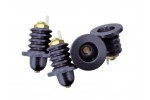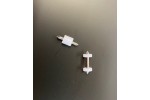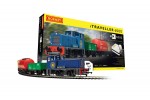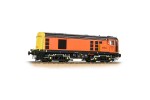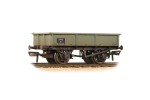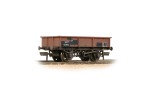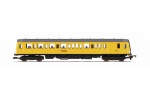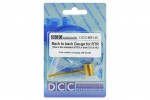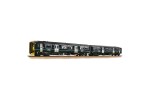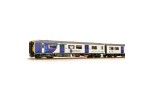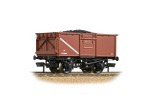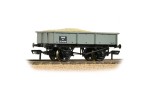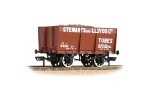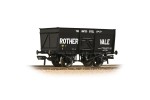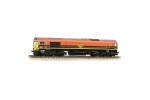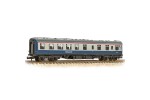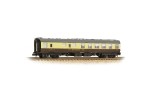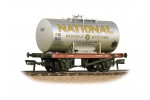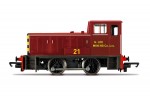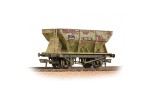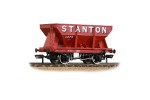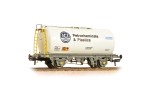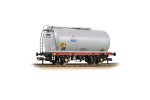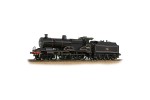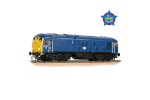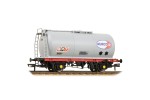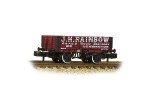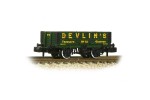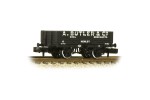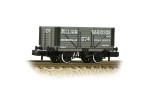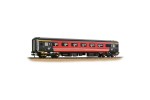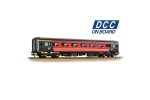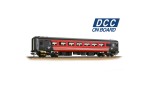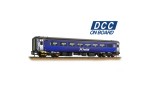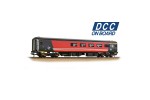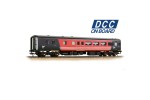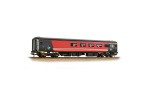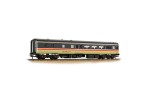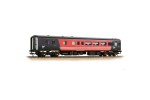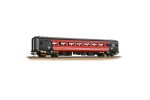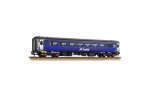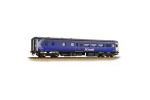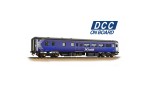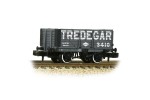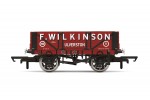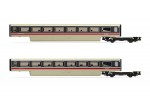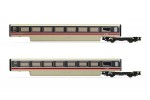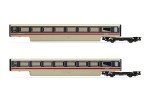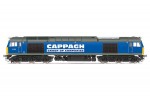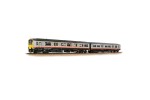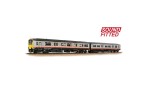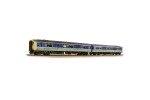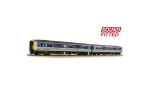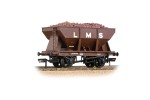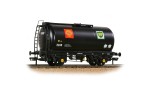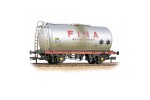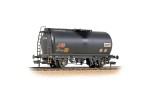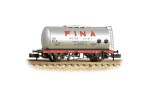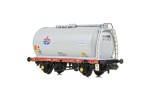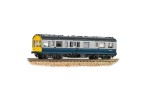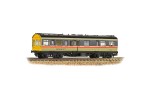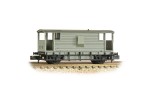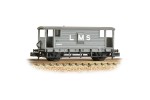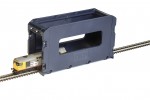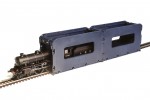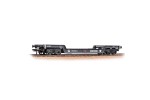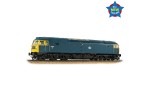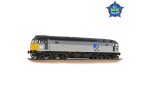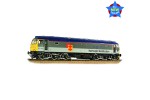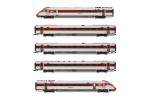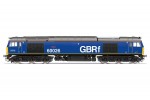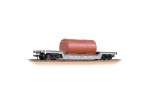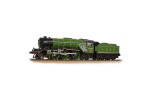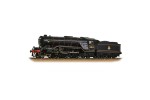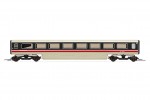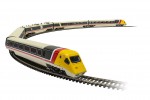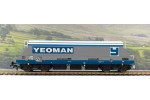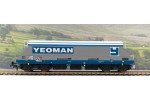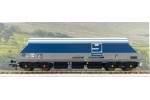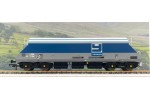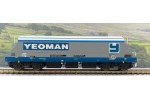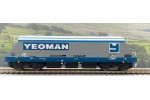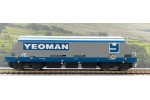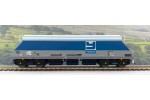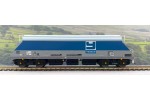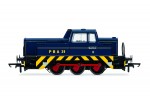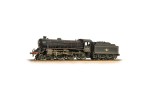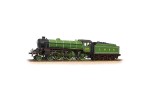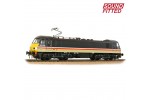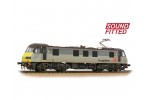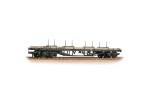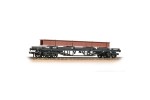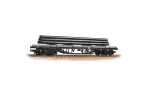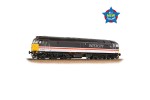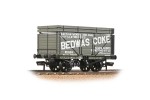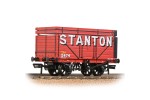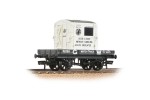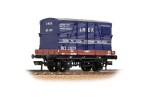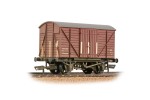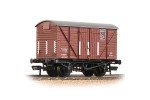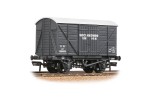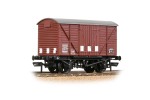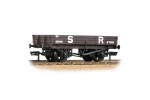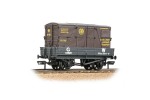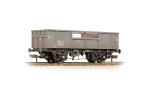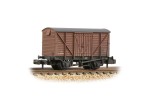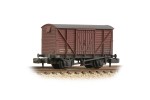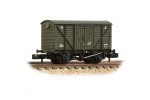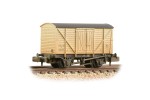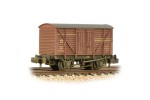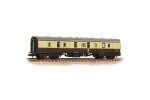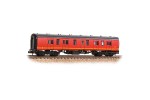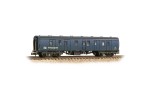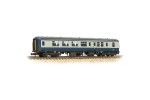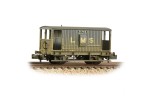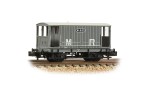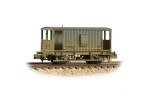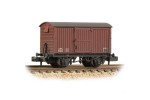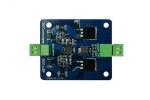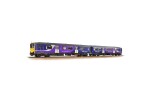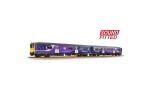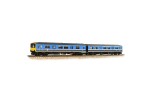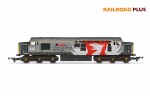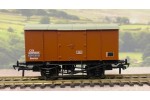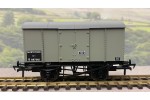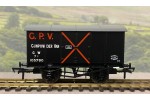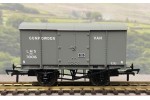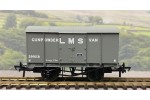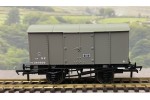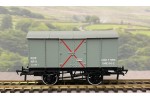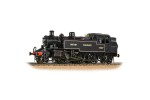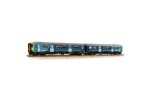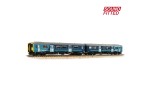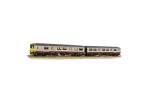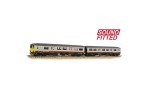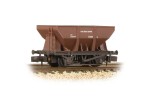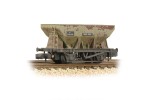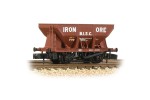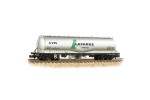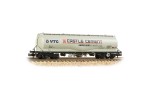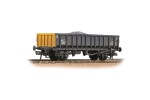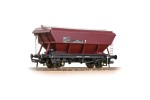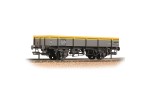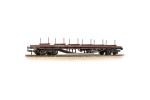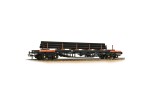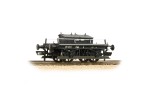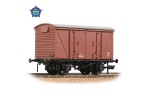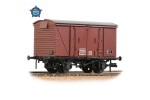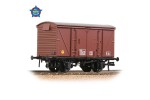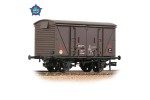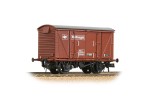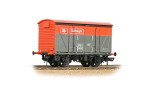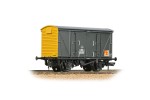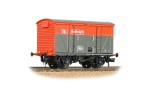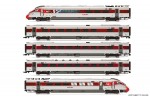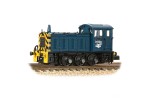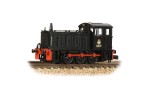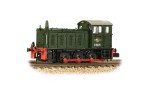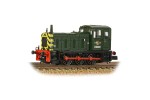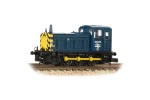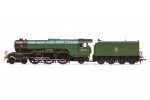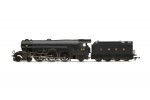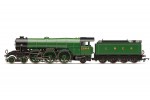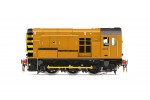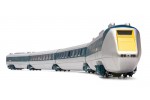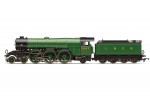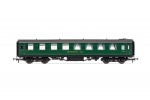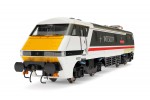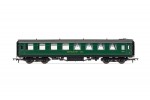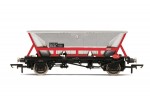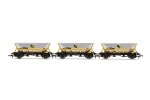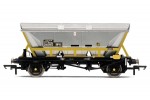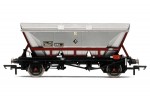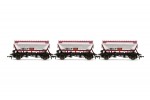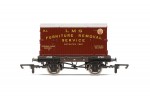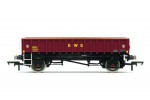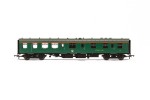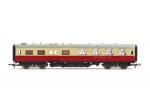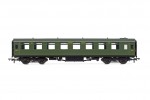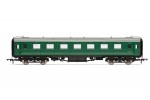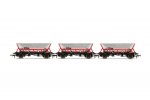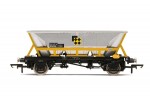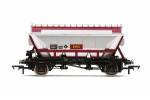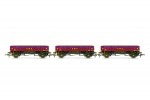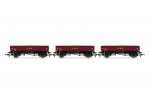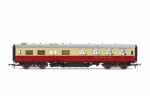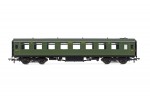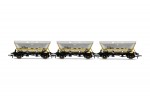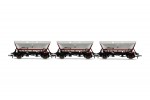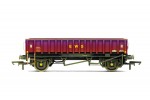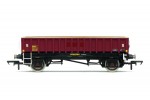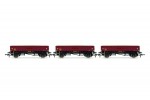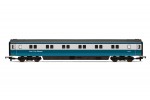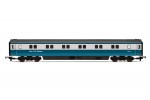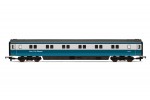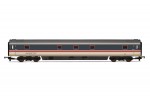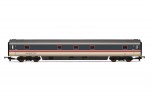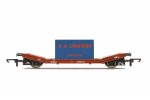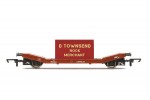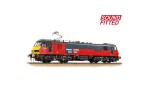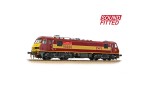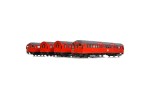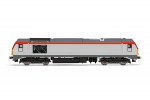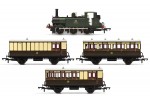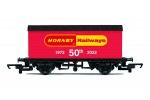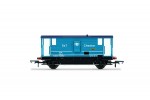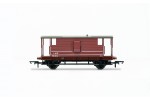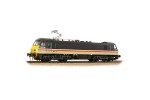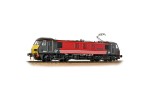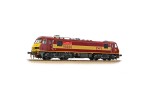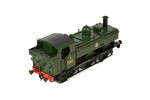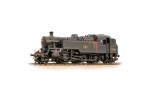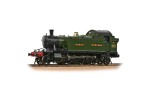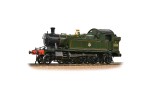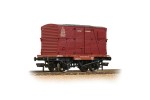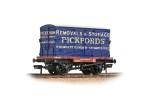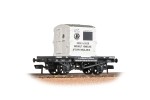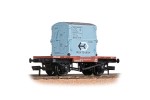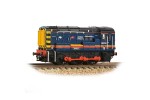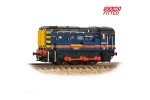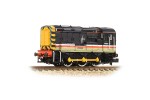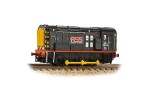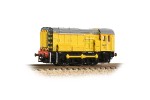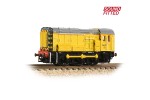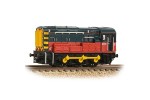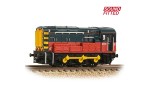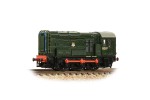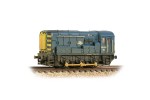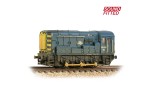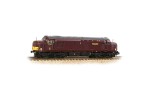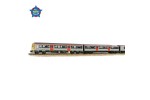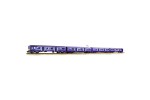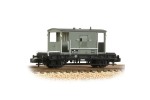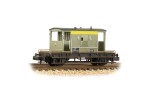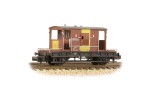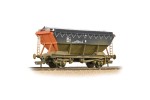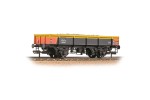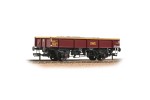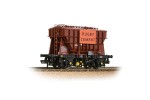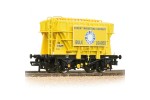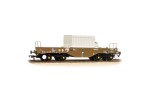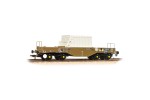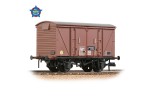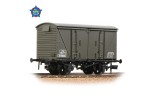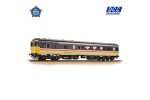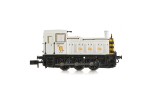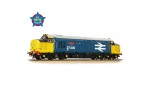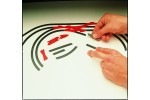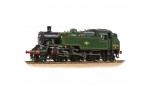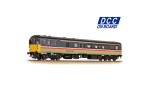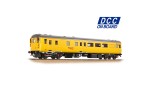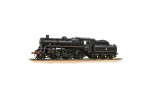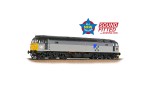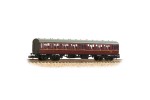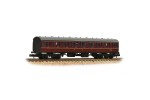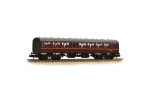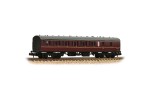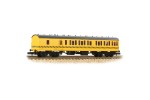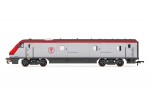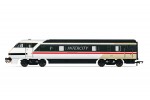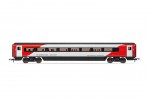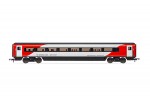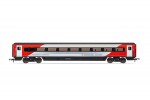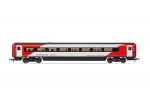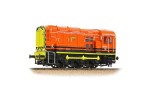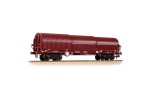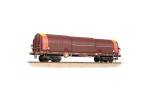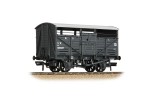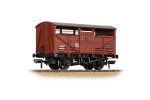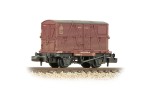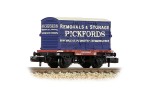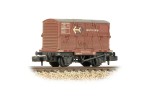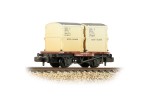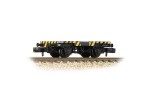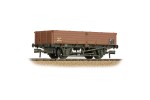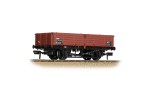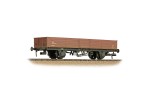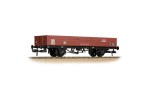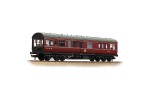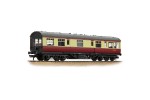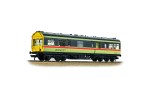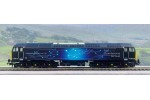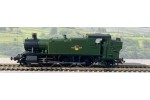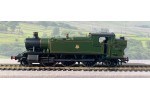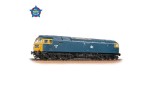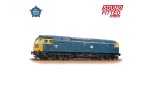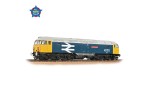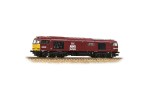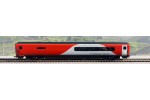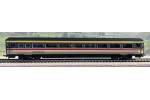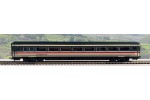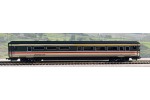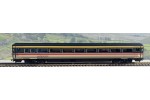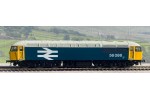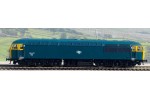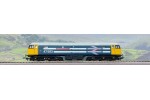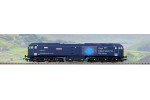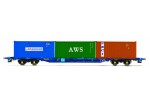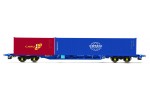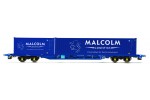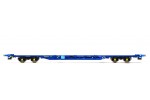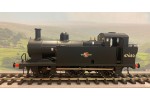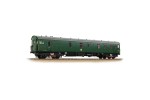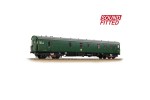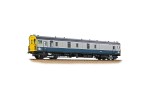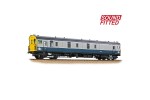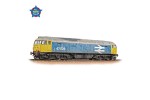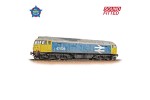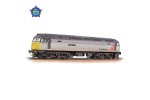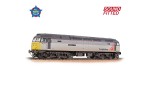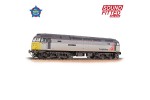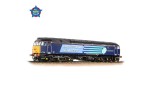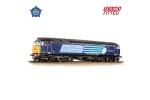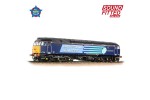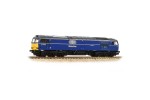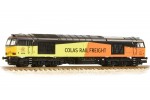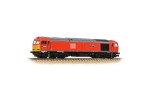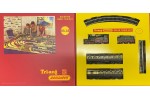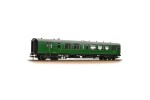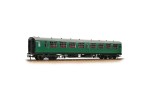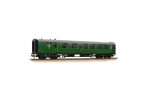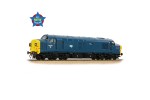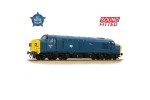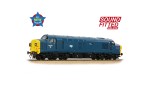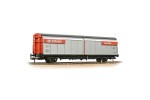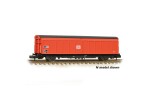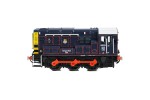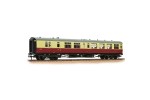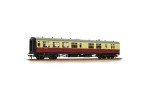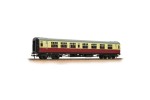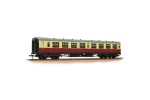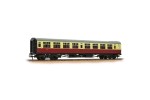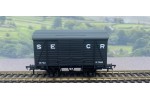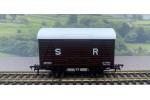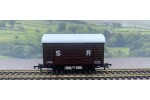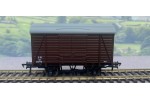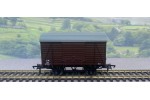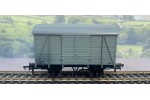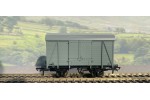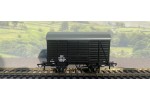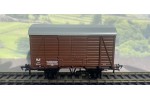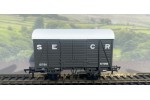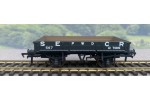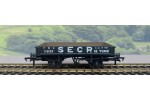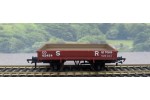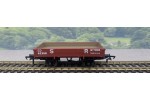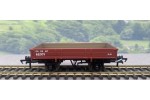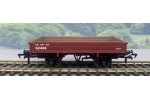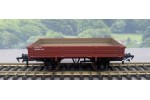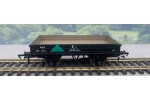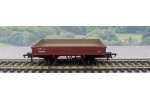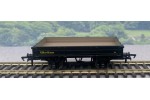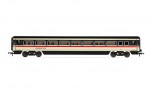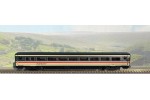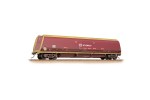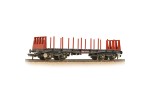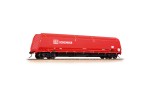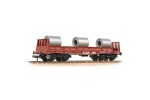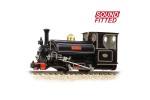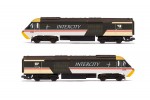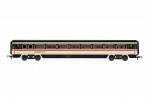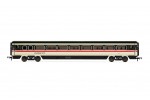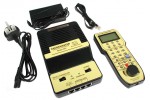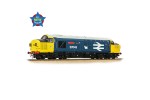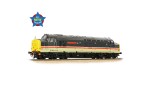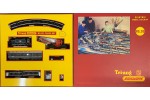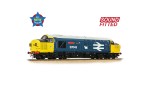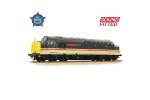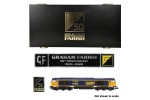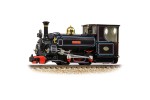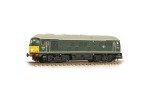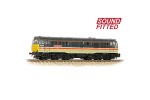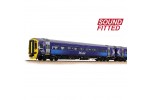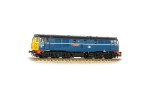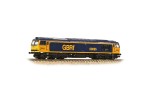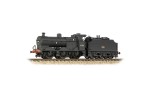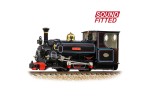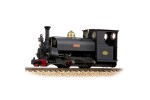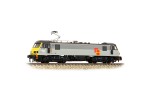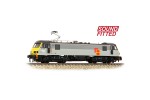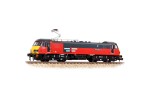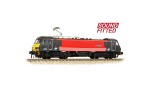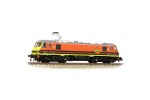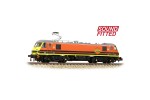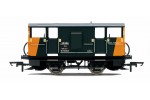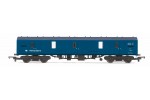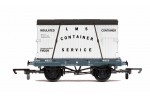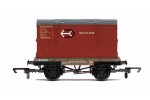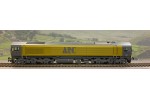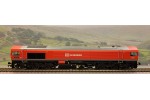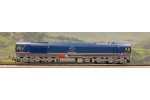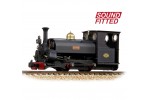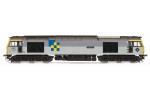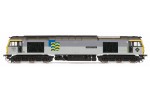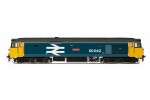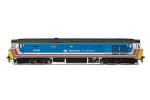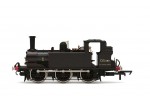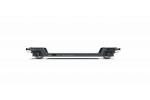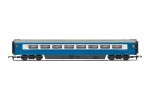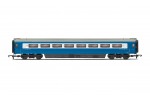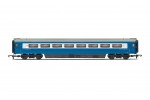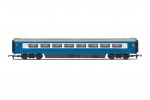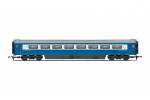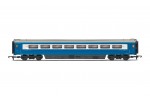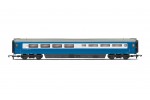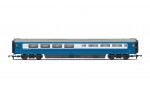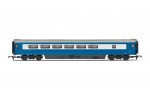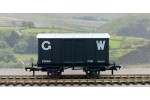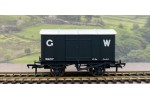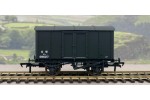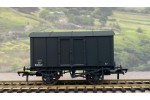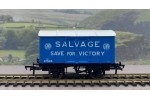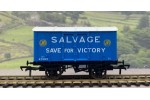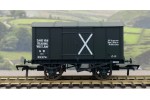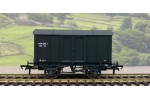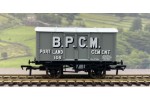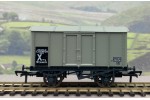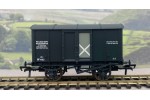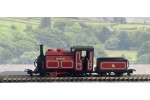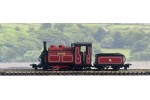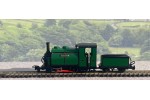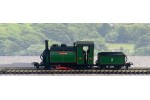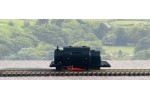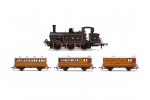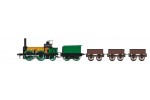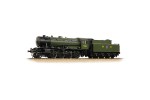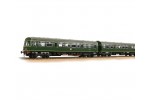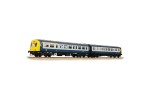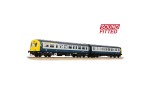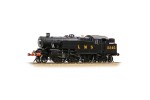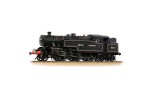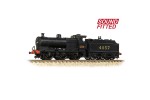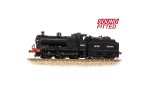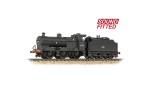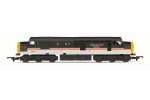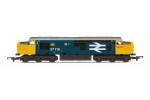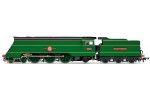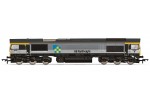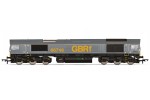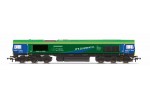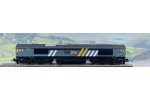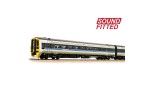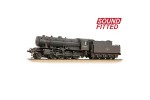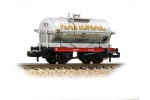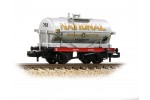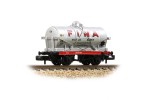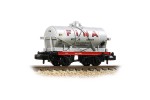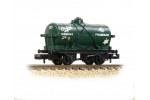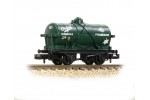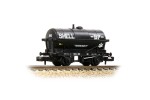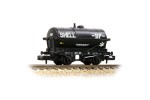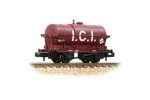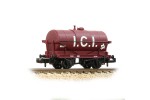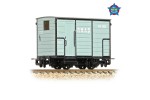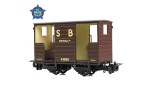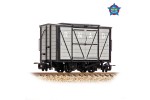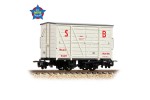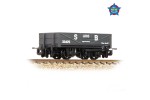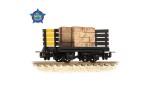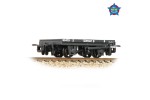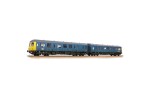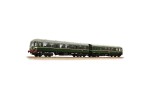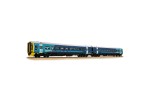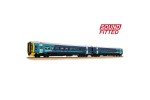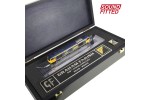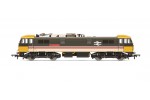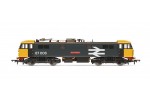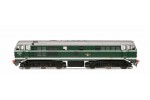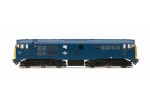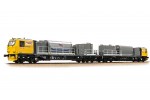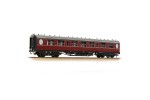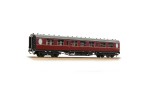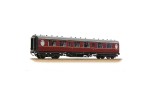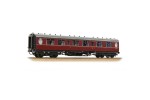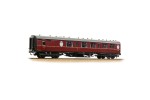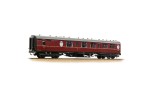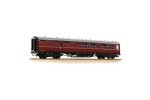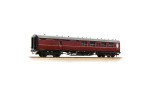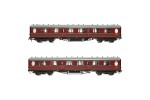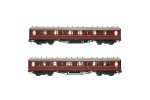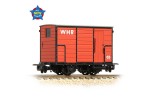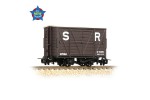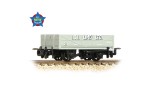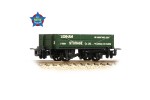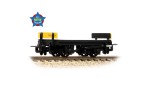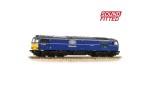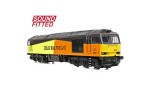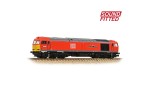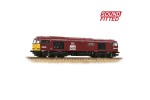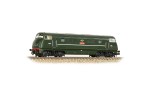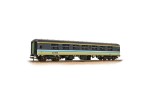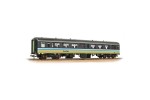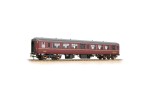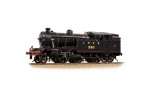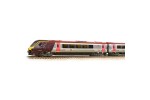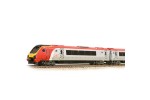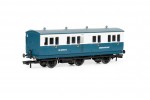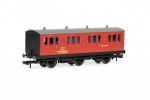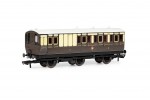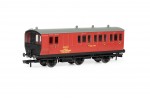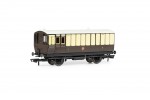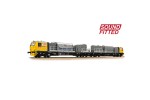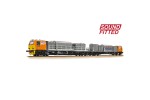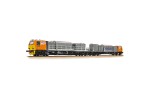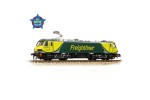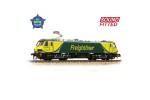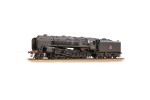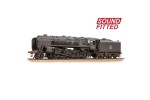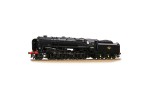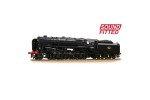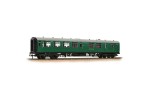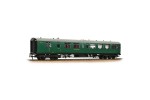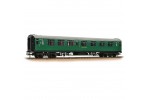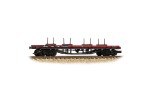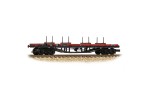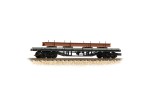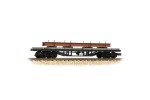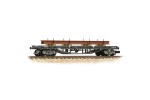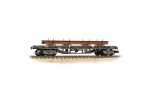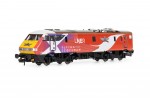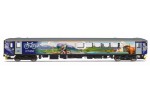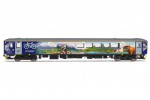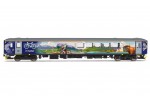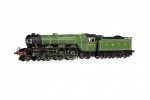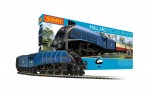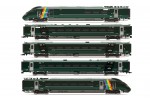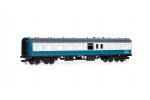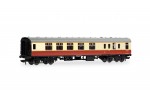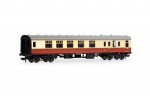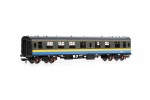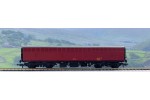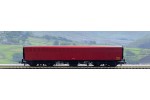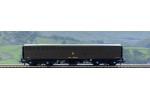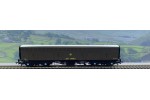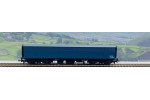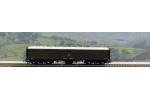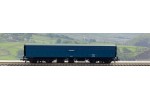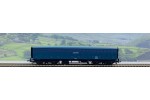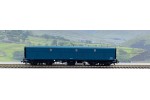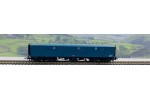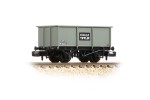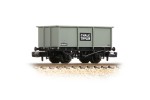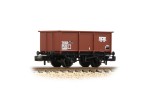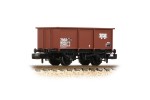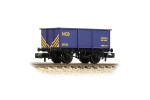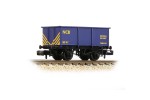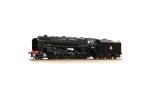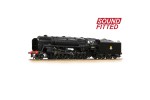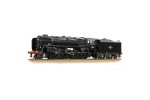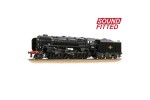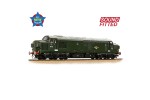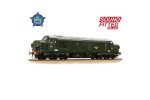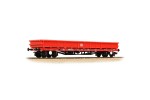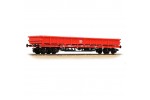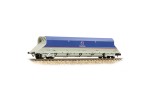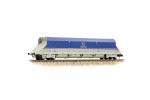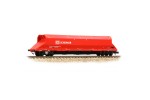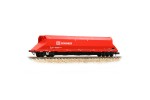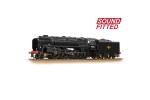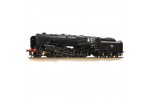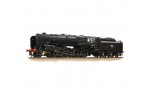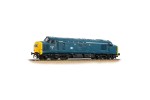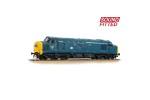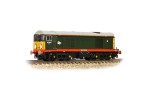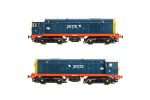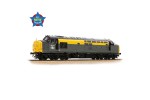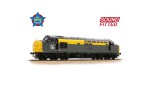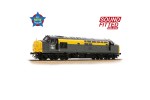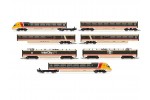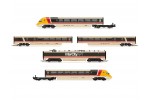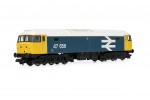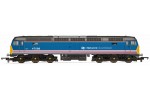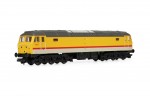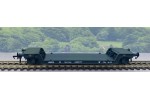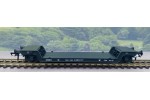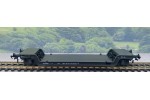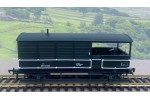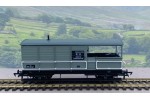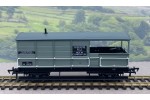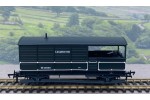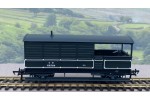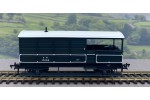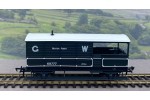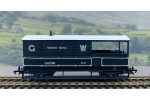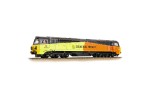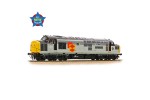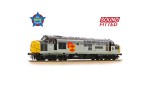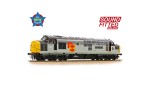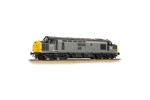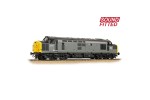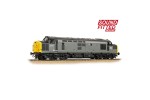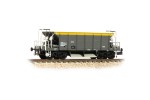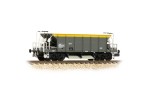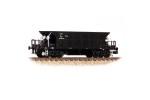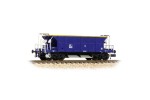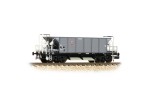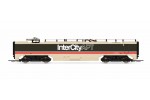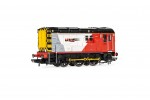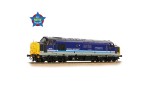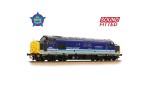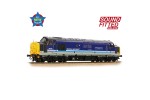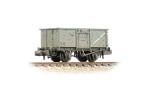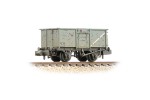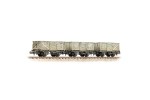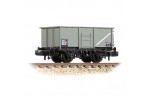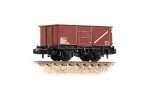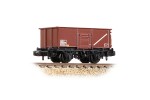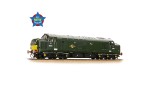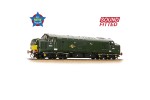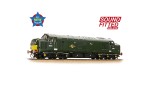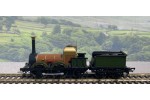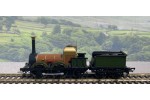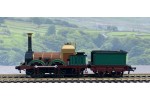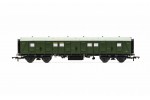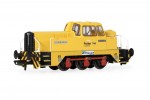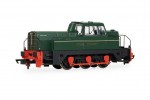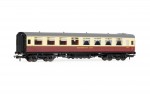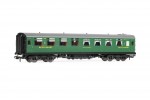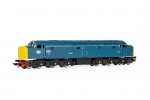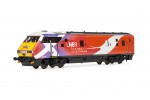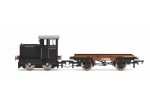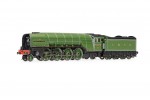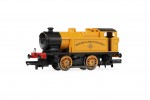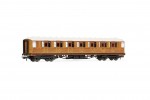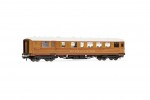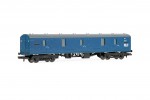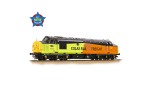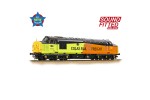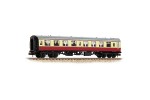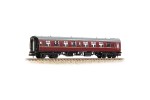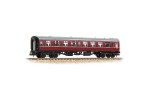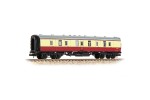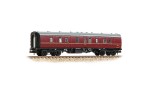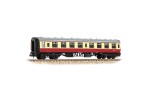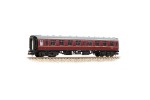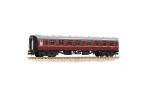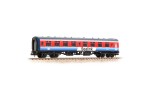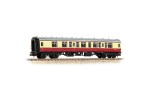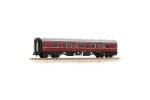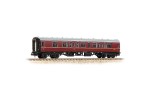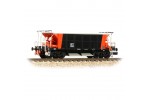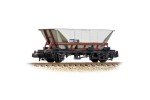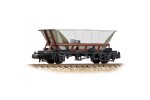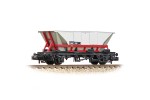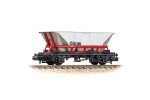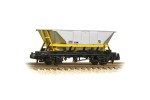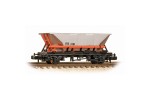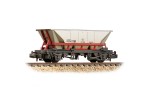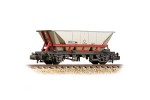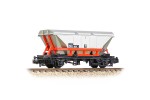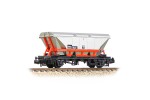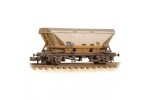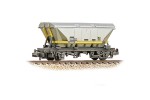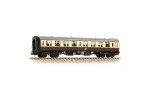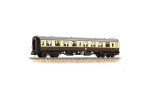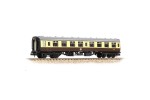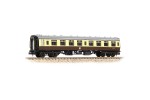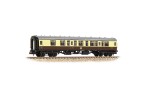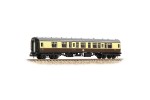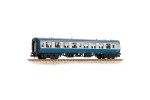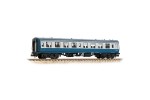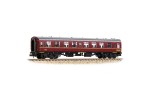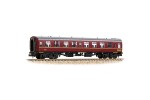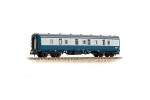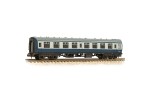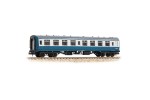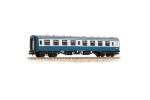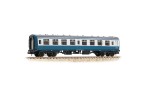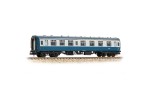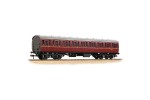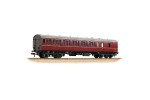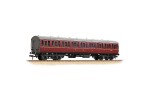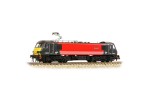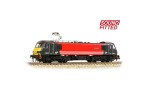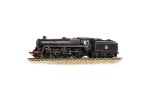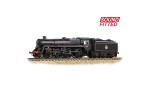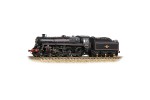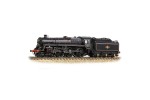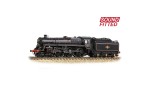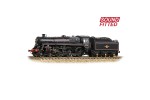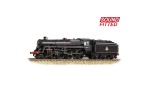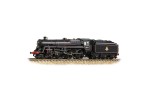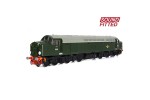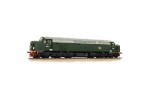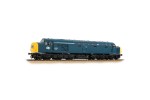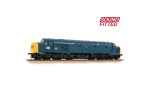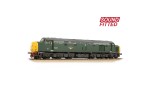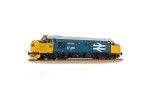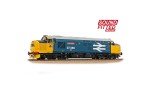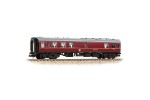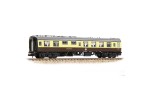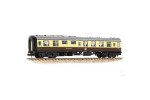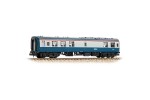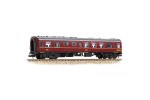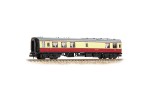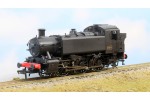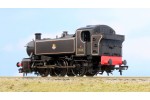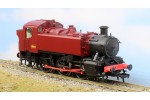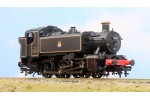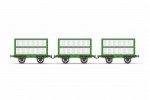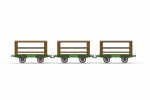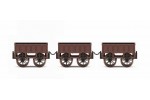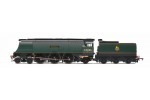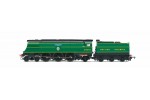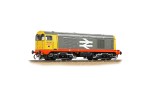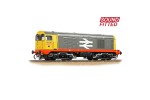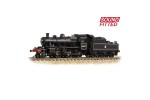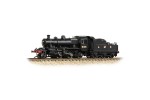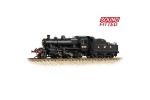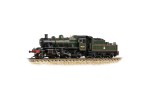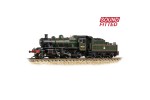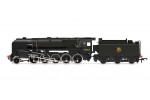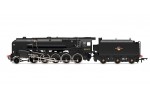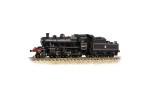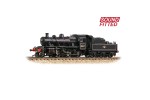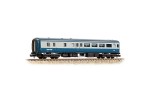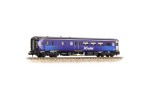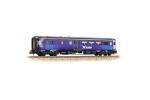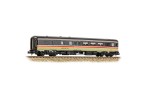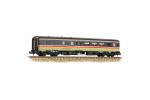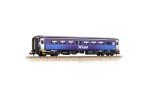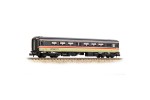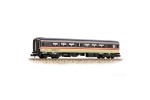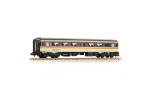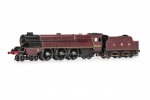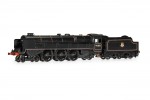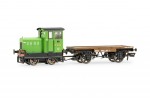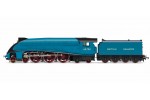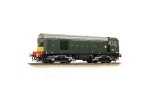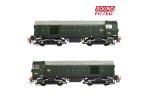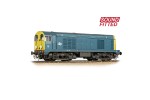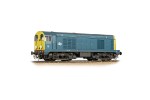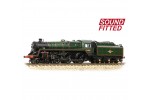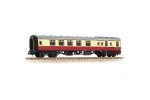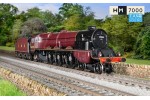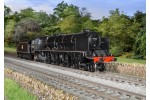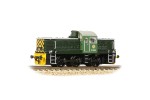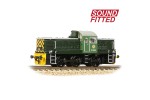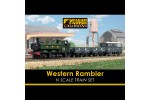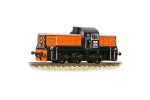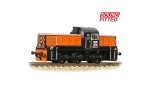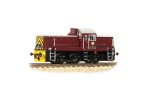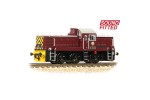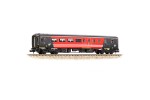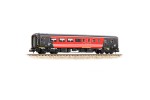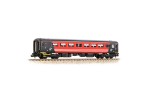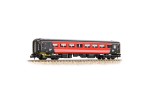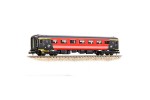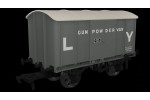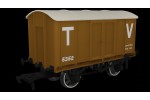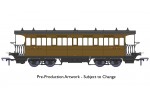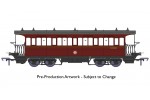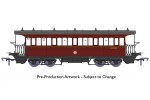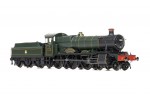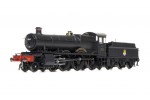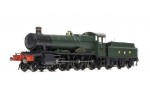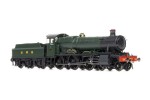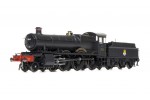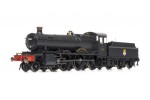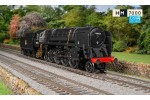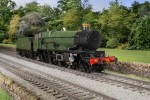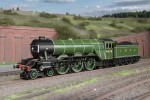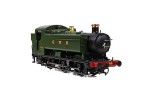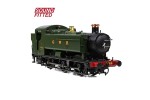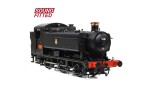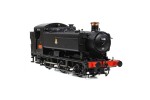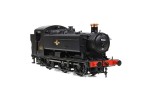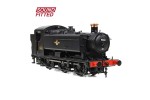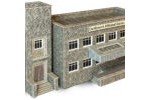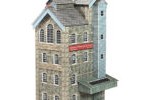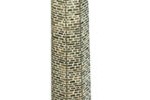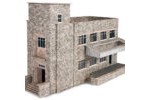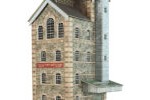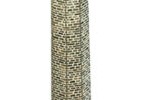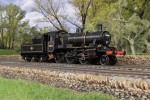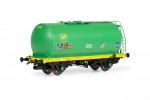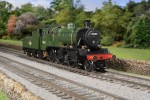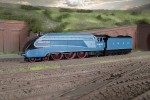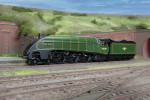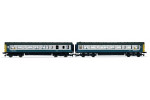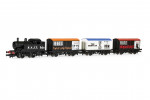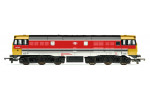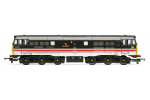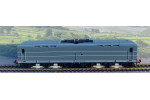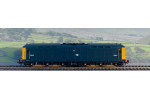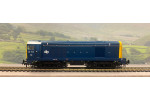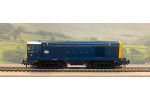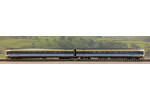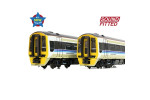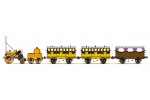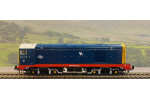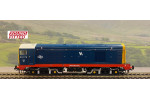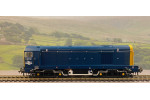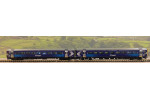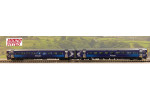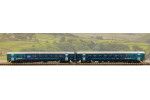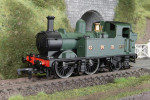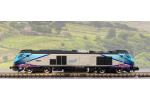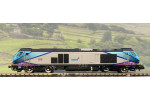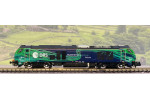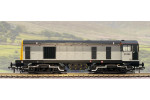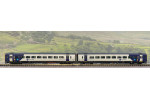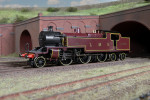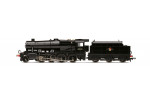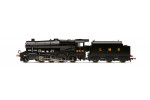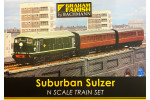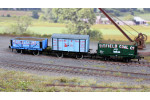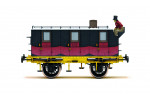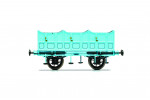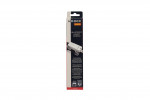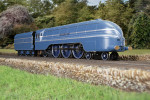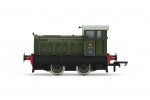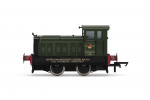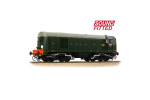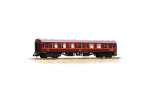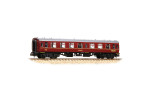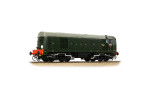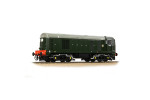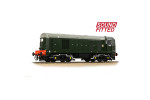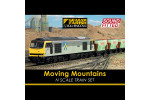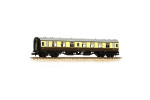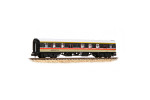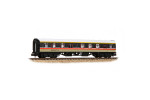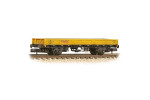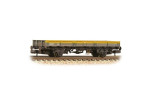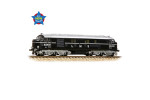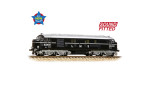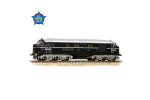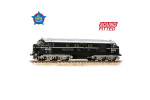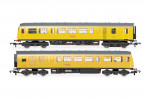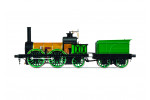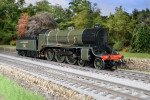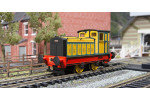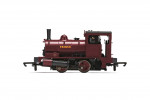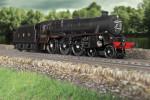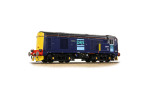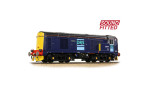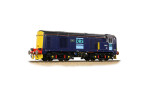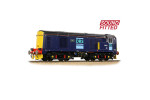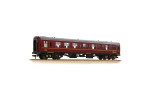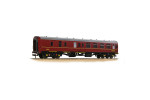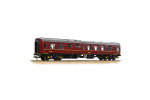Search results
 MOO53
MOO53MOO53 OO ENGINEERS BLUE BRICK
4 SHEETS X .23mm THICK - 4 SHEETS X .5mm THICK. TOTAL OF 8 SHEETS PER PACK
 MOO55
MOO55MOO55 PAVING SHEETS
8 SHEETS OF PAVING SLABS. 4 X .23mm & 4 X .5mm.
 MOO54
MOO54MOO54 RED BRICK SHEETS
8 SHEETS OF RED BRICK. 4 X .23mm & 4 X .5mm.
 PO282
PO282OO WAREHOUSE
OO GAUGE WAREHOUSE WHICH CAN BE BUILT AS A STAND ALONE BUILDING OR A LOW RELIEF BUILDING.
 PO283
PO283SMALL FACTORY
A SINGLE STOREY FACTORY UNIT WITH NORTH LIGHT ROOF WINDOWS AND LOADING BAY. PLUS A THREE STOREY BUILDING WITH OUTSIDE STEPS.
 2D-003-000
2D-003-000BR BLUE CLASS 52 'WESTERN VENTURER'
BR BLUE WITH FULL YELLOW ENDS CLASS 52 'WESTERN VENTURER'
 38-675
38-675GWR SHUNTERS TRUCK 'CANONS MARSH BRISTOL' GWR GREY
 R3329
R3329BR LATE CREST S15 CLASS
BR BLACK WITH LATE CREST CLASS S15
 R3299
R3299'GOING HOME' WW2 TRAIN PACK
LMS BLACK 5 AND 3 LMS STANIER COACHES
 R3374
R3374BR BLUE CLASS 71
 R3334
R3334BR LATE CREST 415 CLASS ADAMS RADIAL
 R3333
R3333BR EARLY CREST 415 CLASS ADAMS RADIAL
 377-925A
377-925APCA METALAIR BULK POWDER WAGON. BLUE CIRCLE WEATHERED
 R3418
R3418BRITISH RAILWAYS EARLY CLASS K1
 R3448
R3448BR 4-6-0 CLASS B17/2 'WELBECK ABBEY'
BR LINED GREEN CLASS B17/2 4-6-0 'WELBECK ABBEY' WITH EARLY CREST.
 R3447
R3447LNER 4-6-0 CLASS B17/2 'KILVERSTONE HALL'
 32-992
32-992WICKHAM TYPE 27 TROLLEY CAR BR ENGINEERS YELLOW
 32-993
32-993ENGINEERS YELLOW WICKHAM TROLLEY WITH WASP STRIPES
 R3431
R3431BR EARLY CREST HOLDEN CLASS B12 4-6-0
 R3398
R3398LYME REGIS BRANCH LINE TRAIN PACK
BR BLACK ADAMS RADIAL WITH EARLY CREST,BR EX LSWR NON-CORRIDOR BRAKE COMPOSITE AND A BR EX LSWR NON-CORRIDOR BRAKE 3RD IN MAROON
 R4234B
R4234BBR STANIER (EX LMS) 1st CLASS CORRIDOR COACH. MAROON
 R3423
R3423BR (LATE CREST) 4-4-2T ADAMS RADIAL
 R3422
R3422SOUTHERN 4-4-2T ADAMS RADIAL
 371-651A
371-651AFREIGHTLINER CLASS 57 'FREIGHTLINER EXPLORER' WEATHERED
 R4764
R4764BR COLLETT COACH CORRIDOR BRAKE 3rd R/H IN MAROON
 R4765
R4765BR COLLETT COACH CORRIDOR BRAKE 3rd L/H IN MAROON
 R4767
R4767BR COLLETT COACH CORRIDOR COMPOSITE R/H IN MAROON
 R3521
R3521LNER CLASS D16/3
 371-036
371-036LONDON UNDERGROUND CLASS 20
 R4746A
R4746ABR ( EX LSWR) 58' MAUNSELL REBUILT 8 COMP BRAKE 3RD. MAROON
 R4747A
R4747ABR 58' (EX LSWR) MAUNSELL REBUILT 6 COMP BRAKE 3RD. MAROON
 R4792
R4792SR 58' (EX LSWR) MAUNSELL REBUILT 8 COMP BRAKE 3RD. SOUTHERN GREEN
 R4793
R4793SR 58' (EX LSWR) MAUNSELL REBUILT 6 COMP BRAKE 3RD. SOUTHERN GREEN
 R4794
R4794SR (EX LSWR) MAUNSELL REBUILT 6 COMP BRAKE COMPOSITE . SOUTHERN GREEN
 R4795
R4795SR (EX LSWR) MAUNSELL REBUILT 9 COMP 3RD CLASS. SOUTHERN GREEN
 39-612
39-612BR (EX SE & CR) 60' BIRDCAGE COMPOSITE LAVATORY COACH CRIMSON
 39-622
39-622BR (EX SE & CR) 60' BIRDCAGE BRAKE 3RD COACH CRIMSON
 OR76DG002
OR76DG002BR BLACK EARLY CREST 'DEAN GOODS'
 R3529
R3529LNER CLASS J15
 377-345
377-345BR CONFLAT WITH UN-VENTED SPEEDFREIGHT CONTAINER
 39-621
39-621SOUTHERN RAILWAY SE & CR BIRDCAGE BRAKE 3rd IN OLIVE GREEN
 PO430
PO430SMALL SIGNAL BOX
SMALL SIGNAL BOX KIT IDEAL FOR PLATFORMS AND SMALL STATIONS.102MM X 48MM
 PO333
PO333SETTLE /CARLISLE STATION BUILDING
A BEAUTIFULLY DETAILED KIT OF A S & C RAILWAY STATION BUILDING. 315MM X 122MM
 393-050
393-050OO-9 OPEN BOGIE WAGON WW1 WD GREY WEATHERED
 393-052
393-052OO-9 OPEN BOGIE WAGON 'ASHOVER RAILWAY' LIGHT GREY WEATHERED
 371-386
371-386FREIGHTLINER CLASS 66 '66 416'
 371-387
371-387COLAS RAIL CLASS 66 '66 846'
 371-398
371-398GBRS CLASS 66 'EVENING STAR'
 374-442
374-442BULLIED 63ft THIRD CORRIDOR BR (SR) MALACHITE GREEN
 374-432A
374-432ABULLIED 63ft BRAKE 3RD CORRIDOR OPEN BR (SR) MALACHITE GREEN
 374-432
374-432BULLIED 63ft BRAKE 3RD CORRIDOR OPEN BR (SR) MALACHITE GREEN
 R3659
R3659COLAS RAIL CLASS 67 'CHARLOTTE'
 99521
99521LYNTON & BARNSTAPLE 00-9 761 'TAW'
 99511
99511LYNTON & BARNSTAPLE 00-9 760 'EXE'
 99551
9955100-9 LYNTON & BARNSTAPLE 2-6-2 'EXE' IN L & B LIVERY
 99531
9953100-9 LYNTON & BARNSTAPLE 2-6-2 'EXE' IN INTERMEDIATE LIVERY
 99561
9956100-9 LYNTON & BARNSTAPLE 2-6-2 'TAW' IN L & B LIVERY
 DCD-GS-RG.4
DCD-GS-RG.42 ASPECT RED/GREEN GROUND SIGNAL
Control these signals using a reverse polarity switch. 6v-12v DC from a regulated power supply.You MUST always use a resistor with this ground signal.
 DCD-GS-MG.4
DCD-GS-MG.4MODERN IMAGE 4 LIGHT GROUND SIGNAL
Control these signals using a reverse polarity switch. 6v-12v DC from a regulated power supply.You MUST always use a resistor with this ground signal.
 DCD-GS-BR.4
DCD-GS-BR.4BR 3 LIGHT GROUND SIGNAL
Control these signals using a reverse polarity switch. 6v-12v DC from a regulated power supply.You MUST always use a resistor with this ground signal.
 39-277A
39-277ABR MK1 GUV GENERAL UTILITY VAN BR BLUE 'PROPERTY BOARD'
 39-556
39-556BR MK1 CCT COVERED CARRIAGE TRUCK 'TARTAN ARROW'
 R3781
R3781K&ESR TERRIER 0-6-0 'ROLVENDEN'
 R4880A
R4880ABR 57' BOW ENDED SUBURBAN BRAKE COACH L/H MAROON
 R4881A
R4881ABR 57' BOW ENDED SUBURBAN BRAKE COACH R/H MAROON
 32-764A
32-764ANORTHERN BELLE CLASS 57 'SOLWAY PRINCESS'
 374-910
374-910SE & CR 60ft BIRDCAGE 3 COACH PACK SE & CR WELLINGTON BROWN
 374-911
374-911SE & CR 60ft BIRDCAGE 3 COACH PACK SR MAUNSELL GREEN
 374-912
374-912SE & CR 60ft BIRDCAGE 3 COACH PACK BR CRIMSON
 377-601C
377-601CBR BDA BOGIE BOLSTER BR RAILFREIGHT RED. WEATHERED
 32-611
32-611BR RAILFREIGHT DISTRIBUTION SECTOR CLASS 90
THIS LOCO REQUIRES A BACHMANN 36-569 21 PIN MTC DECODER.USING A STANDARD 21 PIN DECODER WILL DAMAGE THE SERVO MOTOR AND INVALIDATE YOUR WARRANTY.
 DCP-RA3
DCP-RA390° ADAPTORS (Pack of 3)
EASY SYSTEM TO MOUNT DCC CONCEPTS POINT MOTORS SIDEWAYS
 DCD-ZN218.6
DCD-ZN218.6ZEN BLACK 8 & 21 PIN 6 FUNCTION DECODER
WITH ADVANCES ABC AND SHUTTLE OPERATION.PLEASE SEE DCC CONCEPTS WEB SITE FOR FULL DETAILS.
 DCD-ZNmini.4A
DCD-ZNmini.4AZEN BLACK 8 PIN 4 FUNCTION DCC DECODER WITH ABC MODULE
WITH ADVANCED ABC AND SHUTTLE OPERATION.PLEASE SEE DCC CONCEPTS WEB SITE FOR FULL DETAILS.
 DCD-ZNmini.4
DCD-ZNmini.4ZEN BLACK 8 PIN 4 FUNCTION DCC DECODER
WITH ADVANCED ABC AND SHUTTLE OPERATION.PLEASE SEE DCC CONCEPTS WEB SITE FOR FULL DETAILS.
 DCD-ZN218.6S
DCD-ZN218.6SZEN BLACK 8 & 21 PIN 6 FUNCTION DECODER WITH 3 X ABC CONTROL MODULES
WITH ADVANCED ABC AND SHUTTLE OPERATION.PLEASE SEE DCC CONCEPTS WEB SITE FOR FULL DETAILS.
 DCD-ABC.3
DCD-ABC.33 X ABC MODULES
FOR ABC AND SHUTTLE OPERATION.PLEASE SEE DCC CONCEPTS WEB SITE FOR FULL DETAILS.
 374-213
374-213BR MK1 PULLMAN PSP SECOND PARLOUR '99347' WCRC MAROON
 374-214
374-214BR MK1 PULLMAN PSP SECOND PARLOUR '99352' WCRC MAROON
 374-222
374-222BR MK1 PULLMAN PFK FIRST KITCHEN 'THRUSH' UMBER & CREAM
 35-175
35-175ROD 2-8-0 1918 RAILWAY OPERATING DIVISION BLACK
 393-026A
393-026ABOGIE COVERED GOODS WAGON 'NOCTON ESTATES' L R GREY (W)
 393-027
393-027BOGIE COVERED GOODS WAGON 'LINCOLNSHIRE COAST' L R CRIMSON
 393-030
393-030BOGIE COVERED GOODS WAGON 'SR' INSULATED
 393-051A
393-051AOPEN BOGIE WAGON 'NOCTON ESTATES' L R GREY (W)
 393-052A
393-052AASHOVER L R OPEN BOGIE WAGON
COMES WITH LOAD
 R4914
R4914RAILROAD GWR CLERESTORY THIRD CLASS BRAKE COACH
 30-420
30-420WESTERN PULLMAN - ULTIMA DIGITAL SOUND TRAIN SET
6 CAR WESTERN PULLMAN DMU, SOUND FITTED + DYNAMIS ULTIMA DCC CONTOLLER AND AN OVAL OF TRACK.
 374-082A
374-082ABR MK1 BCK BRAKE COMPOSITE CORRIDOR, CHOCOLATE & CREAM
 374-189C
374-189CBR MK1 BSK BRAKE SECOND CORRIDOR , CHOCOLATE & CREAM
 38-727
38-727WD 50T 'WARFLAT' BOGIE WAGON BR EARLY GREY
 44-599
44-599NARROW GAUGE SLATE BUILT RETAINING WALL
 38-725
38-725WD 50T 'WARFLAT' BOGIE WAGON WITH KHAKI CROMWELL MK4 TANK
 38-726
38-726WD 50T 'WARFLAT' BOGIE WAGON WITH BRONZE GREEN CROMWELL MK4 TANK
 PL-55
PL-55PECO TURNTABLE MOTOR
TURNTABLE MOTOR FOR ANY PECO TURNTABLE.
 38-741
38-741WAR OFFICE 'PARROT' BOGIE WAGON. LMS GREY
 2P-011-010
2P-011-010LNER GRESLEY TEAK 3rd CLASS COACH '60634'
 2P-011-011
2P-011-011LNER GRESLEY TEAK 3rd CLASS COACH '60648'
 2P-011-273
2P-011-273BR MAROON GRESLEY BRAKE COMPOSITE COACH
 2P-011-305
2P-011-305LNER GRESLEY TEAK BUFFET COACH '9128'
 2P-011-372
2P-011-372BR MAROON GRESLEY BUFFET COACH 'E9035E'
 R3742F
R3742FDB CARGO ROMANIA CLASS 91 'MIHAL EMINESCU''THE EURO CONNECTION'.
 R3743
R3743BR RAILFREIGHT CLASS 60 'BOW FELL'
 R6925TTS
R6925TTSVENT VAN WITH DCC SOUND
VENT VAN WITH 28 SOUND FUNCTIONS WITH SOUNDS FROM- LARGE STATION/TRANSPORT, AROUND THE FARM, IN THE VILLAGE/TOWN AND INCIDENTS & EMERGENCIES
 38-740
38-740WD 40T PARROT BOGIE WAGON WD GREY WITH SHEETED TANK
 39-603
39-603SR MALACHITE SE & CR BIRDCAGE BRAKE THIRD LAVATORY
 39-604
39-604SE & CR WELLINGTON BROWN BIRDCAGE BRAKE COMPOSITE LAVATORY
 39-613
39-613SR MALACHITE SE & CR BIRDCAGE COMPOSITE LAVATORY
 39-614
39-614SE & CR WELLINGTON BROWN BIRDCAGE COMPOSITE LAVATORY
 39-623
39-623SR MALACHITE SE & CR BIRDCAGE BRAKE THIRD
 39-624
39-624SE & CR WELLINGTON BROWN BIRDCAGE BRAKE THIRD
 7S-005-001
7S-005-001LNER '42' Y1/Y3 SENTINEL
 7S-005-006
7S-005-006GWR '2' Y1/Y3 SENTINEL 'ISEBROOK'
 38-800
38-800RANSOMES & RAPIER 45T STEAM CRANE. SR GREY.
 38-803
38-803BR DEPARTMENTAL RED RANSOMES & RAPIER STEAM CRANE
 R3750
R3750BELMOND 'BRITISH PULLMAN' TRAIN PACK
DB CARGO UK CLASS 67 WITH PULLMAN ALL-STEEL K TYPE FIRST PARLOUR CARS 'LUCILLE & ZENA' AND KITCHEN FIRST 'IONE'.
 4D-011-008
4D-011-008BR STREAMLINED RAILCAR CARMINE & CREAM
 4D-011-100
4D-011-100GWR STREAMLINED PARCELS EXPRESS RAILCAR
 4D-011-101
4D-011-101BR STREAMLINED PARCELS EXPRESS RAILCAR - CRIMSON
 OR76BOOM01XS
OR76BOOM01XSROD DEAN GOODS WITH DCC SOUND AND WWII RAIL GUN
 4D-014-002
4D-014-002BR BLUE CLASS 29 WITH FULL YELLOW ENDS
 4D-014-004
4D-014-004BR GREEN CLASS 21 WITH SYP
 31-464A
31-464ASE & CR SOUTHERN C CLASS. LINED BLACK
 33-131
33-131BR 35T BULK GRAIN HOPPER BR FREIGHT BROWN. WEATHERED
 33-133
33-133BR 35T BULK ALUMINA HOPPER BRT BLUE WEATHERED
 2P-000-080
2P-000-080BR COLLETT COMPOSITE COACH, CHOCOLATE & CREAM
 2P-000-180
2P-000-180BR COLLETT SECOND CLASS COACH, CHOCOLATE & CREAM
 2P-000-159
2P-000-159GWR COLLETT 3RD CLASS COACH, CHOCOLATE & CREAM
 2P-000-283
2P-000-283GWR COLLETT BRAKE COMPOSITE COACH, CHOCOLATE & CREAM
 2P-000-310
2P-000-310GWR COLLETT FULL BRAKE COACH, CHOCOLATE & CREAM
 2D-028-004
2D-028-004BR RAILFREIGHT GREY CLASS 26
 371-640
371-640FREIGHTLINER CLASS 70 WITH AIR INTAKE MOD
 371-641
371-641COLAS RAIL CLASS 70 WITH AIR INTAKE MOD
 2D-001-007
2D-001-007BR CONSTRUCTION SECTOR CLASS 33/0 '33042'
 4A-002-001
4A-002-001BR (WR) CONICAL WATER TOWER (STATIC)
 4A-002-002
4A-002-002BR (WR) CONICAL WATER TOWER (MOTORISED)
OPERATES FROM 9-18V AC OR DC
 4A-002-004
4A-002-004GWR CONICAL WATER TOWER (MOTORISED)
OPERATES FROM 9-18V AC OR DC
 4A-002-005
4A-002-005BR (WR) FLAT TOP WATER TOWER(STATIC)
 4A-002-006
4A-002-006BR (WR) FLAT TOP WATER TOWER(MOTORISED)
OPERATES FROM 9-18V AC OR DC
 4A-002-007
4A-002-007BR FLAT TOP WATER TOWER GREY (STATIC)
 4A-002-008
4A-002-008BR FLAT TOP WATER TOWER GREY (MOTORISED)
OPERATES FROM 9-18V AC OR DC
 R1268
R1268G SCALE HOGWARTS EXPRESS TRAIN SET
Battery-powered steam 4-6-0 locomotive and tender
Two Passenger coaches
24 curved and 8 straight plastic track pieces (Creates 73.2 IN x 50 IN Oval)
RC Remote Control
 376-200
376-200LNER THOMPSON FIRST CORRIDOR COACH IN TEAK
 376-225
376-225LNER THOMPSON COMPOSITE CORRIDOR COACH IN TEAK
 376-250
376-250LNER THOMPSON THIRD CORRIDOR COACH IN TEAK
 376-275
376-275LNER THOMPSON BRAKE THIRD CORRIDOR COACH IN TEAK
 39-430A
39-430ABR MK1 POS POST OFFICE SORTING VAN. ROYAL MAIL LETTERS RED
 R3902
R3902GBRF CLASS 66 'SUNDERLAND'
 39-425A
39-425ABR MK1 POS POST OFFICE SORTING VAN BLUE & GREY WEATHERED
 374-011C
374-011CBR MK1 TSO TOURIST SECOND OPEN, BR (SR GREEN)
 374-015A
374-015ABR MK1 TSO TOURIST SECOND OPEN, BR INTERCITY (EXECUTIVE)
 374-089
374-089BR MK1 BCK BRAKE COMPOSITE CORRIDOR IN NWR YELLOW
 374-660
374-660BR MK2F RFB RESTAURANTFIRST BUFFET BR BLUE GREY
 38-077
38-077SR 12T Plywood Ventilated Van BR Bauxite (Late) [W]
 38-081C
38-081CSR 12T 2+2 Planked Ventilated Van BR Grey (Early) [W]
 38-082D
38-082DSR 12T 2+2 Planked Ventilated Van BR Bauxite (Early) [W]
 38-083A
38-083ASR 12T 2+2 Planked Ventilated Van GWR Grey
 R3864
R3864GWR STAR CLASS 4-6-0 'LODE STAR'
 4S-043-006
4S-043-006BR LINED GREEN LATE CREST CLASS 43XX MOGUL '7310'
 DCP-CB12DiP
DCP-CB12DiPCobalt iP Digital (12 Pack)
Twelve Cobalt iP Digital “Intelligent Power” DCC Digital Turnout Motors with all installation accessories including mounting screws and one of our very popular double-sided foam mounting pads.
 31-390
31-390BR (SR) GREEN CLASS 414 2-HAP 2 CAR EMU
 371-136
371-136BR RAILFREIGHT PETROLEUM SECTOR CLASS 31/1 '31319'
 371-137
371-137NETWORK RAIL CLASS 31/1 '31602'
 LM-iD.3
LM-iD.3LEGACY MODELS INTELLIGENT DETECTOR (3 PACK)
The Legacy LM-iD is an intelligent Inductive detector that is easy to install, trouble free and exceptionally reliable.
LM-iD works everywhere: On layouts built in every common modelling scale, with every brand of DCC system and with every computer control app IO input that can sense a high/low detection.
 DCD-3WH.3
DCD-3WH.3Zen 3-Wire Stay Alive Adapter Pack for ESU and Lenz Decoders
 DCD-SAA-3W
DCD-SAA-3WZen 3-Wire Stay Alive Variety Pack for Zen Black & Blue+ Decoders
A set of 4 Stay-Alives with 3-wire connections to the decoder. Totally Plug and Play with Zen decoders.
1x Small
1x Medium
1x Large
1x Super
Usable with Zen Black, Zen Blue+, Lenz and ESU or any decoder with three-wire connections for Stay-Alive.
 DCP-CBSS-2
DCP-CBSS-22x Cobalt-SS with Controller & Accessories
Cobalt-SS 2 Pack – Small, Reliable, Super-Smooth Above-Board Turnout Motors, ready for DC or DCC use.
 R40078
R40078BR Crimson 3rd Class 5 Door 6 wheel coach. Electric lights + step boards E31070 Passenger Coaches
 R40124A
R40124ABR Crimson 3rd Class 5 Door 6 wheel coach. Electric lights + step boards E31085 - With Lights
 32-755A
32-755AARRIVA TRAINS WALES CLASS 57 '57314'
 R4886B
R4886BBR, Bulleid 59' Corridor Composite, S5713S - Era 4
 R4888D
R4888DBR, Bulleid 59' Corridor Brake Third, S2849S - Era 4 Passenger Coaches
 R4888E
R4888EBR, Bulleid 59' Corridor Brake Third, S2850S - Era 4 Passenger Coaches
 R6990
R6990Hornby 'Retro' Wagons, three pack, Crawfords Biscuits, Seccotine Tanker, Coleman's Mustard
 R6991
R6991Hornby 'Retro' Wagons, three pack, United Dairies Tanker, Jacob's Biscuits, Palethorpes
 32-684DBSF
32-684DBSFBR BLUE CLASS 45 'THE KING'S SHROPSHIRE LIGHT INFANTRY' 45040 WITH DCC SOUND
 373-352
373-352WD 50T 'Parrot' Bogie Bolster B BR Grey (Early)
 377-256
377-256BR 16T Steel Mineral Wagon with Top Flap Doors NCB Grey
 DCD-ZN8D.4
DCD-ZN8D.4Zen Blue+ Decoder: 8 Pin NANO Direct – 4 Fn
Decoder features:
– 1.1 Amps peak power
– 750mA continuous power
– 4 functions at 100mA each
– 15mm x 7mm
– 8-pin direct
– Brown-out protection
– Stay-alive connection
 DCD-ZN8H.nano
DCD-ZN8H.nanoZen Blue+ Decoder: 8 Pin NANO Wired 2 Function
Decoder features:
– 1.1 Amps peak power
– 750mA continuous power
– 2 functions at 100mA each
– 14mm x 7mm x 2.7mm
– 8-pin harness
– Brown-out protection
– Stay-alive connection
 32-754A
32-754AClass 57/0 57009 DRS Compass (Original)
 35-126
35-126Class 20/3 20311 Harry Needle Railroad Company
 38-230B
38-230BBR 12T Ventilated Van Plywood Doors BR Bauxite (Early) 'ICI'
 38-233
38-233BR 12T Ventilated Van Plywood Doors BR Departmental Rail Stores
 32-929
32-929Class 150/1 2-Car DMU 150115 BR Provincial (Original)
 32-929SF
32-929SFClass 150/1 2-Car DMU 150115 BR Provincial (Original) With DCC Sound
 37-279A
37-279ABR 27T Steel Tippler BR Bauxite (TOPS) 'Stone Traffic'
 37-355D
37-355DBR 13T Steel Sand Tippler BR Bauxite (Early)
 37-376D
37-376D16T Steel Mineral Wagon Pressed End Door MOT Bauxite
 371-389
371-389Class 66/7 66789 'British Rail 1948-1997' GBRf BR Blue (Large Logo)
 371-399
371-399Class 66/7 66783 'The Flying Dustman' GBRf Biffa Red
 38-232
38-232BR 12T Ventilated Van Plywood Doors BR Bauxite (TOPS)
 DCW-iL.25
DCW-iL.25Solderless i-Link Connectors (25-pack)
SOLDERLESS CONNECTOR FOR TRACK BUS/DROPPER WIRES
 LM-PP.2
LM-PP.2Legacy Models PowerPoint Baseboard Dowels (2-pack)
2 pairs of precision baseboard alignment dowels. These are the BEST alignment dowels ever offered – now with POWER BUS CONNECTIVITY!
 DCF-BR.NN
DCF-BR.NNBearing Reamers (Set of Two) – N
N GAUGE AXEL BEARING REAMERS.Two types, one with centre roller for standard freight bogies/trucks, and one with twin finger-rollers for bogies/trucks with a centre bolster for couplers.
 R1271
R1271iTraveller 6000 Train Set
The iTraveller 6000 Train Set is the model railway of the future! This set features a train inspired by cutting edge technology. Everything needed to get started with model railways is in the box and includes: a locomotive, rolling stock and track as well as Hornby’s new controller system the HM 6000 which allows the locomotive to be controlled using mobile devices via a downloadable app.
 35-126A
35-126AClass 20/3 20314 Harry Needle Railroad Company
 37-353B
37-353BBR 13T Steel Sand Tippler BR Grey (Early)
 37-357
37-357BR 13T Steel Sand Tippler BR Bauxite (Departmental)
 R3915
R3915Network Rail, Class 121, '960015'
Unit number 55019 was built in 1958 and served passenger duties in the western region until being converted for departmental use in 1969. As departmental stock it was redesignated a class 960 and given the unit number 960015.
Operated by Network rail the units primary role is as a sandite unit.
 DCG-BB145
DCG-BB145Back to Back OO/HO (Standard) 14.5mm
Brass back-to-back gauge for Standard OO and HO ready to run, plus models built using BRSMB wheel standards OR running on pointwork built using OO-SF standards for common crossing and related gauging.
 32-940
32-940Class 150/2 2-Car DMU 150216 GWR Green (FirstGroup)
The British Rail Class 150 Sprinter is a class of diesel multiple-unit passenger trains built by BREL York from 1984 to 1987. A total of 137 units were produced in three main subclasses, replacing many of the earlier, first-generation "Heritage" DMUs. The first subclass, 150/0 comprised a pair of prototype units.
The second batch, of fifty units, was classified 150/1 and numbered in the range 150101-150. Like the prototype units, they did not have front-end gangway connections which allowed passengers to move between units working in multiple. Originally based at Derby Etches Park depot, these units were introduced in 1986, mainly concentrated around Birmingham and Manchester, and in later years restricted mainly to commuter services. Today the entire fleet is concentrated on the Northern franchise, mainly working around Manchester to places like Buxton, Sheffield, Liverpool, Southport and Carnforth.
The final batch of 85 two-car units were built with front-end gangway connections. These units were classified as Class 150/2 and numbered in the range 150201-285. They were used on longer-distance services. The 150/2s have operated in Scotland, Wales, the West of England and the North.
 32-941
32-941Class 150/2 2-Car DMU 150220 Northern
The British Rail Class 150 Sprinter is a class of diesel multiple-unit passenger trains built by BREL York from 1984 to 1987. A total of 137 units were produced in three main subclasses, replacing many of the earlier, first-generation "Heritage" DMUs. The first subclass, 150/0 comprised a pair of prototype units.
The second batch, of fifty units, was classified 150/1 and numbered in the range 150101-150. Like the prototype units, they did not have front-end gangway connections which allowed passengers to move between units working in multiple. Originally based at Derby Etches Park depot, these units were introduced in 1986, mainly concentrated around Birmingham and Manchester, and in later years restricted mainly to commuter services. Today the entire fleet is concentrated on the Northern franchise, mainly working around Manchester to places like Buxton, Sheffield, Liverpool, Southport and Carnforth.
The final batch of 85 two-car units were built with front-end gangway connections. These units were classified as Class 150/2 and numbered in the range 150201-285. They were used on longer-distance services. The 150/2s have operated in Scotland, Wales, the West of England and the North.
 37-256A
37-256ABR 16T Steel Mineral Wagon BR Bauxite (Early)
 37-354D
37-354DBR 13T Steel Sand Tippler BR Grey (Early)
 37-402
37-40216T Steel Slope-Sided Mineral Wagon 'Stewart & Lloyds' Red
 37-428
37-42816T Steel Slope-Sided Mineral Wagon 'Rother Vale' Black
 371-388
371-388Class 66/4 66419 Freightliner G&W
The Class 66 is a type of six-axle diesel electric freight locomotive developed in part from the Class 59, for use on the railways of the UK. Since its introduction the class has been successful and has been sold to British and other European railway companies. In Continental Europe it is marketed as the EMD Class 66 (JT42CWR). Placing what was termed as "the biggest British loco order since steam days," EWS placed an order for 250 units in May 1996 to be built at the EMD plant in London, Ontario, Canada; the first locomotives were ready in 1998. They were given the Class 66 designation in the British classification system (TOPS). In 1998 Freightliner placed an order for further locomotives. They were followed by GB Railfreight, and then Direct Rail Services. The last of more than 500 built over an 18-year period was No 66779, Evening Star, delivered to GB Railfreight in spring 2016.
Class 66 is synonymous with the contemporary UK rail scene, operating for all the major freight operators including DB, Freightliner, GB Railfreight, Colas Rail, and DRS, and they are set to dominate the domestic locomotive fleet for many years to come.
 374-122A
374-122ABR Mk1 RU Restaurant Unclassified BR Blue & Grey
 374-123
374-123BR Mk1 RU Restaurant Unclassified BR (WR) Chocolate & Cream
 38-778A
38-778A14T Class A Anchor-Mounted Tank Wagon 'National Benzole' Silver
Portraying one of the distinctive Anchor Mounted tanks, No. 861 is a Class A wagon used to transport flammable liquids and therefore is decorated in the standard silver paint scheme that was mandatory for Class A tank wagons during the period following World War Two. Along with the attractive National Benzole branding, the model also features a full complement of lettering and safety warnings – complete with a light weathered finish.
 R30051
R30051G. Lee Mining Co. Ltd, Bagnall 0-4-0DH
The Stafford firm of W.G Bagnall built a range of steam and diesel shunting locomotives for industrial and shunting use, supplying a number of types to the National Coal Board during the 1950s.
Locomotive production ceased in 1961 and the last two 4w Diesel-Hydraulic shunters produced were built for the firm of Leys Malleable Castings Co. Ltd in Lincoln, a typical industrial customer for the small diesel shunter market, although similar locomotives found work across the United Kingdom during the 1960s and 1970s in British Railways' departmental use.
 37-511
37-51124T Ore Hopper 'Stanton' Red
Depicting one of the wagons owned by the Stanton Ironworks Company, near Ilkeston in Nottinghamshire.
 37-578B
37-578BBR 45T TTA Tank Wagon 'ICI Petrochemicals & Plastics' White
 31-933A
31-933ALMS 4P Compound 41143 BR Lined Black (Late Crest)
The London, Midland and Scottish Railway Compound 4-4-0 was a class of steam locomotive designed for passenger work. One hundred and ninety-five engines were built by the LMS, adding to the 45 examples of the Midland Railway 1000 Class, to which they were almost identical. The most obvious difference is that the driving wheel diameter was reduced from 7ft. 0in. on the Midland locomotive to 6ft. 9in. on the LMS version. They were given the power classification 4P. The locomotives were constructed at Derby and Horwich Works and by outside contractors.
The LMS continued the Midland numbering from 1045 to 1199 and then started in the lower block of 900–939. After nationalisation in 1948, BR added 40000 to their numbers so they became 40900–40939 and 41045–41199.
The Class were withdrawn between 1952 and 1961. None have survived into preservation, though the first of the Midland 1000 Class engines was saved and is part of the National Collection.
 32-416
32-416Class 24/0 24035 Disc Headcode BR Blue
The widely travelled British Railways Class 24 diesel-electric locomotives, also known as the Sulzer Type 2, were built from 1958 to 1961. One hundred and fifty-one were built at BR’s Derby, Crewe and Darlington Works, the first twenty of them as part of the British Railways 1955 Modernisation Plan. This Class was used as the basis for the development of the Class 25 locomotives. Initial deliveries were for operation in the Crewe and Derby areas, but fifteen of the initial twenty were diverted for use on the Southern Region to cover for delays in the Kent Coast Electrification scheme.
As deliveries continued, allocations were made to both the London Midland Region and Eastern Region, and with the Class becoming familiar to crews and staff around London they were used on freight trains over the Metropolitan Widened Lines. Locos allocated to East Anglia for use on freight soon became redundant due to the rundown of services in that region, and these were, in turn, moved to Wales and Lancashire.
All Class 24s were powered by the reliable 6LDA28-A Sulzer engine which gave an output of 1,160bhp. Disc headcodes were fitted to all Class 24/0s along with large fuel tanks and water tanks for the steam heat boilers, although these were later removed in many cases. The first Class 24 was withdrawn in 1967 following fire damage but the last remained in service until 1980. Class 24/1 No. 24061 also survived until 1987 thanks to its transfer to Departmental use and was one of four Class 24s to be preserved.
 377-066
377-0665 Plank Wagon Wooden Floor 'J. H. Rainbow' Red
 377-067
377-0675 Plank Wagon Wooden Floor 'Devlin's Trawlers' Green
 377-068
377-0685 Plank Wagon Fixed End Wooden Floor 'A. Butler & Co.' Black
 377-209
377-2098 Plank Wagon Fixed End 'William Harrison' Grey
 39-654
39-654BR Mk2F FO First Open Virgin Trains (Original)
British Rail's second generation of Standard Coach design is known as the Mark 2. Design and construction followed on from the universal and ubiquitous Mk1 family of coaching stock, with the prototype example built in 1963. Series production continued until 1975 at Derby Carriage Works. They were of steel construction, and of a more monocoque design than the Mk1, which added to their safety and integrity in event of collision or mishap.
As passenger expectations and railway operations had moved on since the vast Mk1 range was conceived, and because there was still much life left in the Mk1s by the mid-sixties, a much reduced number of vehicle types were built. The basic Mk2 types included First and Second class accommodation, with corridors and compartments only available to First Class passengers, all Second Class coaches were conceived as open saloons. First and Second class Brake coaches were built, but no full brakes, catering cars, restaurants, buffets or sleeping cars were included, Mark 1 coaches fulfilling these needs until Mark 3s came along in the late seventies.
The Mark 2 family underwent a number of tweaks and improvements during the 12 years construction period. The principal visual differences included air braking from Mk2A, removal of the central bodyside doors and vestibule (Mk2B), introduction of wrap-around corner doors and provision of one WC at each end in lieu of two at one end (Mk2B), air conditioning - so no opening windows in the saloon area (Mk2D), no side corridor First Class compartment vehicles (from Mk2E onwards), varying style and colours of end gangway doors.
 39-654DC
39-654DCBR Mk2F FO First Open Virgin Trains (Original)
MODEL FEATURES: • Accessory Pack • NEM Coupling Pockets • Close Coupling Mechanism • Length 270mm • Interior Lighting • Door Interlock Lighting (when used on DCC) • Constantly lit or Flashing Tail Lamps (optional – two types) • DCC-control of all lighting via the integrated DCC decoder • Lighting can be controlled by easy-access switches when used on analogue
 39-679DC
39-679DCBR Mk2F TSO Tourist Second Open Virgin Trains (Original)
MODEL FEATURES:
• Accessory Pack
• NEM Coupling Pockets
• Close Coupling Mechanism
• Length 270mm
• Interior Lighting
• Door Interlock Lighting (when used on DCC)
• Constantly lit or Flashing Tail Lamps (optional – two types)
• DCC-control of all lighting via the integrated DCC decoder
• Lighting can be controlled by easy-access switches when used on analogue
 39-680DC
39-680DCBR Mk2F TSO Tourist Second Open ScotRail Saltire
MODEL FEATURES:
• Accessory Pack
• NEM Coupling Pockets
• Close Coupling Mechanism
• Length 270mm
• Interior Lighting
• Door Interlock Lighting (when used on DCC)
• Constantly lit or Flashing Tail Lamps (optional – two types)
• DCC-control of all lighting via the integrated DCC decoder
• Lighting can be controlled by easy-access switches when used on analogue
 39-687DC
39-687DCBR Mk2F RFB Restaurant First Buffet Virgin Trains (Original)
MODEL FEATURES:
• Accessory Pack
• NEM Coupling Pockets
• Close Coupling Mechanism
• Length 270mm
• Interior Lighting
• Door Interlock Lighting (when used on DCC)
• Constantly lit or Flashing Tail Lamps (optional – two types)
• DCC-control of all lighting via the integrated DCC decoder
• Lighting can be controlled by easy-access switches when used on analogue
 39-703DC
39-703DCBR Mk2F BSO Brake Second Open Virgin Trains (Original)
MODEL FEATURES: • Accessory Pack • NEM Coupling Pockets • Close Coupling Mechanism • Length 270mm • Interior Lighting • Door Interlock Lighting (when used on DCC) • Constantly lit or Flashing Tail Lamps (optional – two types) • DCC-control of all lighting via the integrated DCC decoder • Lighting can be controlled by easy-access switches when used on analogue
 39-687
39-687BR Mk2F RFB Restaurant First Buffet Virgin Trains (Original)
British Rail's second generation of Standard Coach design is known as the Mark 2. Design and construction followed on from the universal and ubiquitous Mk1 family of coaching stock, with the prototype example built in 1963. Series production continued until 1975 at Derby Carriage Works. They were of steel construction, and of a more monocoque design than the Mk1, which added to their safety and integrity in event of collision or mishap.
As passenger expectations and railway operations had moved on since the vast Mk1 range was conceived, and because there was still much life left in the Mk1s by the mid-sixties, a much reduced number of vehicle types were built. The basic Mk2 types included First and Second class accommodation, with corridors and compartments only available to First Class passengers, all Second Class coaches were conceived as open saloons. First and Second class Brake coaches were built, but no full brakes, catering cars, restaurants, buffets or sleeping cars were included, Mark 1 coaches fulfilling these needs until Mark 3s came along in the late seventies.
The Mark 2 family underwent a number of tweaks and improvements during the 12 years construction period. The principal visual differences included air braking from Mk2A, removal of the central bodyside doors and vestibule (Mk2B), introduction of wrap-around corner doors and provision of one WC at each end in lieu of two at one end (Mk2B), air conditioning - so no opening windows in the saloon area (Mk2D), no side corridor First Class compartment vehicles (from Mk2E onwards), varying style and colours of end gangway doors.
 39-702
39-702BR MK2F BSO Brake Second Open BR InterCity (Swallow)
British Rail's second generation of Standard Coach design is known as the Mark 2. Design and construction followed on from the universal and ubiquitous Mk1 family of coaching stock, with the prototype example built in 1963. Series production continued until 1975 at Derby Carriage Works. They were of steel construction, and of a more monocoque design than the Mk1, which added to their safety and integrity in event of collision or mishap.
As passenger expectations and railway operations had moved on since the vast Mk1 range was conceived, and because there was still much life left in the Mk1s by the mid-sixties, a much reduced number of vehicle types were built. The basic Mk2 types included First and Second class accommodation, with corridors and compartments only available to First Class passengers, all Second Class coaches were conceived as open saloons. First and Second class Brake coaches were built, but no full brakes, catering cars, restaurants, buffets or sleeping cars were included, Mark 1 coaches fulfilling these needs until Mark 3s came along in the late seventies.
The Mark 2 family underwent a number of tweaks and improvements during the 12 years construction period. The principal visual differences included air braking from Mk2A, removal of the central bodyside doors and vestibule (Mk2B), introduction of wrap-around corner doors and provision of one WC at each end in lieu of two at one end (Mk2B), air conditioning - so no opening windows in the saloon area (Mk2D), no side corridor First Class compartment vehicles (from Mk2E onwards), varying style and colours of end gangway doors.
 39-703
39-703BR Mk2F BSO Brake Second Open Virgin Trains (Original)
British Rail's second generation of Standard Coach design is known as the Mark 2. Design and construction followed on from the universal and ubiquitous Mk1 family of coaching stock, with the prototype example built in 1963. Series production continued until 1975 at Derby Carriage Works. They were of steel construction, and of a more monocoque design than the Mk1, which added to their safety and integrity in event of collision or mishap.
As passenger expectations and railway operations had moved on since the vast Mk1 range was conceived, and because there was still much life left in the Mk1s by the mid-sixties, a much reduced number of vehicle types were built. The basic Mk2 types included First and Second class accommodation, with corridors and compartments only available to First Class passengers, all Second Class coaches were conceived as open saloons. First and Second class Brake coaches were built, but no full brakes, catering cars, restaurants, buffets or sleeping cars were included, Mark 1 coaches fulfilling these needs until Mark 3s came along in the late seventies.
The Mark 2 family underwent a number of tweaks and improvements during the 12 years construction period. The principal visual differences included air braking from Mk2A, removal of the central bodyside doors and vestibule (Mk2B), introduction of wrap-around corner doors and provision of one WC at each end in lieu of two at one end (Mk2B), air conditioning - so no opening windows in the saloon area (Mk2D), no side corridor First Class compartment vehicles (from Mk2E onwards), varying style and colours of end gangway doors.
 39-679
39-679BR Mk2F TSO Tourist Second Open Virgin Trains (Original)
British Rail's second generation of Standard Coach design is known as the Mark 2. Design and construction followed on from the universal and ubiquitous Mk1 family of coaching stock, with the prototype example built in 1963. Series production continued until 1975 at Derby Carriage Works. They were of steel construction, and of a more monocoque design than the Mk1, which added to their safety and integrity in event of collision or mishap.
As passenger expectations and railway operations had moved on since the vast Mk1 range was conceived, and because there was still much life left in the Mk1s by the mid-sixties, a much reduced number of vehicle types were built. The basic Mk2 types included First and Second class accommodation, with corridors and compartments only available to First Class passengers, all Second Class coaches were conceived as open saloons. First and Second class Brake coaches were built, but no full brakes, catering cars, restaurants, buffets or sleeping cars were included, Mark 1 coaches fulfilling these needs until Mark 3s came along in the late seventies.
The Mark 2 family underwent a number of tweaks and improvements during the 12 years construction period. The principal visual differences included air braking from Mk2A, removal of the central bodyside doors and vestibule (Mk2B), introduction of wrap-around corner doors and provision of one WC at each end in lieu of two at one end (Mk2B), air conditioning - so no opening windows in the saloon area (Mk2D), no side corridor First Class compartment vehicles (from Mk2E onwards), varying style and colours of end gangway doors.
 39-680
39-680BR Mk2F TSO Tourist Second Open ScotRail Saltire
British Rail's second generation of Standard Coach design is known as the Mark 2. Design and construction followed on from the universal and ubiquitous Mk1 family of coaching stock, with the prototype example built in 1963. Series production continued until 1975 at Derby Carriage Works. They were of steel construction, and of a more monocoque design than the Mk1, which added to their safety and integrity in event of collision or mishap.
As passenger expectations and railway operations had moved on since the vast Mk1 range was conceived, and because there was still much life left in the Mk1s by the mid-sixties, a much reduced number of vehicle types were built. The basic Mk2 types included First and Second class accommodation, with corridors and compartments only available to First Class passengers, all Second Class coaches were conceived as open saloons. First and Second class Brake coaches were built, but no full brakes, catering cars, restaurants, buffets or sleeping cars were included, Mark 1 coaches fulfilling these needs until Mark 3s came along in the late seventies.
The Mark 2 family underwent a number of tweaks and improvements during the 12 years construction period. The principal visual differences included air braking from Mk2A, removal of the central bodyside doors and vestibule (Mk2B), introduction of wrap-around corner doors and provision of one WC at each end in lieu of two at one end (Mk2B), air conditioning - so no opening windows in the saloon area (Mk2D), no side corridor First Class compartment vehicles (from Mk2E onwards), varying style and colours of end gangway doors.
 39-704
39-704BR Mk2F BSO Brake Second Open ScotRail Saltire
British Rail's second generation of Standard Coach design is known as the Mark 2. Design and construction followed on from the universal and ubiquitous Mk1 family of coaching stock, with the prototype example built in 1963. Series production continued until 1975 at Derby Carriage Works. They were of steel construction, and of a more monocoque design than the Mk1, which added to their safety and integrity in event of collision or mishap.
As passenger expectations and railway operations had moved on since the vast Mk1 range was conceived, and because there was still much life left in the Mk1s by the mid-sixties, a much reduced number of vehicle types were built. The basic Mk2 types included First and Second class accommodation, with corridors and compartments only available to First Class passengers, all Second Class coaches were conceived as open saloons. First and Second class Brake coaches were built, but no full brakes, catering cars, restaurants, buffets or sleeping cars were included, Mark 1 coaches fulfilling these needs until Mark 3s came along in the late seventies.
The Mark 2 family underwent a number of tweaks and improvements during the 12 years construction period. The principal visual differences included air braking from Mk2A, removal of the central bodyside doors and vestibule (Mk2B), introduction of wrap-around corner doors and provision of one WC at each end in lieu of two at one end (Mk2B), air conditioning - so no opening windows in the saloon area (Mk2D), no side corridor First Class compartment vehicles (from Mk2E onwards), varying style and colours of end gangway doors.
 39-704DC
39-704DCBR Mk2F BSO Brake Second Open ScotRail Saltire
MODEL FEATURES: • Accessory Pack • NEM Coupling Pockets • Close Coupling Mechanism • Length 270mm • Interior Lighting • Door Interlock Lighting (when used on DCC) • Constantly lit or Flashing Tail Lamps (optional – two types) • DCC-control of all lighting via the integrated DCC decoder • Lighting can be controlled by easy-access switches when used on analogue
 R60023
R600234 Plank Wagon, F. Wilkinson
This wagon carries a livery based on one dating to July 1906 belonging to F. Wilkinson and was based at Ulverston. The wagon would likely have been used for the transportation of coal from Yorkshire to the Furness area. This wagon is typical of the freight that could be found on Britain's railways throughout much of the 20th century.
 R40011
R40011BR, Class 370 Advanced Passenger Train 2-car TS Coach Pack, 48203 + 48204 - Era 7
This coach pack includes the two TS coaches required in part to complete R3873 5-car Pack (Sets 370 003 and 370 004).
 R40013
R40013BR, Class 370 Advanced Passenger Train 2-car TU Coach Pack, 48303 + 48304 - Era 7
This pack includes the two TU coaches required in part to complete R3873 5-car Pack (Sets 370 003 and 370 004).
 R40014
R40014BR, Class 370 Advanced Passenger Train 2-car TF Coach Pack, 48503 + 48504 - Era 7
This coach pack includes the two TF coaches required in part to complete R3873 5-car Pack (Sets 370 003 and 370 004).
 R30027
R30027Cappagh, Class 60, Co-Co, 60028
Built between 1989 and 1993, 100 BR Class 60 locomotives were built by Brush Traction in Loughborough. After teething troubles, the first two locomotives entered service in October 1990. After privatisation, the whole fleet transferred to EWS ownership, which was acquired by DB Schenker, a wholly owned subsidiary of the German railway company, in June 2007.
4 Locomotives, 60028, 60029, 60046 and 60055 were sold by DB Cargo UK to DCRail in 2019 with the 'Super Sixty' upgrade. 60028 was turned out in a blue livery, with large CAPPAGH logo. Under BR No. 60028 was named 'John Flamsteed' after the first Astronomer Royal John Flamsteed who made the first observations of Uranus (although he mistakenly catalogued it as a star) and laid the foundation stone for the Royal Greenwich Observatory.
 32-93
32-93Class 150/1 2-Car DMU 150133 BR GMPTE (Regional Railways)
CLASS 150 DMU HISTORY
The British Rail Class 150 ‘Sprinter’ is a class of diesel multiple unit passenger train built by BREL York from 1984 to 1987. A total of 137 units were produced in three main subclasses, replacing many of the earlier, first generation ‘heritage’ DMUs. The first subclass, the 150/0, comprised a pair of prototype units.
The second batch which comprised fifty units was classified 150/1s and numbered in the range 150101-150. Like the prototype units, they did not have front-end corridor connectors which are fitted to allow passengers to move between units when working in multiple. Originally based at Derby Etches Park depot, these units were introduced in 1986, mainly concentrated around Birmingham and Manchester, and in later years restricted mainly to commuter services. Today the entire fleet is concentrated on the Northern franchise, mainly working around Manchester to places like Buxton, Sheffield, Liverpool, Southport and Carnforth.
The final batch of 85 two car units were built with front-end corridor connectors. These units were classified as Class 150/2s and numbered in the range 150201-285. The Class 150/2s were used on longer-distance services and have operated in Scotland, Wales, the West of England and the North.
 32-930SF
32-930SFClass 150/1 2-Car DMU 150133 BR GMPTE (Regional Railways) DCC Sound Fitted
SOUNDS
F0 - Lights - On/Off (plus Light Switch Sound)
F1 - On - Warm Engine Start / On, Off - Failed Engine Start / On, Off, On - Cold Engine Start
F2* - Brake
F3 - Horn (Playable)
F4** - Double Toot Horn
F5 - Heavy Load
F6 - Coasting (Manual notch Down if F21 On)
F7 - Maximum Revs (Manual notch Up if F21 On)
F8*** - On - Coupling Up / Off - Uncoupling
F9 - Flange Squeal (Speed Related)
F10 - On - Carriage Doors Open / Off - Carriage Doors Shut
F11 - Spirax Valve
F12 - On - Guard’s Whistle / Off - Driver’s Response Buzzer & Horn
F13 - Compressed Air Let Off
F14 - Uncoupling Cycle
F15 - Air Build Up
F16 - Carriage Heating
F17**** - AWS
F18 - On - Sound Fades Out / Off - Sound Fades In
F19 - Mute (Latch) / Volume Cycles 6 Levels (Trigger)
F20 - Station Announcement
F21 - Manual Notching Logic On/Off (control with F6 & F7)
F22 - Sanding Valve
F23 - Fire Bell Test
* Alterative Brake sounds can be selected via CV changes
**Alternative Horn characteristics can be selected via CV changes
*** Alternative coupling sounds can be selected via CV changes
**** Alternative AWS sound can be selected via CV change
Analogue Users: Please note that normal load running sounds and any other automatic or randomised sounds will also operate when this model is used on analogue control (DC) straight from the box!
 32-942
32-942Class 150/2 2-Car DMU 150247 BR Provincial (Sprinter)
CLASS 150 DMU HISTORY
The British Rail Class 150 ‘Sprinter’ is a class of diesel multiple unit passenger train built by BREL York from 1984 to 1987. A total of 137 units were produced in three main subclasses, replacing many of the earlier, first generation ‘heritage’ DMUs. The first subclass, the 150/0, comprised a pair of prototype units.
The second batch which comprised fifty units was classified 150/1s and numbered in the range 150101-150. Like the prototype units, they did not have front-end corridor connectors which are fitted to allow passengers to move between units when working in multiple. Originally based at Derby Etches Park depot, these units were introduced in 1986, mainly concentrated around Birmingham and Manchester, and in later years restricted mainly to commuter services. Today the entire fleet is concentrated on the Northern franchise, mainly working around Manchester to places like Buxton, Sheffield, Liverpool, Southport and Carnforth.
The final batch of 85 two car units were built with front-end corridor connectors. These units were classified as Class 150/2s and numbered in the range 150201-285. The Class 150/2s were used on longer-distance services and have operated in Scotland, Wales, the West of England and the North.
 32-942SF
32-942SFClass 150/2 2-Car DMU 150247 BR Provincial (Sprinter) with DCC Sound Fitted
SOUNDS
F0 - Lights - On/Off (plus Light Switch Sound)
F1 - On - Warm Engine Start / On, Off - Failed Engine Start / On, Off, On - Cold Engine Start
F2* - Brake
F3 - Horn (Playable)
F4** - Double Toot Horn
F5 - Heavy Load
F6 - Coasting (Manual notch Down if F21 On)
F7 - Maximum Revs (Manual notch Up if F21 On)
F8*** - On - Coupling Up / Off - Uncoupling
F9 - Flange Squeal (Speed Related)
F10 - On - Carriage Doors Open / Off - Carriage Doors Shut
F11 - Spirax Valve
F12 - On - Guard’s Whistle / Off - Driver’s Response Buzzer & Horn
F13 - Compressed Air Let Off
F14 - Uncoupling Cycle
F15 - Air Build Up
F16 - Carriage Heating
F17**** - AWS
F18 - On - Sound Fades Out / Off - Sound Fades In
F19 - Mute (Latch) / Volume Cycles 6 Levels (Trigger)
F20 - Station Announcement
F21 - Manual Notching Logic On/Off (control with F6 & F7)
F22 - Sanding Valve
F23 - Fire Bell Test
* Alterative Brake sounds can be selected via CV changes
**Alternative Horn characteristics can be selected via CV changes
*** Alternative coupling sounds can be selected via CV changes
**** Alternative AWS sound can be selected via CV change
Analogue Users: Please note that normal load running sounds and any other automatic or randomised sounds will also operate when this model is used on analogue control (DC) straight from the box!
 37-582D
37-582DBR 45T TTA Tank Wagon 'Shell BP' Black
 37-589
37-589BR 45T TTA Tank Wagon 'Charringtons' Black
 374-878
374-878LMS 50ft Inspection Saloon BR Blue & Grey
 374-879
374-879LMS 50ft Inspection Saloon BR InterCity (Swallow)
 PT-60
PT-60FLEXI LOCO LIFT (SINGLE) (LOCO NOT INCLUDED)
Designed as a replacement for the old SL-43 Loco Lift, this new versatile system still has the features that made the SL-43 so popular, such as the ability to directly drive the locomotive on and off the track. But that was limited to OO/HO scale and this new system has been developed to adapt to all scales from N through to EM, including OO-9 (HOe), HOn3, TT, HOm and OO/HO.
The modeller simply selects the gauge that they want by sliding the two halves together until the right gauge has been selected (there are guide marks on the mouldings to help with that) and then self-tapping screws secure things in place. When placed on the track, the metal plates that act as the track ensure that locomotives can be driven on and off with ease. Each Flexi Loco Lift is supplied with two sliding shutter doors, provided to make sure nothing falls out whilst being transported, and these are trimmed to suit the gauge selected. It is as simple as that! No gluing required.
 PT-61
PT-61FLEXI LOCO LIFT (DOUBLE)(LOCO NOT INCLUDED)
Designed as a replacement for the old SL-43 Loco Lift, this new versatile system still has the features that made the SL-43 so popular, such as the ability to directly drive the locomotive on and off the track. But that was limited to OO/HO scale and this new system has been developed to adapt to all scales from N through to EM, including OO-9 (HOe), HOn3, TT, HOm and OO/HO.
The modeller simply selects the gauge that they want by sliding the two halves together until the right gauge has been selected (there are guide marks on the mouldings to help with that) and then self-tapping screws secure things in place. When placed on the track, the metal plates that act as the track ensure that locomotives can be driven on and off with ease. Each Flexi Loco Lift is supplied with two sliding shutter doors, provided to make sure nothing falls out whilst being transported, and these are trimmed to suit the gauge selected. It is as simple as that! No gluing required.
 35-411
35-411Class 47/0 47012 BR Blue
CLASS 47 HISTORY
Towards the end of the 1950s, British Railways began planning a new fleet of diesel locomotives and after investigating several prototypes, BR decided to place an order with Brush Engineering for 20 locomotives during February 1961. The resulting design became the iconic Brush Type 4 Diesel locomotive, a practical, versatile design with a very distinctive cab. Powered with a Sulzer engine and initially rated at 2,750hp, the locomotive could achieve a top speed of 75mph with a tractive effort of 55,000lb. Building commenced in January 1962 and the first locomotive No. D1500 appeared in late September of the same year with test runs on the London Midland Region and Western Region. The design was a success and BR went on to order a total of 512 with continuous production through to early 1967, forming the largest single class of main-line diesel locomotives in the UK.
During this time and subsequent years, several variations appeared with an increase in speed and tractive effort to 95mph and 62,000lb respectively. Originally fitted with four character train reporting head-codes, these changed to marker lights, with the addition of high intensity lights and roof aerials in the late 1980s. Other variations involved the fitting of different types of steam heating boiler for early BR coaching stock, later replaced with electric train heating for use with modern rolling stock. The numbering system started with four figures but changed to five with the introduction of the TOPS coding system which saw the locomotives classified as Class 47 Diesels with variations such as 47/0, 47/2, 47/3, 47/4 and 47/7. By the end of the 1990s, half of the Class 47 fleet had been withdrawn or scrapped, 33 have been converted into Class 57 locomotives and several have been preserved, including the original No. D1500, now numbered 47401.
 35-418
35-418Class 47/0 47004 BR Railfreight Construction Sector
CLASS 47 HISTORY
Towards the end of the 1950s, British Railways began planning a new fleet of diesel locomotives and after investigating several prototypes, BR decided to place an order with Brush Engineering for 20 locomotives during February 1961. The resulting design became the iconic Brush Type 4 Diesel locomotive, a practical, versatile design with a very distinctive cab. Powered with a Sulzer engine and initially rated at 2,750hp, the locomotive could achieve a top speed of 75mph with a tractive effort of 55,000lb. Building commenced in January 1962 and the first locomotive No. D1500 appeared in late September of the same year with test runs on the London Midland Region and Western Region. The design was a success and BR went on to order a total of 512 with continuous production through to early 1967, forming the largest single class of main-line diesel locomotives in the UK.
During this time and subsequent years, several variations appeared with an increase in speed and tractive effort to 95mph and 62,000lb respectively. Originally fitted with four character train reporting head-codes, these changed to marker lights, with the addition of high intensity lights and roof aerials in the late 1980s. Other variations involved the fitting of different types of steam heating boiler for early BR coaching stock, later replaced with electric train heating for use with modern rolling stock. The numbering system started with four figures but changed to five with the introduction of the TOPS coding system which saw the locomotives classified as Class 47 Diesels with variations such as 47/0, 47/2, 47/3, 47/4 and 47/7. By the end of the 1990s, half of the Class 47 fleet had been withdrawn or scrapped, 33 have been converted into Class 57 locomotives and several have been preserved, including the original No. D1500, now numbered 47401.
 35-419
35-419Class 47/3 47375 'Tinsley Traction Depot' BR RF Distribution European
CLASS 47 HISTORY
Towards the end of the 1950s, British Railways began planning a new fleet of diesel locomotives and after investigating several prototypes, BR decided to place an order with Brush Engineering for 20 locomotives during February 1961. The resulting design became the iconic Brush Type 4 Diesel locomotive, a practical, versatile design with a very distinctive cab. Powered with a Sulzer engine and initially rated at 2,750hp, the locomotive could achieve a top speed of 75mph with a tractive effort of 55,000lb. Building commenced in January 1962 and the first locomotive No. D1500 appeared in late September of the same year with test runs on the London Midland Region and Western Region. The design was a success and BR went on to order a total of 512 with continuous production through to early 1967, forming the largest single class of main-line diesel locomotives in the UK.
During this time and subsequent years, several variations appeared with an increase in speed and tractive effort to 95mph and 62,000lb respectively. Originally fitted with four character train reporting head-codes, these changed to marker lights, with the addition of high intensity lights and roof aerials in the late 1980s. Other variations involved the fitting of different types of steam heating boiler for early BR coaching stock, later replaced with electric train heating for use with modern rolling stock. The numbering system started with four figures but changed to five with the introduction of the TOPS coding system which saw the locomotives classified as Class 47 Diesels with variations such as 47/0, 47/2, 47/3, 47/4 and 47/7. By the end of the 1990s, half of the Class 47 fleet had been withdrawn or scrapped, 33 have been converted into Class 57 locomotives and several have been preserved, including the original No. D1500, now numbered 47401.
 R3762
R3762R3762 LNER, Hitachi IEP Bi-Mode Class 800/1, 'Azuma' Five Car Train Pack
On 18 March, 2016, Sir Richard Branson unveiled the first Class 800/1 unit to be branded in Virgin Trains East Coast 'Azuma' livery at Kings Cross Station.
Since then, the Hitachi fleet of IEP test trains, based at the new Doncaster Carr Depot, have completed thousands of hours of testing over the ECML and while Virgin Trains East Coast (VTEC) have been replaced as franchise holders by London North Eastern Railway (LNER), 'Azuma' five and nine car sets are due to commence public services on the East Coast Main Line during early 2019.
 R30026
R30026 GBRF, Class 60, Co-Co, 60026
The last mainline diesel locomotive type built for British Rail, the Class 60 arose from the arrival, and subsequent success, of the Class 59 locomotive. With a haulage capacity and reliability superior to the Class 31, 37 and 47 locomotives in sector service at the time, Trainload Petroleum, Metals, Construction and Coal were prompted to lobby for a new UK designed locomotive to match it. British Rail Board eventually secured the necessary treasury funding and following a difficult procurement process, the contract was finally awarded to Brush Electrical Machines of Loughborough on May 17, 1988 for 100 locomotives. Brush's design incorporated many features from the Class 59's specification, as well as their own Sepex traction control system, tested on the Class 58, to improve adhesion.
The Class 60s were geared for a maximum speed of 62 mph, the power units being eight cylinder, 145 litre Blackstone 8MB275T diesel traction engines built by Mirrlees at their Stockport works, delivering a maximum power output of 3,100hp at 1000rpm. The bodyshell, shared with the Class 92 locomotives, was of a monocoque, stressed skin construction with diagonal trusses, the external bodywork providing support for the internal components and all were built by Procor (UK) of Wakefield. The first locomotive was handed over to Railfreight on time, in June 1989, but extensive teething problems (many involving computer software), meant that it took sixteen months before the first of the Class were accepted and nearly four years to introduce all 100 of the Class 60 locomotives to service. By the time the Class 60 fleet entered service, Trainload's Sector businesses had given way to 'shadow' privatisation and the formation, in 1994, of Loadhaul, Transrail and Mainline Freight with the Class 60 fleet split equally between them. English, Welsh and Scottish Railway bought the whole Class 60 fleet as part of British Railway's privatisation, reallocating the entire Class 60 fleet to Toton as a cost cutting measure and to pool common parts.
By 2003/4, a number of locomotives were stored as surplus to operational requirements. In 2007 EWS became part of DB Schenker and at the end of October 2010, the entire Class 60 fleet was mothballed, with the exception of 60040 The Territorial Army Centenary and 60074 Teenage Cancer Trust. By the end of 2011, two more locomotives were returned to service, followed by an announcement that 21 further Class 60s were to be overhauled in 2012, this being completed by the end of 2013. Since then, the fortunes of the Class 60 Fleet have ebbed and flowed, with locomotives being sold, re-sold and leased, but in 2019 the majority of locomotives are owned by DB Cargo (UK), with Beacon Rail and GBRf also owning vehicles. Of the 100 locomotives in operation, 71 are in storage; DB Cargo (UK) preferring to rotate its operational Class 60s, with around fourteen being in service at any one time.
Following their acquisition of ten Class 66 locomotives from DB Cargo and a further sixteen Class 56 locomotives, in June 2018 GBRf continued the expansion of their heavy rail fleet by reaching an agreement with Colas Rail to take over the operation of that company's fleet of ten Class 60 units. On 2 October 2019, in partnership with Beacon Rail Leasing, GBRf released the newly named 60026 Helvellyn into traffic wearing Beacon Rail's Royal Blue livery, with GBRf branding. 60026 was named Helvellyn after one of the original Class 44 Peak locomotives and the style of the locomotive's new nameplate reflected that heritage.
 35-200
35-200LNER V2 4791 LNER Lined Green (Original)
LNER CLASS V2 HISTORY
The LNER Class V2 steam locomotives were designed by Sir Nigel Gresley for express mixed traffic work and were built between 1936-1944. The V2s were the only significant class of 2-6-2 tender locomotives used in Britain.
184 locomotives were built at Doncaster and Darlington Works, construction continuing through the Second World War as they proved their usefulness. The V2 was developed from the Class A1/A3 Pacifics with smaller driving wheels and a shortened boiler. During WW2, the V2 locomotives achieved fantastic performances of haulage. Trains of over 20 carriages loaded to 700 tons proved within their abilities.
The most famous locomotive of the Class is No. 4771 ‘Green Arrow’ (later No. 800 and 60800). ‘Green Arrow’ was the first of the Class named for publicity purposes for the launch of the LNER’s express freight services and is the only preserved example, part of the National Collection
 35-201
35-201LNER V2 60845 BR Lined Black (Early Emblem)
LNER CLASS V2 HISTORY
The LNER Class V2 steam locomotives were designed by Sir Nigel Gresley for express mixed traffic work and were built between 1936-1944. The V2s were the only significant class of 2-6-2 tender locomotives used in Britain.
184 locomotives were built at Doncaster and Darlington Works, construction continuing through the Second World War as they proved their usefulness. The V2 was developed from the Class A1/A3 Pacifics with smaller driving wheels and a shortened boiler. During WW2, the V2 locomotives achieved fantastic performances of haulage. Trains of over 20 carriages loaded to 700 tons proved within their abilities.
The most famous locomotive of the Class is No. 4771 ‘Green Arrow’ (later No. 800 and 60800). ‘Green Arrow’ was the first of the Class named for publicity purposes for the launch of the LNER’s express freight services and is the only preserved example, part of the National Collection
 R4970
R4970InterCity APT-U Ex-TS Development Vehicle, Sc48204/977527
In mid-1984, TS Sc48204 was withdrawn from Set 370 004 and was sent to the Engineering Development Unit (EDU) at Derby RTC for conversion to an APT-U test vehicle, with extensive rebuilding of the underframe being undertaken in order to incorporate tilting double bogies based on the BT12 units.Following the completion of the vehicle some static testing was undertaken at Derby, as well as dynamic testing on the West Coast Mainline in an APT formation, where the coach was inserted between the TBF and NDM vehicles. The APT-U project evolved into the IC140 project which, once tilt was dropped from the specifications, became the IC225 Class 91/Mk IV rollout on the East Coast Mainline.Renumbered as 977527 in Departmental use, the coach seems to have retained 48204 while testing, the number being painted out once it had been withdrawn from the APT dynamic testing some time during mid-1989. Stored at the RTC yard in Derby, the vehicle was finally scrapped in October 1989.
 R3873
R3873BR, Class 370 Advanced Passenger Train, Sets 370 003 and 370 004, 5-car pack
British Rail Class 370 Advanced Passenger Train 5-car Pack Set 370 003 comprising DTS Sc48103, TBF Sc48603 and NDM Sc49003 City of Derby, along with Set 370 004 comprising TBF Sc48604 and DTS Sc48104. By the end of 1970 the British Rail Board began considering the third design phase of the Advanced Passenger Train; the prototype for the full production trains that would incorporate the technology of the APT-E in a practical application.
From the outset the pre-production APT project, or APT-P, was considered to be nothing more than a proving prototype for evaluation, prior to the finalized Advance Passenger Train design being authorized for squadron service; the APT-S. Having settled on electric traction for the production APT, the West Coast main line between Euston and Glasgow was the obvious route for conducting testing, being electrified along its length and with some severe curves that curtailed high speed travel. The date for commencement of services was set for 1977 and the Chief Mechanical and Electrical Engineers' Department (CM&EE) design engineers began work in October 1973. In a move similar to the current situation of the DfT defining design specifications, it was the passenger business of British Rail that decided upon the original configuration for the APT-P. Each set was to comprise fourteen cars, with the two power cars marshalled at the outer ends of the sets.
It soon became clear that the use of two pantographs, one on each power car, was unsuitable for the OHP wires in place at that time and the use of two power cars in the middle of the train became the only option, effectively cutting the train in half. This created two 1+6 formations of DTS, TS, TRBS, TU, TF, TBF and NDM (Non-Driving Motor), through which passengers could not pass due to the high magnetic fields generated by the electrical equipment contained in the NDM. The NDM was the first vehicle completed for testing in June 1977 and it spent a year on static tests at RTC Derby, as well as dynamic tests on the WCML with a spare HST Power Car from September 1977.
In mid-1978 the power car was joined by the rest of the first half set for testing on the WCML and was unveiled to the press on June 7th but, hampered by industrial action, it was to be February 1979 before various formations of the full train were marshalled to test different aspects of the train. At the end of the year on December 20, 1979, a new rail speed record of 162.2mph was achieved and by March 1980 all three APT-P trains were delivered and ready for mileage accumulation on the WCML.
Having finally achieved full route clearance and with testing indicating that all was progressing to plan, shadow passenger service was set to commence on June 9, 1980 with a daily Glasgow/London return service. A demonstration run on April 18th with a 1+9 set was meant to usher in a new era of high speed rail travel, but a derailment caused by a faulty articulated bogie signaled the beginning of the APT 'jinx' and the postponement of passenger introduction. Wheelsets had to be rebuilt across the fleet and reliability problems with the tilt, transmission and braking systems were also exacerbated by the mediocre ride quality. It was also found that failure of the tilting mechanism could result in the APT exceeding its kinematic envelope and potentially coming into contact with an APT travelling in the opposite direction.
It was to be Spring 1981 before main line testing could resume and by now media and public opinion was turning against the project, with some individuals in Government and within the British Railways Board expressing their discontent as well. Entering public service on December 7, 1981 at first all went well, but very cold weather in Scotland on December 9th and again on December 11th resulted in the brakes freezing and the APT being taken out of traffic until the summer of 1982. A year of technical R&D project running followed, before limited passenger running took place across 1983/84 to assess passenger comfort using the full 2+12 sets between London Euston and Glasgow, culminating in a new time and speed record for the 401 mile trip of three hours and fifty-two minutes; an average speed of 103mph.
Far exceeding its budget, APT-P had now effectively reached the end of its development program. Although a number of plans had been suggested for the implementation of APT in service, in a number of formations and with varying traction options, the APT-S, APT-R, APT-T, APT-U and APT-V projects never materialized. The fleet of six sets had been reduced since March 1983, parts being canonicalized to keep the remaining vehicles running and at the end of May 1985 the APT-P was withdrawn from service, with the Intercity Development Train (APT-D) continuing until December 1986.
 4F-050-005
4F-050-005O & K JHA FOSTER YEOMAN (EARLY) END HOPPER WAGGON
END HOPPER WAGGON WITH WORKING TAIL LIGHT
 4F-050-006
4F-050-006O & K JHA FOSTER YEOMAN (EARLY) END HOPPER WAGGON
END HOPPER WAGON WITH WORKING LIGHT
 4F-050-007
4F-050-007O & K JHA FOSTER YEOMAN (LATE) END HOPPER WAGGON
END HOPPER WAGON WITH WORKING LIGHTS
 4F-050-008
4F-050-008O & K JHA FOSTER YEOMAN (LATE) END HOPPER WAGGON
END HOPPER WAGON WITH WORKING LIGHTS
 4F-050-107
4F-050-107O & K JHA FOSTER YEOMAN (EARLY) MIDDLE HOPPER WAGGON
 4F-050-108
4F-050-108O & K JHA FOSTER YEOMAN (EARLY) MIDDLE HOPPER WAGGON
 4F-050-109
4F-050-109O & K JHA FOSTER YEOMAN (EARLY) MIDDLE HOPPER WAGGON
 4F-050-110
4F-050-110O & K JHA FOSTER YEOMAN (LATE) MIDDLE HOPPER WAGGON
 4F-050-111
4F-050-111O & K JHA FOSTER YEOMAN (LATE) MIDDLE HOPPER WAGGON
 4F-050-112
4F-050-112O & K JHA FOSTER YEOMAN (LATE) MIDDLE HOPPER WAGGON
 R30083
R30083Port of Bristol Authority, Sentinel, 0-6-0, 39
Sentinel 10218 was built for the Port of Bristol Authority, becoming PBA locomotive No. 39 and remaining at Avonmouth Docks until 1984. Moving to the Dean Forest Railway for preservation, and then the East Somerset Railway in 1999, 10218 received a large overhaul in 2011, restored to full working condition and painted in its original Oxford Blue PBA livery.
 31-716A
31-716ALNER B1 61076 BR Lined Black (Late Crest) [W]
The London and North Eastern Railway (LNER) Thompson B1 is a class of steam locomotive designed for medium mixed traffic work. Designed by Edward Thompson, it was the LNER's equivalent of the highly successful GWR Hall Class and the LMS Stanier Black Five, two-cylinder mixed traffic 4-6-0s. However, it had the additional requirement of having to be cheap because, due to wartime and post-war economies, the LNER was short of money.
The prototype for the new B class (later classified B1) 4-6-0 was built at Darlington and entered service on 12 December 1942. It was the first 2-cylinder main-line locomotive constructed for the LNER since the grouping, such had been Sir Nigel Gresley's faith in the 3 cylinder layout. Constraints on production meant that the first ten were not completed until 1944. However, Thompson then placed substantial orders with two outside builders: Vulcan Foundry and the North British Locomotive Company of Glasgow. Between April 1946 and April 1952 NBL built 290 B1s. Orders for the B1s, which became Nos. 61000–61409 under British Railways, totalled 410.
The B1s operated throughout LNER territory. The first batch was distributed among depots on the former Great Eastern Railway section: Ipswich, Norwich, and Stratford in London. They were an immediate success and were soon working the Liverpool Street - Harwich boat trains, the Hook Continental, the Day Continental and the Scandinavian. B1s were also a familiar sight on other top-link workings such as The East Anglian, The Broadsman and The Fenman. During the 1950s over 70 B1s were stationed on ex-GE lines. They enjoyed similar popularity on ex-Great Northern and Great Central territory. Sheffield based B1s were regularly rostered for the Master Cutler and South Yorkshireman expresses. Elsewhere there were substantial allocations in Scotland, West Yorkshire and East Yorkshire.
Overall, however, it was entirely necessary that the B1s be introduced, because the LNER was operating a large number of engines that were well past their economic life. Ironically, the B1s were also withdrawn long before their projected economic working life. Excepting 61057 which was destroyed in an accident in 1950, the first normal withdrawal was 61085 in November 1961. The remaining locomotives were withdrawn between 1962 and 1967. Two have been preserved, 61264 and 61306, both built by the North British Locomotive Company.
 31-717
31-717LNER B1 1264 LNER Lined Green (Revised)
The London and North Eastern Railway (LNER) Thompson B1 is a class of steam locomotive designed for medium mixed traffic work. Designed by Edward Thompson, it was the LNER's equivalent of the highly successful GWR Hall Class and the LMS Stanier Black Five, two-cylinder mixed traffic 4-6-0s. However, it had the additional requirement of having to be cheap because, due to wartime and post-war economies, the LNER was short of money.
The prototype for the new B class (later classified B1) 4-6-0 was built at Darlington and entered service on 12 December 1942. It was the first 2-cylinder main-line locomotive constructed for the LNER since the grouping, such had been Sir Nigel Gresley's faith in the 3 cylinder layout. Constraints on production meant that the first ten were not completed until 1944. However, Thompson then placed substantial orders with two outside builders: Vulcan Foundry and the North British Locomotive Company of Glasgow. Between April 1946 and April 1952 NBL built 290 B1s. Orders for the B1s, which became Nos. 61000–61409 under British Railways, totalled 410.
The B1s operated throughout LNER territory. The first batch was distributed among depots on the former Great Eastern Railway section: Ipswich, Norwich, and Stratford in London. They were an immediate success and were soon working the Liverpool Street - Harwich boat trains, the Hook Continental, the Day Continental and the Scandinavian. B1s were also a familiar sight on other top-link workings such as The East Anglian, The Broadsman and The Fenman. During the 1950s over 70 B1s were stationed on ex-GE lines. They enjoyed similar popularity on ex-Great Northern and Great Central territory. Sheffield based B1s were regularly rostered for the Master Cutler and South Yorkshireman expresses. Elsewhere there were substantial allocations in Scotland, West Yorkshire and East Yorkshire.
Overall, however, it was entirely necessary that the B1s be introduced, because the LNER was operating a large number of engines that were well past their economic life. Ironically, the B1s were also withdrawn long before their projected economic working life. Excepting 61057 which was destroyed in an accident in 1950, the first normal withdrawal was 61085 in November 1961. The remaining locomotives were withdrawn between 1962 and 1967. Two have been preserved, 61264 and 61306, both built by the North British Locomotive Company.
 32-613SF
32-613SFClass 90 90026 BR InterCity (Mainline) DCC Sound Fitted
F0 - Directional Lights - On/Off (plus Light Switch Sound)
F1 - Sound - On/Off (plus Battery Switch and Compressor Sounds)
F2 - Brake
F3 - Low Horn (Playable)
F4 - Two-Tone Horn
F5 - Parking Brake On/Off (Loco won’t move with Parking Brake On)
F6 - On - Pantograph Up / Off - Pantograph Down (with Sounds)
F7 - Flange Squeal (Speed Related)
F8 - Windscreen Wipers
F9 - Air Dump
F10 - On - Guard’s Whistle / Off - Driver’s Response
F11 - Spirax Valve
F12 - On - Pantograph Up (Sounds Only) / Off - Pantograph Down (Sounds Only)
F13 - AWS
F14 - Directional Lights - On - Day Mode / Off - Night Mode
F15 - Cab Lights - On/Off (Direction Dependent)
F16 - Coupling Up
F17 - Uncoupling
F18 - On - Cab Door Open / Off - Cab Door Shut
F19 - Uncoupling Movement Cycle
F20 - Directional Lights Off (Non-Pantograph End)
F21 - Directional Lights Off (Pantograph End)
F22 - Fire Alarm Test
F23 - Volume Control (6 levels)
Analogue Users: Please note that any automated drive sounds will be played when this model is used on analogue control (DC) straight from the box!
CLASS 90 HISTORY
Fifty Class 90 locomotives were ordered by British Rail in 1986 to replace the ageing Class 85 fleet on West Coast Main Line duties, whilst also allowing BR to cascade a number of Class 86s to East Anglia. Constructed at British Rail Engineering Limited, Crewe, the new locomotives were initially classified as 87/2s however this was soon changed to Class 90 as the design featured a completely new body-shell – although much of the technology within was shared with the Class 87s.
Construction of the 110mph rated locomotives was completed in 1990 and the fleet was split between different sectors of British Rail – 15 were allocated to InterCity services, five for Rail Express Systems (mail and parcels traffic) and the remaining 30 for Railfreight Distribution. Most of those allocated to Railfreight Distribution would later be downgraded to 75mph and reclassified as 90/1s numbered in the 901xx series following work to isolate the Electric Train Heating and push-pull equipment making them dedicated freight locos.
Upon privatisation the Class 90 fleet was split between Virgin Trains, EWS and Freightliner. By 1999 all of the Class 90/1s acquired by EWS had been converted back to 90/0s due to an increased requirement for passenger locomotives to work contracted ScotRail sleeper trains and for hire to GNER for East Coast Main Line services. Further renumbering by EWS occurred when nine locos were fitted with different brake blocks and these became Class 90/2s numbered in the 902xx series. The Freightliner locos were also converted back to their original specification in the early 2000s.
The Class 90s have carried numerous liveries including three decorated in European liveries for the Freightconnection event in 1992 which coincided with the opening of the Channel Tunnel to freight services. No. 90128 was decorated in SNCB turquoise (Belgium), No. 90129 in DB red (Germany) and No. 90130 in SNCF orange and grey (France) and each carried the name Freightconnection in their respective languages, alongside No. 90022 which was named ‘Freightconnection’ and carried Railfreight Distribution livery.
The majority of the Class have carried names whilst in service and the 90s have appeared a variety of other post-Privatisation liveries such as GNER, DB Schenker, First ScotRail, One (Anglia), Greater Anglia, National Express, DRS and Malcolm Logistics. Today, Class 90s remain in operation with Freightliner, DB Cargo UK (ex-EWS/DB Schenker) and most recently Locomotive Services which has acquired Nos. 90001 and 90002 and repainted them into InterCity Swallow livery for use on charters and excursions.
 32-620SF
32-620SFClass 90 90048 Freightliner Grey [W] DCC Sound Fitted
F0 - Directional Lights - On/Off (plus Light Switch Sound)
F1 - Sound - On/Off (plus Battery Switch and Compressor Sounds)
F2 - Brake
F3 - Low Horn (Playable)
F4 - Two-Tone Horn
F5 - Parking Brake On/Off (Loco won’t move with Parking Brake On)
F6 - On - Pantograph Up / Off - Pantograph Down (with Sounds)
F7 - Flange Squeal (Speed Related)
F8 - Windscreen Wipers
F9 - Air Dump
F10 - On - Guard’s Whistle / Off - Driver’s Response
F11 - Spirax Valve
F12 - On - Pantograph Up (Sounds Only) / Off - Pantograph Down (Sounds Only)
F13 - AWS
F14 - Directional Lights - On - Day Mode / Off - Night Mode
F15 - Cab Lights - On/Off (Direction Dependent)
F16 - Coupling Up
F17 - Uncoupling
F18 - On - Cab Door Open / Off - Cab Door Shut
F19 - Uncoupling Movement Cycle
F20 - Directional Lights Off (Non-Pantograph End)
F21 - Directional Lights Off (Pantograph End)
F22 - Fire Alarm Test
F23 - Volume Control (6 levels)
Analogue Users: Please note that any automated drive sounds will be played when this model is used on analogue control (DC) straight from the box!
CLASS 90 HISTORY
Fifty Class 90 locomotives were ordered by British Rail in 1986 to replace the ageing Class 85 fleet on West Coast Main Line duties, whilst also allowing BR to cascade a number of Class 86s to East Anglia. Constructed at British Rail Engineering Limited, Crewe, the new locomotives were initially classified as 87/2s however this was soon changed to Class 90 as the design featured a completely new body-shell – although much of the technology within was shared with the Class 87s.
Construction of the 110mph rated locomotives was completed in 1990 and the fleet was split between different sectors of British Rail – 15 were allocated to InterCity services, five for Rail Express Systems (mail and parcels traffic) and the remaining 30 for Railfreight Distribution. Most of those allocated to Railfreight Distribution would later be downgraded to 75mph and reclassified as 90/1s numbered in the 901xx series following work to isolate the Electric Train Heating and push-pull equipment making them dedicated freight locos.
Upon privatisation the Class 90 fleet was split between Virgin Trains, EWS and Freightliner. By 1999 all of the Class 90/1s acquired by EWS had been converted back to 90/0s due to an increased requirement for passenger locomotives to work contracted ScotRail sleeper trains and for hire to GNER for East Coast Main Line services. Further renumbering by EWS occurred when nine locos were fitted with different brake blocks and these became Class 90/2s numbered in the 902xx series. The Freightliner locos were also converted back to their original specification in the early 2000s.
The Class 90s have carried numerous liveries including three decorated in European liveries for the Freightconnection event in 1992 which coincided with the opening of the Channel Tunnel to freight services. No. 90128 was decorated in SNCB turquoise (Belgium), No. 90129 in DB red (Germany) and No. 90130 in SNCF orange and grey (France) and each carried the name Freightconnection in their respective languages, alongside No. 90022 which was named ‘Freightconnection’ and carried Railfreight Distribution livery.
The majority of the Class have carried names whilst in service and the 90s have appeared a variety of other post-Privatisation liveries such as GNER, DB Schenker, First ScotRail, One (Anglia), Greater Anglia, National Express, DRS and Malcolm Logistics. Today, Class 90s remain in operation with Freightliner, DB Cargo UK (ex-EWS/DB Schenker) and most recently Locomotive Services which has acquired Nos. 90001 and 90002 and repainted them into InterCity Swallow livery for use on charters and excursions.
 35-413
35-413Class 47/4 47828 BR InterCity (Swallow)
Towards the end of the 1950s, British Railways began planning a new fleet of diesel locomotives and after investigating several prototypes, BR decided to place an order with Brush Engineering for 20 locomotives during February 1961. The resulting design became the iconic Brush Type 4 Diesel locomotive, a practical, versatile design with a very distinctive cab. Powered with a Sulzer engine and initially rated at 2,750hp, the locomotive could achieve a top speed of 75mph with a tractive effort of 55,000lb. Building commenced in January 1962 and the first locomotive No. D1500 appeared in late September of the same year with test runs on the London Midland Region and Western Region. The design was a success and BR went on to order a total of 512 with continuous production through to early 1967, forming the largest single class of main-line diesel locomotives in the UK.
During this time and subsequent years, several variations appeared with an increase in speed and tractive effort to 95mph and 62,000lb respectively. Originally fitted with four character train reporting head-codes, these changed to marker lights, with the addition of high intensity lights and roof aerials in the late 1980s. Other variations involved the fitting of different types of steam heating boiler for early BR coaching stock, later replaced with electric train heating for use with modern rolling stock. The numbering system started with four figures but changed to five with the introduction of the TOPS coding system which saw the locomotives classified as Class 47 Diesels with variations such as 47/0, 47/2, 47/3, 47/4 and 47/7. By the end of the 1990s, half of the Class 47 fleet had been withdrawn or scrapped, 33 have been converted into Class 57 locomotives and several have been preserved, including the original No. D1500, now numbered 47401.
 37-480
37-4801 Plank Wagon GWR Grey With 'GWR' AF Container [WL]
 37-481
37-4811 Plank Wagon LNER Bauxite With 'LNER' Blue BD Container [WL]
 37-902B
37-902B12T Shock Van Planked Ends BR Bauxite (Early) [W]
 37-903B
37-903B12T Shock Van Corrugated Ends BR Bauxite (Early)
 37-904A
37-904AGWR 12T Shock Van Planked Ends GWR Grey
 37-936
37-9363 Plank Wagon GWR Grey with GWR BD Brown Container
 373-701C
373-701CBR 12T Ventilated Van Planked Sides BR Bauxite (Early) [W]
 373-703B
373-703BBR 12T Ventilated Van Planked Sides BR Bauxite (Late) [W]
 373-704
373-704BR 12T Ventilated Van Planked Sides BR Departmental Olive Green
 373-728
373-728BR 10T Insulated Ale Van BR Bauxite (Early) [W]
 374-038A
374-038ABR Mk1 BG Brake Gangwayed BR (WR) Chocolate & Cream
 374-040A
374-040ABR Mk1 BG Brake Gangwayed Generator Van Network Rail Yellow
 374-044A
374-044ABR Mk1 BG Brake Gangwayed Royal Mail Letters
 374-045
374-045BR Mk1 BG Brake Gangwayed BR Blue (Newspapers) [W]
 374-680B
374-680BBR Mk2A BSO Brake Second Open BR Blue & Grey [W]
 377-750A
377-750AMR 20T Brake Van with Duckets LMS Grey [W]
 377-753
377-753MR 20T Brake Van without Duckets Midland Railway Grey
 377-754
377-754MR 20T Brake Van with Duckets BR Grey (Early) [W]
 377-981A
377-981ALNER 12T Ventilated Van Corrugated Steel Ends BR Bauxite (Late) [W]
 377-987
377-987LNER 12T Fruit Van Planked Ends LNER Bauxite
 DCC-LSP
DCC-LSPDCC Surge Protector
The DCCconcepts DCC-LSP Surge Protector effectively buffers power turn-on surges and helps to minimise annoying fast momentum short circuits that can cause DCC system shut down as well as frustrating sound decoder re-sets as trains move across insulfrog point-work or when turntables with split-ring polarity control are rotating.
 32-931
32-931Class 150/1 2-Car DMU 150143 Northern Rail
The British Rail Class 150 ‘Sprinter’ is a class of diesel multiple unit passenger train built by BREL York from 1984 to 1987. A total of 137 units were produced in three main subclasses, replacing many of the earlier, first generation ‘heritage’ DMUs. The first subclass, the 150/0, comprised a pair of prototype units.
The second batch which comprised fifty units was classified 150/1s and numbered in the range 150101-150. Like the prototype units, they did not have front-end corridor connectors which are fitted to allow passengers to move between units when working in multiple. Originally based at Derby Etches Park depot, these units were introduced in 1986, mainly concentrated around Birmingham and Manchester, and in later years restricted mainly to commuter services. Today the entire fleet is concentrated on the Northern franchise, mainly working around Manchester to places like Buxton, Sheffield, Liverpool, Southport and Carnforth.
The final batch of 85 two car units were built with front-end corridor connectors. These units were classified as Class 150/2s and numbered in the range 150201-285. The Class 150/2s were used on longer-distance services and have operated in Scotland, Wales, the West of England and the North.
 32-931SF
32-931SFClass 150/1 2-Car DMU 150143 Northern Rail DCC Sound Fitted
F0 - Lights - On/Off (plus Light Switch Sound)
F1 - On - Warm Engine Start / On, Off - Failed Engine Start / On, Off, On - Cold Engine Start
F2* - Brake
F3 - Horn (Playable)
F4** - Double Toot Horn
F5 - Heavy Load
F6 - Coasting (Manual notch Down if F21 On)
F7 - Maximum Revs (Manual notch Up if F21 On)
F8*** - On - Coupling Up / Off - Uncoupling
F9 - Flange Squeal (Speed Related)
F10 - On - Carriage Doors Open / Off - Carriage Doors Shut
F11 - Spirax Valve
F12 - On - Guard’s Whistle / Off - Driver’s Response Buzzer & Horn
F13 - Compressed Air Let Off
F14 - Uncoupling Cycle
F15 - Air Build Up
F16 - Carriage Heating
F17**** - AWS
F18 - On - Sound Fades Out / Off - Sound Fades In
F19 - Mute (Latch) / Volume Cycles 6 Levels (Trigger)
F20 - Station Announcement
F21 - Manual Notching Logic On/Off (control with F6 & F7)
F22 - Sanding Valve
F23 - Fire Bell Test
* Alterative Brake sounds can be selected via CV changes
**Alternative Horn characteristics can be selected via CV changes
*** Alternative coupling sounds can be selected via CV changes
**** Alternative AWS sound can be selected via CV change
Analogue Users: Please note that normal load running sounds and any other automatic or randomised sounds will also operate when this model is used on analogue control (DC) straight from the box!
 371-333
371-333Class 150/1 2-Car DMU 150135 BR Provincial (Original)
The British Rail Class 150 Sprinter is a class of diesel multiple-unit passenger trains built by BREL York from 1984 to 1987. A total of 137 units were produced in three main subclasses, replacing many of the earlier, first-generation "Heritage" DMUs. The first subclass, 150/0 comprised a pair of prototype units.
The second batch, of fifty units, was classified 150/1 and numbered in the range 150101-150. Like the prototype units, they did not have front-end gangway connections which allowed passengers to move between units working in multiple. Originally based at Derby Etches Park depot, these units were introduced in 1986, mainly concentrated around Birmingham and Manchester, and in later years restricted mainly to commuter services. Today the entire fleet is concentrated on the Northern franchise, mainly working around Manchester to places like Buxton, Sheffield, Liverpool, Southport and Carnforth.
The final batch of 85 two-car units were built with front-end gangway connections. These units were classified as Class 150/2 and numbered in the range 150201-285. They were used on longer-distance services. The 150/2s have operated in Scotland, Wales, the West of England and the North.
 R30047
R30047Railroad Plus ROG, Class 37, Co-Co, 37884 ‘Cepheus’
Entering service as the English Electric Type 3, the British Rail Class 37 diesel locomotives were built at the Vulcan Foundry in Newton-le-Willows in a Co-Co configuration, based on locomotive designs for export markets. Built to undertake both freight and passenger work across all BR sectors, these engines proved highly reliable and, after overhaul, many survived in service across the network into the 1990s.
British Railways first placed an order for forty two Class 37 locomotives in January 1959, the first of which was delivered in November 1960 and entered service on 2 December with the last of this original batch was completed by mid-1962, by which time further orders had been placed.
The last of the 309 locomotives built were delivered to the Western Region on 9 November 1965, originally numbered in the range D6700-D6999 and D6600-D6608. Many Class 37 locomotives were refurbished in the 1980s which extended their operational life. As a result, Class 37 remains in service to this day as one of the longest serving classes on British railways.
Second-hand locomotives have been exported to railways in France and Spain whilst in the UK many locomotives no longer required to work have been preserved. Rail Operations Group operate a fleet of 6 locomotives built between 1961 and 1963. They have been modified to allow them to move EMUs around the network including modifications to allow them to couple with and operate the brakes on various EMU classes without the need for translator vehicles. Built in 1963, the locomotive was initially numbered D6883 but became No. 37183 under TOPs in 1974.
The locomotive was renumbered to 37884 in 1988 having been upgraded to class 37/7 specification. 36884 was purchased by Europhoenix in mid-2013 and painted in Europhoenix livery in mid-2014 before being leased to the Rail Operations Group (ROG) from 2016.
 902001
902001BR BAUXITE GUNPOWDER VAN 'B887021' (DIAGRAM1/260)
 902002
902002BR BAUXITE GUNPOWDER VAN 'M701508' (DIAGRAM1/260)
 902003
902003BR GREY GUNPOWDER VAN 'B887001 (DIAGRAM 1/260)
 902005
902005G.W.R. DARK GREY GUNPOWDER VAN No.105780 (DIAGRAM Z4)
 902006
902006L.M.S. GUNPOWDER VAN No.701016 (RCH PATTERN)
 902008
902008L.N.E.R. GUNPOWDER VAN No.260936 (RCH PATTERN)
 902010
902010ROYAL ORDNANCE FACTORY GUNPOWDER VAN No.11 (RCH PATTERN)
 31-443
31-443LMS Ivatt 2MT Tank 41227 BR Lined Black (British Railways)
The London, Midland & Scottish Railway (LMS) lvatt Class 2 2-6-2 Tank Locomotive was designed by H. G. Ivatt with the first examples introduced in 1946. Using the ‘Prairie’ wheel formation that had proven so successful for the GWR and had been used by Stanier and Fowler before him, Ivatt employed modern labour-saving devices such as self-emptying ashpans and rocking grates to make these Class 2 Tanks more economical than the elderly locos that had been inherited by the LMS and which these would replace. Designed for mixed traffic duties, just ten were built by the LMS before Nationalisation. British Railways constructed a further 120, of which 50 were fitted with Push-Pull equipment.
The type found use on both passenger and freight traffic, working mainly on branch lines across the London Midland Region, although the final 30 to be built were allocated to the Southern Region from new and others had spells on the Western Region. A year after the final example was built, the design became the basis of the BR Standard 2MT Tank, proving just how good a design the Ivatt 2MT Tank was.
Withdrawals began in 1962 and all had gone by 1967, but thankfully four survive in preservation.
 371-334
371-334Class 150/2 2-Car DMU 150236 Arriva Trains Wales
The British Rail Class 150 Sprinter is a class of diesel multiple-unit passenger trains built by BREL York from 1984 to 1987. A total of 137 units were produced in three main subclasses, replacing many of the earlier, first-generation "Heritage" DMUs. The first subclass, 150/0 comprised a pair of prototype units.
The second batch, of fifty units, was classified 150/1 and numbered in the range 150101-150. Like the prototype units, they did not have front-end gangway connections which allowed passengers to move between units working in multiple. Originally based at Derby Etches Park depot, these units were introduced in 1986, mainly concentrated around Birmingham and Manchester, and in later years restricted mainly to commuter services. Today the entire fleet is concentrated on the Northern franchise, mainly working around Manchester to places like Buxton, Sheffield, Liverpool, Southport and Carnforth.
The final batch of 85 two-car units were built with front-end gangway connections. These units were classified as Class 150/2 and numbered in the range 150201-285. They were used on longer-distance services. The 150/2s have operated in Scotland, Wales, the West of England and the North.
 371-334SF
371-334SFClass 150/2 2-Car DMU 150236 Arriva Trains Wales
SOUNDS
F0 - Lights - On/Off
F1 - On - Engine Start Up / Off - Engine Shut Down
F2 - Brake
F3 - Single Horn (Speed Related)
F4 - Two-Tone Horns (Speed Related)
F5* - Cold Start/Light Load
F6 - Engine Idle/Coasting
F7 - Flange Squeal (Speed Related)
F8** - On - Door Opening Sequence / Off - Door Closing Sequence
F9 - Detonators (Speed Related)
F10 - Guard’s Whistle
F11 - On - Guard’s Buzzer / Off - Driver’s Response
F12 - On - Guard’s Double Buzzer / Off - Driver’s Response
F13 - Engine Speed Up
F14 - AWS
F15 - Fire Bell
F16 - Forced Air Ventilation
F17 - Windscreen Wipers
F18** - On - Crew Door Opening / Off - Crew Door Closing
F19 - Fade All Sounds
F20 - Power Car - Directional Lights Off
F21 - Trailer Car - Directional Lights Off
F22 - Station Ambience
F23 - Remote Telephone Test
F27 - Volume Down
F28 - Volume Up
* Cold Start, F5 on Before F1. Engines will crank for longer before starting.
** The DMU will not move whilst doors are open, the doors also cannot be opened whilst the model us moving.
Analogue Users: Please note that normal load running sounds and any other automatic or randomised sounds will also operate when this model is used on analogue control (DC) straight from the box!
The British Rail Class 150 Sprinter is a class of diesel multiple-unit passenger trains built by BREL York from 1984 to 1987. A total of 137 units were produced in three main subclasses, replacing many of the earlier, first-generation "Heritage" DMUs. The first subclass, 150/0 comprised a pair of prototype units.
The second batch, of fifty units, was classified 150/1 and numbered in the range 150101-150. Like the prototype units, they did not have front-end gangway connections which allowed passengers to move between units working in multiple. Originally based at Derby Etches Park depot, these units were introduced in 1986, mainly concentrated around Birmingham and Manchester, and in later years restricted mainly to commuter services. Today the entire fleet is concentrated on the Northern franchise, mainly working around Manchester to places like Buxton, Sheffield, Liverpool, Southport and Carnforth.
The final batch of 85 two-car units were built with front-end gangway connections. These units were classified as Class 150/2 and numbered in the range 150201-285. They were used on longer-distance services. The 150/2s have operated in Scotland, Wales, the West of England and the North.
 371-336
371-336Class 150/1 2-Car DMU 150133 BR GMPTE (Regional Railways)
CLASS 150 DMU HISTORY
The British Rail Class 150 ‘Sprinter’ is a class of diesel multiple unit passenger train built by BREL York from 1984 to 1987. A total of 137 units were produced in three main subclasses, replacing many of the earlier, first generation ‘heritage’ DMUs. The first subclass, the 150/0, comprised a pair of prototype units.
The second batch which comprised fifty units was classified 150/1s and numbered in the range 150101-150. Like the prototype units, they did not have front-end corridor connectors which are fitted to allow passengers to move between units when working in multiple. Originally based at Derby Etches Park depot, these units were introduced in 1986, mainly concentrated around Birmingham and Manchester, and in later years restricted mainly to commuter services. Today the entire fleet is concentrated on the Northern franchise, mainly working around Manchester to places like Buxton, Sheffield, Liverpool, Southport and Carnforth.
The final batch of 85 two car units were built with front-end corridor connectors. These units were classified as Class 150/2s and numbered in the range 150201-285. The Class 150/2s were used on longer-distance services and have operated in Scotland, Wales, the West of England and the North.
 371-336SF
371-336SFClass 150/1 2-Car DMU 150133 BR GMPTE (Regional Railways)
SOUNDS
F0 - Lights - On/Off
F1 - On - Engine Start Up / Off - Engine Shut Down
F2 - Brake
F3 - Single Horn (Speed Related)
F4 - Two-Tone Horns (Speed Related)
F5* - Cold Start/Light Load
F6 - Engine Idle/Coasting
F7 - Flange Squeal (Speed Related)
F8** - On - Door Opening Sequence / Off - Door Closing Sequence
F9 - Detonators (Speed Related)
F10 - Guard’s Whistle
F11 - On - Guard’s Buzzer / Off - Driver’s Response
F12 - On - Guard’s Double Buzzer / Off - Driver’s Response
F13 - Engine Speed Up
F14 - AWS
F15 - Fire Bell
F16 - Forced Air Ventilation
F17 - Windscreen Wipers
F18** - On - Crew Door Opening / Off - Crew Door Closing
F19 - Fade All Sounds
F20 - Power Car - Directional Lights Off
F21 - Trailer Car - Directional Lights Off
F22 - Station Ambience
F23 - Remote Telephone Test
F27 - Volume Down
F28 - Volume Up
* Cold Start, F5 on Before F1. Engines will crank for longer before starting.
** The DMU will not move whilst doors are open, the doors also cannot be opened whilst the model us moving.
Analogue Users: Please note that normal load running sounds and any other automatic or randomised sounds will also operate when this model is used on analogue control (DC) straight from the box!
CLASS 150 DMU HISTORY
The British Rail Class 150 ‘Sprinter’ is a class of diesel multiple unit passenger train built by BREL York from 1984 to 1987. A total of 137 units were produced in three main subclasses, replacing many of the earlier, first generation ‘heritage’ DMUs. The first subclass, the 150/0, comprised a pair of prototype units.
The second batch which comprised fifty units was classified 150/1s and numbered in the range 150101-150. Like the prototype units, they did not have front-end corridor connectors which are fitted to allow passengers to move between units when working in multiple. Originally based at Derby Etches Park depot, these units were introduced in 1986, mainly concentrated around Birmingham and Manchester, and in later years restricted mainly to commuter services. Today the entire fleet is concentrated on the Northern franchise, mainly working around Manchester to places like Buxton, Sheffield, Liverpool, Southport and Carnforth.
The final batch of 85 two car units were built with front-end corridor connectors. These units were classified as Class 150/2s and numbered in the range 150201-285. The Class 150/2s were used on longer-distance services and have operated in Scotland, Wales, the West of England and the North.
 373-216A
373-216A24T Iron Ore Hopper BR Bauxite (Early) [W]
 373-218A
373-218A24T Iron Ore Hopper BR Grey (Early) [W]
 373-219
373-21924T Iron Ore Hopper 'B.I.S.C. Iron Ore' Red
 377-675B
377-675BJPA Bogie Cement Tank Wagon VTG 'Lafarge Cement' Silver
 377-676B
377-676BJPA Bogie Cement Tank Wagon VTG 'Castle Cement' Grey
 38-014
38-014MFA Open Wagon Ex-Mainline Freight (EWS) [W]
 38-015
38-015MFA Open Wagon BR Railfreight Coal Sector [W, WL]
 38-154
38-154BR BDA Bogie Bolster BR Bauxite (TOPS) [W]
 38-871
38-871BR 12T 'Vanwide' Ventilated Van BR Bauxite (Late) (VANWIDE)
 38-872
38-872BR 12T 'Vanwide' Ventilated Van BR Bauxite (Late) (VAN)
 38-873
38-873BR 12T 'Vanwide' Ventilated Van BR Bauxite (TOPS) [W]
 38-882
38-882BR VEA Van BR Railfreight Distribution Sector
 R3827
R3827LNER, Hitachi Class 800/1, 'Azuma' Set 800 104 'Celebrating Scotland' Train Pack
Set 800 104 was chosen for the launch of the flagship 05.40 Flying Scotsman service from Edinburgh to London King's Cross on August 1 2019, along with the 17.30 return working, and for the occasion a new livery 'Celebrating Scotland' was designed, featuring a newly created LNER tartan.
Designed by Ken MacDonald of Houston Kiltmakers in Paisley, the tartan colours combine blue for Scotland; red for England; white for the Yorkshire rose; purple for the heather of Scotland; green for the rolling hills and landscape along the ECML and silver grey to represent the tracks of the railway.
 371-051D
371-051DClass 04 D2289 BR Blue
CLASS 04 HISTORY
Supplied by the Drewry Car Company, the first Class 04 diesel-mechanical shunters were built in 1952 and construction continued until 1962, with a total of 142 outshopped over the ten year period. The construction was subcontracted by Drewry to two companies, Vulcan Foundry building the first whilst later examples were made by Robert Stephenson and Hawthorns. Two locomotives of the same design were built for the Central Electricity Generating Board.
Featuring a Gardner engine and using a jackshaft drive arrangement, these shunters had a top speed of 27mph and tipped the scales at just over 30 Tons. Intended for shunting duties and distributed across the British Railways regions, the Class 04 design was used as the basis of the Class 03 on which construction began in 1957. With the changing face of the railways and reduced requirements for shunting locomotives, the Class 03 was selected as BR’s standard light shunting locomotive and so the withdrawal of the 04s began in 1967. The last example was withdrawn from BR service in 1972 but several were granted a second life in private and industrial use. Today, 21 examples survive in preservation, including one of the two locos built for the Central Electricity Generating Board.
 371-052A
371-052AClass 04 11219 BR Black (Early Emblem)
CLASS 04 HISTORY
Supplied by the Drewry Car Company, the first Class 04 diesel-mechanical shunters were built in 1952 and construction continued until 1962, with a total of 142 outshopped over the ten year period. The construction was subcontracted by Drewry to two companies, Vulcan Foundry building the first whilst later examples were made by Robert Stephenson and Hawthorns. Two locomotives of the same design were built for the Central Electricity Generating Board.
Featuring a Gardner engine and using a jackshaft drive arrangement, these shunters had a top speed of 27mph and tipped the scales at just over 30 Tons. Intended for shunting duties and distributed across the British Railways regions, the Class 04 design was used as the basis of the Class 03 on which construction began in 1957. With the changing face of the railways and reduced requirements for shunting locomotives, the Class 03 was selected as BR’s standard light shunting locomotive and so the withdrawal of the 04s began in 1967. The last example was withdrawn from BR service in 1972 but several were granted a second life in private and industrial use. Today, 21 examples survive in preservation, including one of the two locos built for the Central Electricity Generating Board.
 371-055
371-055Class 04 D2225 BR Green (Late Crest)
CLASS 04 HISTORY
Supplied by the Drewry Car Company, the first Class 04 diesel-mechanical shunters were built in 1952 and construction continued until 1962, with a total of 142 outshopped over the ten year period. The construction was subcontracted by Drewry to two companies, Vulcan Foundry building the first whilst later examples were made by Robert Stephenson and Hawthorns. Two locomotives of the same design were built for the Central Electricity Generating Board.
Featuring a Gardner engine and using a jackshaft drive arrangement, these shunters had a top speed of 27mph and tipped the scales at just over 30 Tons. Intended for shunting duties and distributed across the British Railways regions, the Class 04 design was used as the basis of the Class 03 on which construction began in 1957. With the changing face of the railways and reduced requirements for shunting locomotives, the Class 03 was selected as BR’s standard light shunting locomotive and so the withdrawal of the 04s began in 1967. The last example was withdrawn from BR service in 1972 but several were granted a second life in private and industrial use. Today, 21 examples survive in preservation, including one of the two locos built for the Central Electricity Generating Board.
 371-061A
371-061AClass 03 D2028 BR Green (Wasp Stripes)
CLASS 03 HISTORY
The Class 03 diesel shunters were introduced between 1957 and 1962 and with 230 built, the type was one of BR's most successful small 0-6-0 diesel-mechanical shunters and was adopted as BR’s standard small shunter. A development of the Class 04 ‘Drewry’ shunter, construction was shared between British Railways' Swindon Works and Doncaster Works and initial allocations for the class covered all regions except Scotland. Shunting was the main employment, with their short wheelbase and light weight making them particularly useful in areas where weight restrictions or tight trackwork existed. Examples were also assigned to station pilot duties and due to the short wheelbase, it was common for them to be coupled to a ‘shunter’s truck’ or ‘runner wagon’ to ensure sufficient length for reliable operation of track circuits.
Weighing in at 30 Tons, some 18 Tons less than the Class 08 diesel shunter, the Class 03’s were fitted with Gardner engines and their distinctive jackshaft drive arrangement gave the locomotives a top speed of 28½ mph. Despite their usefulness, a downturn in shunting requirements meant that withdrawals began in 1968, although the last remained in service on mainland Britain until 1987. Two examples operated on the Isle of Wight, with lowered cab roofs to account for the restricted loading gauge, and these remained in traffic on the island until 1993. One of these Isle of Wight locos, No. 03179, was resurrected by West Anglia Great Northern in 1998 to shunt their Hornsey Depot. Subsequently operated by First Capital Connect, the loco was finally withdrawn in 2008 after which the locomotive was preserved bringing the total number of surviving examples to 56.
 371-062A
371-062AClass 03 03026 BR Blue
CLASS 03 HISTORY
The Class 03 diesel shunters were introduced between 1957 and 1962 and with 230 built, the type was one of BR's most successful small 0-6-0 diesel-mechanical shunters and was adopted as BR’s standard small shunter. A development of the Class 04 ‘Drewry’ shunter, construction was shared between British Railways' Swindon Works and Doncaster Works and initial allocations for the class covered all regions except Scotland. Shunting was the main employment, with their short wheelbase and light weight making them particularly useful in areas where weight restrictions or tight trackwork existed. Examples were also assigned to station pilot duties and due to the short wheelbase, it was common for them to be coupled to a ‘shunter’s truck’ or ‘runner wagon’ to ensure sufficient length for reliable operation of track circuits.
Weighing in at 30 Tons, some 18 Tons less than the Class 08 diesel shunter, the Class 03’s were fitted with Gardner engines and their distinctive jackshaft drive arrangement gave the locomotives a top speed of 28½ mph. Despite their usefulness, a downturn in shunting requirements meant that withdrawals began in 1968, although the last remained in service on mainland Britain until 1987. Two examples operated on the Isle of Wight, with lowered cab roofs to account for the restricted loading gauge, and these remained in traffic on the island until 1993. One of these Isle of Wight locos, No. 03179, was resurrected by West Anglia Great Northern in 1998 to shunt their Hornsey Depot. Subsequently operated by First Capital Connect, the loco was finally withdrawn in 2008 after which the locomotive was preserved bringing the total number of surviving examples to 56.
 R3991
R3991BR, A3 Class, 4-6-2, 60103 'Flying Scotsman' (diecast footplate and flickering firebox)
As the first steam locomotive to achieve an official 100mph run back in November 1934, this high-speed steam locomotive is instantly recognisable and has become an icon of British railway engineering. A1 Class 4472 'Flying Scotsman' entered traffic on the 24th of February 1923, unnamed, as LNER No. 1472. Selected as the LNER's prestige exhibit for the forthcoming British Empire Exhibition at Wembley, 1472 emerged from Doncaster Works on the 2nd of March 1924 with the Company's Coat-of-Arms adorning the cabside, a new number; 4472 and named as 'Flying Scotsman'.
On the 1st of May 1928, and fitted with a corridor tender, 'Flying Scotsman' undertook the first non-stop run from London to Edinburgh. In 1946 'Flying Scotsman' was rebuilt to A3 class specification and emerged in January 1947 having been renumbered by LNER as No. 103. In December 1948 'Flying Scotsman' was once again renumbered as a result of the nationalisation of the railways, becoming No. 60103. BR Painted the locomotive in a stunning BR Express Blue livery which was retained until 1954.
 R30087
R30087LNER, A3 Class, No. 45 'Lemberg' (diecast footplate and flickering firebox)
LNER No. 2544 'Lemberg' was built at Doncaster Works in July 1924 as a member of the A1 Class. In 1927 'Lemberg' became one of the first of the class to be rebuilt as an A3 Class locomotive. In 1946 'Lemberg' was renumbered under Thompsonâ's renumbering scheme, becoming No. 45 before being renumbered again upon nationalisation of the railways, becoming BR No. 60045.
As with other A3s, a double chimney was fitted to 'Lemberg' in 1958 followed by smoke deflectors to combat the resultant reduction in visibility caused by the softer exhaust blast. After a long service, the locomotive was withdrawn in 1964.
 R3989
R3989LNER, A1 Class, 2564 'Knight of Thistle' (diecast footplate and flickering firebox)
Built in August 1924, Gresley designed A1 No. 2564 was typical of the majority of the class in being named after a racehorse, in this case 'Knight of the Thistle', winner of the 1897 Royal Hunt Cup. The locomotive was the second of 20 A1s to be built by the North British Locomotive Company rather than being built at Doncaster Works.
Under Thompson's 1946 renumbering scheme 'Knight of Thistle' became locomotive No. 65. The locomotive was rebuilt to A3 specification in March 1947 and continued in service until being withdrawn by BR in June 1964.
 R3899
R3899BR, Class 08, 0-6-0, 08715
The Class 08, 0-6-0 diesel electric shunter which was based on the prototype LMS designs, became British Railways' largest fleet of locomotives. These locomotives were constructed between 1953 and 1962 at Crewe, Darlington, Derby and Doncaster.
The class, which includes a number of Class 09 locomotives, has a single cab at the No.1 end and a front section that houses the power unit, generator and control equipment. Class 08 shunters are powered by an English Electric 350hp, 6KT engine and have a maximum speed of 15 - 20mph. The Class once numbered in excess of 1,000 with approximately 300 remaining in service today and still represents the mainstay of the UK's shunting power.
The standard Class 08 locomotives are in operation in most if not all areas of the UK and are expected to remain in service for many years to come. They are employed mainly as shunting units in marshalling yards and shunting depots but are also used occasionally for short trip workings.
Locomotive No. D03882 was built in May 1960 at Crewe Works and spent the first 12 years of its life assigned to engine sheds in Scotland. By 1974 the locomotive had been relocated to Colchester and was given a TOPS number of 08715. In 1993 it was repainted in a distinctive bright orange livery before being taken out of service under EWS ownership in 1997.
 924001
924001APT-E Train Pack
Two Power Cars each with a five-pole, skew-wound motor
Two Trailer Cars with articulated Swinging Arm Trailer Bogies
3D scanned exterior for accurate body contours.
Operating tilt mechanism and close coupling system
Operates smoothly down to Radius 2 (438mm) curves
Full interior detail including illuminated test instrumentation.
Working headlamps, tail lamps and interior lighting
Conventional DC or factory fitted with ESU DCC sound decoder
Accurate sound recorded from archival footage (DCC Sound version only)
Smooth-running mechanism with dual motors and flywheels
Designed for drop-in conversion to ‘P4’ and ‘EM’ gauges
 R3990
R3990LNER, A1 Class, No. 2547 'Doncaster' (diecast footplate and flickering firebox)
LNER No. 2547 'Doncaster' was built in August 1924 to A1 specifications. The locomotive was not named after the locomotive works that built it but after the 1873 Derby winner.
The locomotive was rebuilt to A3 specification in May 1946 and at the same time received the number 48 as part of Thompson's renumbering scheme. Upon nationalisation the locomotive was renumbered 60048 and remained in service with BR until September 1963.
 R3890
R3890BR, Class 91, Bo-Bo, 91002 'Durham Cathedral'
91002 entered traffic in April 1988 and went straight into testing on the East Coast Main Line, hauling test trains comprised of Mk.2 and Mk.3 stock, before being delivered into Bounds Green for operational use from the middle of June that year.
From Autumn 1989, British Rail started naming the Class 91 fleet and on 4 May 1993 91002 received the name 'Durham Cathedral', which it carried until February 2009.
 R60065
R60065HAA Hopper Wagons, Three Pack, BR Coal Sector
 R40029A
R40029ABR, Maunsell Kitchen/Dining First, S7880S
 R40030A
R40030ASR, Maunsell Third Class Dining Saloon, 1366
 R60063
R60063HAA Hopper Wagons, Three Pack, BR Railfreight
 R40029
R40029BR, Maunsell Kitchen/Dining First, S7998S
 R40030
R40030SR, Maunsell Third Class Dining Saloon, 1363
 R60067
R60067HFA Hopper Wagons, Three Pack, BR Coal Sector
 32-614SF
32-614SFClass 90 90019 'Penny Black' Rail Express Systems With DCC Sound
SOUNDS
F0 - Directional Lights - On/Off (plus Light Switch Sound)
F1 - Sound - On/Off (plus Battery Switch and Compressor Sounds)
F2 - Brake
F3 - Low Horn (Playable)
F4 - Two-Tone Horn
F5 - Parking Brake On/Off (Loco won’t move with Parking Brake On)
F6 - On - Pantograph Up / Off - Pantograph Down (with Sounds)
F7 - Flange Squeal (Speed Related)
F8 - Windscreen Wipers
F9 - Air Dump
F10 - On - Guard’s Whistle / Off - Driver’s Response
F11 - Spirax Valve
F12 - On - Pantograph Up (Sounds Only) / Off - Pantograph Down (Sounds Only)
F13 - AWS
F14 - Directional Lights - On - Day Mode / Off - Night Mode
F15 - Cab Lights - On/Off (Direction Dependent)
F16 - Coupling Up
F17 - Uncoupling
F18 - On - Cab Door Open / Off - Cab Door Shut
F19 - Uncoupling Movement Cycle
F20 - Directional Lights Off (Non-Pantograph End)
F21 - Directional Lights Off (Pantograph End)
F22 - Fire Alarm Test
F23 - Volume Control (6 levels)
Analogue Users: Please note that any automated drive sounds will be played when this model is used on analogue control (DC) straight from the box!
CLASS 90 HISTORY
Fifty Class 90 locomotives were ordered by British Rail in 1986 to replace the ageing Class 85 fleet on West Coast Main Line duties, whilst also allowing BR to cascade a number of Class 86s to East Anglia. Constructed at British Rail Engineering Limited, Crewe, the new locomotives were initially classified as 87/2s however this was soon changed to Class 90 as the design featured a completely new body-shell – although much of the technology within was shared with the Class 87s.
Construction of the 110mph rated locomotives was completed in 1990 and the fleet was split between different sectors of British Rail – 15 were allocated to InterCity services, five for Rail Express Systems (mail and parcels traffic) and the remaining 30 for Railfreight Distribution. Most of those allocated to Railfreight Distribution would later be downgraded to 75mph and reclassified as 90/1s numbered in the 901xx series following work to isolate the Electric Train Heating and push-pull equipment making them dedicated freight locos.
Upon privatisation the Class 90 fleet was split between Virgin Trains, EWS and Freightliner. By 1999 all of the Class 90/1s acquired by EWS had been converted back to 90/0s due to an increased requirement for passenger locomotives to work contracted ScotRail sleeper trains and for hire to GNER for East Coast Main Line services. Further renumbering by EWS occurred when nine locos were fitted with different brake blocks and these became Class 90/2s numbered in the 902xx series. The Freightliner locos were also converted back to their original specification in the early 2000s.
The Class 90s have carried numerous liveries including three decorated in European liveries for the Freightconnection event in 1992 which coincided with the opening of the Channel Tunnel to freight services. No. 90128 was decorated in SNCB turquoise (Belgium), No. 90129 in DB red (Germany) and No. 90130 in SNCF orange and grey (France) and each carried the name Freightconnection in their respective languages, alongside No. 90022 which was named ‘Freightconnection’ and carried Railfreight Distribution livery.
The majority of the Class have carried names whilst in service and the 90s have appeared a variety of other post-Privatisation liveries such as GNER, DB Schenker, First ScotRail, One (Anglia), Greater Anglia, National Express, DRS and Malcolm Logistics. Today, Class 90s remain in operation with Freightliner, DB Cargo UK (ex-EWS/DB Schenker) and most recently Locomotive Services which has acquired Nos. 90001 and 90002 and repainted them into InterCity Swallow livery for use on charters and excursions.
 32-619SF
32-619SFClass 90 90030 'Crewe Locomotive Works' EWS With DCC Sound
SOUNDS
F0 - Directional Lights - On/Off (plus Light Switch Sound)
F1 - Sound - On/Off (plus Battery Switch and Compressor Sounds)
F2 - Brake
F3 - Low Horn (Playable)
F4 - Two-Tone Horn
F5 - Parking Brake On/Off (Loco won’t move with Parking Brake On)
F6 - On - Pantograph Up / Off - Pantograph Down (with Sounds)
F7 - Flange Squeal (Speed Related)
F8 - Windscreen Wipers
F9 - Air Dump
F10 - On - Guard’s Whistle / Off - Driver’s Response
F11 - Spirax Valve
F12 - On - Pantograph Up (Sounds Only) / Off - Pantograph Down (Sounds Only)
F13 - AWS
F14 - Directional Lights - On - Day Mode / Off - Night Mode
F15 - Cab Lights - On/Off (Direction Dependent)
F16 - Coupling Up
F17 - Uncoupling
F18 - On - Cab Door Open / Off - Cab Door Shut
F19 - Uncoupling Movement Cycle
F20 - Directional Lights Off (Non-Pantograph End)
F21 - Directional Lights Off (Pantograph End)
F22 - Fire Alarm Test
F23 - Volume Control (6 levels)
Analogue Users: Please note that any automated drive sounds will be played when this model is used on analogue control (DC) straight from the box!
CLASS 90 HISTORY
Fifty Class 90 locomotives were ordered by British Rail in 1986 to replace the ageing Class 85 fleet on West Coast Main Line duties, whilst also allowing BR to cascade a number of Class 86s to East Anglia. Constructed at British Rail Engineering Limited, Crewe, the new locomotives were initially classified as 87/2s however this was soon changed to Class 90 as the design featured a completely new body-shell – although much of the technology within was shared with the Class 87s.
Construction of the 110mph rated locomotives was completed in 1990 and the fleet was split between different sectors of British Rail – 15 were allocated to InterCity services, five for Rail Express Systems (mail and parcels traffic) and the remaining 30 for Railfreight Distribution. Most of those allocated to Railfreight Distribution would later be downgraded to 75mph and reclassified as 90/1s numbered in the 901xx series following work to isolate the Electric Train Heating and push-pull equipment making them dedicated freight locos.
Upon privatisation the Class 90 fleet was split between Virgin Trains, EWS and Freightliner. By 1999 all of the Class 90/1s acquired by EWS had been converted back to 90/0s due to an increased requirement for passenger locomotives to work contracted ScotRail sleeper trains and for hire to GNER for East Coast Main Line services. Further renumbering by EWS occurred when nine locos were fitted with different brake blocks and these became Class 90/2s numbered in the 902xx series. The Freightliner locos were also converted back to their original specification in the early 2000s.
The Class 90s have carried numerous liveries including three decorated in European liveries for the Freightconnection event in 1992 which coincided with the opening of the Channel Tunnel to freight services. No. 90128 was decorated in SNCB turquoise (Belgium), No. 90129 in DB red (Germany) and No. 90130 in SNCF orange and grey (France) and each carried the name Freightconnection in their respective languages, alongside No. 90022 which was named ‘Freightconnection’ and carried Railfreight Distribution livery.
The majority of the Class have carried names whilst in service and the 90s have appeared a variety of other post-Privatisation liveries such as GNER, DB Schenker, First ScotRail, One (Anglia), Greater Anglia, National Express, DRS and Malcolm Logistics. Today, Class 90s remain in operation with Freightliner, DB Cargo UK (ex-EWS/DB Schenker) and most recently Locomotive Services which has acquired Nos. 90001 and 90002 and repainted them into InterCity Swallow livery for use on charters and excursions.
 E99940
E99940London Underground 1938 Tube Stock, 1970s Bakerloo line EHO Set
This 4-car set has been modelled on a 1970s Bakerloo Line set, Train No. 136, working to Watford (LMR) and comprises:
Car A: Driving Motor Car No. 10184
Car B: Trailer Car No. 012272
Car C: Non-Driving Motor Car No. 12123
Car D: Driving Motor Car No. 11184
 R30089
R30089Transport for Wales, Class 67, Bo-Bo, 67014
A total of thirty Class 67 locomotives were built between 1999 and 2000 by Alstom, in Spain, for English, Welsh & Scottish Railway (EWS). These Bo-Bo configured diesel electric locomotives have a large fuel capacity, electro-pneumatic brakes and a top speed of 125mph (200km/h).
The bodyshell is a monocoque load bearing Alstom design, whilst the bogies, also designed by Alstom, are of an 'H' frame design. The engine, traction motors and control electronics are the same as those used in the Class 66, but differ in that the traction motors are frame mounted, rather than axle hung, to reduce unsprung mass. The gear ratios have also been increased, allowing higher speeds and the cab is designed around a central driving position. The Class 67 locomotives are able to supply electric head-end power for passenger train heating and air-conditioning and are equipped for buffer and screw coupling, as well as also coupling via a buckeye coupler, attached on a swing arm mount. Locomotive number 67014 was built in March 2000 for EWS.
In 2008 the locomotive was repainted silver and grey and operated for Wrexham & Shropshire under the name 'Thomas Telford'. The locomotive also operated Chiltern Railways services before eventually being repainted into its current Transport for Wales livery and preforming services hauling a rake of Mk4 coaches.
 R3960
R3960GWR, Terrier Train Pack - Era 3
The London, Brighton and South Coast Railway (LB&SCR) A1 Class 0-6-0T locomotive was designed by William Stroudley. A total of 50 locomotives were built between 1872 and 1880. Initially, the Class were designed to haul commuter trains on the heavily congested lines in South and South-East London, as well as operating through the Marc Isambard Brunel designed Thames Tunnel. The LB&SCR later introduced larger and more capable D Class locomotives which began being used for most of the company’s commuter trains. Nonetheless, the reliability of the A1 Class was such that most were put to other work or sold on to other railways rather than being scrapped. Between 1911 and 1913 twelve of the A1s that had remined at the LB&SCR were rebuilt with new boilers and extended smoke boxes to become the A1X Class along with a further four after the First World War.
By 1923, at the formation of Southern Railway, 15 locomotives had remained in LB&SCR ownership, and these along with another 9 locomotives which had been sold to other railways in the region fell into Southern Railway ownership. Weight restrictions on many of the light railways inherited by the Southern Railway necessitated that the light A1 Class locomotives remain in service despite their old age.
One A1 locomotive and 14 A1X locomotives remained in service long enough to enter into British Railway stock. Most of these remained in the Southern Region, although one remained in the Western Region having previously found its way into GWR ownership after been sold to the Weston Clevedon & Portishead Railway (WCPR) which closed in 1940.
The Class remined in service until many of the lines they operated on were eventually closed. The last of these was the line to Hayling Island which was scheduled for closure in November 1963. With the impending closure of the line, BR decided to withdraw the Class from service. At the time of her withdrawal, No. 32636 was the oldest working steam engine in British Railways ownership. The final operational A1X with BR was No. 32678, which remained in service until August 1963.
LB&SCR No. 43 ‘Gipsyhill’ entered service in June 1877. In 1919 it was rebuilt as an A1X Class locomotive before becoming one of the locomotives sold to the WCPR for £785 in December 1925 where it was renamed Portishead. After the closure of the WCPR the locomotive was sold to GWR in 1940 where it became No. 5. The locomotive remined in service with GWR and later BR until January 1950 before being scrapped in Swindon in March 1954.
GWR Train Pack contains: Terrier 43, 4W Full Brake, 4W Brake/3rd and 4W 4 Door
 R60086
R60086Hornby Railways 50th Anniversary Wagon, 1972 - 2022
 32-613
32-613Class 90 90026 BR InterCity (Mainline)
Fifty Class 90 locomotives were ordered by British Rail in 1986 to replace the ageing Class 85 fleet on West Coast Main Line duties, whilst also allowing BR to cascade a number of Class 86s to East Anglia. Constructed at British Rail Engineering Limited, Crewe, the new locomotives were initially classified as 87/2s however this was soon changed to Class 90 as the design featured a completely new body-shell – although much of the technology within was shared with the Class 87s.
Construction of the 110mph rated locomotives was completed in 1990 and the fleet was split between different sectors of British Rail – 15 were allocated to InterCity services, five for Rail Express Systems (mail and parcels traffic) and the remaining 30 for Railfreight Distribution. Most of those allocated to Railfreight Distribution would later be downgraded to 75mph and reclassified as 90/1s numbered in the 901xx series following work to isolate the Electric Train Heating and push-pull equipment making them dedicated freight locos.
Upon privatisation the Class 90 fleet was split between Virgin Trains, EWS and Freightliner. By 1999 all of the Class 90/1s acquired by EWS had been converted back to 90/0s due to an increased requirement for passenger locomotives to work contracted ScotRail sleeper trains and for hire to GNER for East Coast Main Line services. Further renumbering by EWS occurred when nine locos were fitted with different brake blocks and these became Class 90/2s numbered in the 902xx series. The Freightliner locos were also converted back to their original specification in the early 2000s.
The Class 90s have carried numerous liveries including three decorated in European liveries for the Freightconnection event in 1992 which coincided with the opening of the Channel Tunnel to freight services. No. 90128 was decorated in SNCB turquoise (Belgium), No. 90129 in DB red (Germany) and No. 90130 in SNCF orange and grey (France) and each carried the name Freightconnection in their respective languages, alongside No. 90022 which was named ‘Freightconnection’ and carried Railfreight Distribution livery.
The majority of the Class have carried names whilst in service and the 90s have appeared a variety of other post-Privatisation liveries such as GNER, DB Schenker, First ScotRail, One (Anglia), Greater Anglia, National Express, DRS and Malcolm Logistics. Today, Class 90s remain in operation with Freightliner, DB Cargo UK (ex-EWS/DB Schenker) and most recently Locomotive Services which has acquired Nos. 90001 and 90002 and repainted them into InterCity Swallow livery for use on charters and excursions.
 32-615
32-615Class 90 90004 'City of Glasgow' Virgin Trains (Original)
Fifty Class 90 locomotives were ordered by British Rail in 1986 to replace the ageing Class 85 fleet on West Coast Main Line duties, whilst also allowing BR to cascade a number of Class 86s to East Anglia. Constructed at British Rail Engineering Limited, Crewe, the new locomotives were initially classified as 87/2s however this was soon changed to Class 90 as the design featured a completely new body-shell – although much of the technology within was shared with the Class 87s.
Construction of the 110mph rated locomotives was completed in 1990 and the fleet was split between different sectors of British Rail – 15 were allocated to InterCity services, five for Rail Express Systems (mail and parcels traffic) and the remaining 30 for Railfreight Distribution. Most of those allocated to Railfreight Distribution would later be downgraded to 75mph and reclassified as 90/1s numbered in the 901xx series following work to isolate the Electric Train Heating and push-pull equipment making them dedicated freight locos.
Upon privatisation the Class 90 fleet was split between Virgin Trains, EWS and Freightliner. By 1999 all of the Class 90/1s acquired by EWS had been converted back to 90/0s due to an increased requirement for passenger locomotives to work contracted ScotRail sleeper trains and for hire to GNER for East Coast Main Line services. Further renumbering by EWS occurred when nine locos were fitted with different brake blocks and these became Class 90/2s numbered in the 902xx series. The Freightliner locos were also converted back to their original specification in the early 2000s.
The Class 90s have carried numerous liveries including three decorated in European liveries for the Freightconnection event in 1992 which coincided with the opening of the Channel Tunnel to freight services. No. 90128 was decorated in SNCB turquoise (Belgium), No. 90129 in DB red (Germany) and No. 90130 in SNCF orange and grey (France) and each carried the name Freightconnection in their respective languages, alongside No. 90022 which was named ‘Freightconnection’ and carried Railfreight Distribution livery.
The majority of the Class have carried names whilst in service and the 90s have appeared a variety of other post-Privatisation liveries such as GNER, DB Schenker, First ScotRail, One (Anglia), Greater Anglia, National Express, DRS and Malcolm Logistics. Today, Class 90s remain in operation with Freightliner, DB Cargo UK (ex-EWS/DB Schenker) and most recently Locomotive Services which has acquired Nos. 90001 and 90002 and repainted them into InterCity Swallow livery for use on charters and excursions.
 32-619
32-619Class 90 90030 'Crewe Locomotive Works' EWS
Fifty Class 90 locomotives were ordered by British Rail in 1986 to replace the ageing Class 85 fleet on West Coast Main Line duties, whilst also allowing BR to cascade a number of Class 86s to East Anglia. Constructed at British Rail Engineering Limited, Crewe, the new locomotives were initially classified as 87/2s however this was soon changed to Class 90 as the design featured a completely new body-shell – although much of the technology within was shared with the Class 87s.
Construction of the 110mph rated locomotives was completed in 1990 and the fleet was split between different sectors of British Rail – 15 were allocated to InterCity services, five for Rail Express Systems (mail and parcels traffic) and the remaining 30 for Railfreight Distribution. Most of those allocated to Railfreight Distribution would later be downgraded to 75mph and reclassified as 90/1s numbered in the 901xx series following work to isolate the Electric Train Heating and push-pull equipment making them dedicated freight locos.
Upon privatisation the Class 90 fleet was split between Virgin Trains, EWS and Freightliner. By 1999 all of the Class 90/1s acquired by EWS had been converted back to 90/0s due to an increased requirement for passenger locomotives to work contracted ScotRail sleeper trains and for hire to GNER for East Coast Main Line services. Further renumbering by EWS occurred when nine locos were fitted with different brake blocks and these became Class 90/2s numbered in the 902xx series. The Freightliner locos were also converted back to their original specification in the early 2000s.
The Class 90s have carried numerous liveries including three decorated in European liveries for the Freightconnection event in 1992 which coincided with the opening of the Channel Tunnel to freight services. No. 90128 was decorated in SNCB turquoise (Belgium), No. 90129 in DB red (Germany) and No. 90130 in SNCF orange and grey (France) and each carried the name Freightconnection in their respective languages, alongside No. 90022 which was named ‘Freightconnection’ and carried Railfreight Distribution livery.
The majority of the Class have carried names whilst in service and the 90s have appeared a variety of other post-Privatisation liveries such as GNER, DB Schenker, First ScotRail, One (Anglia), Greater Anglia, National Express, DRS and Malcolm Logistics. Today, Class 90s remain in operation with Freightliner, DB Cargo UK (ex-EWS/DB Schenker) and most recently Locomotive Services which has acquired Nos. 90001 and 90002 and repainted them into InterCity Swallow livery for use on charters and excursions.
 31-639
31-639GWR 64XX Pannier Tank 6421 BR Lined Green (Early Emblem)
64XX PANNIER TANK HISTORY
First introduced into service with the Great Western Railway in 1932, the 64XX Class is an evolution of the classic GWR Pannier Tank family with its basic design dating back almost 60 years previous. The 64XX was designed by Charles Collett who reworked the classic Pannier Tank concept into a locomotive fit for the twentieth century.
The Class was built for a specific purpose, the working of Push-pull passenger trains – these were also referred to as auto trains. This method of operation was more efficient, as it avoided the need for the locomotive to be uncoupled at the end of each train journey, saving time and money. The GWR pioneered the use of the auto train principle as many of their routes were branch lines. The steeply graded lines of the South Wales valleys were particularly associated with the 64XXs for over 30 years and the entire Class was fitted with equipment to operate with the auto trailers. Their operation was not confined to South Wales however, and examples were well known for working in Devon, Gloucestershire and on other parts of the GWR network.
The 64XXs were a relatively small batch of locomotives, built from 1932 until 1937, the Class eventually totalled 40 examples (Nos. 6400 – 6439). All passed into BR-ownership but with the introduction of DMUs in the 1950s, withdrawals soon began towards the end of the decade, and all were withdrawn from BR use by 1964. Three 64XX locomotives were saved from scrapping and these can now be found operating on heritage lines in the UK.
 31-982
31-982BR Standard 3MT Tank 82018 BR Lined Black (Late Crest) [W]
The BR Standard Class 3 2-6-2T was a class of steam locomotive designed by Robert Riddles for British Railways. It was essentially a hybrid design, the chassis being closely based on and sharing a number of parts with the LMS Ivatt Class 4, and having a boiler derived from a GWR No.2 boiler as fitted to the GWR Large Prairie 2-6-2T and 5600 Class 0-6-2T tank engines.
From new, they were based on the Western Region, Southern Region, North Eastern Region and London Midland Region. The class had a short life as most of the work that they had been built for soon disappeared with the branch lines and the introduction of DMU services on shorter routes.
When delivered new the class all carried BR lined MT black livery. From 1957 onwards, those members of the class based on the Western Region started to receive lined green livery. From the early 1960s, some Western Region class members also received unlined green livery as an economy measure. Those class members allocated to other regions retained lined black livery until withdrawal.
 32-131A
32-131AGWR 4575 Prairie Tank 5526 GWR Green (Great Western)
4575 PRAIRIE TANK HISTORY
The Great Western Railway (GWR) 4575 Class is a Small Prairie Tank locomotive which was built as a continuation of the 45XX Class. The key difference between the two Classes is the 4575’s increased water capacity of 1,300 gallons, some 300 gallons more than the 45XX and housed in larger tanks which are distinguished by their sloping top at the front end. This increased capacity added 4 tons to the weight of the locos when compared to the 45XXs, with the 4575s tipping the scales at 61 tons. Built at the GWR’s Swindon Works, exactly 100 engines were constructed between 1927 and 1929 and these were numbered 4575–4599 and 5500–5574. These would be the last of the Small Prairies built to the 45XX/4575 design.
Designed for branch line operation, these charming little engines were an everyday feature of the West Country scene and in the early-1950s, a small number were fitted with auto apparatus to work push-pull trains in the South Wales valleys. With the introduction of diesel traction, the first 4575s were withdrawn in the mid-1950s, however this process was drawn out over many years and four survived until December 1964. With many of the Class ending up in Barry Scrapyard after withdrawal, the 4575s became easy targets for preservationists and some 11 examples survive today.
 32-132
32-132GWR 45XX Prairie Tank 4562 BR Lined Green (Early Emblem)
45XX PRAIRIE TANK HISTORY
The 45XX Class Prairie Tank was a development of Churchward’s earlier 44XX Class locomotives. Almost identical to the 44XX Class, the only major differences of note were the 45XX’s larger diameter driving wheels and the profile of the running plate at the front end, which was changed from a square drop to a curved drop from No. 4530 onwards. The increased wheel diameter made the 45XXs generally a more useful engine due to the resulting increase in speed. They were employed mainly on branch line duties hauling both passenger and freight trains.
Built originally at Stafford Road Works, Wolverhampton between 1906 and 1908, the first batch of 45XX locomotives were numbered 2161-80 (these became Nos. 4500-4519 following renumbering in 1912). These 20 were the final locomotives to be built at Stafford Road Works and all subsequent examples came from Swindon. Swindon built four batches, with the last entering traffic in 1924, and in total 75 Class 45XXs were built. The locomotives found particular favour on the hilly lines of Wales and the West Country, and the entire Class was transferred to BR-ownership following Nationalisation in 1948. The first withdrawals occurred in early-1950, although the last remained in service until 1964. Three examples are preserved.
 37-951E
37-951EConflat Wagon BR Bauxite (Early) With BR Crimson BD Container [WL]
 37-954A
37-954AConflat Wagon BR Bauxite (Early) With 'Pickfords' BD Container [WL]
 37-975B
37-975BConflat Wagon GWR Grey With 'GWR' AF Container [W, WL]
 37-978A
37-978AConflat Wagon BR Bauxite (Early) With BR Ice Blue AF Container [WL]
 371-004B
371-004BClass 08 08721 'Starlet' BR Red Star Express Parcels
The first diesel shunters were pioneered by the LMS which began trialling designs during the 1930s. It soon became apparent that this form of traction offered many advantages over the steam locomotive – the former being ‘ready to use’ as and when required, whereas steam locos had to be kept at the ready even when not required immediately – with the obvious staffing and fuel costs associated with doing so. By the time of Nationalisation in 1948, the LMS had built various shunters and the 12033 series was adopted by BR as the basis for a new standard design of diesel-electric shunting locomotive. As a stop gap whilst the Class 08 was being developed, BR constructed further 12033 series locomotives and these would later be designated as Class 11s.
Production of the 08s began in 1952 with the first example, No. 13000, entering traffic in 1953. Construction continued until 1962 and during the ten year period, 996 locomotives were built making the Class 08 the most numerous of all British locomotive classes. In addition, construction of the near-identical Class 09s (26 examples) and Class 10s (171) took the total well above a thousand – the former differed in having higher gearing whilst the latter had different engines and transmission.
Built ‘in-house’ at BR’s Crewe, Darlington, Derby, Doncaster and Horwich Works, the 08s were allocated across the BR regions, with many being based at major stations and terminals where stock was marshalled and positioned ready for service, where trains were divided or merged, and of course at many freight facilities. Although they had a top speed of just 15 mph, what the 08s lacked in speed they more than made up for with tractive effort which was more than double that of the 03s and 04s.
Although the first example was withdrawn in 1967, just four had gone prior to the introduction of TOPS and despite an ever-decreasing need for shunting locomotives, around a quarter of the Class remained in traffic at the start of the 21st century. Upon Privatisation of British Rail in 1994, EWS inherited many of the survivors, with others going to passenger operators for use as depot shunters. More than a decade later EWS was still operating over 40 of the shunters, with many more in store. Even today, Class 08s can still be found earning their keep at numerous depots, freight facilities and railway workshops. Meanwhile, ever since the first withdrawals Class 08s have been popular machines with heritage railways and today, more than 70 have found a new lease of life in preservation – often carrying out similar tasks to those for which they were designed some seven decades ago.
 371-004BSF
371-004BSFClass 08 08721 'Starlet' BR Red Star Express Parcels With DCC Sound
SOUNDS
F1 - Engine Start-up / Shut-down
F2 - Brake
F3 - Single Horn (Speed Related)
F4 - Double Horn
F5 - Cold Start / Light Load
F6 - Engine Idle / Coasting
F7 - Speed Lock
F8 - Exhauster (Vacuum Train Brakes)
F9 - Flange Squeal (Speed Related)
F10 - Guard’s Whistle
F11 - Buffer Clash
F12 - Coupling
F13 - Compressor
F14 - Sanders
F15 - Handbrake
F16 – Fuel Transfer Pump
F17 - Wagon Snatching & Buffering
F18 - On - Cab Door Open / Off - Cab Door Closed
F19 - Fade All Sounds
F20 - 'Draw Up’
F21 - ‘Squeeze Up’
F22 - 'I’m Going Under’
F23 - Window Wipers
F24 - Station Ambience
F25 - Spirax Valves
F26 - Shunting Mode
F27 - Volume Down
F28 - Volume Up
Analogue Users: Directional lights and basic Prime Mover (engine) sounds, which vary with speed, plus any other automated sounds, can be enjoyed when using this model on analogue control (DC) straight from the box!
 371-005A
371-005AClass 08 08950 'Neville Hill 1st' BR InterCity (Swallow)
CLASS 08 HISTORY
The first diesel shunters were pioneered by the LMS which began trialling designs during the 1930s. It soon became apparent that this form of traction offered many advantages over the steam locomotive – the former being ‘ready to use’ as and when required, whereas steam locos had to be kept at the ready even when not required immediately – with the obvious staffing and fuel costs associated with doing so. By the time of Nationalisation in 1948, the LMS had built various shunters and the 12033 series was adopted by BR as the basis for a new standard design of diesel-electric shunting locomotive. As a stop gap whilst the Class 08 was being developed, BR constructed further 12033 series locomotives and these would later be designated as Class 11s.
Production of the 08s began in 1952 with the first example, No. 13000, entering traffic in 1953. Construction continued until 1962 and during the ten year period, 996 locomotives were built making the Class 08 the most numerous of all British locomotive classes. In addition, construction of the near-identical Class 09s (26 examples) and Class 10s (171) took the total well above a thousand – the former differed in having higher gearing whilst the latter had different engines and transmission.
Built ‘in-house’ at BR’s Crewe, Darlington, Derby, Doncaster and Horwich Works, the 08s were allocated across the BR regions, with many being based at major stations and terminals where stock was marshalled and positioned ready for service, where trains were divided or merged, and of course at many freight facilities. Although they had a top speed of just 15 mph, what the 08s lacked in speed they more than made up for with tractive effort which was more than double that of the 03s and 04s.
Although the first example was withdrawn in 1967, just four had gone prior to the introduction of TOPS and despite an ever-decreasing need for shunting locomotives, around a quarter of the Class remained in traffic at the start of the 21st century. Upon Privatisation of British Rail in 1994, EWS inherited many of the survivors, with others going to passenger operators for use as depot shunters. More than a decade later EWS was still operating over 40 of the shunters, with many more in store. Even today, Class 08s can still be found earning their keep at numerous depots, freight facilities and railway workshops. Meanwhile, ever since the first withdrawals Class 08s have been popular machines with heritage railways and today, more than 70 have found a new lease of life in preservation – often carrying out similar tasks to those for which they were designed some seven decades ago.
 371-010
371-010Class 08 08441 RSS Railway Support Services
CLASS 08 HISTORY
The first diesel shunters were pioneered by the LMS which began trialling designs during the 1930s. It soon became apparent that this form of traction offered many advantages over the steam locomotive – the former being ‘ready to use’ as and when required, whereas steam locos had to be kept at the ready even when not required immediately – with the obvious staffing and fuel costs associated with doing so. By the time of Nationalisation in 1948, the LMS had built various shunters and the 12033 series was adopted by BR as the basis for a new standard design of diesel-electric shunting locomotive. As a stop gap whilst the Class 08 was being developed, BR constructed further 12033 series locomotives and these would later be designated as Class 11s.
Production of the 08s began in 1952 with the first example, No. 13000, entering traffic in 1953. Construction continued until 1962 and during the ten year period, 996 locomotives were built making the Class 08 the most numerous of all British locomotive classes. In addition, construction of the near-identical Class 09s (26 examples) and Class 10s (171) took the total well above a thousand – the former differed in having higher gearing whilst the latter had different engines and transmission.
Built ‘in-house’ at BR’s Crewe, Darlington, Derby, Doncaster and Horwich Works, the 08s were allocated across the BR regions, with many being based at major stations and terminals where stock was marshalled and positioned ready for service, where trains were divided or merged, and of course at many freight facilities. Although they had a top speed of just 15 mph, what the 08s lacked in speed they more than made up for with tractive effort which was more than double that of the 03s and 04s.
Although the first example was withdrawn in 1967, just four had gone prior to the introduction of TOPS and despite an ever-decreasing need for shunting locomotives, around a quarter of the Class remained in traffic at the start of the 21st century. Upon Privatisation of British Rail in 1994, EWS inherited many of the survivors, with others going to passenger operators for use as depot shunters. More than a decade later EWS was still operating over 40 of the shunters, with many more in store. Even today, Class 08s can still be found earning their keep at numerous depots, freight facilities and railway workshops. Meanwhile, ever since the first withdrawals Class 08s have been popular machines with heritage railways and today, more than 70 have found a new lease of life in preservation – often carrying out similar tasks to those for which they were designed some seven decades ago.
 371-011
371-011Class 08 08417 Network Rail Yellow
CLASS 08 HISTORY
The first diesel shunters were pioneered by the LMS which began trialling designs during the 1930s. It soon became apparent that this form of traction offered many advantages over the steam locomotive – the former being ‘ready to use’ as and when required, whereas steam locos had to be kept at the ready even when not required immediately – with the obvious staffing and fuel costs associated with doing so. By the time of Nationalisation in 1948, the LMS had built various shunters and the 12033 series was adopted by BR as the basis for a new standard design of diesel-electric shunting locomotive. As a stop gap whilst the Class 08 was being developed, BR constructed further 12033 series locomotives and these would later be designated as Class 11s.
Production of the 08s began in 1952 with the first example, No. 13000, entering traffic in 1953. Construction continued until 1962 and during the ten year period, 996 locomotives were built making the Class 08 the most numerous of all British locomotive classes. In addition, construction of the near-identical Class 09s (26 examples) and Class 10s (171) took the total well above a thousand – the former differed in having higher gearing whilst the latter had different engines and transmission.
Built ‘in-house’ at BR’s Crewe, Darlington, Derby, Doncaster and Horwich Works, the 08s were allocated across the BR regions, with many being based at major stations and terminals where stock was marshalled and positioned ready for service, where trains were divided or merged, and of course at many freight facilities. Although they had a top speed of just 15 mph, what the 08s lacked in speed they more than made up for with tractive effort which was more than double that of the 03s and 04s.
Although the first example was withdrawn in 1967, just four had gone prior to the introduction of TOPS and despite an ever-decreasing need for shunting locomotives, around a quarter of the Class remained in traffic at the start of the 21st century. Upon Privatisation of British Rail in 1994, EWS inherited many of the survivors, with others going to passenger operators for use as depot shunters. More than a decade later EWS was still operating over 40 of the shunters, with many more in store. Even today, Class 08s can still be found earning their keep at numerous depots, freight facilities and railway workshops. Meanwhile, ever since the first withdrawals Class 08s have been popular machines with heritage railways and today, more than 70 have found a new lease of life in preservation – often carrying out similar tasks to those for which they were designed some seven decades ago.
 371-011SF
371-011SFClass 08 08417 Network Rail Yellow With DCC Sound
SOUNDS
F1 - Engine Start-up / Shut-down
F2 - Brake
F3 - Single Horn (Speed Related)
F4 - Double Horn
F5 - Cold Start / Light Load
F6 - Engine Idle / Coasting
F7 - Speed Lock
F8 - Exhauster (Vacuum Train Brakes)
F9 - Flange Squeal (Speed Related)
F10 - Guard’s Whistle
F11 - Buffer Clash
F12 - Coupling
F13 - Compressor
F14 - Sanders
F15 - Handbrake
F16 – Fuel Transfer Pump
F17 - Wagon Snatching & Buffering
F18 - On - Cab Door Open / Off - Cab Door Closed
F19 - Fade All Sounds
F20 - 'Draw Up’
F21 - ‘Squeeze Up’
F22 - 'I’m Going Under’
F23 - Window Wipers
F24 - Station Ambience
F25 - Spirax Valves
F26 - Shunting Mode
F27 - Volume Down
F28 - Volume Up
Analogue Users: Directional lights and basic Prime Mover (engine) sounds, which vary with speed, plus any other automated sounds, can be enjoyed when using this model on analogue control (DC) straight from the box!
 371-012
371-012Class 08 08919 Rail Express Systems
CLASS 08 HISTORY
The first diesel shunters were pioneered by the LMS which began trialling designs during the 1930s. It soon became apparent that this form of traction offered many advantages over the steam locomotive – the former being ‘ready to use’ as and when required, whereas steam locos had to be kept at the ready even when not required immediately – with the obvious staffing and fuel costs associated with doing so. By the time of Nationalisation in 1948, the LMS had built various shunters and the 12033 series was adopted by BR as the basis for a new standard design of diesel-electric shunting locomotive. As a stop gap whilst the Class 08 was being developed, BR constructed further 12033 series locomotives and these would later be designated as Class 11s.
Production of the 08s began in 1952 with the first example, No. 13000, entering traffic in 1953. Construction continued until 1962 and during the ten year period, 996 locomotives were built making the Class 08 the most numerous of all British locomotive classes. In addition, construction of the near-identical Class 09s (26 examples) and Class 10s (171) took the total well above a thousand – the former differed in having higher gearing whilst the latter had different engines and transmission.
Built ‘in-house’ at BR’s Crewe, Darlington, Derby, Doncaster and Horwich Works, the 08s were allocated across the BR regions, with many being based at major stations and terminals where stock was marshalled and positioned ready for service, where trains were divided or merged, and of course at many freight facilities. Although they had a top speed of just 15 mph, what the 08s lacked in speed they more than made up for with tractive effort which was more than double that of the 03s and 04s.
Although the first example was withdrawn in 1967, just four had gone prior to the introduction of TOPS and despite an ever-decreasing need for shunting locomotives, around a quarter of the Class remained in traffic at the start of the 21st century. Upon Privatisation of British Rail in 1994, EWS inherited many of the survivors, with others going to passenger operators for use as depot shunters. More than a decade later EWS was still operating over 40 of the shunters, with many more in store. Even today, Class 08s can still be found earning their keep at numerous depots, freight facilities and railway workshops. Meanwhile, ever since the first withdrawals Class 08s have been popular machines with heritage railways and today, more than 70 have found a new lease of life in preservation – often carrying out similar tasks to those for which they were designed some seven decades ago.
 371-012SF
371-012SFClass 08 08919 Rail Express Systems With DCC Sound
SOUNDS
F1 - Engine Start-up / Shut-down
F2 - Brake
F3 - Single Horn (Speed Related)
F4 - Double Horn
F5 - Cold Start / Light Load
F6 - Engine Idle / Coasting
F7 - Speed Lock
F8 - Exhauster (Vacuum Train Brakes)
F9 - Flange Squeal (Speed Related)
F10 - Guard’s Whistle
F11 - Buffer Clash
F12 - Coupling
F13 - Compressor
F14 - Sanders
F15 - Handbrake
F16 – Fuel Transfer Pump
F17 - Wagon Snatching & Buffering
F18 - On - Cab Door Open / Off - Cab Door Closed
F19 - Fade All Sounds
F20 - 'Draw Up’
F21 - ‘Squeeze Up’
F22 - 'I’m Going Under’
F23 - Window Wipers
F24 - Station Ambience
F25 - Spirax Valves
F26 - Shunting Mode
F27 - Volume Down
F28 - Volume Up
Analogue Users: Directional lights and basic Prime Mover (engine) sounds, which vary with speed, plus any other automated sounds, can be enjoyed when using this model on analogue control (DC) straight from the box!
 371-013
371-013Class 08 13287 BR Green (Early Emblem)
CLASS 08 HISTORY
The first diesel shunters were pioneered by the LMS which began trialling designs during the 1930s. It soon became apparent that this form of traction offered many advantages over the steam locomotive – the former being ‘ready to use’ as and when required, whereas steam locos had to be kept at the ready even when not required immediately – with the obvious staffing and fuel costs associated with doing so. By the time of Nationalisation in 1948, the LMS had built various shunters and the 12033 series was adopted by BR as the basis for a new standard design of diesel-electric shunting locomotive. As a stop gap whilst the Class 08 was being developed, BR constructed further 12033 series locomotives and these would later be designated as Class 11s.
Production of the 08s began in 1952 with the first example, No. 13000, entering traffic in 1953. Construction continued until 1962 and during the ten year period, 996 locomotives were built making the Class 08 the most numerous of all British locomotive classes. In addition, construction of the near-identical Class 09s (26 examples) and Class 10s (171) took the total well above a thousand – the former differed in having higher gearing whilst the latter had different engines and transmission.
Built ‘in-house’ at BR’s Crewe, Darlington, Derby, Doncaster and Horwich Works, the 08s were allocated across the BR regions, with many being based at major stations and terminals where stock was marshalled and positioned ready for service, where trains were divided or merged, and of course at many freight facilities. Although they had a top speed of just 15 mph, what the 08s lacked in speed they more than made up for with tractive effort which was more than double that of the 03s and 04s.
Although the first example was withdrawn in 1967, just four had gone prior to the introduction of TOPS and despite an ever-decreasing need for shunting locomotives, around a quarter of the Class remained in traffic at the start of the 21st century. Upon Privatisation of British Rail in 1994, EWS inherited many of the survivors, with others going to passenger operators for use as depot shunters. More than a decade later EWS was still operating over 40 of the shunters, with many more in store. Even today, Class 08s can still be found earning their keep at numerous depots, freight facilities and railway workshops. Meanwhile, ever since the first withdrawals Class 08s have been popular machines with heritage railways and today, more than 70 have found a new lease of life in preservation – often carrying out similar tasks to those for which they were designed some seven decades ago.
 371-015D
371-015DClass 08 08818 BR Blue [W]
CLASS 08 HISTORY
The first diesel shunters were pioneered by the LMS which began trialling designs during the 1930s. It soon became apparent that this form of traction offered many advantages over the steam locomotive – the former being ‘ready to use’ as and when required, whereas steam locos had to be kept at the ready even when not required immediately – with the obvious staffing and fuel costs associated with doing so. By the time of Nationalisation in 1948, the LMS had built various shunters and the 12033 series was adopted by BR as the basis for a new standard design of diesel-electric shunting locomotive. As a stop gap whilst the Class 08 was being developed, BR constructed further 12033 series locomotives and these would later be designated as Class 11s.
Production of the 08s began in 1952 with the first example, No. 13000, entering traffic in 1953. Construction continued until 1962 and during the ten year period, 996 locomotives were built making the Class 08 the most numerous of all British locomotive classes. In addition, construction of the near-identical Class 09s (26 examples) and Class 10s (171) took the total well above a thousand – the former differed in having higher gearing whilst the latter had different engines and transmission.
Built ‘in-house’ at BR’s Crewe, Darlington, Derby, Doncaster and Horwich Works, the 08s were allocated across the BR regions, with many being based at major stations and terminals where stock was marshalled and positioned ready for service, where trains were divided or merged, and of course at many freight facilities. Although they had a top speed of just 15 mph, what the 08s lacked in speed they more than made up for with tractive effort which was more than double that of the 03s and 04s.
Although the first example was withdrawn in 1967, just four had gone prior to the introduction of TOPS and despite an ever-decreasing need for shunting locomotives, around a quarter of the Class remained in traffic at the start of the 21st century. Upon Privatisation of British Rail in 1994, EWS inherited many of the survivors, with others going to passenger operators for use as depot shunters. More than a decade later EWS was still operating over 40 of the shunters, with many more in store. Even today, Class 08s can still be found earning their keep at numerous depots, freight facilities and railway workshops. Meanwhile, ever since the first withdrawals Class 08s have been popular machines with heritage railways and today, more than 70 have found a new lease of life in preservation – often carrying out similar tasks to those for which they were designed some seven decades ago.
 371-015DSF
371-015DSFClass 08 08818 BR Blue [W] With DCC Sound
SOUNDS
F1 - Engine Start-up / Shut-down
F2 - Brake
F3 - Single Horn (Speed Related)
F4 - Double Horn
F5 - Cold Start / Light Load
F6 - Engine Idle / Coasting
F7 - Speed Lock
F8 - Exhauster (Vacuum Train Brakes)
F9 - Flange Squeal (Speed Related)
F10 - Guard’s Whistle
F11 - Buffer Clash
F12 - Coupling
F13 - Compressor
F14 - Sanders
F15 - Handbrake
F16 – Fuel Transfer Pump
F17 - Wagon Snatching & Buffering
F18 - On - Cab Door Open / Off - Cab Door Closed
F19 - Fade All Sounds
F20 - 'Draw Up’
F21 - ‘Squeeze Up’
F22 - 'I’m Going Under’
F23 - Window Wipers
F24 - Station Ambience
F25 - Spirax Valves
F26 - Shunting Mode
F27 - Volume Down
F28 - Volume Up
Analogue Users: Directional lights and basic Prime Mover (engine) sounds, which vary with speed, plus any other automated sounds, can be enjoyed when using this model on analogue control (DC) straight from the box!
 371-172
371-172Class 37/5 Refurbished 37669 WCRC Maroon
CLASS 37 HISTORY
The British Rail 1955 Modernisation Plan paved the way for the large-scale replacement of steam traction with diesel locomotives, and one of the most successful diesel locomotive designs to result from this was the English Electric Type 3. These 1,700hp Types 3 diesel-electric locomotives were built at English Electric’s Vulcan Foundry and by Robert Stephenson & Hawthorns between 1960 and 1965, with 309 examples produced in total.
The class proved popular with railwaymen and so in 1985, a major refurbishment programme for the Class 37 locomotives was sanctioned to extend the working lives of 135 locomotives. Features of the refurbishment involved plating over the four-character head codes and sealing off the nose end communication doors. Dedicated freight locomotives received lower gearing to increase the tractive effort, and some were fitted with extra ballast or even more powerful engines. A new subclass was created for locomotives refurbished with Electric Train Heating (ETH) equipment, allowing their use on passenger trains the whole year-round.
With the sectorisation of British Rail taking hold in the early-1980s, the locomotives returned to traffic following refurbishment in a wide and diverse range of liveries. Passenger machines appeared in BR Blue Large Logo, InterCity and Regional Railways schemes to name just three, whilst freight engines received numerous varieties of Railfreight livery, Transrail, Mainline and Loadhaul. The Class continued to be widely used into the Privatisation-era, with examples operating for the likes of EWS, DRS, West Coast Railways and Colas, whilst others have received ‘retro’ heritage repaints.
 372-850
372-850Class 769 4-Car BiMU 769008 Transport for Wales
CLASS 769 HISTORY
The Class 769 is a type of bi-mode or tri-mode multiple unit train capable of operating on electrified lines via 25kV overhead wires and/or 750V DC third rail, or on non-electrified lines via a diesel engine. They have been converted from surplus dual-voltage Class 319 units by Brush Traction and are to be used by Transport for Wales, Northern and Great Western Railway. The Class 769 units have primarily been designed to run on routes with multiple power supplies, such as the Rhymney Valley line in Wales which has overhead wires and non-electrified stretches and the units can change between EMU and DMU model whilst the train is in motion.
Rolling stock company Porterbrook first conceptualised the Class 769 in 2016 when, in partnership with Northern, they began work on converting Class 319/4 units to provide a solution to a shortage of diesel units and deferrals of electrification projects on the network. These units were chosen for the conversion as they had recently undergone upgrades to install new passenger information systems and accessible toilets, as well as having suitable space for a new diesel power pack and alternator to power the existing electric traction systems. The first conversions were completed in 2018 and testing was undertaken at the Great Central Railway in Leicestershire, with the first unit delivered to Northern in 2018, although the first to enter service was a Transport for Wales unit in November 2020.
 372-877
372-877Class 319 4-Car EMU 319362 Northern Rail
CLASS 319 HISTORY
The British Rail Class 319 is a dual-voltage electric multiple unit train capable of operating on 25kV 50Hz AC from overhead wires or 750V DC from a third rail. They were built by British Rail Engineering Limited's York carriage works for use on north-south cross-London services.
Built in two batches in 1987–88 and 1990 for BR's Network SouthEast sector, the units were primarily used on the then-new Thameslink service operating from Bedford to Brighton and various other destinations south of London. The majority of the fleet remained in use on the Thameslink network after its reshaping and privatisation in 1997, with a few units moving to Southern. Some of the fleet was also used on various other services operating out of London Victoria, including flagship expresses to Brighton.
Since delivery of new Class 700 rolling stock for Thameslink services commenced in 2015, Class 319 units have been redeployed for use in the Northwest of England on newly electrified lines as well as being converted to self-powered trains for use away from the electricity supply.
 377-529A
377-529ABR 20T Brake Van BR Engineers Grey & Yellow [W]
 377-530
377-530BR 20T Brake Van BR Bauxite (TOPS) 'Air Piped' [W]
 38-049
38-049MTA Open Wagon Ex-Loadhaul (EWS) [W, WL]
 38-272A
38-272ABR 22T 'Presflo' Cement Wagon BR Bauxite (TOPS) 'Rugby Cement'
 38-273
38-273BR 22T 'Presflo' Cement Wagon 'Blue Circle Cement' Yellow
 38-345B
38-345BBR FNA Nuclear Flask Wagon Flat Floor with Flask
 38-347B
38-347BBR FNA Nuclear Flask Wagon Sloping Floor with Flask
 38-874
38-874BR 12T 'Vanwide' Ventilated Van BR Bauxite (TOPS) [W]
 38-875
38-875BR 12T 'Vanwide' Ventilated Van BR Departmental Olive Green
 39-735DC
39-735DCBR Mk2F DBSO (Refurb.) Driving Brake Sec. Open BR InterCity (Swallow)
MODEL FEATURES:
Bachmann Branchline OO Scale
Era 8
Pristine InterCity (Swallow) livery
Running No. 9710
Accessory Pack including Obstacle Deflectors
NEM Coupling Pockets
Close Coupling Mechanism
Length 270mm
Directional Lighting
Interior Lighting
Door Interlock Lighting (when used on DCC)
DCC-control of all lighting via the integrated DCC decoder
 371-065
371-065Class 03 Ex-D2054 British Industrial Sand White
CLASS 03 HISTORY
The Class 03 diesel shunters were introduced between 1957 and 1962 and with 230 built, the type was one of BR's most successful small 0-6-0 diesel-mechanical shunters and was adopted as BR’s standard small shunter. A development of the Class 04 ‘Drewry’ shunter, construction was shared between British Railways' Swindon Works and Doncaster Works and initial allocations for the class covered all regions except Scotland. Shunting was the main employment, with their short wheelbase and light weight making them particularly useful in areas where weight restrictions or tight trackwork existed. Examples were also assigned to station pilot duties and due to the short wheelbase, it was common for them to be coupled to a ‘shunter’s truck’ or ‘runner wagon’ to ensure sufficient length for reliable operation of track circuits.
Weighing in at 30 Tons, some 18 Tons less than the Class 08 diesel shunter, the Class 03’s were fitted with Gardner engines and their distinctive jackshaft drive arrangement gave the locomotives a top speed of 28½ mph. Despite their usefulness, a downturn in shunting requirements meant that withdrawals began in 1968, although the last remained in service on mainland Britain until 1987. Two examples operated on the Isle of Wight, with lowered cab roofs to account for the restricted loading gauge, and these remained in traffic on the island until 1993. One of these Isle of Wight locos, No. 03179, was resurrected by West Anglia Great Northern in 1998 to shunt their Hornsey Depot. Subsequently operated by First Capital Connect, the loco was finally withdrawn in 2008 after which the locomotive was preserved bringing the total number of surviving examples to 56.
 35-335
35-335Class 37/4 Refurbished 37430 'Cwmbran' BR Blue (Large Logo)
CLASS 37 HISTORY
The British Rail 1955 Modernisation Plan paved the way for the large-scale replacement of steam traction with diesel locomotives, and one of the most successful diesel locomotive designs to result from this was the English Electric Type 3. These 1,700hp Types 3 diesel-electric locomotives were built at English Electric’s Vulcan Foundry and by Robert Stephenson & Hawthorns between 1960 and 1965, with 309 examples produced in total. When TOPS was implemented the type was designated Class 37.
The class proved popular with railwaymen and so in 1985, a major refurbishment programme for the Class 37 locomotives was sanctioned to extend the working lives of 135 locomotives. Features of the refurbishment involved plating over the four-character head codes and sealing off the nose end communication doors. Dedicated freight locomotives received lower gearing to increase the tractive effort, and some were fitted with extra ballast or even more powerful engines. A new subclass was created for locomotives refurbished with Electric Train Heating (ETH) equipment, allowing their use on passenger trains the whole year-round.
With the sectorisation of British Rail taking hold in the early-1980s, the locomotives returned to traffic following refurbishment in a wide and diverse range of liveries. Passenger machines appeared in BR Blue Large Logo, InterCity and Regional Railways schemes to name just three, whilst freight engines received numerous varieties of Railfreight livery, Transrail, Mainline and Loadhaul. The Class continued to be widely used into the Privatisation-era, with examples operating for the likes of EWS, DRS, West Coast Railways and Colas, whilst others have received ‘retro’ heritage repaints.
 R619
R619Track Planning Symbols
Before you spend money on the real track: model your track layout ideas with these quarter scale track section replicas. Sections clip together to build your layout in miniature. Pack contains more than 100 track pieces, representing most types of section that you may use.
 31-976B
31-976BBR Standard 3MT Tank 82041 BR Lined Green (Late Crest)
The BR Standard Class 3 2-6-2T was a class of steam locomotive designed by Robert Riddles for British Railways. It was essentially a hybrid design, the chassis being closely based on and sharing a number of parts with the LMS Ivatt Class 4, and having a boiler derived from a GWR No.2 boiler as fitted to the GWR Large Prairie 2-6-2T and 5600 Class 0-6-2T tank engines.
From new, they were based on the Western Region, Southern Region, North Eastern Region and London Midland Region. The class had a short life as most of the work that they had been built for soon disappeared with the branch lines and the introduction of DMU services on shorter routes.
When delivered new the class all carried BR lined MT black livery. From 1957 onwards, those members of the class based on the Western Region started to receive lined green livery. From the early 1960s, some Western Region class members also received unlined green livery as an economy measure. Those class members allocated to other regions retained lined black livery until withdrawal.
 39-735ADC
39-735ADCBR Mk2F DBSO (Refurb.) Driving Brake Sec. Open BR InterCity (Swallow)
MODEL FEATURES:
Bachmann Branchline OO Scale
Era 8
Pristine InterCity (Swallow) livery
Running No. 9708
Accessory Pack including Obstacle Deflectors
NEM Coupling Pockets
Close Coupling Mechanism
Length 270mm
Directional Lighting
Interior Lighting
Door Interlock Lighting (when used on DCC)
DCC-control of all lighting via the integrated DCC decoder
 39-737ADC
39-737ADCBR Mk2F DBSO (Refurbished) Driving Brake Second Open Network Rail
MODEL FEATURES:
Bachmann Branchline OO Scale
Era 8
Pristine InterCity (Swallow) livery
Running No. 9708
Accessory Pack including Obstacle Deflectors
NEM Coupling Pockets
Close Coupling Mechanism
Length 270mm
Directional Lighting
Interior Lighting
Door Interlock Lighting (when used on DCC)
DCC-control of all lighting via the integrated DCC decoder
 32-954A
32-954ABR Standard 4MT with BR2A Tender 76084 BR Lined Black (Early Emblem)
The BR Standard Class 4 2-6-0 is a steam locomotive designed by Robert Riddles for British Railways (BR). The type was designed at the former LNER works at Doncaster which was also responsible for building 25 of the 115-strong class. The remaining 90 were split between Horwich and Derby Works.
The last in the series, No.76114, was also the final steam engine to be constructed at the 'Plant' (as Doncaster works was known). The Standard Four Mogul was essentially a standardised version of the LMS Ivatt Class 4, and was primarily intended for freight use and its route availability was virtually unrestricted. Batches were allocated to every BR region except the Western. The class was extremely versatile and well-travelled, and one example lasted into 1968, the final year of BR steam. Examples survive in preservation.
 35-418SFX
35-418SFXClass 47/0 47004 BR Railfreight Construction Sector
F0 - Directional Lights - On/Off (plus Light Switch Sound)
F1 - On - Warm Engine Start / On, Off - Failed Engine Start / On, Off, On - Cold Engine Start
F2 - Brake
F3* - Horn (Playable)
F4* - Two-Tone Horn
F5 - Heavy Load
F6 - Coasting (Manual notch Down if F22 On)
F7 - Maximum Revs (Manual notch Up if F22 On)
F8** - On - Coupling Up / Off - Uncoupling Up
F9 - Flange Squeal (Speed Related)
F10*** - Fan Operation and Noise
F11 - Engine Room Lights On/Off (plus Light Switch Sound)
F12 - On - Guard’s Whistle / Off - Driver’s Response Horn
F13 - Cab Lights On/Off No. 1 (plus Light Switch Sound)
F14 - Cab Lights On/Off No. 2 (plus Light Switch Sound)
F15 - Auto Uncouple Cycle
F16 - AWS Horn
F17 - AWS Bell
F18 - On - Sound Fades Out / Off - Sound Fades In
F19 - Mute (Latch) / Volume Cycles 6 Levels (Trigger)
F20 - No. 1 End (Fan) Directional Lights Off
F21 - No. 2 End (non-Fan) Directional Lights Off
F22 - Manual Notching Logic On/Off (control with F6 & F7)
F23 - Spirax Valve
F24 - Station Announcement
F25 - On - Driver’s Door Open / Off - Driver’ Door Shut
F26 - Air Dump
*Alternative Horn sounds and behaviour can be selected via CV changes
** Alternative coupling sounds can be selected via CV changes
*** Fan operation and sounds are randomised with F1 On. F10 allows you to override this and activate on demand
Analogue Users: Please note that normal load running sounds and any other automatic or randomised sounds will also operate, along with randomised fan operation and sounds when this model is used on analogue control (DC) straight from the box!
CLASS 47 HISTORY
Towards the end of the 1950s, British Railways began planning a new fleet of diesel locomotives and after investigating several prototypes, BR decided to place an order with Brush Engineering for 20 locomotives during February 1961. The resulting design became the iconic Brush Type 4 Diesel locomotive, a practical, versatile design with a very distinctive cab. Powered with a Sulzer engine and initially rated at 2,750hp, the locomotive could achieve a top speed of 75mph with a tractive effort of 55,000lb. Building commenced in January 1962 and the first locomotive No. D1500 appeared in late September of the same year with test runs on the London Midland Region and Western Region. The design was a success and BR went on to order a total of 512 with continuous production through to early 1967, forming the largest single class of main-line diesel locomotives in the UK.
During this time and subsequent years, several variations appeared with an increase in speed and tractive effort to 95mph and 62,000lb respectively. Originally fitted with four character train reporting head-codes, these changed to marker lights, with the addition of high intensity lights and roof aerials in the late 1980s. Other variations involved the fitting of different types of steam heating boiler for early BR coaching stock, later replaced with electric train heating for use with modern rolling stock. The numbering system started with four figures but changed to five with the introduction of the TOPS coding system which saw the locomotives classified as Class 47 Diesels with variations such as 47/0, 47/2, 47/3, 47/4 and 47/7. By the end of the 1990s, half of the Class 47 fleet had been withdrawn or scrapped, 33 have been converted into Class 57 locomotives and several have been preserved, including the original No. D1500, now numbered 47401.
 374-271C
374-271CBR Mk1 57ft 'Suburban' S Second BR Maroon
 374-281C
374-281CBR Mk1 57ft 'Suburban' C Composite BR Maroon
 374-291C
374-291CBR Mk1 57ft 'Suburban' SO Second Open BR Maroon
 374-310C
374-310CBR Mk1 57ft 'Suburban' BS Brake Second BR Maroon
 374-314
374-314BR Mk1 57ft 'Suburban' BS Brake Second BR Departmental Yellow
 R40190
R40190Transport for Wales, Mk4 DVT, 82229
Built at Metro-Cammell's Washwood Heath factory, 314 Mk4 coaches were produced between 1989 and 1992. They were built specifically for use on the newly electrified East Coast Main Line, along with hopes that a second order for the West Coast Main Line would be placed at a later date, although this second order never transpired. Mk4 coaches featured many improvements over the Mk3s such as push-button operated plug-type doors, fully sealed gangways and a designed top speed of 140mph. Much of the Mk4 design was based upon the Advanced Passenger Train. In particular, Mk4 coaches feature sides profiled to allow a tilt of up to 6° with newly fitted tilting bogies.
Mk4s entered service in 1989 and helped drive a significant increase in passenger traffic. With privatisation in 1996, all Mk4 coaches were sold to Evershot Rail Group who have since leased them out to the holder of the InterCity East Coast Franchise. The franchise was initially awarded to Great North Eastern Railway (GNER) and has since been operated by National Express East Coast, East Coast, Virgin Trains East Coast and London North Eastern Railway (LNER) owned by the Department for Transport.
Between October 2003 and November 2005 Bombardier Transportation, under contract from GNER, commenced refurbishment of the Mk4 stock, fitting new seating arrangements and introduced onboard Wi-Fi, a first for British rail services. This refurbishment programme was called 'Project Mallard' named after the Mallard steam locomotive, built in the 1930s by the London & North Eastern Railway and holder of the world speed record for steam locomotives.
Although Mk4 coaches have spent most of their lives on the ECML, there are plans to cascade them down to other lines due to the introduction of the Class 800 and Class 801 IEPs.
 R40161
R40161BR, Mk4 DVT, 82206
Built at Metro-Cammell's Washwood Heath factory, 314 Mk4 coaches were produced between 1989 and 1992. They were built specifically for use on the newly electrified East Coast Main Line, along with hopes that a second order for the West Coast Main Line would be placed at a later date, although this second order never transpired. Mk4 coaches featured many improvements over the Mk3s such as push-button operated plug-type doors, fully sealed gangways and a designed top speed of 140mph. Much of the Mk4 design was based upon the Advanced Passenger Train. In particular, Mk4 coaches feature sides profiled to allow a tilt of up to 6° with newly fitted tilting bogies.
Mk4s entered service in 1989 and helped drive a significant increase in passenger traffic. With privatisation in 1996, all Mk4 coaches were sold to Evershot Rail Group who have since leased them out to the holder of the InterCity East Coast Franchise. The franchise was initially awarded to Great North Eastern Railway (GNER) and has since been operated by National Express East Coast, East Coast, Virgin Trains East Coast and London North Eastern Railway (LNER) owned by the Department for Transport.
Between October 2003 and November 2005 Bombardier Transportation, under contract from GNER, commenced refurbishment of the Mk4 stock, fitting new seating arrangements and introduced onboard Wi-Fi, a first for British rail services. This refurbishment programme was called 'Project Mallard' named after the Mallard steam locomotive, built in the 1930s by the London & North Eastern Railway and holder of the world speed record for steam locomotives.
Built by Metro-Cammell for inclusion in the InterCity 225 sets, 32 Mk4 Driving Van Trailers (DVTs) were built with the bodyshell manufactured under sub-contract by Breda in Italy. Whilst they were designed to operate with Class 91 locomotives as part of the InterCity 225 set, Mk4 DVTs have also operated with Class 90 and Class 89 locomotives.
Although Mk4 DVTs have spent most of their lives on the ECML, they are now being cascaded down to other franchises including Transport for Wales due to the introduction of the Class 800 and Class 801 IEPs.
 R40187
R40187Transport for Wales, Mk4 Standard, 12447
 R40187A
R40187ATransport for Wales, Mk4 Standard, 12454
 R40185
R40185Transport for Wales, Mk4 Open First (Accessible Toilet), 11324
 R40194
R40194Transport for Wales, Mk4 Standard (End), 12219
 32-124
32-124Class 08 08785 Freightliner G&W
CLASS 08 HISTORY
The first diesel shunters were pioneered by the LMS which began trialling designs during the 1930s. It soon became apparent that this form of traction offered many advantages over the steam locomotive – the former being ‘ready to use’ as and when required, whereas steam locos had to be kept at the ready even when not required immediately – with the obvious staffing and fuel costs associated with doing so. By the time of Nationalisation in 1948, the LMS had built various shunters and the 12033 series was adopted by BR as the basis for a new standard design of diesel-electric shunting locomotive. As a stop gap whilst the Class 08 was being developed, BR constructed further 12033 series locomotives and these would later be designated as Class 11s.
Production of the 08s began in 1952 with the first example, No. 13000, entering traffic in 1953. Construction continued until 1962 and during the ten year period, 996 locomotives were built making the Class 08 the most numerous of all British locomotive classes. In addition, construction of the near-identical Class 09s (26 examples) and Class 10s (171) took the total well above a thousand – the former differed in having higher gearing whilst the latter had different engines and transmission.
Built ‘in-house’ at BR’s Crewe, Darlington, Derby, Doncaster and Horwich Works, the 08s were allocated across the BR regions, with many being based at major stations and terminals where stock was marshalled and positioned ready for service, where trains were divided or merged, and of course at many freight facilities. Although they had a top speed of just 15 mph, what the 08s lacked in speed they more than made up for with tractive effort which was more than double that of the 03s and 04s.
Although the first example was withdrawn in 1967, just four had gone prior to the introduction of TOPS and despite an ever-decreasing need for shunting locomotives, around a quarter of the Class remained in traffic at the start of the 21st century. Upon Privatisation of British Rail in 1994, EWS inherited many of the survivors, with others going to passenger operators for use as depot shunters. More than a decade later EWS was still operating over 40 of the shunters, with many more in store. Even today, Class 08s can still be found earning their keep at numerous depots, freight facilities and railway workshops. Meanwhile, ever since the first withdrawals Class 08s have been popular machines with heritage railways and today, more than 70 have found a new lease of life in preservation – often carrying out similar tasks to those for which they were designed some seven decades ago.
 37-629A
37-629ABRA Steel Carrier (Ex-EWS) DB Schenker [W]
 377-328C
377-328CConflat Wagon BR Bauxite (Early) with BR Crimson BD Container [W, WL]
 377-330
377-330Conflat Wagon BR Bauxite (Early) with 'Pickfords' BD Container [WL]
 377-331
377-331Conflat Wagon BR Bauxite (Early) with 'Door-To-Door' BD Cont. [W, WL]
 377-340B
377-340BConflat Wagon BR Bauxite (Early) with 2 BR White AF Containers [W, WL]
 377-343
377-343BR Ex-Conflat Runner Wagon BR Yellow & Black Wasp Stripes
 38-701A
38-701ABR 12T Pipe Wagon BR Bauxite (Late) [W]
 38-752A
38-752ABR 22T Tube Wagon BR Bauxite (Late) [W]
 39-780
39-780LMS 50ft Inspection Saloon LMS Crimson Lake
 39-781
39-781LMS 50ft Inspection Saloon BR Crimson & Cream
 39-782
39-78250ft Inspection Saloon BR InterCity (Swallow)
 R30046
R30046RailRoad Plus ROG, Class 47, Co-Co, 47812
Built between 1962 and 1968, the Class 47 Co-Co Diesel-Electric locomotive was once the most numerous class of mainline diesel in Britain with 512 examples. 310 locomotives were constructed by Brush in Loughborough, and the remaining 202 at Crewe. The locomotives were used for passenger and freight operations. In 2020, 24 of the class remain operational on the national network with more in storage and an additional 31 preserved.
Between 2016 and 2017, ROG purchased a total of five Class 47 locomotives from Riviera Trains and Direct Rail Services to complement their Class 37s. The first Class 47 obtained was No. 47812 which was modified at Arlington Fleet Services' Eastleigh Works, including the fitting of Dellner couplings to enable the haulage of EMUs. The locomotive was built in 1965 and had previously served with Virgin Trains and Riviera Trains.
 R3850
R3850BR, 61XX Class 'Large Prairie', 2-6-2T, 6147
In 1903, George Churchward, Chief Mechanical Engineer of the Great Western Railway, embarked upon his locomotive improvement scheme with three types of 'standard' class engines, of which his 2-6-2T design was destined to become probably the GWR's most useful locomotive, lasting in traffic until the last month of Western Region steam operations in December 1965.
The Class prototype, No. 99, spent two years working across the GWR system and the lessons learnt from its performance were incorporated into the thirty-nine production locomotives of the 3100 Class, introduced during 1905/1906. At eighteen tons, they were designated as red route engines, initially being able to cover 42% of the GWR network. In 1927 experiments were undertaken to reduce the weight distribution of the class leading to the locomotives gaining blue route clearance and being renumbered in the 5111-5149 range, changing the class designation to 5100 in the process. At the same time as the 3100 class locomotives were being converted to 5100 class, further locomotives to the same design and blue route designation were built, designated as the 5101 class. 140 locomotives were built between 1929 and 1949, incorporating all the modifications applied to the 3100 class.
The need for new locomotives to work accelerated London suburban services at the beginning of the 1930s led to further development of the 5101 class, an uprated Standard 2 boiler being fitted to seventy new locomotives built between 1931 and 1935. Numbered in the 6100- 6169 range, they were designated as the 6100 class, being stationed at every London depot and replacing all other passenger tank locomotives except the auto-train fitted engines. It was only the reorganisation of the London suburban timetables in 1955 that led to some locomotives being transferred away from London and it was these examples that survived to the end of steam on the Western Region.
Built at Swindon Works under Lot No. 278 in January 1933, Diagram A10 Class 6100 'Large Prairie' No. 6147 entered traffic with the London Division, remaining there until 3 December 1960. From London, 6147 was moved to Bristol, first at St. Philips Marsh and then at Bristol Barrow Road, before moving to Westbury in November 1963 and the locomotive ended its working life at 85A Worcester Shed in January 1966, having moved there in January 1964.
 R3851
R3851BR, 51XX Class 'Large Prairie', 2-6-2T 5189
In 1903, George Churchward, Chief Mechanical Engineer of the Great Western Railway, embarked upon his locomotive improvement scheme with three types of 'standard' class engines, of which his 2-6-2T design was destined to become probably the GWR's most useful locomotive, lasting in traffic until the last month of Western Region steam operations in December 1965.
The Class prototype, No. 99, spent two years working across the GWR system and the lessons learnt from its performance were incorporated into the thirty-nine production locomotives of the 3100 Class, introduced during 1905/1906. At eighteen tons, they were designated as red route engines, initially being able to cover 42% of the GWR network. In 1927 experiments were undertaken to reduce the weight distribution of the class leading to the locomotives gaining blue route clearance and being renumbered in the 5111-5149 range, changing the class designation to 5100 in the process. At the same time as the 3100 class locomotives were being converted to 5100 class, further locomotives to the same design and blue route designation were built, designated as the 5101 class. 140 locomotives were built between 1929 and 1949, incorporating all the modifications applied to the 3100 class.
The need for new locomotives to work accelerated London suburban services at the beginning of the 1930s led to further development of the 5101 class, an uprated Standard 2 boiler being fitted to seventy new locomotives built between 1931 and 1935. Numbered in the 6100- 6169 range, they were designated as the 6100 class, being stationed at every London depot and replacing all other passenger tank locomotives except the auto-train fitted engines. It was only the reorganisation of the London suburban timetables in 1955 that led to some locomotives being transferred away from London and it was these examples that survived to the end of steam on the Western Region.
Built at Swindon Works under Lot No. 278 in January 1933, Diagram A10 Class 6100 'Large Prairie' No. 6147 entered traffic with the London Division, remaining there until 3 December 1960. From London, 6147 was moved to Bristol, first at St. Philips Marsh and then at Bristol Barrow Road, before moving to Westbury in November 1963 and the locomotive ended its working life at 85A Worcester Shed in January 1966, having moved there in January 1964.
 35-414
35-414Class 47/4 47435 BR Blue
Towards the end of the 1950s, British Railways began planning a new fleet of diesel locomotives and after investigating several prototypes, BR decided to place an order with Brush Engineering for 20 locomotives during February 1961. The resulting design became the iconic Brush Type 4 Diesel locomotive, a practical, versatile design with a very distinctive cab. Powered with a Sulzer engine and initially rated at 2,750hp, the locomotive could achieve a top speed of 75mph with a tractive effort of 55,000lb. Building commenced in January 1962 and the first locomotive No. D1500 appeared in late September of the same year with test runs on the London Midland Region and Western Region. The design was a success and BR went on to order a total of 512 with continuous production through to early 1967, forming the largest single class of main-line diesel locomotives in the UK.
During this time and subsequent years, several variations appeared with an increase in speed and tractive effort to 95mph and 62,000lb respectively. Originally fitted with four character train reporting head-codes, these changed to marker lights, with the addition of high intensity lights and roof aerials in the late 1980s. Other variations involved the fitting of different types of steam heating boiler for early BR coaching stock, later replaced with electric train heating for use with modern rolling stock. The numbering system started with four figures but changed to five with the introduction of the TOPS coding system which saw the locomotives classified as Class 47 Diesels with variations such as 47/0, 47/2, 47/3, 47/4 and 47/7. By the end of the 1990s, half of the Class 47 fleet had been withdrawn or scrapped, 33 have been converted into Class 57 locomotives and several have been preserved, including the original No. D1500, now numbered 47401.
 35-414SFX
35-414SFXClass 47/4 47435 BR Blue with DCC Sound & Working Fans
SOUNDS
F0 - Directional Lights - On/Off (plus Light Switch Sound)
F1 - On - Warm Engine Start / On, Off - Failed Engine Start / On, Off, On - Cold Engine Start
F2 - Brake
F3* - Horn (Playable)
F4* - Two-Tone Horn
F5 - Heavy Load
F6 - Coasting (Manual notch Down if F22 On)
F7 - Maximum Revs (Manual notch Up if F22 On)
F8** - On - Coupling Up / Off - Uncoupling
F9 - Flange Squeal (Speed Related)
F10 - Fan Noise
F11 - Engine Room Lights On/Off (plus Light Switch Sound)
F12 - On - Guard’s Whistle / Off - Driver’s Response Horn
F13 - Cab Lights On/Off No. 1 (plus Light Switch Sound)
F14 - Cab Lights On/Off No. 2 (plus Light Switch Sound)
F15 - Auto Uncouple Cycle
F16 - AWS Horn
F17 - AWS Bell
F18 - On - Sound Fades Out / Off - Sound Fades In
F19 - Mute (Latch) / Volume Cycles 6 Levels (Trigger)
F20 - No. 1 End (Fan) Directional Lights Off
F21 - No. 2 End (non-Fan) Directional Lights Off
F22 - Manual Notching Logic On/Off (control with F6 & F7)
F23 - Spirax Valve
F24 - Station Announcement
F25 - On - Driver’s Door Open / Off - Driver’ Door Shut
F26 - Air Dump
*Alternative Horn sounds and behaviour can be selected via CV changes
** Alternative coupling sounds can be selected via CV changes
Analogue Users: Please note that normal load running sounds and any other automatic or randomised sounds will also operate when this model is used on analogue control (DC) straight from the box!
CLASS 47 HISTORY
Towards the end of the 1950s, British Railways began planning a new fleet of diesel locomotives and after investigating several prototypes, BR decided to place an order with Brush Engineering for 20 locomotives during February 1961. The resulting design became the iconic Brush Type 4 Diesel locomotive, a practical, versatile design with a very distinctive cab. Powered with a Sulzer engine and initially rated at 2,750hp, the locomotive could achieve a top speed of 75mph with a tractive effort of 55,000lb. Building commenced in January 1962 and the first locomotive No. D1500 appeared in late September of the same year with test runs on the London Midland Region and Western Region. The design was a success and BR went on to order a total of 512 with continuous production through to early 1967, forming the largest single class of main-line diesel locomotives in the UK.
During this time and subsequent years, several variations appeared with an increase in speed and tractive effort to 95mph and 62,000lb respectively. Originally fitted with four character train reporting head-codes, these changed to marker lights, with the addition of high intensity lights and roof aerials in the late 1980s. Other variations involved the fitting of different types of steam heating boiler for early BR coaching stock, later replaced with electric train heating for use with modern rolling stock. The numbering system started with four figures but changed to five with the introduction of the TOPS coding system which saw the locomotives classified as Class 47 Diesels with variations such as 47/0, 47/2, 47/3, 47/4 and 47/7. By the end of the 1990s, half of the Class 47 fleet had been withdrawn or scrapped, 33 have been converted into Class 57 locomotives and several have been preserved, including the original No. D1500, now numbered 47401.
 35-415
35-415Class 47/7 47711 'Greyfriars Bobby' BR Blue (Large Logo)
CLASS 47 HISTORY
Towards the end of the 1950s, British Railways began planning a new fleet of diesel locomotives and after investigating several prototypes, BR decided to place an order with Brush Engineering for 20 locomotives during February 1961. The resulting design became the iconic Brush Type 4 Diesel locomotive, a practical, versatile design with a very distinctive cab. Powered with a Sulzer engine and initially rated at 2,750hp, the locomotive could achieve a top speed of 75mph with a tractive effort of 55,000lb. Building commenced in January 1962 and the first locomotive No. D1500 appeared in late September of the same year with test runs on the London Midland Region and Western Region. The design was a success and BR went on to order a total of 512 with continuous production through to early 1967, forming the largest single class of main-line diesel locomotives in the UK.
During this time and subsequent years, several variations appeared with an increase in speed and tractive effort to 95mph and 62,000lb respectively. Originally fitted with four character train reporting head-codes, these changed to marker lights, with the addition of high intensity lights and roof aerials in the late 1980s. Other variations involved the fitting of different types of steam heating boiler for early BR coaching stock, later replaced with electric train heating for use with modern rolling stock. The numbering system started with four figures but changed to five with the introduction of the TOPS coding system which saw the locomotives classified as Class 47 Diesels with variations such as 47/0, 47/2, 47/3, 47/4 and 47/7. By the end of the 1990s, half of the Class 47 fleet had been withdrawn or scrapped, 33 have been converted into Class 57 locomotives and several have been preserved, including the original No. D1500, now numbered 47401.
 371-361
371-361Class 60 60040 'The Territorial Army Centenary' DB Schenker/Army Red
CLASS 60 HISTORY
The British Rail Class 60 is a Class of Diesel-Electric Locomotive built by Brush Traction in Loughborough, Leicestershire between 1989 and 1993. Affectionately known as ‘Tugs’ by enthusiasts due to their Mirrlees marine-derived powerplant, 100 locomotives were built and the first entered service in late-1990 – more than a year after the first example had been ceremoniously handed over to BR – after various technical issues were uncovered during testing of the first locos. Designed for heavy freight trains, the Class 60s entered service at a time when BR’s Railfreight operations had been split into various sub-sectors and locomotives were assigned to the Coal, Metals, Construction and Petroleum divisions of BR Railfreight, with each carrying the triple-grey base livery with the addition of the relevant graphics for the sub-sector and depot plaques.
In 1994 and in the runup to the Privatisation of British Rail, the Class 60 fleet was split between three of the shadow freight operators – Loadhaul, Mainline and Transrail – that had been created to handle BR’s freight business. All three operators were purchased by EWS in 1996, resulting in the entire class falling under EWS ownership. With the introduction of the Class 66s at the end of the century and coupled with a decline in EWS heavy freight traffic, several Class 60s were put into store and the future of the fleet was uncertain at times. However, a number of locomotives were retained as the heaviest trains could not be hauled by a single Class 66 and instead required the superior power of a Class 60. EWS was acquired by DB Schenker in 2007 (later renamed DB Cargo) and the new owners put several Class 60s up for sale, however they also announced overhauls for some 60s, giving the class glimmers of hopes for the future.
In 2014 Colas Rail purchased ten Class 60s and these remained with the company until 2018 when they were replaced by Class 70s. These ten Class 60s were subsequently sold to GB Railfreight who still operate the fleet which includes No. 60002 that was named ‘Graham Farish – 50th Anniversary 1970 – 2020’ to mark 50th anniversary of production of British N scale models by the brand which is now owned by Bachmann Europe.
Despite their ups and downs, the Class 60s continue to serve DB Cargo, GB Railfreight and other private operators including DC Rail and the class remains a popular sight across the UK where they can be found hauling the heavy freight trains for which they were originally designed.
 R40189
R40189Transport for Wales, Mk4 Standard/Kitchen, 10328
Built at Metro-Cammell's Washwood Heath factory, 314 Mk4 coaches were produced between 1989 and 1992. They were built specifically for use on the newly electrified East Coast Main Line, along with hopes that a second order for the West Coast Main Line would be placed at a later date, although this second order never transpired. Mk4 coaches featured many improvements over the Mk3s such as push-button operated plug-type doors, fully sealed gangways and a designed top speed of 140mph. Much of the Mk4 design was based upon the Advanced Passenger Train. In particular, Mk4 coaches feature sides profiled to allow a tilt of up to 6° with newly fitted tilting bogies.
Mk4s entered service in 1989 and helped drive a significant increase in passenger traffic. With privatisation in 1996, all Mk4 coaches were sold to Evershot Rail Group who have since leased them out to the holder of the InterCity East Coast Franchise. The franchise was initially awarded to Great North Eastern Railway (GNER) and has since been operated by National Express East Coast, East Coast, Virgin Trains East Coast and London North Eastern Railway (LNER) owned by the Department for Transport.
 R40154
R40154BR, Mk4 Open First, Coach H, 11212
Built at Metro-Cammell's Washwood Heath factory, 314 Mk4 coaches were produced between 1989 and 1992. They were built specifically for use on the newly electrified East Coast Main Line, along with hopes that a second order for the West Coast Main Line would be placed at a later date, although this second order never transpired. Mk4 coaches featured many improvements over the Mk3s such as push-button operated plug-type doors, fully sealed gangways and a designed top speed of 140mph. Much of the Mk4 design was based upon the Advanced Passenger Train. In particular, Mk4 coaches feature sides profiled to allow a tilt of up to 6° with newly fitted tilting bogies.
 R40156
R40156BR, Mk4 Standard, Coach D, 12413
Built at Metro-Cammell's Washwood Heath factory, 314 Mk4 coaches were produced between 1989 and 1992. They were built specifically for use on the newly electrified East Coast Main Line, along with hopes that a second order for the West Coast Main Line would be placed at a later date, although this second order never transpired. Mk4 coaches featured many improvements over the Mk3s such as push-button operated plug-type doors, fully sealed gangways and a designed top speed of 140mph. Much of the Mk4 design was based upon the Advanced Passenger Train. In particular, Mk4 coaches feature sides profiled to allow a tilt of up to 6° with newly fitted tilting bogies.
 R40160
R40160BR, Mk4 Restaurant First, Coach F, 10307
Built at Metro-Cammell's Washwood Heath factory, 314 Mk4 coaches were produced between 1989 and 1992. They were built specifically for use on the newly electrified East Coast Main Line, along with hopes that a second order for the West Coast Main Line would be placed at a later date, although this second order never transpired. Mk4 coaches featured many improvements over the Mk3s such as push-button operated plug-type doors, fully sealed gangways and a designed top speed of 140mph. Much of the Mk4 design was based upon the Advanced Passenger Train. In particular, Mk4 coaches feature sides profiled to allow a tilt of up to 6° with newly fitted tilting bogies.
 R40152
R40152BR, Mk4 Open First, Coach G, 11213
Built at Metro-Cammell's Washwood Heath factory, 314 Mk4 coaches were produced between 1989 and 1992. They were built specifically for use on the newly electrified East Coast Main Line, along with hopes that a second order for the West Coast Main Line would be placed at a later date, although this second order never transpired. Mk4 coaches featured many improvements over the Mk3s such as push-button operated plug-type doors, fully sealed gangways and a designed top speed of 140mph. Much of the Mk4 design was based upon the Advanced Passenger Train. In particular, Mk4 coaches feature sides profiled to allow a tilt of up to 6° with newly fitted tilting bogies.
 R30082
R30082BR, Class 56, Co-Co, 56086
The British Rail Class 56 Type 5 Co-Co diesel locomotive was first introduced in 1976 to cope with the increased requirement for heavy freight. British Rail awarded the contract to design and build these new engines to Brush Traction in Loughborough, who subsequently sub-contracted the construction to Electroputere in Romania, due to the lack of capacity in their own works. The initial 30 locomotives to be delivered from Romania suffered from transit damage and construction deficiencies and had to be extensively rebuilt before entering service.
With this in mind the decision was made to build the remaining 105 locomotives in England, British Rail Engineering Ltd manufacturing them at their Doncaster Works (nos. 56031 to 56115). The design specification was based upon the Class 47 bodyshell, with the omission of redundant features such as the headcode panel. Power came from a Ruston-Paxman unit that was similar to that fitted in the Class 50 locomotives, which provided the capability for heavy haul freight. Air brakes were fitted for the first time in a British Rail engine and the electrics were improved in a number of areas, resulting in a more robust power unit.
Nicknamed as Gridirons or 'Grids', the Class 56 displaced the Class 20 and Class 47 locomotives and commonly undertook the transportation of iron ore, coal, aggregate and steel across the Eastern and London Midland Regions and on the Western Region for aggregate duties. Strong and reliable performers, the locomotives were popular but needed heavy maintenance, particularly when compared against the Class 66 locomotives that came to displace them in service. The introduction of the Class 60 locomotives saw a gradual reduction in the use of the Class 56 locomotives and with the arrival of the Class 66 locomotives, with their greater availability and lower maintenance, the Class 56 fleet were placed into storage between 1998 and 2004.
Most of the locomotives remain in depots around the UK, despite being variously sold for scrap and then re-acquired and reinstated in service. Colas Railfreight operate a small fleet on a rotating basis and British American Railway Services and UK Rail Leasing have a number available for working.
Five locomotives, 56006, 56097, 56098, 56301 and 56302 have been preserved. No. 56060 was built in June 1979 by BREL in Doncaster. The locomotive received the name 'The Cardiff Rod Mill' in December 1992 and ran under this name until March 1997.
 R30073
R30073BR, Class 56, Co-Co, 56047
The British Rail Class 56 Type 5 Co-Co diesel locomotive was first introduced in 1976 to cope with the increased requirement for heavy freight. British Rail awarded the contract to design and build these new engines to Brush Traction in Loughborough, who subsequently sub-contracted the construction to Electroputere in Romania, due to the lack of capacity in their own works. The initial 30 locomotives to be delivered from Romania suffered from transit damage and construction deficiencies and had to be extensively rebuilt before entering service.
With this in mind the decision was made to build the remaining 105 locomotives in England, British Rail Engineering Ltd manufacturing them at their Doncaster Works (nos. 56031 to 56115). The design specification was based upon the Class 47 bodyshell, with the omission of redundant features such as the headcode panel. Power came from a Ruston-Paxman unit that was similar to that fitted in the Class 50 locomotives, which provided the capability for heavy haul freight. Air brakes were fitted for the first time in a British Rail engine and the electrics were improved in a number of areas, resulting in a more robust power unit.
Nicknamed as Gridirons or 'Grids', the Class 56 displaced the Class 20 and Class 47 locomotives and commonly undertook the transportation of iron ore, coal, aggregate and steel across the Eastern and London Midland Regions and on the Western Region for aggregate duties. Strong and reliable performers, the locomotives were popular but needed heavy maintenance, particularly when compared against the Class 66 locomotives that came to displace them in service. The introduction of the Class 60 locomotives saw a gradual reduction in the use of the Class 56 locomotives and with the arrival of the Class 66 locomotives, with their greater availability and lower maintenance, the Class 56 fleet were placed into storage between 1998 and 2004.
Most of the locomotives remain in depots around the UK, despite being variously sold for scrap and then re-acquired and reinstated in service. Colas Railfreight operate a small fleet on a rotating basis and British American Railway Services and UK Rail Leasing have a number available for working.
Five locomotives, 56006, 56097, 56098, 56301 and 56302 have been preserved. No. 56060 was built in June 1979 by BREL in Doncaster. The locomotive received the name 'The Cardiff Rod Mill' in December 1992 and ran under this name until March 1997.
 R30040TTS
R30040TTSRailRoad Plus BR, Class 47, Co-Co, 47583 ‘County of Hertfordshire’
Built between 1962 and 1968, the British Rail (BR) Class 47 Co-Co Diesel-Electric locomotive was once the most numerous class of mainline diesel in Britain with 512 examples. 310 locomotives were constructed by Brush in Loughborough, and the remaining 202 at Crewe. The locomotives were used for passenger and freight operations.
In 2020, 24 of the class remain operational on the national network with more in storage and an additional 31 preserved. Built in October 1964 as D1767 the locomotive was initially assigned to the Tinsley depot. Under TOPS the locomotive was initially numbered 47172. The locomotive received the name 'County of Hertfordshire' in 1979 before being reclassified a class 47/4 and renumbered 47583 in November 1980.
In 1981 the livery of the locomotive was updated to mark the wedding of HRH Prince Charles and Lady Diana Spencer featuring a large BR arrow uniquely lined in Red and Blue.
 R30042TTS
R30042TTSRailRoad Plus ROG, Class 47, Co-Co, 47813 ‘Jack Frost’
Built between 1962 and 1968, the British Rail (BR) Class 47 Co-Co Diesel-Electric locomotive was once the most numerous class of mainline diesel in Britain with 512 examples. 310 locomotives were constructed by Brush in Loughborough, and the remaining 202 at Crewe. The locomotives were used for passenger and freight operations.
In 2020, 24 of the class remain operational on the national network with more in storage and an additional 31 preserved. Built in October 1964 as D1767 the locomotive was initially assigned to the Tinsley depot. Under TOPS the locomotive was initially numbered 47172. The locomotive received the name 'County of Hertfordshire' in 1979 before being reclassified a class 47/4 and renumbered 47583 in November 1980.
In 1981 the livery of the locomotive was updated to mark the wedding of HRH Prince Charles and Lady Diana Spencer featuring a large BR arrow uniquely lined in Red and Blue.
 R60131
R60131Touax, KFA Container Wagon with 3 x 20' Containers
 R60132
R60132Touax, KFA, Container Wagon with 1 x 20' & 1 x 40' Containers
 R60133
R60133Malcolm Rail, KFA Container Wagon with 1 x 20' & 1 x 40' Containers
 7S-026-012
7S-026-012BR BLACK LATE CREST CLASS 3F 'JINTY' 47680
 31-265A
31-265AClass 419 MLV S68002 BR (SR) Green
CLASS 419 MLV HISTORY
Ten single car Motor Luggage Vans (MLV) were built between 1959 and 1961 to provide additional luggage carrying capacity for boat trains operating on the newly electrified Kent Coast line from London to ports on the South Coast which connected with cross-channel ferries. They were designed to be fully compatible with units that operated services on the stretch of the South Eastern network between London and the Kent ports, principally 4CEP and 4BEP units (later Class 411 and 410 respectively).
Each MLV was also fitted with two sets of batteries which were charged by a motor generator during operation on the third rail electrified lines - this enabled the vehicles to work independently and away from electrified routes which was particularly useful upon reaching the ferry ports in the south. The MLV would be detached from the train and could then traverse the dockyard to enable direct loading of luggage onto the ship, with the vehicle added back onto the London end of the train for the return journey.
Originally numbered S68001-S68010, with the implementation of TOPS (Total Operating Processing System) the MLVs were designated Class 419 with numbers in the series 419001 – 419010. When renumbered, the units retained their original numbers on the bodysides (albeit without the ‘S’ prefix) and the last four digits of the new TOPS number were applied to the unit ends.
As boat traffic reduced, the vehicles saw increased use on other services, particularly carrying parcels and mail, or in departmental use where they served as tractors units on electrified lines. Their use on mail traffic saw two examples (Nos. 419001 and 419004) receive Royal Mail livery, however this livery made the units obvious targets for thieves and No. 419004 was the subject of a robbery in March 1989 whilst working a Brighton to London Bridge service. Withdrawals commenced in 1994 and all had been retired by 2004, although remarkably only two examples were lost – the other eight having been preserved.
 31-265ASF
31-265ASFClass 419 MLV S68002 BR (SR) Green With DCC Sound
SOUNDS
F0 - Directional Lights - On/Off
F1 - Sound - On/Off
F2* - Brake
F3** - Air Horn (High)
F4*** - Air Horn (Various)
F5 - Heavy Engine
F6 - Southern Region Whistle
F7 - 3rd Rail Arcing
F8**** - Coupling
F9 - Flange Squeal
F10 - On - Guard's Whistle / Off - Driver's Response
F11 - Buffering Up
F12 - On - Driver's Single Buzzer / Off - Guard’s Response
F13 - On - Driver's Double Buzzer / Off - Guard’s Response
F14 - On - Cab Door Opening / Off - Cab Door Closing
F15 - Luggage Loading/Unloading
F16 - AWS Horn
F17 - Air Tank Drain Down
F18 - Fade All Sounds
F19 - Mute (Latch) / Volume Cycles 6 Levels (Trigger)
F20 - Compressor
F21***** - Rail Clank
F22 - Spirax Valve
F23 - Windscreen Wipers
F24 - Handbrake
F25 - Station Announcement
F26 - Brake Set/Release
* Alterative Brake sounds can be selected via CV changes
**/***Alternative Horn characteristics can be selected via CV changes
**** Alternative Coupling sounds can be selected via CV changes
***** Alternative Rail Clank sound can be selected via CV change
Analogue Users: Please note that normal load running sounds and any other automatic or randomised sounds will also operate when this model is used on analogue control (DC) straight from the box!
CLASS 419 MLV HISTORY
Ten single car Motor Luggage Vans (MLV) were built between 1959 and 1961 to provide additional luggage carrying capacity for boat trains operating on the newly electrified Kent Coast line from London to ports on the South Coast which connected with cross-channel ferries. They were designed to be fully compatible with units that operated services on the stretch of the South Eastern network between London and the Kent ports, principally 4CEP and 4BEP units (later Class 411 and 410 respectively).
Each MLV was also fitted with two sets of batteries which were charged by a motor generator during operation on the third rail electrified lines - this enabled the vehicles to work independently and away from electrified routes which was particularly useful upon reaching the ferry ports in the south. The MLV would be detached from the train and could then traverse the dockyard to enable direct loading of luggage onto the ship, with the vehicle added back onto the London end of the train for the return journey.
Originally numbered S68001-S68010, with the implementation of TOPS (Total Operating Processing System) the MLVs were designated Class 419 with numbers in the series 419001 – 419010. When renumbered, the units retained their original numbers on the bodysides (albeit without the ‘S’ prefix) and the last four digits of the new TOPS number were applied to the unit ends.
As boat traffic reduced, the vehicles saw increased use on other services, particularly carrying parcels and mail, or in departmental use where they served as tractors units on electrified lines. Their use on mail traffic saw two examples (Nos. 419001 and 419004) receive Royal Mail livery, however this livery made the units obvious targets for thieves and No. 419004 was the subject of a robbery in March 1989 whilst working a Brighton to London Bridge service. Withdrawals commenced in 1994 and all had been retired by 2004, although remarkably only two examples were lost – the other eight having been preserved.
 31-267A
31-267AClass 419 MLV S68008 BR Blue & Grey
CLASS 419 MLV HISTORY
Ten single car Motor Luggage Vans (MLV) were built between 1959 and 1961 to provide additional luggage carrying capacity for boat trains operating on the newly electrified Kent Coast line from London to ports on the South Coast which connected with cross-channel ferries. They were designed to be fully compatible with units that operated services on the stretch of the South Eastern network between London and the Kent ports, principally 4CEP and 4BEP units (later Class 411 and 410 respectively).
Each MLV was also fitted with two sets of batteries which were charged by a motor generator during operation on the third rail electrified lines - this enabled the vehicles to work independently and away from electrified routes which was particularly useful upon reaching the ferry ports in the south. The MLV would be detached from the train and could then traverse the dockyard to enable direct loading of luggage onto the ship, with the vehicle added back onto the London end of the train for the return journey.
Originally numbered S68001-S68010, with the implementation of TOPS (Total Operating Processing System) the MLVs were designated Class 419 with numbers in the series 419001 – 419010. When renumbered, the units retained their original numbers on the bodysides (albeit without the ‘S’ prefix) and the last four digits of the new TOPS number were applied to the unit ends.
As boat traffic reduced, the vehicles saw increased use on other services, particularly carrying parcels and mail, or in departmental use where they served as tractors units on electrified lines. Their use on mail traffic saw two examples (Nos. 419001 and 419004) receive Royal Mail livery, however this livery made the units obvious targets for thieves and No. 419004 was the subject of a robbery in March 1989 whilst working a Brighton to London Bridge service. Withdrawals commenced in 1994 and all had been retired by 2004, although remarkably only two examples were lost – the other eight having been preserved.
 31-267ASF
31-267ASFClass 419 MLV S68008 BR Blue & Grey With DCC Sound
SOUNDS
F0 - Directional Lights - On/Off
F1 - Sound - On/Off
F2* - Brake
F3** - Air Horn (High)
F4*** - Air Horn (Various)
F5 - Heavy Engine
F6 - Southern Region Whistle
F7 - 3rd Rail Arcing
F8**** - Coupling
F9 - Flange Squeal
F10 - On - Guard's Whistle / Off - Driver's Response
F11 - Buffering Up
F12 - On - Driver's Single Buzzer / Off - Guard’s Response
F13 - On - Driver's Double Buzzer / Off - Guard’s Response
F14 - On - Cab Door Opening / Off - Cab Door Closing
F15 - Luggage Loading/Unloading
F16 - AWS Horn
F17 - Air Tank Drain Down
F18 - Fade All Sounds
F19 - Mute (Latch) / Volume Cycles 6 Levels (Trigger)
F20 - Compressor
F21***** - Rail Clank
F22 - Spirax Valve
F23 - Windscreen Wipers
F24 - Handbrake
F25 - Station Announcement
F26 - Brake Set/Release
* Alterative Brake sounds can be selected via CV changes
**/***Alternative Horn characteristics can be selected via CV changes
**** Alternative Coupling sounds can be selected via CV changes
***** Alternative Rail Clank sound can be selected via CV change
Analogue Users: Please note that normal load running sounds and any other automatic or randomised sounds will also operate when this model is used on analogue control (DC) straight from the box!
CLASS 419 MLV HISTORY
Ten single car Motor Luggage Vans (MLV) were built between 1959 and 1961 to provide additional luggage carrying capacity for boat trains operating on the newly electrified Kent Coast line from London to ports on the South Coast which connected with cross-channel ferries. They were designed to be fully compatible with units that operated services on the stretch of the South Eastern network between London and the Kent ports, principally 4CEP and 4BEP units (later Class 411 and 410 respectively).
Each MLV was also fitted with two sets of batteries which were charged by a motor generator during operation on the third rail electrified lines - this enabled the vehicles to work independently and away from electrified routes which was particularly useful upon reaching the ferry ports in the south. The MLV would be detached from the train and could then traverse the dockyard to enable direct loading of luggage onto the ship, with the vehicle added back onto the London end of the train for the return journey.
Originally numbered S68001-S68010, with the implementation of TOPS (Total Operating Processing System) the MLVs were designated Class 419 with numbers in the series 419001 – 419010. When renumbered, the units retained their original numbers on the bodysides (albeit without the ‘S’ prefix) and the last four digits of the new TOPS number were applied to the unit ends.
As boat traffic reduced, the vehicles saw increased use on other services, particularly carrying parcels and mail, or in departmental use where they served as tractors units on electrified lines. Their use on mail traffic saw two examples (Nos. 419001 and 419004) receive Royal Mail livery, however this livery made the units obvious targets for thieves and No. 419004 was the subject of a robbery in March 1989 whilst working a Brighton to London Bridge service. Withdrawals commenced in 1994 and all had been retired by 2004, although remarkably only two examples were lost – the other eight having been preserved.
 35-421
35-421Class 47/4 47526 BR Blue (Large Logo) [W]
CLASS 47 HISTORY
Towards the end of the 1950s, British Railways began planning a new fleet of diesel locomotives and after investigating several prototypes, BR decided to place an order with Brush Engineering for 20 locomotives during February 1961. The resulting design became the iconic Brush Type 4 Diesel locomotive, a practical, versatile design with a very distinctive cab. Powered with a Sulzer engine and initially rated at 2,750hp, the locomotive could achieve a top speed of 75mph with a tractive effort of 55,000lb. Building commenced in January 1962 and the first locomotive No. D1500 appeared in late September of the same year with test runs on the London Midland Region and Western Region. The design was a success and BR went on to order a total of 512 with continuous production through to early 1967, forming the largest single class of main-line diesel locomotives in the UK.
During this time and subsequent years, several variations appeared with an increase in speed and tractive effort to 95mph and 62,000lb respectively. Originally fitted with four character train reporting head-codes, these changed to marker lights, with the addition of high intensity lights and roof aerials in the late 1980s. Other variations involved the fitting of different types of steam heating boiler for early BR coaching stock, later replaced with electric train heating for use with modern rolling stock. The numbering system started with four figures but changed to five with the introduction of the TOPS coding system which saw the locomotives classified as Class 47 Diesels with variations such as 47/0, 47/2, 47/3, 47/4 and 47/7. By the end of the 1990s, half of the Class 47 fleet had been withdrawn or scrapped, 33 have been converted into Class 57 locomotives and several have been preserved, including the original No. D1500, now numbered 47401.
 35-421SF
35-421SFClass 47/4 47526 BR Blue (Large Logo) [W]
SOUNDS
F0 - Directional Lights - On/Off (plus Light Switch Sound)
F1 - On - Warm Engine Start / On, Off - Failed Engine Start / On, Off, On - Cold Engine Start
F2 - Brake
F3* - Horn (Playable)
F4* - Two-Tone Horn
F5 - Heavy Load
F6 - Coasting (Manual notch Down if F22 On)
F7 - Maximum Revs (Manual notch Up if F22 On)
F8** - On - Coupling Up / Off - Uncoupling
F9 - Flange Squeal (Speed Related)
F10 - Fan Noise
F11 - Engine Room Lights On/Off (plus Light Switch Sound)
F12 - On - Guard’s Whistle / Off - Driver’s Response Horn
F13 - Cab Lights On/Off No. 1 (plus Light Switch Sound)
F14 - Cab Lights On/Off No. 2 (plus Light Switch Sound)
F15 - Auto Uncouple Cycle
F16 - AWS Horn
F17 - AWS Bell
F18 - On - Sound Fades Out / Off - Sound Fades In
F19 - Mute (Latch) / Volume Cycles 6 Levels (Trigger)
F20 - No. 1 End (Fan) Directional Lights Off
F21 - No. 2 End (non-Fan) Directional Lights Off
F22 - Manual Notching Logic On/Off (control with F6 & F7)
F23 - Spirax Valve
F24 - Station Announcement
F25 - On - Driver’s Door Open / Off - Driver’ Door Shut
F26 - Air Dump
*Alternative Horn sounds and behaviour can be selected via CV changes
** Alternative coupling sounds can be selected via CV changes
Analogue Users: Please note that normal load running sounds and any other automatic or randomised sounds will also operate when this model is used on analogue control (DC) straight from the box!
CLASS 47 HISTORY
Towards the end of the 1950s, British Railways began planning a new fleet of diesel locomotives and after investigating several prototypes, BR decided to place an order with Brush Engineering for 20 locomotives during February 1961. The resulting design became the iconic Brush Type 4 Diesel locomotive, a practical, versatile design with a very distinctive cab. Powered with a Sulzer engine and initially rated at 2,750hp, the locomotive could achieve a top speed of 75mph with a tractive effort of 55,000lb. Building commenced in January 1962 and the first locomotive No. D1500 appeared in late September of the same year with test runs on the London Midland Region and Western Region. The design was a success and BR went on to order a total of 512 with continuous production through to early 1967, forming the largest single class of main-line diesel locomotives in the UK.
During this time and subsequent years, several variations appeared with an increase in speed and tractive effort to 95mph and 62,000lb respectively. Originally fitted with four character train reporting head-codes, these changed to marker lights, with the addition of high intensity lights and roof aerials in the late 1980s. Other variations involved the fitting of different types of steam heating boiler for early BR coaching stock, later replaced with electric train heating for use with modern rolling stock. The numbering system started with four figures but changed to five with the introduction of the TOPS coding system which saw the locomotives classified as Class 47 Diesels with variations such as 47/0, 47/2, 47/3, 47/4 and 47/7. By the end of the 1990s, half of the Class 47 fleet had been withdrawn or scrapped, 33 have been converted into Class 57 locomotives and several have been preserved, including the original No. D1500, now numbered 47401.
 35-430
35-430Class 47/3 47376 'Freightliner 1995' Freightliner Grey [W]
CLASS 47 HISTORY
Towards the end of the 1950s, British Railways began planning a new fleet of diesel locomotives and after investigating several prototypes, BR decided to place an order with Brush Engineering for 20 locomotives during February 1961. The resulting design became the iconic Brush Type 4 Diesel locomotive, a practical, versatile design with a very distinctive cab. Powered with a Sulzer engine and initially rated at 2,750hp, the locomotive could achieve a top speed of 75mph with a tractive effort of 55,000lb. Building commenced in January 1962 and the first locomotive No. D1500 appeared in late September of the same year with test runs on the London Midland Region and Western Region. The design was a success and BR went on to order a total of 512 with continuous production through to early 1967, forming the largest single class of main-line diesel locomotives in the UK.
During this time and subsequent years, several variations appeared with an increase in speed and tractive effort to 95mph and 62,000lb respectively. Originally fitted with four character train reporting head-codes, these changed to marker lights, with the addition of high intensity lights and roof aerials in the late 1980s. Other variations involved the fitting of different types of steam heating boiler for early BR coaching stock, later replaced with electric train heating for use with modern rolling stock. The numbering system started with four figures but changed to five with the introduction of the TOPS coding system which saw the locomotives classified as Class 47 Diesels with variations such as 47/0, 47/2, 47/3, 47/4 and 47/7. By the end of the 1990s, half of the Class 47 fleet had been withdrawn or scrapped, 33 have been converted into Class 57 locomotives and several have been preserved, including the original No. D1500, now numbered 47401.
 35-430SF
35-430SFClass 47/3 47376 'Freightliner 1995' Freightliner Grey [W] With DCC Sound
SOUNDS
F0 - Directional Lights - On/Off (plus Light Switch Sound)
F1 - On - Warm Engine Start / On, Off - Failed Engine Start / On, Off, On - Cold Engine Start
F2 - Brake
F3* - Horn (Playable)
F4* - Two-Tone Horn
F5 - Heavy Load
F6 - Coasting (Manual notch Down if F22 On)
F7 - Maximum Revs (Manual notch Up if F22 On)
F8** - On - Coupling Up / Off - Uncoupling
F9 - Flange Squeal (Speed Related)
F10 - Fan Noise
F11 - Engine Room Lights On/Off (plus Light Switch Sound)
F12 - On - Guard’s Whistle / Off - Driver’s Response Horn
F13 - Cab Lights On/Off No. 1 (plus Light Switch Sound)
F14 - Cab Lights On/Off No. 2 (plus Light Switch Sound)
F15 - Auto Uncouple Cycle
F16 - AWS Horn
F17 - AWS Bell
F18 - On - Sound Fades Out / Off - Sound Fades In
F19 - Mute (Latch) / Volume Cycles 6 Levels (Trigger)
F20 - No. 1 End (Fan) Directional Lights Off
F21 - No. 2 End (non-Fan) Directional Lights Off
F22 - Manual Notching Logic On/Off (control with F6 & F7)
F23 - Spirax Valve
F24 - Station Announcement
F25 - On - Driver’s Door Open / Off - Driver’ Door Shut
F26 - Air Dump
*Alternative Horn sounds and behaviour can be selected via CV changes
** Alternative coupling sounds can be selected via CV changes
Analogue Users: Please note that normal load running sounds and any other automatic or randomised sounds will also operate when this model is used on analogue control (DC) straight from the box!
CLASS 47 HISTORY
Towards the end of the 1950s, British Railways began planning a new fleet of diesel locomotives and after investigating several prototypes, BR decided to place an order with Brush Engineering for 20 locomotives during February 1961. The resulting design became the iconic Brush Type 4 Diesel locomotive, a practical, versatile design with a very distinctive cab. Powered with a Sulzer engine and initially rated at 2,750hp, the locomotive could achieve a top speed of 75mph with a tractive effort of 55,000lb. Building commenced in January 1962 and the first locomotive No. D1500 appeared in late September of the same year with test runs on the London Midland Region and Western Region. The design was a success and BR went on to order a total of 512 with continuous production through to early 1967, forming the largest single class of main-line diesel locomotives in the UK.
During this time and subsequent years, several variations appeared with an increase in speed and tractive effort to 95mph and 62,000lb respectively. Originally fitted with four character train reporting head-codes, these changed to marker lights, with the addition of high intensity lights and roof aerials in the late 1980s. Other variations involved the fitting of different types of steam heating boiler for early BR coaching stock, later replaced with electric train heating for use with modern rolling stock. The numbering system started with four figures but changed to five with the introduction of the TOPS coding system which saw the locomotives classified as Class 47 Diesels with variations such as 47/0, 47/2, 47/3, 47/4 and 47/7. By the end of the 1990s, half of the Class 47 fleet had been withdrawn or scrapped, 33 have been converted into Class 57 locomotives and several have been preserved, including the original No. D1500, now numbered 47401.
 35-430SFX
35-430SFXClass 47/3 47376 'Freightliner 1995' Freightliner Grey [W] With DCC Sound & Working Fans
SOUNDS
F0 - Directional Lights - On/Off (plus Light Switch Sound)
F1 - On - Warm Engine Start / On, Off - Failed Engine Start / On, Off, On - Cold Engine Start
F2 - Brake
F3* - Horn (Playable)
F4* - Two-Tone Horn
F5 - Heavy Load
F6 - Coasting (Manual notch Down if F22 On)
F7 - Maximum Revs (Manual notch Up if F22 On)
F8** - On - Coupling Up / Off - Uncoupling
F9 - Flange Squeal (Speed Related)
F10 - Fan Noise
F11 - Engine Room Lights On/Off (plus Light Switch Sound)
F12 - On - Guard’s Whistle / Off - Driver’s Response Horn
F13 - Cab Lights On/Off No. 1 (plus Light Switch Sound)
F14 - Cab Lights On/Off No. 2 (plus Light Switch Sound)
F15 - Auto Uncouple Cycle
F16 - AWS Horn
F17 - AWS Bell
F18 - On - Sound Fades Out / Off - Sound Fades In
F19 - Mute (Latch) / Volume Cycles 6 Levels (Trigger)
F20 - No. 1 End (Fan) Directional Lights Off
F21 - No. 2 End (non-Fan) Directional Lights Off
F22 - Manual Notching Logic On/Off (control with F6 & F7)
F23 - Spirax Valve
F24 - Station Announcement
F25 - On - Driver’s Door Open / Off - Driver’ Door Shut
F26 - Air Dump
*Alternative Horn sounds and behaviour can be selected via CV changes
** Alternative coupling sounds can be selected via CV changes
Analogue Users: Please note that normal load running sounds and any other automatic or randomised sounds will also operate when this model is used on analogue control (DC) straight from the box!
CLASS 47 HISTORY
Towards the end of the 1950s, British Railways began planning a new fleet of diesel locomotives and after investigating several prototypes, BR decided to place an order with Brush Engineering for 20 locomotives during February 1961. The resulting design became the iconic Brush Type 4 Diesel locomotive, a practical, versatile design with a very distinctive cab. Powered with a Sulzer engine and initially rated at 2,750hp, the locomotive could achieve a top speed of 75mph with a tractive effort of 55,000lb. Building commenced in January 1962 and the first locomotive No. D1500 appeared in late September of the same year with test runs on the London Midland Region and Western Region. The design was a success and BR went on to order a total of 512 with continuous production through to early 1967, forming the largest single class of main-line diesel locomotives in the UK.
During this time and subsequent years, several variations appeared with an increase in speed and tractive effort to 95mph and 62,000lb respectively. Originally fitted with four character train reporting head-codes, these changed to marker lights, with the addition of high intensity lights and roof aerials in the late 1980s. Other variations involved the fitting of different types of steam heating boiler for early BR coaching stock, later replaced with electric train heating for use with modern rolling stock. The numbering system started with four figures but changed to five with the introduction of the TOPS coding system which saw the locomotives classified as Class 47 Diesels with variations such as 47/0, 47/2, 47/3, 47/4 and 47/7. By the end of the 1990s, half of the Class 47 fleet had been withdrawn or scrapped, 33 have been converted into Class 57 locomotives and several have been preserved, including the original No. D1500, now numbered 47401.
 35-432
35-432Class 47/7 47790 'Galloway Princess' DRS Compass (Original)
CLASS 47 HISTORY
Towards the end of the 1950s, British Railways began planning a new fleet of diesel locomotives and after investigating several prototypes, BR decided to place an order with Brush Engineering for 20 locomotives during February 1961. The resulting design became the iconic Brush Type 4 Diesel locomotive, a practical, versatile design with a very distinctive cab. Powered with a Sulzer engine and initially rated at 2,750hp, the locomotive could achieve a top speed of 75mph with a tractive effort of 55,000lb. Building commenced in January 1962 and the first locomotive No. D1500 appeared in late September of the same year with test runs on the London Midland Region and Western Region. The design was a success and BR went on to order a total of 512 with continuous production through to early 1967, forming the largest single class of main-line diesel locomotives in the UK.
During this time and subsequent years, several variations appeared with an increase in speed and tractive effort to 95mph and 62,000lb respectively. Originally fitted with four character train reporting head-codes, these changed to marker lights, with the addition of high intensity lights and roof aerials in the late 1980s. Other variations involved the fitting of different types of steam heating boiler for early BR coaching stock, later replaced with electric train heating for use with modern rolling stock. The numbering system started with four figures but changed to five with the introduction of the TOPS coding system which saw the locomotives classified as Class 47 Diesels with variations such as 47/0, 47/2, 47/3, 47/4 and 47/7. By the end of the 1990s, half of the Class 47 fleet had been withdrawn or scrapped, 33 have been converted into Class 57 locomotives and several have been preserved, including the original No. D1500, now numbered 47401.
 35-432SF
35-432SFClass 47/7 47790 'Galloway Princess' DRS Compass (Original) With DCC Sound
SOUNDS
F0 - Directional Lights - On/Off (plus Light Switch Sound)
F1 - On - Warm Engine Start / On, Off - Failed Engine Start / On, Off, On - Cold Engine Start
F2 - Brake
F3* - Horn (Playable)
F4* - Two-Tone Horn
F5 - Heavy Load
F6 - Coasting (Manual notch Down if F22 On)
F7 - Maximum Revs (Manual notch Up if F22 On)
F8** - On - Coupling Up / Off - Uncoupling
F9 - Flange Squeal (Speed Related)
F10 - Fan Noise
F11 - Engine Room Lights On/Off (plus Light Switch Sound)
F12 - On - Guard’s Whistle / Off - Driver’s Response Horn
F13 - Cab Lights On/Off No. 1 (plus Light Switch Sound)
F14 - Cab Lights On/Off No. 2 (plus Light Switch Sound)
F15 - Auto Uncouple Cycle
F16 - AWS Horn
F17 - AWS Bell
F18 - On - Sound Fades Out / Off - Sound Fades In
F19 - Mute (Latch) / Volume Cycles 6 Levels (Trigger)
F20 - No. 1 End (Fan) Directional Lights Off
F21 - No. 2 End (non-Fan) Directional Lights Off
F22 - Manual Notching Logic On/Off (control with F6 & F7)
F23 - Spirax Valve
F24 - Station Announcement
F25 - On - Driver’s Door Open / Off - Driver’ Door Shut
F26 - Air Dump
*Alternative Horn sounds and behaviour can be selected via CV changes
** Alternative coupling sounds can be selected via CV changes
Analogue Users: Please note that normal load running sounds and any other automatic or randomised sounds will also operate when this model is used on analogue control (DC) straight from the box!
CLASS 47 HISTORY
Towards the end of the 1950s, British Railways began planning a new fleet of diesel locomotives and after investigating several prototypes, BR decided to place an order with Brush Engineering for 20 locomotives during February 1961. The resulting design became the iconic Brush Type 4 Diesel locomotive, a practical, versatile design with a very distinctive cab. Powered with a Sulzer engine and initially rated at 2,750hp, the locomotive could achieve a top speed of 75mph with a tractive effort of 55,000lb. Building commenced in January 1962 and the first locomotive No. D1500 appeared in late September of the same year with test runs on the London Midland Region and Western Region. The design was a success and BR went on to order a total of 512 with continuous production through to early 1967, forming the largest single class of main-line diesel locomotives in the UK.
During this time and subsequent years, several variations appeared with an increase in speed and tractive effort to 95mph and 62,000lb respectively. Originally fitted with four character train reporting head-codes, these changed to marker lights, with the addition of high intensity lights and roof aerials in the late 1980s. Other variations involved the fitting of different types of steam heating boiler for early BR coaching stock, later replaced with electric train heating for use with modern rolling stock. The numbering system started with four figures but changed to five with the introduction of the TOPS coding system which saw the locomotives classified as Class 47 Diesels with variations such as 47/0, 47/2, 47/3, 47/4 and 47/7. By the end of the 1990s, half of the Class 47 fleet had been withdrawn or scrapped, 33 have been converted into Class 57 locomotives and several have been preserved, including the original No. D1500, now numbered 47401.
 35-432SFX
35-432SFXClass 47/7 47790 'Galloway Princess' DRS Compass (Original) With DCC Sound & Working Fans
SOUNDS
F0 - Directional Lights - On/Off (plus Light Switch Sound)
F1 - On - Warm Engine Start / On, Off - Failed Engine Start / On, Off, On - Cold Engine Start
F2 - Brake
F3* - Horn (Playable)
F4* - Two-Tone Horn
F5 - Heavy Load
F6 - Coasting (Manual notch Down if F22 On)
F7 - Maximum Revs (Manual notch Up if F22 On)
F8** - On - Coupling Up / Off - Uncoupling
F9 - Flange Squeal (Speed Related)
F10*** - Fan Operation and Noise
F11 - Engine Room Lights On/Off (plus Light Switch Sound)
F12 - On - Guard’s Whistle / Off - Driver’s Response Horn
F13 - Cab Lights On/Off No. 1 (plus Light Switch Sound)
F14 - Cab Lights On/Off No. 2 (plus Light Switch Sound)
F15 - Auto Uncouple Cycle
F16 - AWS Horn
F17 - AWS Bell
F18 - On - Sound Fades Out / Off - Sound Fades In
F19 - Mute (Latch) / Volume Cycles 6 Levels (Trigger)
F20 - No. 1 End (Fan) Directional Lights Off
F21 - No. 2 End (non-Fan) Directional Lights Off
F22 - Manual Notching Logic On/Off (control with F6 & F7)
F23 - Spirax Valve
F24 - Station Announcement
F25 - On - Driver’s Door Open / Off - Driver’ Door Shut
F26 - Air Dump
*Alternative Horn sounds and behaviour can be selected via CV changes
** Alternative coupling sounds can be selected via CV changes
*** Fan operation and sounds are randomised with F1 On. F10 allows you to override this and activate on demand
Analogue Users: Please note that normal load running sounds and any other automatic or randomised sounds will also operate, along with randomised fan operation and sounds when this model is used on analogue control (DC) straight from the box!
CLASS 47 HISTORY
Towards the end of the 1950s, British Railways began planning a new fleet of diesel locomotives and after investigating several prototypes, BR decided to place an order with Brush Engineering for 20 locomotives during February 1961. The resulting design became the iconic Brush Type 4 Diesel locomotive, a practical, versatile design with a very distinctive cab. Powered with a Sulzer engine and initially rated at 2,750hp, the locomotive could achieve a top speed of 75mph with a tractive effort of 55,000lb. Building commenced in January 1962 and the first locomotive No. D1500 appeared in late September of the same year with test runs on the London Midland Region and Western Region. The design was a success and BR went on to order a total of 512 with continuous production through to early 1967, forming the largest single class of main-line diesel locomotives in the UK.
During this time and subsequent years, several variations appeared with an increase in speed and tractive effort to 95mph and 62,000lb respectively. Originally fitted with four character train reporting head-codes, these changed to marker lights, with the addition of high intensity lights and roof aerials in the late 1980s. Other variations involved the fitting of different types of steam heating boiler for early BR coaching stock, later replaced with electric train heating for use with modern rolling stock. The numbering system started with four figures but changed to five with the introduction of the TOPS coding system which saw the locomotives classified as Class 47 Diesels with variations such as 47/0, 47/2, 47/3, 47/4 and 47/7. By the end of the 1990s, half of the Class 47 fleet had been withdrawn or scrapped, 33 have been converted into Class 57 locomotives and several have been preserved, including the original No. D1500, now numbered 47401.
 371-351A
371-351AClass 60 60044 'Ailsa Craig' Mainline Freight
CLASS 60 HISTORY
The British Rail Class 60 is a Class of Diesel-Electric Locomotive built by Brush Traction in Loughborough, Leicestershire between 1989 and 1993. Affectionately known as ‘Tugs’ by enthusiasts due to their Mirrlees marine-derived powerplant, 100 locomotives were built and the first entered service in late-1990 – more than a year after the first example had been ceremoniously handed over to BR – after various technical issues were uncovered during testing of the first locos. Designed for heavy freight trains, the Class 60s entered service at a time when BR’s Railfreight operations had been split into various sub-sectors and locomotives were assigned to the Coal, Metals, Construction and Petroleum divisions of BR Railfreight, with each carrying the triple-grey base livery with the addition of the relevant graphics for the sub-sector and depot plaques.
In 1994 and in the runup to the Privatisation of British Rail, the Class 60 fleet was split between three of the shadow freight operators – Loadhaul, Mainline and Transrail – that had been created to handle BR’s freight business. All three operators were purchased by EWS in 1996, resulting in the entire class falling under EWS ownership. With the introduction of the Class 66s at the end of the century and coupled with a decline in EWS heavy freight traffic, several Class 60s were put into store and the future of the fleet was uncertain at times. However, a number of locomotives were retained as the heaviest trains could not be hauled by a single Class 66 and instead required the superior power of a Class 60. EWS was acquired by DB Schenker in 2007 (later renamed DB Cargo) and the new owners put several Class 60s up for sale, however they also announced overhauls for some 60s, giving the class glimmers of hopes for the future.
In 2014 Colas Rail purchased ten Class 60s and these remained with the company until 2018 when they were replaced by Class 70s. These ten Class 60s were subsequently sold to GB Railfreight who still operate the fleet which includes No. 60002 that was named ‘Graham Farish – 50th Anniversary 1970 – 2020’ to mark 50th anniversary of production of British N scale models by the brand which is now owned by Bachmann Europe.
Despite their ups and downs, the Class 60s continue to serve DB Cargo, GB Railfreight and other private operators including DC Rail and the class remains a popular sight across the UK where they can be found hauling the heavy freight trains for which they were originally designed.
 371-358A
371-358AClass 60 60096 Colas Rail Freight
CLASS 60 HISTORY
The British Rail Class 60 is a Class of Diesel-Electric Locomotive built by Brush Traction in Loughborough, Leicestershire between 1989 and 1993. Affectionately known as ‘Tugs’ by enthusiasts due to their Mirrlees marine-derived powerplant, 100 locomotives were built and the first entered service in late-1990 – more than a year after the first example had been ceremoniously handed over to BR – after various technical issues were uncovered during testing of the first locos. Designed for heavy freight trains, the Class 60s entered service at a time when BR’s Railfreight operations had been split into various sub-sectors and locomotives were assigned to the Coal, Metals, Construction and Petroleum divisions of BR Railfreight, with each carrying the triple-grey base livery with the addition of the relevant graphics for the sub-sector and depot plaques.
In 1994 and in the runup to the Privatisation of British Rail, the Class 60 fleet was split between three of the shadow freight operators – Loadhaul, Mainline and Transrail – that had been created to handle BR’s freight business. All three operators were purchased by EWS in 1996, resulting in the entire class falling under EWS ownership. With the introduction of the Class 66s at the end of the century and coupled with a decline in EWS heavy freight traffic, several Class 60s were put into store and the future of the fleet was uncertain at times. However, a number of locomotives were retained as the heaviest trains could not be hauled by a single Class 66 and instead required the superior power of a Class 60. EWS was acquired by DB Schenker in 2007 (later renamed DB Cargo) and the new owners put several Class 60s up for sale, however they also announced overhauls for some 60s, giving the class glimmers of hopes for the future.
In 2014 Colas Rail purchased ten Class 60s and these remained with the company until 2018 when they were replaced by Class 70s. These ten Class 60s were subsequently sold to GB Railfreight who still operate the fleet which includes No. 60002 that was named ‘Graham Farish – 50th Anniversary 1970 – 2020’ to mark 50th anniversary of production of British N scale models by the brand which is now owned by Bachmann Europe.
Despite their ups and downs, the Class 60s continue to serve DB Cargo, GB Railfreight and other private operators including DC Rail and the class remains a popular sight across the UK where they can be found hauling the heavy freight trains for which they were originally designed.
 371-359
371-359Class 60 60100 'Midland Railway - Butterley' DB Cargo
CLASS 60 HISTORY
The British Rail Class 60 is a Class of Diesel-Electric Locomotive built by Brush Traction in Loughborough, Leicestershire between 1989 and 1993. Affectionately known as ‘Tugs’ by enthusiasts due to their Mirrlees marine-derived powerplant, 100 locomotives were built and the first entered service in late-1990 – more than a year after the first example had been ceremoniously handed over to BR – after various technical issues were uncovered during testing of the first locos. Designed for heavy freight trains, the Class 60s entered service at a time when BR’s Railfreight operations had been split into various sub-sectors and locomotives were assigned to the Coal, Metals, Construction and Petroleum divisions of BR Railfreight, with each carrying the triple-grey base livery with the addition of the relevant graphics for the sub-sector and depot plaques.
In 1994 and in the runup to the Privatisation of British Rail, the Class 60 fleet was split between three of the shadow freight operators – Loadhaul, Mainline and Transrail – that had been created to handle BR’s freight business. All three operators were purchased by EWS in 1996, resulting in the entire class falling under EWS ownership. With the introduction of the Class 66s at the end of the century and coupled with a decline in EWS heavy freight traffic, several Class 60s were put into store and the future of the fleet was uncertain at times. However, a number of locomotives were retained as the heaviest trains could not be hauled by a single Class 66 and instead required the superior power of a Class 60. EWS was acquired by DB Schenker in 2007 (later renamed DB Cargo) and the new owners put several Class 60s up for sale, however they also announced overhauls for some 60s, giving the class glimmers of hopes for the future.
In 2014 Colas Rail purchased ten Class 60s and these remained with the company until 2018 when they were replaced by Class 70s. These ten Class 60s were subsequently sold to GB Railfreight who still operate the fleet which includes No. 60002 that was named ‘Graham Farish – 50th Anniversary 1970 – 2020’ to mark 50th anniversary of production of British N scale models by the brand which is now owned by Bachmann Europe.
Despite their ups and downs, the Class 60s continue to serve DB Cargo, GB Railfreight and other private operators including DC Rail and the class remains a popular sight across the UK where they can be found hauling the heavy freight trains for which they were originally designed.
 R1284
R1284Tri-ang Railways Remembered: RS48 The Victorian Train Set
Tri-ang Railways was formed in 1953 when Rovex Industries was obtained by the Lines Bros. New models from Tri-ang Railways occurred at an astonishing rate until by 1960 their range boasted many exciting train sets, locomotives, coaches, wagons, buildings and track.
The excitement of the Tri-ang Railways sets were superbly highlighted by imaginative full colour graphics in the annual Tri-ang Railways catalogue that not only depicted the trains but where sets were concerned invariably placed them in an action packed situation which just simply inspired and excited those young eyes that eagerly scanned the pages.
The enigmatic images and the dramatic set titles were enough for the catalogues to be poured over for hours on end with hopes and wishes that for Christmas or maybe a birthday the train set which offered so much potential excitement would be the present most wanted.
For some the gift never arrived but memories of the endless time spent turning the pages of the dog eared Tri-ang Railways catalogue and the wishing and hoping never left them. Once again those wonderful halcyon and imaginative days can be relived with the introduction of the Tri-ang Railways Remembered Train Sets.
Although the 'Lord of the Isles' had previously been made available in much larger sets, 1963 saw the introduction of 'The Victorian' which was a more traditional set and not only included the 'Lord of the Isles' locomotive, plus two clerestory coaches but also a simple oval of track. The popular set remained in the Triang Railways Set range for two years although the majority were sold in the first year.
This set does not include a wall transformer or controller.
What's Inside
1x Locomotive Steam 2x Rolling Stock 1x Track & Accessories
 34-726
34-726SR Bulleid Brake Third Semi-Open 10'' Vents BR (SR) Green
 34-775
34-775SR Bulleid Third Corridor 10'' Vents BR (Ex-SR) Malachite Green
 34-800
34-800SR Bulleid Brake Composite 10'' Vents BR (SR) Green
 35-301
35-301Class 37/0 Split Headcode 37034 BR Blue
CLASS 37 HISTORY
The British Rail 1955 Modernisation Plan paved the way for the large-scale replacement of steam traction with diesel locomotives, and one of the most successful diesel locomotive designs to result from this was the English Electric Type 3. These 1,700hp Types 3 diesel-electric locomotives were built at English Electric’s Vulcan Foundry and by Robert Stephenson & Hawthorns between 1960 and 1965, with 309 examples produced in total. When TOPS was implemented the type was designated Class 37.
The class proved popular with railwaymen and so in 1985, a major refurbishment programme for the Class 37 locomotives was sanctioned to extend the working lives of 135 locomotives. Features of the refurbishment involved plating over the four-character head codes and sealing off the nose end communication doors. Dedicated freight locomotives received lower gearing to increase the tractive effort, and some were fitted with extra ballast or even more powerful engines. A new subclass was created for locomotives refurbished with Electric Train Heating (ETH) equipment, allowing their use on passenger trains the whole year-round.
With the sectorisation of British Rail taking hold in the early-1980s, the locomotives returned to traffic following refurbishment in a wide and diverse range of liveries. Passenger machines appeared in BR Blue Large Logo, InterCity and Regional Railways schemes to name just three, whilst freight engines received numerous varieties of Railfreight livery, Transrail, Mainline and Loadhaul. The Class continued to be widely used into the Privatisation-era, with examples operating for the likes of EWS, DRS, West Coast Railways and Colas, whilst others have received ‘retro’ heritage repaints.
 35-301SF
35-301SFClass 37/0 Split Headcode 37034 BR Blue With DCC Sound
SOUNDS
F0 - Directional Lights - On / Off (plus Light Switch Sound)
F1 - On - Warm Engine Start / On, Off - Failed Engine Start / On, Off, On, Off, On - Cold Engine Start
F2 - Brake
F3 - Single Horn (Playable)
F4 - Double Horn
F5 - Light Engine Mode
F6 - Coasting (Manual notch Down if F22 On)
F7 - Speed Lock
F8 - On - Sound Fade Out / Off - Sound Fade In
F9 - Flange Squeal (Speed Related)
F10* - Fan Noise
F11 - Buffer Up
F12 - Coupling
F13 - Stationary - Guard’s Whistle / Moving - Detonators
F14 - Wagon Snatching & Buffering (Speed Related)
F15 - High Intensity Light (If Fitted)
F16 - Red Tail Lights On Both Ends (Non Directional)
F17 - Marker Lights On Both Ends (Non Directional)
F18 - Cab Light On - No. 1 End (Fan)
F19 - Cab Light On - No. 2 End (non-Fan)
F20 - No. 1 End Directional Lights Off
F21 - No. 2 End Directional Lights Off
F22 - Compressor
F23 - Windscreen Wipers
F24 - Engine Room Lights
F25 - Spirax Valve
F26 - Shunt Mode
F27 - Volume Down
F28 - Volume Up
* Fan Sounds play as part of the Sound Project with F1 On. F10 allows you to override this and activate on demand (not applicable to Sound Project 1 - Class 37/0s as-built)
Analogue Users: Please note that normal load running sounds and any other automatic or randomised sounds will also operate when this model is used on analogue control (DC) straight from the box!
 35-301SFX
35-301SFXClass 37/0 Split Headcode 37034 BR Blue With DCC Sound and Working Fans
SOUNDS
F0 - Directional Lights - On / Off (plus Light Switch Sound)
F1 - On - Warm Engine Start / On, Off - Failed Engine Start / On, Off, On, Off, On - Cold Engine Start
F2 - Brake
F3 - Single Horn (Playable)
F4 - Double Horn
F5 - Light Engine Mode
F6 - Coasting (Manual notch Down if F22 On)
F7 - Speed Lock
F8 - On - Sound Fade Out / Off - Sound Fade In
F9 - Flange Squeal (Speed Related)
F10* - Fan Operation & Noise
F11 - Buffer Up
F12 - Coupling
F13 - Stationary - Guard’s Whistle / Moving - Detonators
F14 - Wagon Snatching & Buffering (Speed Related)
F15 - High Intensity Light (If Fitted)
F16 - Red Tail Lights On Both Ends (Non Directional)
F17 - Marker Lights On Both Ends (Non Directional)
F18 - Cab Light On - No. 1 End (Fan)
F19 - Cab Light On - No. 2 End (non-Fan)
F20 - No. 1 End Directional Lights Off
F21 - No. 2 End Directional Lights Off
F22 - Compressor
F23 - Windscreen Wipers
F24 - Engine Room Lights
F25 - Spirax Valve
F26 - Shunt Mode
F27 - Volume Down
F28 - Volume Up
* Fan Operation and Sounds are activated as part of the Sound Project with F1 On. F10 allows you to override this and activate on demand (not applicable to Sound Project 1 - Class 37/0s as-built)
Analogue Users: Please note that normal load running sounds and any other automatic or randomised sounds will also operate, along with fan operation and sounds (according to the particular Sound Project) when this model is used on analogue control (DC) straight from the box!
CLASS 37 HISTORY
The British Rail 1955 Modernisation Plan paved the way for the large-scale replacement of steam traction with diesel locomotives, and one of the most successful diesel locomotive designs to result from this was the English Electric Type 3. These 1,700hp Types 3 diesel-electric locomotives were built at English Electric’s Vulcan Foundry and by Robert Stephenson & Hawthorns between 1960 and 1965, with 309 examples produced in total. When TOPS was implemented the type was designated Class 37.
The class proved popular with railwaymen and so in 1985, a major refurbishment programme for the Class 37 locomotives was sanctioned to extend the working lives of 135 locomotives. Features of the refurbishment involved plating over the four-character head codes and sealing off the nose end communication doors. Dedicated freight locomotives received lower gearing to increase the tractive effort, and some were fitted with extra ballast or even more powerful engines. A new subclass was created for locomotives refurbished with Electric Train Heating (ETH) equipment, allowing their use on passenger trains the whole year-round.
With the sectorisation of British Rail taking hold in the early-1980s, the locomotives returned to traffic following refurbishment in a wide and diverse range of liveries. Passenger machines appeared in BR Blue Large Logo, InterCity and Regional Railways schemes to name just three, whilst freight engines received numerous varieties of Railfreight livery, Transrail, Mainline and Loadhaul. The Class continued to be widely used into the Privatisation-era, with examples operating for the likes of EWS, DRS, West Coast Railways and Colas, whilst others have received ‘retro’ heritage repaints.
 37-601C
37-601CBR VGA Van BR Railfreight Red (Speedlink)
 371-015E
371-015EClass 08 08833 'Liverpool Street Pilot' BR/GER Lined Blue (Early Em.)
CLASS 08 HISTORY
The first diesel shunters were pioneered by the LMS which began trialling designs during the 1930s. It soon became apparent that this form of traction offered many advantages over the steam locomotive – the former being ‘ready to use’ as and when required, whereas steam locos had to be kept at the ready even when not required immediately – with the obvious staffing and fuel costs associated with doing so. By the time of Nationalisation in 1948, the LMS had built various shunters and the 12033 series was adopted by BR as the basis for a new standard design of diesel-electric shunting locomotive. As a stop gap whilst the Class 08 was being developed, BR constructed further 12033 series locomotives and these would later be designated as Class 11s.
Production of the 08s began in 1952 with the first example, No. 13000, entering traffic in 1953. Construction continued until 1962 and during the ten year period, 996 locomotives were built making the Class 08 the most numerous of all British locomotive classes. In addition, construction of the near-identical Class 09s (26 examples) and Class 10s (171) took the total well above a thousand – the former differed in having higher gearing whilst the latter had different engines and transmission.
Built ‘in-house’ at BR’s Crewe, Darlington, Derby, Doncaster and Horwich Works, the 08s were allocated across the BR regions, with many being based at major stations and terminals where stock was marshalled and positioned ready for service, where trains were divided or merged, and of course at many freight facilities. Although they had a top speed of just 15 mph, what the 08s lacked in speed they more than made up for with tractive effort which was more than double that of the 03s and 04s.
Although the first example was withdrawn in 1967, just four had gone prior to the introduction of TOPS and despite an ever-decreasing need for shunting locomotives, around a quarter of the Class remained in traffic at the start of the 21st century. Upon Privatisation of British Rail in 1994, EWS inherited many of the survivors, with others going to passenger operators for use as depot shunters. More than a decade later EWS was still operating over 40 of the shunters, with many more in store. Even today, Class 08s can still be found earning their keep at numerous depots, freight facilities and railway workshops. Meanwhile, ever since the first withdrawals Class 08s have been popular machines with heritage railways and today, more than 70 have found a new lease of life in preservation – often carrying out similar tasks to those for which they were designed some seven decades ago.
 34-727
34-727SR Bulleid Brake Third Semi-Open 15'' Vents BR Crimson & Cream
 34-727A
34-727ASR Bulleid Brake Third Semi-Open 15'' Vents BR Crimson & Cream
 34-751
34-751SR Bulleid Composite Corridor 15'' Vents BR Crimson & Cream
 34-776
34-776SR Bulleid Third Corridor 15'' Vents BR Crimson & Cream
 34-776A
34-776ASR Bulleid Third Corridor 15'' Vents BR Crimson & Cream
 928009
928009BR DEPARTMENTAL No.DS62402 BALLAST WAGON
 R40191
R40191BR, Mk4 Standard, Coach A,
Built at Metro-Cammell's Washwood Heath factory, 314 Mk4 coaches were produced between 1989 and 1992. They were built specifically for use on the newly electrified East Coast Main Line, along with hopes that a second order for the West Coast Main Line would be placed at a later date, although this second order never transpired. Mk4 coaches featured many improvements over the Mk3s such as push-button operated plug-type doors, fully sealed gangways and a designed top speed of 140mph. Much of the Mk4 design was based upon the Advanced Passenger Train. In particular, Mk4 coaches feature sides profiled to allow a tilt of up to 6° with newly fitted tilting bogies.
Mk4s entered service in 1989 and helped drive a significant increase in passenger traffic. With privatisation in 1996, all Mk4 coaches were sold to Evershot Rail Group who have since leased them out to the holder of the InterCity East Coast Franchise. The franchise was initially awarded to Great North Eastern Railway (GNER) and has since been operated by National Express East Coast, East Coast, Virgin Trains East Coast and London North Eastern Railway (LNER) owned by the Department for Transport.
Between October 2003 and November 2005 Bombardier Transportation, under contract from GNER, commenced refurbishment of the Mk4 stock, fitting new seating arrangements and introduced onboard Wi-Fi, a first for British rail services. This refurbishment programme was called 'Project Mallard' named after the Mallard steam locomotive, built in the 1930s by the London & North Eastern Railway and holder of the world speed record for steam locomotives.
Although Mk4 coaches have spent most of their lives on the ECML, there are plans to cascade them down to other lines due to the introduction of the Class 800 and Class 801 IEPs.
 R40159
R40159BR, Mk4 Standard (Accessible Toilet), Coach E, 12305
Built at Metro-Cammell's Washwood Heath factory, 314 Mk4 coaches were produced between 1989 and 1992. They were built specifically for use on the newly electrified East Coast Main Line, along with hopes that a second order for the West Coast Main Line would be placed at a later date, although this second order never transpired. Mk4 coaches featured many improvements over the Mk3s such as push-button operated plug-type doors, fully sealed gangways and a designed top speed of 140mph. Much of the Mk4 design was based upon the Advanced Passenger Train. In particular, Mk4 coaches feature sides profiled to allow a tilt of up to 6° with newly fitted tilting bogies.
Mk4s entered service in 1989 and helped drive a significant increase in passenger traffic. With privatisation in 1996, all Mk4 coaches were sold to Evershot Rail Group who have since leased them out to the holder of the InterCity East Coast Franchise. The franchise was initially awarded to Great North Eastern Railway (GNER) and has since been operated by National Express East Coast, East Coast, Virgin Trains East Coast and London North Eastern Railway (LNER) owned by the Department for Transport.
Between October 2003 and November 2005 Bombardier Transportation, under contract from GNER, commenced refurbishment of the Mk4 stock, fitting new seating arrangements and introduced onboard Wi-Fi, a first for British rail services. This refurbishment programme was called 'Project Mallard' named after the Mallard steam locomotive, built in the 1930s by the London & North Eastern Railway and holder of the world speed record for steam locomotives.
Although Mk4 coaches have spent most of their lives on the ECML, there are plans to cascade them down to other lines due to the introduction of the Class 800 and Class 801 IEPs.
 37-855
37-855HTA Bogie Hopper (Ex-EWS) DB Schenker [W]
 38-351B
38-351BBR BAA Steel Carrier Wagon BR Railfreight Red [W, WL]
 38-354
38-354BR BAA Steel Carrier Wagon BR Bauxite (TOPS) [WL]
 391-125SF
391-125SFMainine Hunslet 0-4-0ST 'Blanche' Penrhyn Quarry Lined Black (Early) With DCC Sound
SOUNDS
F1 - Sound - On/Off
F2 - Brake
F3 - Cylinder Drain Cocks
F4 - Bell Whistle (Speed Related)
F5 - Reverser
F6 - On - Firebox Door Open / Off - Firebox Door Closed
F7 - Coal Shovelling (only with F6 On)
F8 - Blower
F9 - Flange Squeal (Speed Related)
F10 - Speed Lock
F11 - Hand Brake (Functional)
F12 - Water Tank Filling
F13 - Coupling Clank
F14 - Light Engine Mode
F15 - Fade All Sounds
F16 - Guard's Whistle
F17 - Enable Auto Wagon Buffering
F18 - Injector
F19 - Alternative Whistle (Speed Related)
F20 - Shunting Mode
F21 - Safety Valves Lifted
F22 - 'Clear my side’
F23 - 'Red light ahead’
F24 - 'Coal on the fire’
F25 - Volume Down
F26 - Volume Up
Analogue Users: Please note that normal load running sounds, acceleration steam chuff sounds and any other automatic and randomised sounds will also operate when this model is used on analogue control (DC) straight from the box!
 R30177
R30177RailRoad BR, Class 43 HST InterCity Train Pack
Originally conceived as a cheaper, more reliable alternative to the Advanced Passenger Train in the early 1970s, the British Railways Board authorised the development of a prototype High Speed Diesel Train, with two locomotives designated as Class 41. Following problems with operational ease, unit formations were abandoned and the Class 43 locomotive prefix was adopted. The 197 Class 43 power cars produced between 1976 and 1982 were numbered 43002 to 43198 and are officially the fastest diesel units in the world.
 DCC02
DCC02PRODIGY ADVANCE2 STARTER PACKAGE
PRODIGY ADVANCE² consists of three elements. The POWER PACK transforms the power from your mains socket ready for the Base Unit. The BASE UNIT is the brains behind the operation. It contains all the technology you need to send DCC commands to your trains and accessories. However, short of turning the power on and off, you'll find your closest companion is the Walkaround controller which plugs straight into the Base Unit.
The WALKAROUND is a hand-held controller that you use to send your commands to the Base Unit, which then sends them on to the relevant decoder on your layout. You control the speed and direction of your trains from here. One of the key features of DCC operation is that each of your locomotives has a numeric address which you select as and when you want to run that locomotive.
DCC allows you to run it anywhere on your railway at the same time as other trains are moving as well. You can operate points (individually or route set) and signals from the Walkaround. You can use it to programme your decoders to replicate the running characteristics of your locomotives, or even introduce a speed clock that allows you to run a 24 hour timetable within one operating session.
The possibilities are almost endless with DCC and with locomotives becoming available with factory-fitted decoders as standard, we are entering an exciting new era. Of course, you can also retro-fit your older locomotives with decoders if you wish.
 35-304
35-304Class 37/0 Split Headcode 37043 'Loch Lomond' BR Blue (Large Logo)
The British Rail 1955 Modernisation Plan paved the way for the large-scale replacement of steam traction with diesel locomotives, and one of the most successful diesel locomotive designs to result from this was the English Electric Type 3. These 1,700hp Types 3 diesel-electric locomotives were built at English Electric’s Vulcan Foundry and by Robert Stephenson & Hawthorns between 1960 and 1965, with 309 examples produced in total. When TOPS was implemented the type was designated Class 37.
The class proved popular with railwaymen and so in 1985, a major refurbishment programme for the Class 37 locomotives was sanctioned to extend the working lives of 135 locomotives. Features of the refurbishment involved plating over the four-character head codes and sealing off the nose end communication doors. Dedicated freight locomotives received lower gearing to increase the tractive effort, and some were fitted with extra ballast or even more powerful engines. A new subclass was created for locomotives refurbished with Electric Train Heating (ETH) equipment, allowing their use on passenger trains the whole year-round.
With the sectorisation of British Rail taking hold in the early-1980s, the locomotives returned to traffic following refurbishment in a wide and diverse range of liveries. Passenger machines appeared in BR Blue Large Logo, InterCity and Regional Railways schemes to name just three, whilst freight engines received numerous varieties of Railfreight livery, Transrail, Mainline and Loadhaul. The Class continued to be widely used into the Privatisation-era, with examples operating for the likes of EWS, DRS, West Coast Railways and Colas, whilst others have received ‘retro’ heritage repaints.
 35-336
35-336Class 37/4 Refurbished 37401 'Mary Queen of Scots' BR IC (Mainline)
The British Rail 1955 Modernisation Plan paved the way for the large-scale replacement of steam traction with diesel locomotives, and one of the most successful diesel locomotive designs to result from this was the English Electric Type 3. These 1,700hp Types 3 diesel-electric locomotives were built at English Electric’s Vulcan Foundry and by Robert Stephenson & Hawthorns between 1960 and 1965, with 309 examples produced in total. When TOPS was implemented the type was designated Class 37.
The class proved popular with railwaymen and so in 1985, a major refurbishment programme for the Class 37 locomotives was sanctioned to extend the working lives of 135 locomotives. Features of the refurbishment involved plating over the four-character head codes and sealing off the nose end communication doors. Dedicated freight locomotives received lower gearing to increase the tractive effort, and some were fitted with extra ballast or even more powerful engines. A new subclass was created for locomotives refurbished with Electric Train Heating (ETH) equipment, allowing their use on passenger trains the whole year-round.
With the sectorisation of British Rail taking hold in the early-1980s, the locomotives returned to traffic following refurbishment in a wide and diverse range of liveries. Passenger machines appeared in BR Blue Large Logo, InterCity and Regional Railways schemes to name just three, whilst freight engines received numerous varieties of Railfreight livery, Transrail, Mainline and Loadhaul. The Class continued to be widely used into the Privatisation-era, with examples operating for the likes of EWS, DRS, West Coast Railways and Colas, whilst others have received ‘retro’ heritage repaints.
 R1285
R1285Tri-ang Railways Remembered: RS30 Crash Train Set
ri-ang Railways was formed in 1953 when Rovex Industries was obtained by the Lines Bros. New models from Tri-ang Railways occurred at an astonishing rate until by 1960 their range boasted many exciting train sets, locomotives, coaches, wagons, buildings and track. The excitement of the Tri-ang Railways sets were superbly highlighted by imaginative full colour graphics in the annual Tri-ang Railways catalogue that not only depicted the trains but where sets were concerned invariably placed them in an action-packed situation which just simply inspired and excited those young eyes that eagerly scanned the pages.
The enigmatic images and the dramatic set titles were enough for the catalogues to be poured over for hours on end with hopes and wishes that for Christmas or maybe a birthday the train set which offered so much potential excitement would be the present most wanted. For some the gift never arrived but memories of the endless time spent turning the pages of the dog-eared Tri-ang Railways catalogue and the wishing and hoping never left them. Once again, those wonderful halcyon and imaginative days can be relived with the introduction of the Tri-ang Railways Remembered Train Sets.
The production of this Set had been delayed until the introduction of the R127 mobile crane but in 1963 the ‘Crash’ Train Set appeared and was an instant success. The catalogue image and descriptive copy simply told the story and fired the imagination as well as the demand for the Set. ‘Crash’ remained in the Triang Railways range for a period of three years and in that time over 19000 sets were produced and sold.
This set does not include a wall transformer or controller.
 35-304SF
35-304SFClass 37/0 Split Headcode 37043 'Loch Lomond' BR Blue (Large Logo) With DCC Sound
SOUNDS
F0 - Directional Lights - On / Off (plus Light Switch Sound)
F1 - On - Warm Engine Start / On, Off - Failed Engine Start / On, Off, On, Off, On - Cold Engine Start
F2 - Brake
F3 - Single Horn (Playable)
F4 - Double Horn
F5 - Light Engine Mode
F6 - Coasting (Manual notch Down if F22 On)
F7 - Speed Lock
F8 - On - Sound Fade Out / Off - Sound Fade In
F9 - Flange Squeal (Speed Related)
F10* - Fan Noise
F11 - Buffer Up
F12 - Coupling
F13 - Stationary - Guard’s Whistle / Moving - Detonators
F14 - Wagon Snatching & Buffering (Speed Related)
F15 - High Intensity Light (If Fitted)
F16 - Red Tail Lights On Both Ends (Non Directional)
F17 - Marker Lights On Both Ends (Non Directional)
F18 - Cab Light On - No. 1 End (Fan)
F19 - Cab Light On - No. 2 End (non-Fan)
F20 - No. 1 End Directional Lights Off
F21 - No. 2 End Directional Lights Off
F22 - Compressor
F23 - Windscreen Wipers
F24 - Engine Room Lights
F25 - Spirax Valve
F26 - Shunt Mode
F27 - Volume Down
F28 - Volume Up
* Fan Sounds play as part of the Sound Project with F1 On. F10 allows you to override this and activate on demand (not applicable to Sound Project 1 - Class 37/0s as-built)
Analogue Users: Please note that normal load running sounds and any other automatic or randomised sounds will also operate when this model is used on analogue control (DC) straight from the box!
 35-336SF
35-336SFClass 37/4 Refurbished 37401 'Mary Queen of Scots' BR IC (Mainline) With DCC Sound
SOUNDS
F0 - Directional Lights - On / Off (plus Light Switch Sound)
F1 - On - Warm Engine Start / On, Off - Failed Engine Start / On, Off, On, Off, On - Cold Engine Start
F2 - Brake
F3 - Single Horn (Playable)
F4 - Double Horn
F5 - Light Engine Mode
F6 - Coasting (Manual notch Down if F22 On)
F7 - Speed Lock
F8 - On - Sound Fade Out / Off - Sound Fade In
F9 - Flange Squeal (Speed Related)
F10* - Fan Noise
F11 - Buffer Up
F12 - Coupling
F13 - Stationary - Guard’s Whistle / Moving - Detonators
F14 - Wagon Snatching & Buffering (Speed Related)
F15 - High Intensity Light (If Fitted)
F16 - Red Tail Lights On Both Ends (Non Directional)
F17 - Marker Lights On Both Ends (Non Directional)
F18 - Cab Light On - No. 1 End (Fan)
F19 - Cab Light On - No. 2 End (non-Fan)
F20 - No. 1 End Directional Lights Off
F21 - No. 2 End Directional Lights Off
F22 - Compressor
F23 - Windscreen Wipers
F24 - Engine Room Lights
F25 - Spirax Valve
F26 - Shunt Mode
F27 - Volume Down
F28 - Volume Up
* Fan Sounds play as part of the Sound Project with F1 On. F10 allows you to override this and activate on demand (not applicable to Sound Project 1 - Class 37/0s as-built)
Analogue Users: Please note that normal load running sounds and any other automatic or randomised sounds will also operate when this model is used on analogue control (DC) straight from the box!
 371-364
371-364Class 60 Graham Farish 50th Anniversary Collectors Pack
Following the celebrations of 50 years of N scale models by Graham Farish, which culminated in the naming of Class 60 locomotive No. 60002 ‘Graham Farish’ by GB Railfreight, we are delighted to present this 50th Anniversary Collectors Pack as part of the Autumn 2022 British Railway Announcements.
Presented in a bespoke wooden case, every pack includes:
N scale Class 60 No. 60002 ‘Graham Farish’ in GBRf livery
Commemorative Nameplate
Enamel Pin Badge
£35 Bachmann Collectors Club Voucher (redeemable by current members against their next Club purchase or by new members towards their initial membership fee)
Certificate of Authenticity
 R30096
R30096FGW, Class 43 HST Train Pack, Power car & Dummy Car
Following the FirstGroup’s decision to buyout their partner’s shares in Great Western Holdings a decision was made to rebrand the Great Western Trains HST units to First Great Western (FGW). Visually this change involved the fitting of a new vinyl gold strip and colour fading as well as fitting new FGW logos. Power car 43136 entered service at the end of November 1979 and was overhauled and fitted with a new MTU engine between February and April 2007. Power car 43189 entered service in May 1982 and received its Brush overhaul between November 2007 and January 2008.
 391-126
391-126Mainline Hunslet 0-4-0ST 'Charles' Penrhyn Quarry Lined Black (Late)
Most famous for their operation on the North Wales narrow gauge railways, the first main line Hunslet was built in 1882 by the Hunslet Engine Company of Leeds for the Penrhyn Quarry Railway. Named ‘Charles’, the locomotive’s somewhat unconventional appearance, with steeply inclined cylinders and connecting rods located on the inside of the coupling rods, would be repeated eleven years later when ‘Linda’ and ‘Blanche’ were constructed. Known affectionately by many enthusiasts as ‘the Ladies’, they were ostensibly built to the same 0-4-0 saddle tank design as ‘Charles’, although the ‘Ladies’ did incorporate some differences when compared to their elder. They had larger fire grates for one, round spectacle glasses in the front cab sheet rather than the square ones fitted to ‘Charles’ for another, and were also fractionally longer.
Penrhyn Quarry was the largest slate quarry in the world at the end of the nineteenth century and the trio of Hunslets spent their days hauling slate trains over the Penrhyn main line from the vast quarry complex at Coed-y-Parc, near Bethesda, to Port Penrhyn, just a stone’s throw from Bangor on the North Wales coast. Here, slate products were transferred to standard gauge railway wagons or ships for onward transport around the UK and further afield. Whilst smaller locomotive such as the Quarry Hunslets were used to work the quarry’s internal railways, the larger, more powerful Mainline Hunslets worked the full trains from the quarry down to Port Penrhyn and brought the empty wagons back again – similar duties to those for which the Ffestiniog Railway employed the famous Double Fairlies.
During their working lives the three locomotives underwent several changes, all gained full-height rear cab sheets, replacing the original half-height sheets, welded tanks were fitted in place of the original rivetted versions and various sandbox arrangements were seen, amongst other improvements during their time on the Penrhyn line. By the mid-twentieth century traffic on the Penrhyn Quarry Railway was in decline and in 1962 the last trains ran. ‘Charles’ had already been retired in in the mid-1950s, but the Ladies worked on until the very end.
Offered for sale upon closure of the railway, ‘Linda’ was quickly loaned to the Ffestiniog Railway, arriving there only three days after hauling her last train on the Penrhyn Quarry Railway. In 1963 ‘Linda’ was purchased by the Ffestiniog Railway and ‘Blanche’ too was acquired in the same year, arriving at the railway in December 1963. Both Ladies have been modified by the Ffestiniog Railway since their acquisition, most notably with the fitting of front pony wheels and tenders, becoming 2-4-0ST+Ts (saddle tank tender engines). With 2023 marking 60 years since the pair were brought by the Ffestiniog Railway, they are unquestionably two of the most useful engines in the railway’s fleet and are as popular as ever with visitors, staff and volunteers alike.
‘Charles’ was also offered for sale, but with the boiler condemned, the Ffestiniog Railway declined. Instead, ‘Charles’ was loaned to the National Trust and is now displayed at Penrhyn Castle – once the family home of the owners of Penrhyn Quarry.
 372-981
372-981Class 24/1 D5100 BR Green (Small Yellow Panels)
History
The widely travelled British Railways Class 24 diesel locomotives, also known as the Sulzer Type 2, were built from 1958 to 1961. One hundred and fifty-one were built at Derby, Crewe and Darlington, the first twenty of them as part of the British Railways 1955 Modernisation Plan. This class was used as the basis for the development of the class 25 locomotives. The final survivor, no. 24081, was withdrawn from Crewe depot in 1980. Four class members are preserved.
Initial deliveries were for operation in the Crewe and Derby areas, but fifteen of the initial twenty were diverted for use on the Southern Region to cover for delays in the Kent Coast Electrification scheme.
As deliveries continued allocations were made to both the London Midland Region and Eastern Region, and with the class becoming familiar to crews and staff around London they were used on freight trains over the Metropolitan Widened Lines. Locos allocated to East Anglia for use on freight soon became redundant due to the rundown of freight in that region, and these were, in turn, moved to Wales and Lancashire.
Class 24s took over the 'Condor' fast freight service between London (Hendon) and Glasgow (Gushetfaulds) in 1961. Thus the class was also used when a second "Condor" fast overnight freight service was introduced, running from Aston to Glasgow. These were the usual motive power from its introduction on 17 January 1963 when D5082 hauled the Down train and D5083 the up train until replaced by the first Freightliner service in 1965.
The batch D5096–D5113 were all allocated to Gateshead depot in 1966 to replace 9F steam locos on the Tyne Dock to Consett iron ore trains. These workings used a special design of bogie hopper wagon, and these locos had an additional compressor and associated pipework. These workings, typically with loads of around 1,000 tons, were double-headed and continued until taken over by Class 37s in the 1970s, when these locos were reallocated to Scottish depots.
 371-135DBSF
371-135DBSFClass 31/4 Refurb. 31423 'Jerome K. Jerome' BR InterCity (Mainline) With DCC Sound Fitted
The BR Class 31 Diesel Locomotives, originally known as the Brush Type 2s, were built by Brush Traction from 1957-1962, with a total of 263 locomotives constructed. The first Class 31 entered service in November 1957 and the design was one of the Pilot Scheme locomotives ordered by British Railways to replace steam traction. The Class was originally allocated to the Eastern Region, but gradually became common on both the Western and London Midland regions too.
The Class 31/1s were the standard locomotives, distinguished from the first batch of locos – the 31/0s – which had Red Circle multiple-working control equipment, a non-standard feature that led to them being withdrawn relatively early in the late-1970s. The 31/1s were fitted with Blue Star multiple-working equipment, as found on many other BR classes, and all had steam heating boilers from new, making them ideal for hauling passenger services. The Class 31/1s could be found on a variety of secondary and relief passenger duties as well as parcels and freight traffic. Commonly used in East Anglia, with allocations at Stratford and March depots, they were also found throughout the Eastern Region of BR with Finsbury Park sporting a large allocation, along with the depots at Tinsley, Immingham and Thornaby. Examples were also allocated to Bristol Bath Road and Old Oak Common on the Western Region, where they could be found working passenger trains as far west as Barnstaple and Paignton. In the early 1980s, Healey Mills and Bescot on the Midland Region also gained an allocation as replacements for Class 25s.
During the 1970s some Class 31s were fitted with Electric Train Heating (ETH) and these were reclassified as 31/4s to denote this feature. The 1980s would see BR undertake a programme of refurbishment for much of the fleet, this included the fitting of ETH to more locomotives but refurbishment was not reserved exclusively for the 31/4s, Class 31/1s were also refurbished without receiving ETH equipment. During refurbishment bufferbeam cowlings were removed along with the bodyside band, headcode boxes were plated over and fitted with two marker lights, and any remaining disc headcodes were removed. Where steam heat boilers remained, these were removed and a concrete block added instead to maintain the weight balance.
As passenger work dried up, many of the 31/4s were displaced and found themselves allocated to the departmental sector. In 1990, to reduce maintenance costs and prevent their ETH-fitted locos being borrowed for passenger work when extra traction was needed, the departmental sector isolated the ETH and removed the jumper cables from some of its 31/4s, resulting in these locos being reclassified as 31/5s. There were also two locomotives classified as 31/6, these had through ETH wiring fitted allowing them to work double-headed with an ETH-fitted loco.
The first withdrawal came in 1975 following accident damage, but most survived until the 1990s when EWS took on 153 examples from BR’s Transrail and Mainline freight divisions, although EWS spent little time running down its inherited fleet. Other operators however kept Class 31s active on the mainline and in 2022 it is still possible to see a 31 on the mainline. The Class has also been popular with the preservation movement, with more than 25 examples now preserved.
 31-498SF
31-498SFClass 158 2-Car DMU 158729 ScotRail Saltire With DCC Sound Fitted
F0 - Directional Lights - On / Off
F1 - On - Warm Start / F13 - On, then F1 - On - Warm Start with Compressor Speed-up / F5 - On, then F1 - On - Cold Start / F5 - On, then F13 - On, then F1 - On - Cold Start with Compressor Speed-up
F2 - Brake (Non-Latching)
F3 - Single Horn
F4 - Two-Tone Horn
F5 - Light Engine
F6 - Engine Idle / Coasting
F7 - Flange Squeal
F8 - On - Doors Opening (F1 On) / Off - Doors Closing (F1 On)
F9 - Passenger Compartment Lights - On / Off
F10 - Guard's Whistle
F11 - On - Driver's Buzzer / Off - Guard's Response
F12 - On - Driver's Twin Buzzer / Off - Guard's Response
F13 - Engine Speed Up
F14 - On - Directional Lights Day Mode / Off - Directional Lights Night Mode
F15 - Cab Lights (Trailing End) - On / Off
F16 - Air Conditioning Fan
F17 - Windscreen Wipers
F18 - On - Doors Opening (F1 Off) / Off - Doors Closing (F1 Off)
F19 - Fade All Sounds
F20 - Directional Lights Off (Car A, 57xxx)
F21 - Directional Lights Off (Car B, 52xxx)
F22 - Station Ambience
F23 - Remote Telephone Test
F24 - Detonators
F25 - AWS
F26 - No User Access
F27 - Volume Down
F28 - Volume Up
Analogue Users: Please note that basic prime mover sounds will operate and will vary according to use when this model is used on analogue control (DC) straight from the box! Directional lights and passenger compartment lights will also illuminate when power is applied.
CLASS 158 DMU HISTORY
The British Rail Class 158 Express Sprinter is a Diesel Multiple Unit (DMU), built specifically for British Rail's Provincial Services sector between 1989 and 1992 by British Rail Engineering Limited (BREL) at Derby Litchurch Lane Works and outshopped in Regional Railways Provincial livery. They were built to replace many locomotive-hauled passenger trains, thereby reducing cost of operation, and to allow cascading of existing Sprinter units to replace elderly 'heritage' DMUs. The majority of the 182-strong fleet of Class 158 units were built as two-car sets, with 17 three-car units constructed specifically for use on Trans-Pennine services. Similar three-car units were built for use by Network SouthEast but these were converted to Class 159 specification before introduced into service, with toilet retention tanks and other modifications to operate over the third-rail network.
All the Class 158s remain in service today, with operators including ScotRail, Northern, Great Western (GWR), East Midlands Trains (now EMR), and Transport for Wales (formerly Arriva). Former operators include Central Trains. The Class has worked extensively across the UK network, even into East Anglia as far as Stansted Airport and Norwich. Some 158s have been converted to additional Class 159s and now operate for South Western alongside their original classmates.
 371-112B
371-112BClass 31/1 31309 'Cricklewood' BR Blue
CLASS 31 HISTORY
The BR Class 31 Diesel Locomotives, originally known as the Brush Type 2s, were built by Brush Traction from 1957-1962, with a total of 263 locomotives constructed. The first Class 31 entered service in November 1957 and the design was one of the Pilot Scheme locomotives ordered by British Railways to replace steam traction. The Class was originally allocated to the Eastern Region, but gradually became common on both the Western and London Midland regions too.
The Class 31/1s were the standard locomotives, distinguished from the first batch of locos – the 31/0s – which had Red Circle multiple-working control equipment, a non-standard feature that led to them being withdrawn relatively early in the late-1970s. The 31/1s were fitted with Blue Star multiple-working equipment, as found on many other BR classes, and all had steam heating boilers from new, making them ideal for hauling passenger services. The Class 31/1s could be found on a variety of secondary and relief passenger duties as well as parcels and freight traffic. Commonly used in East Anglia, with allocations at Stratford and March depots, they were also found throughout the Eastern Region of BR with Finsbury Park sporting a large allocation, along with the depots at Tinsley, Immingham and Thornaby. Examples were also allocated to Bristol Bath Road and Old Oak Common on the Western Region, where they could be found working passenger trains as far west as Barnstaple and Paignton. In the early 1980s, Healey Mills and Bescot on the Midland Region also gained an allocation as replacements for Class 25s.
During the 1970s some Class 31s were fitted with Electric Train Heating (ETH) and these were reclassified as 31/4s to denote this feature. The 1980s would see BR undertake a programme of refurbishment for much of the fleet, this included the fitting of ETH to more locomotives but refurbishment was not reserved exclusively for the 31/4s, Class 31/1s were also refurbished without receiving ETH equipment. During refurbishment bufferbeam cowlings were removed along with the bodyside band, headcode boxes were plated over and fitted with two marker lights, and any remaining disc headcodes were removed. Where steam heat boilers remained, these were removed and a concrete block added instead to maintain the weight balance.
As passenger work dried up, many of the 31/4s were displaced and found themselves allocated to the departmental sector. In 1990, to reduce maintenance costs and prevent their ETH-fitted locos being borrowed for passenger work when extra traction was needed, the departmental sector isolated the ETH and removed the jumper cables from some of its 31/4s, resulting in these locos being reclassified as 31/5s. There were also two locomotives classified as 31/6, these had through ETH wiring fitted allowing them to work double-headed with an ETH-fitted loco.
The first withdrawal came in 1975 following accident damage, but most survived until the 1990s when EWS took on 153 examples from BR’s Transrail and Mainline freight divisions, although EWS spent little time running down its inherited fleet. Other operators however kept Class 31s active on the mainline and in 2022 it is still possible to see a 31 on the mainline. The Class has also been popular with the preservation movement, with more than 25 examples now preserved.
 371-360
371-360Class 60 60095 GBRf
The British Rail Class 60 is Co-Co heavy freight diesel-electric locomotive type built by Brush Traction. The 100-strong class are nicknamed Tugs by some rail enthusiasts. The class was the last to be constructed in the UK for domestic main line use, this and the network wide deployment of the locos is partly the reason for their immense popularity with rail fans.
They command a fanatical following, many of their daily workings are discussed and photographed, and they are seeing something of a renaissance with long-stored examples being restored to service with new operators, wearing new liveries; the well-liked Class 60 has much responsibility for sustaining enthusiast interest in the contemporary rail scene in the UK.
 372-065
372-065MR 3835 4F with Fowler Tender 43931 BR Black (Late Crest) [W]
The Midland Railway (MR) 3835 Class is an 0-6-0 steam locomotive designed for freight work. The first two were introduced in 1911 by Henry Fowler. After the grouping in 1923 they continued to be built up to 1941 by the LMS as the LMS Fowler Class 4F. A total of 197 engines were built, 192 being sequentially numbered 3835–4026 for the Midland Railway. After nationalisation in 1948 British Railways added 40000 to their numbers so they became 43835–44026. Five engines were constructed by Armstrong Whitworth for the Somerset and Dorset Joint Railway in 1922, numbered 57–61. They were absorbed into LMS stock in 1930, becoming 4557–4561.
 391-126SF
391-126SFMainline Hunslet 0-4-0ST 'Charles' Penrhyn Quarry Lined Black (Late) With DCC Sound Fitted
SOUNDS
F1 - Sound - On/Off
F2 - Brake
F3 - Cylinder Drain Cocks
F4 - Bell Whistle (Speed Related)
F5 - Reverser
F6 - On - Firebox Door Open / Off - Firebox Door Closed
F7 - Coal Shovelling (only with F6 On)
F8 - Blower
F9 - Flange Squeal (Speed Related)
F10 - Speed Lock
F11 - Hand Brake (Functional)
F12 - Water Tank Filling
F13 - Coupling Clank
F14 - Light Engine Mode
F15 - Fade All Sounds
F16 - Guard's Whistle
F17 - Enable Auto Wagon Buffering
F18 - Injector
F19 - Alternative Whistle (Speed Related)
F20 - Shunting Mode
F21 - Safety Valves Lifted
F22 - 'Clear my side’
F23 - 'Red light ahead’
F24 - 'Coal on the fire’
F25 - Volume Down
F26 - Volume Up
Analogue Users: Please note that normal load running sounds, acceleration steam chuff sounds and any other automatic and randomised sounds will also operate when this model is used on analogue control (DC) straight from the box!
MAINLINE HUNSLET HISTORY
Most famous for their operation on the North Wales narrow gauge railways, the first main line Hunslet was built in 1882 by the Hunslet Engine Company of Leeds for the Penrhyn Quarry Railway. Named ‘Charles’, the locomotive’s somewhat unconventional appearance, with steeply inclined cylinders and connecting rods located on the inside of the coupling rods, would be repeated eleven years later when ‘Linda’ and ‘Blanche’ were constructed. Known affectionately by many enthusiasts as ‘the Ladies’, they were ostensibly built to the same 0-4-0 saddle tank design as ‘Charles’, although the ‘Ladies’ did incorporate some differences when compared to their elder. They had larger fire grates for one, round spectacle glasses in the front cab sheet rather than the square ones fitted to ‘Charles’ for another, and were also fractionally longer.
Penrhyn Quarry was the largest slate quarry in the world at the end of the nineteenth century and the trio of Hunslets spent their days hauling slate trains over the Penrhyn main line from the vast quarry complex at Coed-y-Parc, near Bethesda, to Port Penrhyn, just a stone’s throw from Bangor on the North Wales coast. Here, slate products were transferred to standard gauge railway wagons or ships for onward transport around the UK and further afield. Whilst smaller locomotive such as the Quarry Hunslets were used to work the quarry’s internal railways, the larger, more powerful Mainline Hunslets worked the full trains from the quarry down to Port Penrhyn and brought the empty wagons back again – similar duties to those for which the Ffestiniog Railway employed the famous Double Fairlies.
During their working lives the three locomotives underwent several changes, all gained full-height rear cab sheets, replacing the original half-height sheets, welded tanks were fitted in place of the original rivetted versions and various sandbox arrangements were seen, amongst other improvements during their time on the Penrhyn line. By the mid-twentieth century traffic on the Penrhyn Quarry Railway was in decline and in 1962 the last trains ran. ‘Charles’ had already been retired in in the mid-1950s, but the Ladies worked on until the very end.
Offered for sale upon closure of the railway, ‘Linda’ was quickly loaned to the Ffestiniog Railway, arriving there only three days after hauling her last train on the Penrhyn Quarry Railway. In 1963 ‘Linda’ was purchased by the Ffestiniog Railway and ‘Blanche’ too was acquired in the same year, arriving at the railway in December 1963. Both Ladies have been modified by the Ffestiniog Railway since their acquisition, most notably with the fitting of front pony wheels and tenders, becoming 2-4-0ST+Ts (saddle tank tender engines). With 2023 marking 60 years since the pair were brought by the Ffestiniog Railway, they are unquestionably two of the most useful engines in the railway’s fleet and are as popular as ever with visitors, staff and volunteers alike.
‘Charles’ was also offered for sale, but with the boiler condemned, the Ffestiniog Railway declined. Instead, ‘Charles’ was loaned to the National Trust and is now displayed at Penrhyn Castle – once the family home of the owners of Penrhyn Quarry.
 391-127
391-127Mainline Hunslet 0-4-0ST 'Linda' Penrhyn Quarry Lined Black (Late) [W]
MAINLINE HUNSLET HISTORY
Most famous for their operation on the North Wales narrow gauge railways, the first main line Hunslet was built in 1882 by the Hunslet Engine Company of Leeds for the Penrhyn Quarry Railway. Named ‘Charles’, the locomotive’s somewhat unconventional appearance, with steeply inclined cylinders and connecting rods located on the inside of the coupling rods, would be repeated eleven years later when ‘Linda’ and ‘Blanche’ were constructed. Known affectionately by many enthusiasts as ‘the Ladies’, they were ostensibly built to the same 0-4-0 saddle tank design as ‘Charles’, although the ‘Ladies’ did incorporate some differences when compared to their elder. They had larger fire grates for one, round spectacle glasses in the front cab sheet rather than the square ones fitted to ‘Charles’ for another, and were also fractionally longer.
Penrhyn Quarry was the largest slate quarry in the world at the end of the nineteenth century and the trio of Hunslets spent their days hauling slate trains over the Penrhyn main line from the vast quarry complex at Coed-y-Parc, near Bethesda, to Port Penrhyn, just a stone’s throw from Bangor on the North Wales coast. Here, slate products were transferred to standard gauge railway wagons or ships for onward transport around the UK and further afield. Whilst smaller locomotive such as the Quarry Hunslets were used to work the quarry’s internal railways, the larger, more powerful Mainline Hunslets worked the full trains from the quarry down to Port Penrhyn and brought the empty wagons back again – similar duties to those for which the Ffestiniog Railway employed the famous Double Fairlies.
During their working lives the three locomotives underwent several changes, all gained full-height rear cab sheets, replacing the original half-height sheets, welded tanks were fitted in place of the original rivetted versions and various sandbox arrangements were seen, amongst other improvements during their time on the Penrhyn line. By the mid-twentieth century traffic on the Penrhyn Quarry Railway was in decline and in 1962 the last trains ran. ‘Charles’ had already been retired in in the mid-1950s, but the Ladies worked on until the very end.
Offered for sale upon closure of the railway, ‘Linda’ was quickly loaned to the Ffestiniog Railway, arriving there only three days after hauling her last train on the Penrhyn Quarry Railway. In 1963 ‘Linda’ was purchased by the Ffestiniog Railway and ‘Blanche’ too was acquired in the same year, arriving at the railway in December 1963. Both Ladies have been modified by the Ffestiniog Railway since their acquisition, most notably with the fitting of front pony wheels and tenders, becoming 2-4-0ST+Ts (saddle tank tender engines). With 2023 marking 60 years since the pair were brought by the Ffestiniog Railway, they are unquestionably two of the most useful engines in the railway’s fleet and are as popular as ever with visitors, staff and volunteers alike.
‘Charles’ was also offered for sale, but with the boiler condemned, the Ffestiniog Railway declined. Instead, ‘Charles’ was loaned to the National Trust and is now displayed at Penrhyn Castle – once the family home of the owners of Penrhyn Quarry.
 371-781
371-781Class 90/0 90037 BR Railfreight Distribution Sector
Fifty Class 90 locomotives were ordered by British Rail in 1986 to replace the ageing Class 85 fleet on West Coast Main Line duties, whilst also allowing BR to cascade a number of Class 86s to East Anglia. Constructed at British Rail Engineering Limited, Crewe, the new locomotives were initially classified as 87/2s however this was soon changed to Class 90 as the design featured a completely new body-shell – although much of the technology within was shared with the Class 87s.
Construction of the 110mph rated locomotives was completed in 1990 and the fleet was split between different sectors of British Rail – 15 were allocated to InterCity services, five for Rail Express Systems (mail and parcels traffic) and the remaining 30 for Railfreight Distribution. Most of those allocated to Railfreight Distribution would later be downgraded to 75mph and reclassified as 90/1s numbered in the 901xx series following work to isolate the Electric Train Heating and push-pull equipment making them dedicated freight locos.
Upon privatisation the Class 90 fleet was split between Virgin Trains, EWS and Freightliner. By 1999 all of the Class 90/1s acquired by EWS had been converted back to 90/0s due to an increased requirement for passenger locomotives to work contracted ScotRail sleeper trains and for hire to GNER for East Coast Main Line services. Further renumbering by EWS occurred when nine locos were fitted with different brake blocks and these became Class 90/2s numbered in the 902xx series. The Freightliner locos were also converted back to their original specification in the early 2000s.
The Class 90s have carried numerous liveries including three decorated in European liveries for the Freightconnection event in 1992 which coincided with the opening of the Channel Tunnel to freight services. No. 90128 was decorated in SNCB turquoise (Belgium), No. 90129 in DB red (Germany) and No. 90130 in SNCF orange and grey (France) and each carried the name Freightconnection in their respective languages, alongside No. 90022 which was named ‘Freightconnection’ and carried Railfreight Distribution livery.
The majority of the Class have carried names whilst in service and the 90s have appeared a variety of other post-Privatisation liveries such as GNER, DB Schenker, First ScotRail, One (Anglia), Greater Anglia, National Express, DRS and Malcolm Logistics. Today, Class 90s remain in operation with Freightliner, DB Cargo UK (ex-EWS/DB Schenker) and most recently Locomotive Services which has acquired Nos. 90001 and 90002 and repainted them into InterCity Swallow livery for us
 371-781SF
371-781SFClass 90/0 90037 BR Railfreight Distribution Sector With DCC Sound Fitted
SOUNDS
F0 - Directional Lights - On/Off (plus Light Switch Sound)
F1 - Sound - On/Off (plus Battery Switch and Compressor Sounds)
F2 - Brake
F3 - Low Horn (Playable)
F4 - Two-Tone Horn
F5 - Parking Brake On/Off (Loco won’t move with Parking Brake On)
F6 - On - Pantograph Up / Off - Pantograph Down (Sounds only)
F7 - Flange Squeal (Speed Related)
F8 - Windscreen Wipers
F9 - Air Dump
F10 - On - Guard’s Whistle / Off - Driver’s Response
F11 - Spirax Valve
F12 - Station Announcement
F13 - AWS
F14 - Cab Light (non-Pantograph End) On/Off (plus Light Switch Sound)
F15 - Cab Light (Pantograph End) On/Off (plus Light Switch Sound)
F16 - Coupling Up
F17 - Uncoupling
F18 - On - Cab Door Open / Off - Cab Door Shut
F19 - Uncoupling Movement Cycle
F20 - Directional Lights Off (Non-Pantograph End) (plus Light Switch Sound)
F21 - Directional Lights Off (Pantograph End) (plus Light Switch Sound)
F22 - Fire Alarm Test
F23 - Volume Control (6 levels)
Analogue Users: Please note that any automated drive sounds will be played when this model is used on analogue control (DC) straight from the box!
 371-782
371-782Class 90/0 90019 'Penny Black' Rail Express Systems
Fifty Class 90 locomotives were ordered by British Rail in 1986 to replace the ageing Class 85 fleet on West Coast Main Line duties, whilst also allowing BR to cascade a number of Class 86s to East Anglia. Constructed at British Rail Engineering Limited, Crewe, the new locomotives were initially classified as 87/2s however this was soon changed to Class 90 as the design featured a completely new body-shell – although much of the technology within was shared with the Class 87s.
Construction of the 110mph rated locomotives was completed in 1990 and the fleet was split between different sectors of British Rail – 15 were allocated to InterCity services, five for Rail Express Systems (mail and parcels traffic) and the remaining 30 for Railfreight Distribution. Most of those allocated to Railfreight Distribution would later be downgraded to 75mph and reclassified as 90/1s numbered in the 901xx series following work to isolate the Electric Train Heating and push-pull equipment making them dedicated freight locos.
Upon privatisation the Class 90 fleet was split between Virgin Trains, EWS and Freightliner. By 1999 all of the Class 90/1s acquired by EWS had been converted back to 90/0s due to an increased requirement for passenger locomotives to work contracted ScotRail sleeper trains and for hire to GNER for East Coast Main Line services. Further renumbering by EWS occurred when nine locos were fitted with different brake blocks and these became Class 90/2s numbered in the 902xx series. The Freightliner locos were also converted back to their original specification in the early 2000s.
The Class 90s have carried numerous liveries including three decorated in European liveries for the Freightconnection event in 1992 which coincided with the opening of the Channel Tunnel to freight services. No. 90128 was decorated in SNCB turquoise (Belgium), No. 90129 in DB red (Germany) and No. 90130 in SNCF orange and grey (France) and each carried the name Freightconnection in their respective languages, alongside No. 90022 which was named ‘Freightconnection’ and carried Railfreight Distribution livery.
The majority of the Class have carried names whilst in service and the 90s have appeared a variety of other post-Privatisation liveries such as GNER, DB Schenker, First ScotRail, One (Anglia), Greater Anglia, National Express, DRS and Malcolm Logistics. Today, Class 90s remain in operation with Freightliner, DB Cargo UK (ex-EWS/DB Schenker) and most recently Locomotive Services which has acquired Nos. 90001 and 90002 and repainted them into InterCity Swallow livery for use on charters and excursions.
 371-783SF
371-783SFClass 90/0 90004 'City of Glasgow' Virgin Trains (Original) With DCC Sound Fitted
SOUNDS
F0 - Directional Lights - On/Off (plus Light Switch Sound)
F1 - Sound - On/Off (plus Battery Switch and Compressor Sounds)
F2 - Brake
F3 - Low Horn (Playable)
F4 - Two-Tone Horn
F5 - Parking Brake On/Off (Loco won’t move with Parking Brake On)
F6 - On - Pantograph Up / Off - Pantograph Down (Sounds only)
F7 - Flange Squeal (Speed Related)
F8 - Windscreen Wipers
F9 - Air Dump
F10 - On - Guard’s Whistle / Off - Driver’s Response
F11 - Spirax Valve
F12 - Station Announcement
F13 - AWS
F14 - Cab Light (non-Pantograph End) On/Off (plus Light Switch Sound)
F15 - Cab Light (Pantograph End) On/Off (plus Light Switch Sound)
F16 - Coupling Up
F17 - Uncoupling
F18 - On - Cab Door Open / Off - Cab Door Shut
F19 - Uncoupling Movement Cycle
F20 - Directional Lights Off (Non-Pantograph End) (plus Light Switch Sound)
F21 - Directional Lights Off (Pantograph End) (plus Light Switch Sound)
F22 - Fire Alarm Test
F23 - Volume Control (6 levels)
Analogue Users: Please note that any automated drive sounds will be played when this model is used on analogue control (DC) straight from the box!
 371-785
371-785Class 90/0 90047 Freightliner G&W
CLASS 90 HISTORY
Fifty Class 90 locomotives were ordered by British Rail in 1986 to replace the ageing Class 85 fleet on West Coast Main Line duties, whilst also allowing BR to cascade a number of Class 86s to East Anglia. Constructed at British Rail Engineering Limited, Crewe, the new locomotives were initially classified as 87/2s however this was soon changed to Class 90 as the design featured a completely new body-shell – although much of the technology within was shared with the Class 87s.
Construction of the 110mph rated locomotives was completed in 1990 and the fleet was split between different sectors of British Rail – 15 were allocated to InterCity services, five for Rail Express Systems (mail and parcels traffic) and the remaining 30 for Railfreight Distribution. Most of those allocated to Railfreight Distribution would later be downgraded to 75mph and reclassified as 90/1s numbered in the 901xx series following work to isolate the Electric Train Heating and push-pull equipment making them dedicated freight locos.
Upon privatisation the Class 90 fleet was split between Virgin Trains, EWS and Freightliner. By 1999 all of the Class 90/1s acquired by EWS had been converted back to 90/0s due to an increased requirement for passenger locomotives to work contracted ScotRail sleeper trains and for hire to GNER for East Coast Main Line services. Further renumbering by EWS occurred when nine locos were fitted with different brake blocks and these became Class 90/2s numbered in the 902xx series. The Freightliner locos were also converted back to their original specification in the early 2000s.
The Class 90s have carried numerous liveries including three decorated in European liveries for the Freightconnection event in 1992 which coincided with the opening of the Channel Tunnel to freight services. No. 90128 was decorated in SNCB turquoise (Belgium), No. 90129 in DB red (Germany) and No. 90130 in SNCF orange and grey (France) and each carried the name Freightconnection in their respective languages, alongside No. 90022 which was named ‘Freightconnection’ and carried Railfreight Distribution livery.
The majority of the Class have carried names whilst in service and the 90s have appeared a variety of other post-Privatisation liveries such as GNER, DB Schenker, First ScotRail, One (Anglia), Greater Anglia, National Express, DRS and Malcolm Logistics. Today, Class 90s remain in operation with Freightliner, DB Cargo UK (ex-EWS/DB Schenker) and most recently Locomotive Services which has acquired Nos. 90001 and 90002 and repainted them into InterCity Swallow livery for use on charters and excursions.
 371-785SF
371-785SFClass 90/0 90047 Freightliner G&W With DCC Sound Fitted
SOUNDS
F0 - Directional Lights - On/Off (plus Light Switch Sound)
F1 - Sound - On/Off (plus Battery Switch and Compressor Sounds)
F2 - Brake
F3 - Low Horn (Playable)
F4 - Two-Tone Horn
F5 - Parking Brake On/Off (Loco won’t move with Parking Brake On)
F6 - On - Pantograph Up / Off - Pantograph Down (Sounds only)
F7 - Flange Squeal (Speed Related)
F8 - Windscreen Wipers
F9 - Air Dump
F10 - On - Guard’s Whistle / Off - Driver’s Response
F11 - Spirax Valve
F12 - Station Announcement
F13 - AWS
F14 - Cab Light (non-Pantograph End) On/Off (plus Light Switch Sound)
F15 - Cab Light (Pantograph End) On/Off (plus Light Switch Sound)
F16 - Coupling Up
F17 - Uncoupling
F18 - On - Cab Door Open / Off - Cab Door Shut
F19 - Uncoupling Movement Cycle
F20 - Directional Lights Off (Non-Pantograph End) (plus Light Switch Sound)
F21 - Directional Lights Off (Pantograph End) (plus Light Switch Sound)
F22 - Fire Alarm Test
F23 - Volume Control (6 levels)
Analogue Users: Please note that any automated drive sounds will be played when this model is used on analogue control (DC) straight from the box!
 4F-005-001
4F-005-001ARC CLASS 59 59103 'VILLAGE OF MELLS'
The Class 59.
The Class 59 3,300 bhp Co-Co diesel-electric locomotives were built between 1985 and 1995 by Electro-Motive Diesel for operation in Great Britain. A total of 15 locomotives were built for three different operators.
 4F-005-002
4F-005-002DB SCHENKER CLASS 59 59206 'JOHN F YEOMAN'
The Class 59.
The Class 59 3,300 bhp Co-Co diesel-electric locomotives were built between 1985 and 1995 by Electro-Motive Diesel for operation in Great Britain. A total of 15 locomotives were built for three different operators.
 4F-005-003
4F-005-003NATIONAL POWER CLASS 59 59204
The Class 59.
The Class 59 3,300 bhp Co-Co diesel-electric locomotives were built between 1985 and 1995 by Electro-Motive Diesel for operation in Great Britain. A total of 15 locomotives were built for three different operators.
 391-127SF
391-127SFMainline Hunslet 0-4-0ST 'Linda' Penrhyn Quarry Lined Black (Late) [W]
SOUNDS
F1 - Sound - On/Off
F2 - Brake
F3 - Cylinder Drain Cocks
F4 - Bell Whistle (Speed Related)
F5 - Reverser
F6 - On - Firebox Door Open / Off - Firebox Door Closed
F7 - Coal Shovelling (only with F6 On)
F8 - Blower
F9 - Flange Squeal (Speed Related)
F10 - Speed Lock
F11 - Hand Brake (Functional)
F12 - Water Tank Filling
F13 - Coupling Clank
F14 - Light Engine Mode
F15 - Fade All Sounds
F16 - Guard's Whistle
F17 - Enable Auto Wagon Buffering
F18 - Injector
F19 - Alternative Whistle (Speed Related)
F20 - Shunting Mode
F21 - Safety Valves Lifted
F22 - 'Clear my side’
F23 - 'Red light ahead’
F24 - 'Coal on the fire’
F25 - Volume Down
F26 - Volume Up
Analogue Users: Please note that normal load running sounds, acceleration steam chuff sounds and any other automatic and randomised sounds will also operate when this model is used on analogue control (DC) straight from the box!
MAINLINE HUNSLET HISTORY
Most famous for their operation on the North Wales narrow gauge railways, the first main line Hunslet was built in 1882 by the Hunslet Engine Company of Leeds for the Penrhyn Quarry Railway. Named ‘Charles’, the locomotive’s somewhat unconventional appearance, with steeply inclined cylinders and connecting rods located on the inside of the coupling rods, would be repeated eleven years later when ‘Linda’ and ‘Blanche’ were constructed. Known affectionately by many enthusiasts as ‘the Ladies’, they were ostensibly built to the same 0-4-0 saddle tank design as ‘Charles’, although the ‘Ladies’ did incorporate some differences when compared to their elder. They had larger fire grates for one, round spectacle glasses in the front cab sheet rather than the square ones fitted to ‘Charles’ for another, and were also fractionally longer.
Penrhyn Quarry was the largest slate quarry in the world at the end of the nineteenth century and the trio of Hunslets spent their days hauling slate trains over the Penrhyn main line from the vast quarry complex at Coed-y-Parc, near Bethesda, to Port Penrhyn, just a stone’s throw from Bangor on the North Wales coast. Here, slate products were transferred to standard gauge railway wagons or ships for onward transport around the UK and further afield. Whilst smaller locomotive such as the Quarry Hunslets were used to work the quarry’s internal railways, the larger, more powerful Mainline Hunslets worked the full trains from the quarry down to Port Penrhyn and brought the empty wagons back again – similar duties to those for which the Ffestiniog Railway employed the famous Double Fairlies.
During their working lives the three locomotives underwent several changes, all gained full-height rear cab sheets, replacing the original half-height sheets, welded tanks were fitted in place of the original rivetted versions and various sandbox arrangements were seen, amongst other improvements during their time on the Penrhyn line. By the mid-twentieth century traffic on the Penrhyn Quarry Railway was in decline and in 1962 the last trains ran. ‘Charles’ had already been retired in in the mid-1950s, but the Ladies worked on until the very end.
Offered for sale upon closure of the railway, ‘Linda’ was quickly loaned to the Ffestiniog Railway, arriving there only three days after hauling her last train on the Penrhyn Quarry Railway. In 1963 ‘Linda’ was purchased by the Ffestiniog Railway and ‘Blanche’ too was acquired in the same year, arriving at the railway in December 1963. Both Ladies have been modified by the Ffestiniog Railway since their acquisition, most notably with the fitting of front pony wheels and tenders, becoming 2-4-0ST+Ts (saddle tank tender engines). With 2023 marking 60 years since the pair were brought by the Ffestiniog Railway, they are unquestionably two of the most useful engines in the railway’s fleet and are as popular as ever with visitors, staff and volunteers alike.
‘Charles’ was also offered for sale, but with the boiler condemned, the Ffestiniog Railway declined. Instead, ‘Charles’ was loaned to the National Trust and is now displayed at Penrhyn Castle – once the family home of the owners of Penrhyn Quarry.
 R30156
R30156BR, Class 60, Co-Co, 60001 'Steadfast'
No. 60001, the first of the Class 60s to be delivered, was handed over to British Rail in 1989 after being ordered only 13 months earlier. The locomotive was named 'Steadfast' as the result of a suggestion competition. 'Steadfast' would go on to be operated by EWS until an engine failure in 2006, which forced the locomotive out of service until an overhaul in 2013.
 R30157
R30157BR, Class 60, Co-Co, 60002 'Capability Brown' Petroleum Sector
BR Class 60 No. 60002 was delivered to British Rail in 1989 before undergoing extensive testing. Due to the many problems the Class 60 initially faced and the requirement for 1000 hours of trouble free running, 'Capability Brown' was only officially accepted into British Rail service at the end of 1992.
 R30154
R30154BR, Class 50, Co-Co, 50042 'Triumph'
'Triumph' was allocated to the Stoke Division in 1968, being re-numbered 50042 in 1973 under the TOPS classification system replacing D442 which was its first number. In 1974 No. 50042 was relocated to the Bristol Bath Road Shed and remained there throughout its later life and where it was named 'Triumph' in 1978. The locomotive was eventually withdrawn at the end of 1990 having spent almost 22 years in service.
 R30153
R30153BR, Class 50, Co-Co, 50044 'Exeter'
In 1974 50044 was relocated to the Bristol Bath Road Shed where it would remain for the remainder of its life. In a nice mathematic and literary coincidence, exactly 50 of the Class 50 locomotives were built and all of them named, 'Exeter' receiving its name in 1978.
 R30122
R30122Departmental, Class A1 'Terrier', 0-6-0, D.S.680
Created in 1876 for working on the East London Line, No. 54 'Waddon' was bought by the SE&CR in 1904, acting as a motor train preforming light passenger services across Kent. Later the locomotive was employed on shunting and piloting duties before being re-numbered 680S and refurbished, and again refurbished by BR and numbered D.S680 in 1952. In 1962 the locomotive was presented to the Canada Railway Historical Association and decorated in LB&SCR before being shipped to Canada for exhibition.
 R60101
R60101BR, Loriot Y Machinery Truck
The Loriot Y was a design of well wagon intended to transport machinery that would be too large for the GWR loading gauge. Two wagons were built, and one Loriot Y was used by BR up until the early 90s.
 R40167
R40167Midland Pullman, Mk3 First Open, M41183
Locomotive Services Limited (LSL) are a train operating company known for operating mainline rail tours with heritage diesel and steam locomotives. In 2017, upon being granted their certification to operate mainline charters, they became only the third company certified to operate steam locomotives on the mainline. They are also responsible for reimagining the famous Blue Pullman service, operating a specially liveried HST set with all first-class seating between London and Manchester.
 R40168
R40168Midland Pullman, Mk3 First Open, M41059
 R40169
R40169Midland Pullman, Mk3 First Open, M41108
 R40170
R40170Midland Pullman, Mk3 First Open, M41162
 R40171
R40171Midland Pullman, Mk3 First Open, M41169
 R40172
R40172Midland Pullman, Mk3 First Open, M41176
 R40173
R40173Midland Pullman, Mk3 Trailer Buffet, M40801
 R40174
R40174Midland Pullman, Mk3 Trailer Buffet, M40802
 R40175
R40175Midland Pullman, Mk3 Trailer Guard Standard, M44078
 908009
908009GWR Iron Mink No. 47528 GWR Salvage For Victory (White Roundels)
 908010
908010GWR Iron Mink No. 47035 GWR Salvage For Victory (Yellow Roundels)
 908014
908014GWR Iron Mink No. 35374 GWR Sand Van (Reading West Junction)
 908015
908015BR Iron Mink No. W292 BR Grey (Sand Van)
 908017
908017B.P.C.M. Portland Cement Iron Mink No. 168
 908019
908019BR Iron Mink No. W204925 BR Grey (For use at Corwen only)
 R3961
R3961Isle of Wight Central Railway, Terrier Train Pack
W11 'Newport' is the Terrier that has been on the Island the longest and the only surviving engine to have served on the Isle of Wight Central Railway. In January 1981, 'Newport' had the honour of being the first locomotive to be worked on in the in the new workshop at Havenstreet, although the locomotive was pushed rather than travelling under its own steam. 'Newport' was fully restored in 1989, and returned to service in 2014.
 R30233
R30233L&MR No. 58, 'Tiger' Train Pack
Number 58 'Tiger' was the sister engine to 'Lion', one of a plethora of locomotives named after animals as became the norm for the fledgling L&MR. Like its sister engine, 'Tiger' was designed as a luggage engine and was delivered from Todd, Kitson and Laird alongside 'Lion', having been constructed at the same time as part of the same order, the first two locomotives to be built at the Railway Foundry in Leeds.
Information regarding 'Tiger' is scant, built to the same specifications it is a reasonable assumption that the engine would have served the same duties as its more notable sister, and also likely that the engine was also rebuilt at Edge Hill in 1841.
Likely still in service when the L&MR was absorbed into Grand Junction Railway and then the London and North Western Railway, 'Tiger' would gave also been renumbered under its new operator. Not in preservation, it is assumed that at the time 'Lion' was withdrawn and converted into a stationary pump 'Tiger' was also withdrawn and scrapped.
In this pack, 'Tiger' is paired with coal wagons of the kind that would often be found in the early days of the L&MR. Coal traffic was reasonably common in the early days of the railway, with the substance required for the running of locomotives.
Coal wagons were constructed in response to failings in the then current system of coal haulage, where separate coal containers would be loaded onto flat wagons and unloaded at the destination, a system which led to heavy wear on both the wagon and container and one that was phased out by 1833.
Tiger is a newly tooled locomotive, a Next18 decoder socket for DCC operation with a pre-fitted speaker allows this model to be enhanced on a digital layout. The locomotive itself features separately fitted brass details, a plethora of diecast and etched parts as well as a stunning electroplated boiler.
 32-255B
32-255BWD Austerity 77196 WD Khaki Green
The War Department (WD) "Austerity" 2-8-0 is a type of heavy freight steam locomotive that was introduced in 1943 for war service. Designed by R. A. Riddles, who had been appointed Director of Transport Equipment at the Ministry of Supply with the outbreak of World War Two, the WD Austerity met a clear demand for locomotives to aid the war effort in Europe.
Riddles based his new locomotive on the Stanier 8F, which he had adopted as the staple military goods locomotive during his time with the Ministry of Supply, and construction began in January 1943. The WD Austerity had many parts in common with the 8F but was given a simpler parallel boiler with a round-topped firebox. Low cost was prioritised over design life and cast metal parts were kept to a minimum as that material was in short supply for armoured fighting vehicles. There were a few problems with the design, most notably with regard to the firebox and its drop-grate mechanism, and many of the WD Austerities were adapted and fitted with improved parts following the war.
A total of 935 were built, making this one of the most numerous classes of British locomotive, but until the D-Day landings, the British Army had little use for the Austerities and as a result many were loaned out to the ‘Big Four’ railway companies. From June 1944 to February 1945, all of the initial locomotives were shipped to the Continent. Following the end of World War Two, the army proceeded to repatriate the Austerities, beginning in November 1945.
Now army surplus, the first company to step in was the LNER which purchased 200 of them at the end of 1946. These were reclassified as Class 07 in January of the following year. In 1948, 533 more were purchased by the British Transport Commission. With the formation of British Railways, the 733 locomotives were renumbered into the 90000–90732 series, and of these, 123 remained in service at the start of 1967. Two locomotives continued to be held in WD stock, seeing service on the Longmoor Military Railway in Hampshire. One WD 2-8-0 has survived in preservation at the Keighley & Worth Valley Railway.
 32-255BSF
32-255BSFWD Austerity 77196 WD Khaki Green With DCC Sound
The War Department (WD) "Austerity" 2-8-0 is a type of heavy freight steam locomotive that was introduced in 1943 for war service. Designed by R. A. Riddles, who had been appointed Director of Transport Equipment at the Ministry of Supply with the outbreak of World War Two, the WD Austerity met a clear demand for locomotives to aid the war effort in Europe.
Riddles based his new locomotive on the Stanier 8F, which he had adopted as the staple military goods locomotive during his time with the Ministry of Supply, and construction began in January 1943. The WD Austerity had many parts in common with the 8F but was given a simpler parallel boiler with a round-topped firebox. Low cost was prioritised over design life and cast metal parts were kept to a minimum as that material was in short supply for armoured fighting vehicles. There were a few problems with the design, most notably with regard to the firebox and its drop-grate mechanism, and many of the WD Austerities were adapted and fitted with improved parts following the war.
A total of 935 were built, making this one of the most numerous classes of British locomotive, but until the D-Day landings, the British Army had little use for the Austerities and as a result many were loaned out to the ‘Big Four’ railway companies. From June 1944 to February 1945, all of the initial locomotives were shipped to the Continent. Following the end of World War Two, the army proceeded to repatriate the Austerities, beginning in November 1945.
Now army surplus, the first company to step in was the LNER which purchased 200 of them at the end of 1946. These were reclassified as Class 07 in January of the following year. In 1948, 533 more were purchased by the British Transport Commission. With the formation of British Railways, the 733 locomotives were renumbered into the 90000–90732 series, and of these, 123 remained in service at the start of 1967. Two locomotives continued to be held in WD stock, seeing service on the Longmoor Military Railway in Hampshire. One WD 2-8-0 has survived in preservation at the Keighley & Worth Valley Railway.
 32-285A
32-285AClass 101 2-Car DMU BR Green (Roundel)
The Class 101 Diesel Multiple Unit (DMU) was one of the most numerous and widely used types of all the first generation DMUs. Typically formed into two-, three- or four-car sets, the first examples were introduced in 1956 and more than 600 vehicles, including driving vehicles fitted with a cab at one end and corridor gangway at the other, and intermediate cars with corridor gangways at both ends, were built by Metropolitan Cammell at Washwood Heath in Birmingham. Construction continued until 1959.
Initially allocated to the North Eastern, London Midland and Scottish Regions, the units later saw use on the Eastern and Western Regions, with occasional running into Southern Region territory too. Fitted with the Blue Square control system, the Class 101s could work in multiple with other 101s and numerous other DMUs when additional capacity was required.
During the 1970s BR embarked on a refurbishment programme to provide passengers with an improved travelling environment and the Class 101s were used as a testbed for these works which resulted in the majority of Class 101 vehicles being refurbished over a period of almost ten years.
In later years many sets were given an additional makeover to extend their passenger service life, whilst others found new roles carrying parcels, as route learning units and for sandite operations. Around thirty two-car units were still in traffic at the start of the 21st century making the Class 101 one of the final first generation DMUs to remain in revenue-earning service.
The type remains popular today, with more than forty vehicles being preserved and these can now be found operating on preserved railways around the UK.
 32-287B
32-287BClass 101 2-Car DMU BR Blue & Grey
The Class 101 Diesel Multiple Unit (DMU) was one of the most numerous and widely used types of all the first generation DMUs. Typically formed into two-, three- or four-car sets, the first examples were introduced in 1956 and more than 600 vehicles, including driving vehicles fitted with a cab at one end and corridor gangway at the other, and intermediate cars with corridor gangways at both ends, were built by Metropolitan Cammell at Washwood Heath in Birmingham. Construction continued until 1959.
Initially allocated to the North Eastern, London Midland and Scottish Regions, the units later saw use on the Eastern and Western Regions, with occasional running into Southern Region territory too. Fitted with the Blue Square control system, the Class 101s could work in multiple with other 101s and numerous other DMUs when additional capacity was required.
During the 1970s BR embarked on a refurbishment programme to provide passengers with an improved travelling environment and the Class 101s were used as a testbed for these works which resulted in the majority of Class 101 vehicles being refurbished over a period of almost ten years.
In later years many sets were given an additional makeover to extend their passenger service life, whilst others found new roles carrying parcels, as route learning units and for sandite operations. Around thirty two-car units were still in traffic at the start of the 21st century making the Class 101 one of the final first generation DMUs to remain in revenue-earning service.
The type remains popular today, with more than forty vehicles being preserved and these can now be found operating on preserved railways around the UK.
 32-287BSF
32-287BSFClass 101 2-Car DMU BR Blue & Grey With DCC Sound
SOUNDS
F0 - Directional Lights - On/Off (and Switch Sound)
F1 - On - Warm Engine Start / On, Off - Failed Engine Start / On, Off, On - Cold Engine Start
F2 - Brake
F3 - Single Horn (Speed & Direction Related)
F4 - Two-Tone Horn (Speed & Direction Related)
F5 - Light Engine Mode
F6 - Stationary - Engine Speed Up for Compressor / Moving - Engine at Cruise
F7 - Flange Squeal (Speed Related)
F8 - Detonators (Speed Related)
F9 - Air Tank Drain Down
F10 - Guard’s Whistle
F11 - On - Guard’s Buzzer / Off - Driver’s Response
F12 - On - Guard’s Double Buzzer / Off - Driver’s Response
F13 - On - Driver’s Window Opening / Off - Driver's Window Closing
F14 - On - Driver’s Door Opening / Off - Driver's Door Closing
F15 - Passenger Doors Slamming
F16 - Passengers Disembarking
F17 - Windscreen Wipers
F18 - Fade All Sounds
F19 - Hand Brake
F20 - Speed Restricted Movement
F21 - Rail Clack Sound Off
F22 - Saloon Heater
F23 - Passenger Requesting Destination
F24 - Tannoy
F25 - 'Mind the Step’
F26 - Station Ambience
F27 - Volume Down
F28 - Volume Up
Analogue Users: Please note that normal load running sounds and any other automatic or randomised sounds will also operate when this model is used on analogue control (DC) straight from the box!
 32-875A
32-875ALMS Fairburn Tank 2245 LMS Black (Original)
The London Midland and Scottish Railway (LMS) ‘Fairburn’ 2-6-4 Tank locomotives were designed by Charles E. Fairburn, Chief Mechanical Engineer of the LMS, 1944-1945. The locomotive was based on the ‘Stanier’ 2-6-4T, designed by Fairburn’s predecessor Sir William Stanier, which itself was derived from the earlier ‘Fowler’ 2-6-4T engine – designed by Henry Fowler. Construction began at Derby in 1945 and by the time building ceased in 1951, 236 locomotives had been built for use on the London Midland region. A further 41 examples were constructed at Brighton Works for use on the non-electrified lines of the British Railways Southern Region. The Fairburn Tank would go on to form the basis of the BR Standard 4MT tank, which too utilised the 2-6-4 wheel configuration.
The Fairburn Tanks were ideal for powering secondary, stopping and suburban passenger services and were popular with crews and enthusiasts alike. In British Railways service, the tanks were spread far and wide with examples working on suburban services around London, Birmingham, Edinburgh, Glasgow, Leeds, Liverpool, Newcastle and Manchester. Classified 4P by the LMS, BR assigned them to mixed traffic duties at 4MTs.
The introduction of diesels, diesel multiple units and the widespread closure of lines saw the first withdrawals in 1961, although the last examples remained in traffic until 1967, the penultimate year of steam operation by British Railways. Two locomotives, Nos. 42073 and 42085, survive in preservation on the Lakeside & Haverthwaite Railway in Cumbria.
 32-883
32-883LMS Fairburn Tank 42107 BR Lined Black (British Railways)
The London Midland and Scottish Railway (LMS) ‘Fairburn’ 2-6-4 Tank locomotives were designed by Charles E. Fairburn, Chief Mechanical Engineer of the LMS, 1944-1945. The locomotive was based on the ‘Stanier’ 2-6-4T, designed by Fairburn’s predecessor Sir William Stanier, which itself was derived from the earlier ‘Fowler’ 2-6-4T engine – designed by Henry Fowler. Construction began at Derby in 1945 and by the time building ceased in 1951, 236 locomotives had been built for use on the London Midland region. A further 41 examples were constructed at Brighton Works for use on the non-electrified lines of the British Railways Southern Region. The Fairburn Tank would go on to form the basis of the BR Standard 4MT tank, which too utilised the 2-6-4 wheel configuration.
The Fairburn Tanks were ideal for powering secondary, stopping and suburban passenger services and were popular with crews and enthusiasts alike. In British Railways service, the tanks were spread far and wide with examples working on suburban services around London, Birmingham, Edinburgh, Glasgow, Leeds, Liverpool, Newcastle and Manchester. Classified 4P by the LMS, BR assigned them to mixed traffic duties at 4MTs.
The introduction of diesels, diesel multiple units and the widespread closure of lines saw the first withdrawals in 1961, although the last examples remained in traffic until 1967, the penultimate year of steam operation by British Railways. Two locomotives, Nos. 42073 and 42085, survive in preservation on the Lakeside & Haverthwaite Railway in Cumbria.
 372-063SF
372-063SFMR 3835 4F with Fowler Tender 4057 LMS Black (MR numerals) With DCC Sound
SOUNDS
F1 - Sound On / Sound Off
F2 - Brake (Non-Latching)
F3 - Cylinder Drain Cocks
F4 - Single Whistle (Speed Related)
F5 - Reverser
F6 - Shovelling Coal
F7 - Injectors
F8 - Blower
F9 - Flange Squeal (Speed Related)
F10 - Safety Valve
F11 - Handbrake (locomotive will not move with the handbrake applied)
F12 - Water Tank Filling
F13 - Coupling Clank
F14 - Light Engine Mode
F15 - Fade All Sounds
F16 - Guard’s Whistle
F17 - Unfitted Freight Mode
F18 - Toot-toot Whistle
F19 - Long Duration Whistle
F20 - Medium Duration Whistle
F21 - 'Going under Harry’
F22 - 'That’s an all clear from the guard’
F23 - Guard to Driver, Freight
F24 - Guard to Driver, Passenger
F25 - Volume Down
F26 - Volume Up
Analogue Users: Normal-load running sounds, acceleration steam chuff sounds and any other automatic and randomised sounds can be enjoyed when using this model on analogue control (DC) straight from the box!
 372-064SF
372-064SFMR 3835 4F with Fowler Tender 43892 BR Black (British Railways) With DCC Sound
SOUNDS
F1 - Sound On / Sound Off
F2 - Brake (Non-Latching)
F3 - Cylinder Drain Cocks
F4 - Single Whistle (Speed Related)
F5 - Reverser
F6 - Shovelling Coal
F7 - Injectors
F8 - Blower
F9 - Flange Squeal (Speed Related)
F10 - Safety Valve
F11 - Handbrake (locomotive will not move with the handbrake applied)
F12 - Water Tank Filling
F13 - Coupling Clank
F14 - Light Engine Mode
F15 - Fade All Sounds
F16 - Guard’s Whistle
F17 - Unfitted Freight Mode
F18 - Toot-toot Whistle
F19 - Long Duration Whistle
F20 - Medium Duration Whistle
F21 - 'Going under Harry’
F22 - 'That’s an all clear from the guard’
F23 - Guard to Driver, Freight
F24 - Guard to Driver, Passenger
F25 - Volume Down
F26 - Volume Up
Analogue Users: Normal-load running sounds, acceleration steam chuff sounds and any other automatic and randomised sounds can be enjoyed when using this model on analogue control (DC) straight from the box!
 372-065SF
372-065SFMR 3835 4F with Fowler Tender 43931 BR Black (Late Crest) [W] With DCC Sound
SOUNDS
F1 - Sound On / Sound Off
F2 - Brake (Non-Latching)
F3 - Cylinder Drain Cocks
F4 - Single Whistle (Speed Related)
F5 - Reverser
F6 - Shovelling Coal
F7 - Injectors
F8 - Blower
F9 - Flange Squeal (Speed Related)
F10 - Safety Valve
F11 - Handbrake (locomotive will not move with the handbrake applied)
F12 - Water Tank Filling
F13 - Coupling Clank
F14 - Light Engine Mode
F15 - Fade All Sounds
F16 - Guard’s Whistle
F17 - Unfitted Freight Mode
F18 - Toot-toot Whistle
F19 - Long Duration Whistle
F20 - Medium Duration Whistle
F21 - 'Going under Harry’
F22 - 'That’s an all clear from the guard’
F23 - Guard to Driver, Freight
F24 - Guard to Driver, Passenger
F25 - Volume Down
F26 - Volume Up
Analogue Users: Normal-load running sounds, acceleration steam chuff sounds and any other automatic and randomised sounds can be enjoyed when using this model on analogue control (DC) straight from the box!
 R30180
R30180RailRoad Plus BR InterCity, Class 37, Co-Co, 37251 'The Northern Lights'
he British Rail Class 37 is a diesel-electric locomotive. Also known as the English Electric Type 3, and by some railway enthusiasts as 'tractors' due to their agricultural sound, the class was ordered as part of the British Rail modernisation plan. They were numbered in two series, D6600–D6608 and D6700–D6999.The Class 37 became a familiar sight on many parts of the British Rail network, in particular forming the main motive power for InterCity services in East Anglia and within Scotland. They also performed well on secondary and inter-regional services for many years. The class was designed for both passenger and freight work. Many of the original locomotives were fitted with boilers for steam heating. With the withdrawal of many Type 2 and Type 3 locomotives in the 1980s the 37s were selected as the standard Type 3 and many of the fleet were given a heavy overhaul to prolong their life into the 1990s and beyond. Some were fitted with electrical train heating (ETH) equipment in the 1980s to become the 37/4 sub-class, initially for use on the West Highland Line, the Welsh Marches line and South Wales - Bristol area services and Far North Lines but later seeing use in north/mid Wales and occasionally the West Country. In 2010, they were used on passenger services on the Cumbrian Coast line and Wherry lines. Class 37 locomotives have proved to be very popular, with many examples saved for preservation on heritage railways as well by enthusiast groups. A staple of the Hornby line, who produced the first version of the BR Class 37 in Dublo back in 1965.
 R30185
R30185RailRoad Plus BR, Class 37, Co-Co, 37116 'Comet'
he British Rail Class 37 is a diesel-electric locomotive. Also known as the English Electric Type 3, and by some railway enthusiasts as 'tractors' due to their agricultural sound, the class was ordered as part of the British Rail modernisation plan. They were numbered in two series, D6600–D6608 and D6700–D6999.The Class 37 became a familiar sight on many parts of the British Rail network, in particular forming the main motive power for InterCity services in East Anglia and within Scotland. They also performed well on secondary and inter-regional services for many years. The class was designed for both passenger and freight work. Many of the original locomotives were fitted with boilers for steam heating. With the withdrawal of many Type 2 and Type 3 locomotives in the 1980s the 37s were selected as the standard Type 3 and many of the fleet were given a heavy overhaul to prolong their life into the 1990s and beyond. Some were fitted with electrical train heating (ETH) equipment in the 1980s to become the 37/4 sub-class, initially for use on the West Highland Line, the Welsh Marches line and South Wales - Bristol area services and Far North Lines but later seeing use in north/mid Wales and occasionally the West Country. In 2010, they were used on passenger services on the Cumbrian Coast line and Wherry lines. Class 37 locomotives have proved to be very popular, with many examples saved for preservation on heritage railways as well by enthusiast groups. A staple of the Hornby line, who produced the first version of the BR Class 37 in Dublo back in 1965.
 R3434
R3434SR, Merchant Navy Class, 4-6-2, 21C1 'Channel Packet'
Locomotive 21C1 'Channel Packet' was the first of the Class, entering service in 1941 at Salisbury and then Exmouth Junction from 1942. Renumbered 35001 under British Railways in 1948, 'Channel Packet' was allocated to Stewarts Lane from 1957 until rebuilding in 1959.
 R30152
R30152GBRf, Class 66, Co-Co, 66793
Class 66 No. 6608 began its life working in Europe for Netherlands based ERS Railways in December 2003. In 2009 the locomotive was bought by Beacon Rail Leasing and given the name 'Dave Meehan'. In March 2021 GB Railfreight renumbered the locomotive 66793 and unveiled a recreation of the British Railfreight Construction livery, featuring contrasting tones of grey, construction sector markings, the classic British Rail double arrow logo and a black mask around the cab's windows.
 R30150
R30150GBRf, Class 66, Co-Co, 66748
One of the newer Class 66 operating in the UK, the Beacon Rail owned locomotive first entered the country through the Channel Tunnel clad in plain grey livery at the end of 2012. After reaching GB Railfreight the livery was updated to include orange GBRF lettering, with minor modifications occurring to ready the locomotive for service in the UK. The locomotive received the number 66748. The grey and orange GBRf livery remained until April 2015 when the locomotive was repainted into the more common blue and orange GBRf livery.
 R30151
R30151GBRf, HS2 Class 66, Co-Co, 66796 'The Green Progressor'
While the Class 66s began their service in 1998, No. 66796s unique livery and service reflect a modern preoccupation with promoting environmental awareness.The HS2 owned locomotive is part of an active drive to promote the environmental benefits of delivering construction materials by rail instead of road, which inspired the name 'The Green Progressor'. The intention is that for every locomotive HS2 uses to transport aggregates and construction materials, up to 76 lorries are removed from the UK's roads and motorway network. 'The Green Progressor' is both innovative and a benefit of tradition; in returning focus to our beloved railways we boost efficiency and reduce emissions.
 R30167
R30167FASTLINE CLASS 66 '66301'
TIER ONE EXCLUSIVE.
 31-496SF
31-496SFClass 158 2-Car DMU 158761 BR Provincial (Express) With DCC Sound Fitted
F0 - Directional Lights - On / Off
F1 - On - Warm Start / F13 - On, then F1 - On - Warm Start with Compressor Speed-up / F5 - On, then F1 - On - Cold Start / F5 - On, then F13 - On, then F1 - On - Cold Start with Compressor Speed-up
F2 - Brake (Non-Latching)
F3 - Single Horn
F4 - Two-Tone Horn
F5 - Light Engine
F6 - Engine Idle / Coasting
F7 - Flange Squeal
F8 - On - Doors Opening (F1 On) / Off - Doors Closing (F1 On)
F9 - Passenger Compartment Lights - On / Off
F10 - Guard's Whistle
F11 - On - Driver's Buzzer / Off - Guard's Response
F12 - On - Driver's Twin Buzzer / Off - Guard's Response
F13 - Engine Speed Up
F14 - On - Directional Lights Day Mode / Off - Directional Lights Night Mode
F15 - Cab Lights (Trailing End) - On / Off
F16 - Air Conditioning Fan
F17 - Windscreen Wipers
F18 - On - Doors Opening (F1 Off) / Off - Doors Closing (F1 Off)
F19 - Fade All Sounds
F20 - Directional Lights Off (Car A, 57xxx)
F21 - Directional Lights Off (Car B, 52xxx)
F22 - Station Ambience
F23 - Remote Telephone Test
F24 - Detonators
F25 - AWS
F26 - No User Access
F27 - Volume Down
F28 - Volume Up
Analogue Users: Please note that basic prime mover sounds will operate and will vary according to use when this model is used on analogue control (DC) straight from the box! Directional lights and passenger compartment lights will also illuminate when power is applied.
 32-259ASF
32-259ASFWD Austerity 90074 BR Black (Late Crest) [W] With DCC Sound Fitted
F1 - Sound On / Sound Off
F2 - Brake (Non-Latching)
F3 - Cylinder Drain Cocks
F4 - Whistle (Playable)
F5 - Normal Load / Heavy Load
F6 - On - Firebox Door Opening / Off - Firebox Door Closing
F7 - Injectors
F8 - Fixed Length Whistle
F9 - Flange Squeal (Speed Related)
F10 - Shovelling Coal (F6 must be On to activate this function)
F11 - Blower
F12 - Hand Brake (locomotive will not move with the Hand Brake applied)
F13 - Water Tank Filling
F14 - Coupling/un-Coupling Clank
F15 - Safety Valve
F16 - Guard’s Whistle & Driver’s Response Toot
F17 - Coasting
F18 - Sound Fades Out / Sound Fades In
F19 - Shunt Mode (Reduces Speed)
F20 - Acceleration/Deceleration inertia off
F21 - Volume Control (LATCH = Volume On/Off) or (TRIGGER = cycles 6 Volume Levels)
F22 - Rail Join Clatter
F23 - AWS
Analogue Users: Normal-load running sounds, acceleration steam chuff sounds and any other automatic and randomised sounds can be enjoyed when using this model on analogue control (DC) straight from the box - these sounds will play automatically when power is applied!
 32-259ASF
32-259ASFWD Austerity 90074 BR Black (Late Crest) [W] With DCC Sound Fitted
F1 - Sound On / Sound Off
F2 - Brake (Non-Latching)
F3 - Cylinder Drain Cocks
F4 - Whistle (Playable)
F5 - Normal Load / Heavy Load
F6 - On - Firebox Door Opening / Off - Firebox Door Closing
F7 - Injectors
F8 - Fixed Length Whistle
F9 - Flange Squeal (Speed Related)
F10 - Shovelling Coal (F6 must be On to activate this function)
F11 - Blower
F12 - Hand Brake (locomotive will not move with the Hand Brake applied)
F13 - Water Tank Filling
F14 - Coupling/un-Coupling Clank
F15 - Safety Valve
F16 - Guard’s Whistle & Driver’s Response Toot
F17 - Coasting
F18 - Sound Fades Out / Sound Fades In
F19 - Shunt Mode (Reduces Speed)
F20 - Acceleration/Deceleration inertia off
F21 - Volume Control (LATCH = Volume On/Off) or (TRIGGER = cycles 6 Volume Levels)
F22 - Rail Join Clatter
F23 - AWS
Analogue Users: Normal-load running sounds, acceleration steam chuff sounds and any other automatic and randomised sounds can be enjoyed when using this model on analogue control (DC) straight from the box - these sounds will play automatically when power is applied!
 373-650B
373-650B14T Tank Wagon 'National Benzole' Silver 757
 373-650C
373-650C14T Tank Wagon 'National Benzole' Silver 752
 373-659
373-65914T Tank Wagon 'Crossfield Chemicals' Green 127
 373-659A
373-659A14T Tank Wagon 'Crossfield Chemicals' Green 129
 393-100
393-100RNAD Enclosed-End Brake Van RNAD Grey
Royal Navy Armaments Depots (RNAD) were strategic sites located around the UK for the storage and supply of armaments to the Royal Navy and other British and Commonwealth Armed Forces. Usually comprising several underground ‘magazines’, they were usually rail served by the national network and many had internal narrow gauge railway systems in order to aid movements between the standard gauge facility, magazines and workshops. The railways were equipped with their own fleets of locomotives and rolling stock designed specifically for the task in hand. Although some of the railways operated as recently as the early-21st century, as closures occurred stock became redundant however a significant number of items have subsequently entered preservation gaining a new lease of life. This Enclosed-End Brake Van depicts one of the vans used at a RNAD site where it would have provided braking force to the unfitted trains of wagons.
 393-101
393-101RNAD Open-End Brake Van Statfold Barn Railway Brown
Royal Navy Armaments Depots (RNAD) were strategic sites located around the UK for the storage and supply of armaments to the Royal Navy and other British and Commonwealth Armed Forces. Usually comprising several underground ‘magazines’, they were usually rail served by the national network and many had internal narrow gauge railway systems in order to aid movements between the standard gauge facility, magazines and workshops. The railways were equipped with their own fleets of locomotives and rolling stock designed specifically for the task in hand. Although some of the railways operated as recently as the early-21st century, as closures occurred stock became redundant however a significant number of items have subsequently entered preservation gaining a new lease of life. This Open-End Brake Van is one such example and now, residing at the Statfold Barn Railway, carries a GWR-inspired livery and markings for Statfold Jct..
 393-125
393-125RNAD Van RNAD Grey
Royal Navy Armaments Depots (RNAD) were strategic sites located around the UK for the storage and supply of armaments to the Royal Navy and other British and Commonwealth Armed Forces. Usually comprising several underground ‘magazines’, they were usually rail served by the national network and many had internal narrow gauge railway systems in order to aid movements between the standard gauge facility, magazines and workshops. The railways were equipped with their own fleets of locomotives and rolling stock designed specifically for the task in hand. Although some of the railways operated as recently as the early-21st century, as closures occurred stock became redundant however a significant number of items have subsequently entered preservation gaining a new lease of life. This Van features roof hatches allowing large munitions to be loaded directly into the van from above via a crane and our model is finished in RNAD Grey, depicting a wagon in use at an RNAD site.
 393-127
393-127RNAD Van Statfold Barn Railway White 'MICA B'
Royal Navy Armaments Depots (RNAD) were strategic sites located around the UK for the storage and supply of armaments to the Royal Navy and other British and Commonwealth Armed Forces. Usually comprising several underground ‘magazines’, they were usually rail served by the national network and many had internal narrow gauge railway systems in order to aid movements between the standard gauge facility, magazines and workshops. The railways were equipped with their own fleets of locomotives and rolling stock designed specifically for the task in hand. Although some of the railways operated as recently as the early-21st century, as closures occurred stock became redundant however a significant number of items have subsequently entered preservation gaining a new lease of life. This RNAD Van is one such example and now, residing at the Statfold Barn Railway, has had its roof loading doors removed and carries a GWR-inspired livery and the telegraph code ‘Mica B’.
 393-150
393-150RNAD Rebuilt Open Wagon Statfold Barn Railway Grey
Royal Navy Armaments Depots (RNAD) were strategic sites located around the UK for the storage and supply of armaments to the Royal Navy and other British and Commonwealth Armed Forces. Usually comprising several underground ‘magazines’, they were usually rail served by the national network and many had internal narrow gauge railway systems in order to aid movements between the standard gauge facility, magazines and workshops. The railways were equipped with their own fleets of locomotives and rolling stock designed specifically for the task in hand. Although some of the railways operated as recently as the early-21st century, as closures occurred stock became redundant however a significant number of items have subsequently entered preservation gaining a new lease of life. This Rebuilt Open Wagon is one such example and now, residing at the Statfold Barn Railway, carries a GWR-inspired livery and is marked ‘Loco’.
 393-151
393-151RNAD Rebuilt Open Wagon Welsh Highland Railway Red
Royal Navy Armaments Depots (RNAD) were strategic sites located around the UK for the storage and supply of armaments to the Royal Navy and other British and Commonwealth Armed Forces. Usually comprising several underground ‘magazines’, they were usually rail served by the national network and many had internal narrow gauge railway systems in order to aid movements between the standard gauge facility, magazines and workshops. The railways were equipped with their own fleets of locomotives and rolling stock designed specifically for the task in hand. Although some of the railways operated as recently as the early-21st century, as closures occurred stock became redundant however a significant number of items have subsequently entered preservation gaining a new lease of life. This Rebuilt Open Wagon is one such example that once operated at RNAD Fauld but now can be found on the Welsh Highland Railway carrying the railway’s Red livery.
 393-175
393-175RNAD Flat Wagon Planked Ends RNAD Dean Hill with Sleeper Load [WL]
Royal Navy Armaments Depots (RNAD) were strategic sites located around the UK for the storage and supply of armaments to the Royal Navy and other British and Commonwealth Armed Forces. Usually comprising several underground ‘magazines’, they were usually rail served by the national network and many had internal narrow gauge railway systems in order to aid movements between the standard gauge facility, magazines and workshops. The railways were equipped with their own fleets of locomotives and rolling stock designed specifically for the task in hand. Although some of the railways operated as recently as the early-21st century, as closures occurred stock became redundant however a significant number of items have subsequently entered preservation gaining a new lease of life. This Flat Wagon depicts a wagon in use at RNAD Dean Hill and is supplied with a Sleeper Load.
 393-176
393-176RNAD Flat Wagon Statfold Barn Railway Grey 'Serpent B'
Royal Navy Armaments Depots (RNAD) were strategic sites located around the UK for the storage and supply of armaments to the Royal Navy and other British and Commonwealth Armed Forces. Usually comprising several underground ‘magazines’, they were usually rail served by the national network and many had internal narrow gauge railway systems in order to aid movements between the standard gauge facility, magazines and workshops. The railways were equipped with their own fleets of locomotives and rolling stock designed specifically for the task in hand. Although some of the railways operated as recently as the early-21st century, as closures occurred stock became redundant however a significant number of items have subsequently entered preservation gaining a new lease of life. This Flat Wagon is one such example and now, residing at the Statfold Barn Railway, carries a GWR-inspired livery and the telegraph code ‘Serpent B’.
 31-325A
31-325AClass 105 2-Car DMU BR Blue [W]
The British Rail Class 105 Diesel Multiple Units were built by Cravens Ltd. of Sheffield between 1956 and 1959. A total of 302 vehicles were built – each of which shared the same body profile as BR Mark 1 coaching stock – and these were formed into two- and three-car units. Although these Cravens units were used principally on Eastern Region services around Hull, Lincolnshire, East Anglia and local services to/from London King's Cross, the Class was delivered to no fewer than four different regions when first built, with examples also going to the London Midland, North Eastern and Scottish Regions – this variety was unprecedented amongst First Generation DMUs. The majority were two-car sets, with only the Midland Region receiving any quantity of 3-car units. Their looks and similarities to the Mk1, along with other quirks of the type, made for a characterful unit that became popular with enthusiasts.
As traffic requirements changed and transfers occurred, several of the Class that were first assigned to work on the former Midland and Great Northern Joint Railway lines were moved to work in and out of London King's Cross. As lines closed, the Cravens units were dispersed further and examples could be found across the UK, notably at Tyseley depot in Birmingham. The electrification of the lines from London King's Cross and the introduction of the Class 313 EMUs in 1976 saw many Cravens units transferred away to other cities and regions. Although several First Generation DMUs were selected for Refurbishment programmes during the late-1970s, the 105s were not among them and so withdrawals began as newer units were introduced.
Norwich was the last depot to operate the Cravens units, with one unit being returned to green livery, and gaining a somewhat celebrity status towards the end of its service life. The final vehicles were withdrawn from passenger service in 1988, however a small number had already been repurposed for parcels traffic and the final such examples survived until 1989, whilst others found a short reprieve in route learning or Sandite use – but these too had gone by May 1990. The presence of Asbestos deterred most preservations and so ultimately most of the 105s were scrapped, however one two-car set survives at the East Lancashire Railway and has recently returned to traffic after a 20 year refurbishment, whilst a third vehicle survives at the Llangollen Railway.
 31-326B
31-326BClass 105 2-Car DMU BR Green (Speed Whiskers)
The British Rail Class 105 Diesel Multiple Units were built by Cravens Ltd. of Sheffield between 1956 and 1959. A total of 302 vehicles were built – each of which shared the same body profile as BR Mark 1 coaching stock – and these were formed into two- and three-car units. Although these Cravens units were used principally on Eastern Region services around Hull, Lincolnshire, East Anglia and local services to/from London King's Cross, the Class was delivered to no fewer than four different regions when first built, with examples also going to the London Midland, North Eastern and Scottish Regions – this variety was unprecedented amongst First Generation DMUs. The majority were two-car sets, with only the Midland Region receiving any quantity of 3-car units. Their looks and similarities to the Mk1, along with other quirks of the type, made for a characterful unit that became popular with enthusiasts.
As traffic requirements changed and transfers occurred, several of the Class that were first assigned to work on the former Midland and Great Northern Joint Railway lines were moved to work in and out of London King's Cross. As lines closed, the Cravens units were dispersed further and examples could be found across the UK, notably at Tyseley depot in Birmingham. The electrification of the lines from London King's Cross and the introduction of the Class 313 EMUs in 1976 saw many Cravens units transferred away to other cities and regions. Although several First Generation DMUs were selected for Refurbishment programmes during the late-1970s, the 105s were not among them and so withdrawals began as newer units were introduced.
Norwich was the last depot to operate the Cravens units, with one unit being returned to green livery, and gaining a somewhat celebrity status towards the end of its service life. The final vehicles were withdrawn from passenger service in 1988, however a small number had already been repurposed for parcels traffic and the final such examples survived until 1989, whilst others found a short reprieve in route learning or Sandite use – but these too had gone by May 1990. The presence of Asbestos deterred most preservations and so ultimately most of the 105s were scrapped, however one two-car set survives at the East Lancashire Railway and has recently returned to traffic after a 20 year refurbishment, whilst a third vehicle survives at the Llangollen Railway.
 31-511A
31-511AClass 158 2-Car DMU Arriva Trains Wales (Revised)
The British Rail Class 158 Express Sprinter is a Diesel Multiple Unit (DMU), built specifically for British Rail's Provincial Services sector between 1989 and 1992 by British Rail Engineering Limited (BREL) at Derby Litchurch Lane Works and outshopped in Regional Railways Provincial livery. They were built to replace many locomotive-hauled passenger trains, thereby reducing cost of operation, and to allow cascading of existing Sprinter units to replace elderly 'heritage' DMUs. The majority of the 182-strong fleet of Class 158 units were built as two-car sets, with 17 three-car units constructed specifically for use on Trans-Pennine services. Similar three-car units were built for use by Network SouthEast but these were converted to Class 159 specification before introduced into service, with toilet retention tanks and other modifications to operate over the third-rail network.
All the Class 158s remain in service today, with operators including ScotRail, Northern, Great Western (GWR), East Midlands Trains (now EMR), and Transport for Wales (formerly Arriva). Former operators include Central Trains. The Class has worked extensively across the UK network, even into East Anglia as far as Stansted Airport and Norwich. Some 158s have been converted to additional Class 159s and now operate for South Western alongside their original classmates.
 31-511ASF
31-511ASFClass 158 2-Car DMU Arriva Trains Wales (Revised) With DCC Sound
SOUNDS
F0 - Directional Lights - On / Off
F1 - On - Warm Start / F13 - On, then F1 - On - Warm Start with Compressor Speed-up / F5 - On, then F1 - On - Cold Start / F5 - On, then F13 - On, then F1 - On - Cold Start with Compressor Speed-up
F2 - Brake (Non-Latching)
F3 - Single Horn
F4 - Two-Tone Horn
F5 - Light Engine
F6 - Engine Idle / Coasting
F7 - Flange Squeal
F8 - On - Doors Opening (F1 On) / Off - Doors Closing (F1 On)
F9 - Passenger Compartment Lights - On / Off
F10 - Guard's Whistle
F11 - On - Driver's Buzzer / Off - Guard's Response
F12 - On - Driver's Twin Buzzer / Off - Guard's Response
F13 - Engine Speed Up
F14 - On - Directional Lights Day Mode / Off - Directional Lights Night Mode
F15 - Cab Lights (Trailing End) - On / Off
F16 - Air Conditioning Fan
F17 - Windscreen Wipers
F18 - On - Doors Opening (F1 Off) / Off - Doors Closing (F1 Off)
F19 - Fade All Sounds
F20 - Directional Lights Off (Car A, 57xxx)
F21 - Directional Lights Off (Car B, 52xxx)
F22 - Station Ambience
F23 - Remote Telephone Test
F24 - Detonators
F25 - AWS
F26 - No User Access
F27 - Volume Down
F28 - Volume Up
Analogue Users: Please note that basic prime mover sounds will operate and will vary according to use when this model is used on analogue control (DC) straight from the box! Directional lights and passenger compartment lights will also illuminate when power is applied.
 371-364SF
371-364SFClass 60 Graham Farish 50th Anniversary Collectors Pack SOUND FITTED
Following the celebrations of 50 years of N scale models by Graham Farish, which culminated in the naming of Class 60 locomotive No. 60002 ‘Graham Farish’ by GB Railfreight, we are delighted to present this 50th Anniversary Collectors Pack as part of the Autumn 2022 British Railway Announcements.
Presented in a bespoke wooden case, every pack includes:
N scale Class 60 No. 60002 ‘Graham Farish’ in GBRf livery
Commemorative Nameplate
Enamel Pin Badge
£35 Bachmann Collectors Club Voucher (redeemable by current members against their next Club purchase or by new members towards their initial membership fee)
Certificate of Authenticity
F0 - Directional Lights
F1 - On - Warm Engine Start / On, Off - Failed Engine Start / On, Off, On - Cold Engine Start
F2 - Brake
F3 - Single Horn (Speed Related)
F4 - Two Tone Horn
F5 - Light Engine / Heavy Train Mode
F6 - Engine Idle / Coasting
F7 - Speed Lock
F8 - Engine Speed-up
F9 - Flange Squeal (Speed Related)
F10 - Guard’s Whistle (When Stationary) / Speed Related Detonators (When Moving)
F11 - Parking Brake (Functional)
F12 - Coupling
F13 - Compressor
F14 - Spirax Valves Venting
F15 - Cooler Group Fan
F16 - Driver's Telephone Test
F17 - Fire Bell
F18 - On - Cab Door Open / Off - Cab Door Closed
F19 - Fade All Sounds
F20 - Directional Lighting Off (No. 1 End)
F21 - Directional Lighting Off (No. 2 End)
F22 - Cab Light (No. 1 End)
F23 - Cab Light (No. 2 End)
F24 - Station Ambience
F25 - On - 'Morning’ / Off - Driver's Response
F26 - Shunting Mode
F27 - Volume Down
F28 - Volume Up
Analogue Users: Directional lights and basic Prime Mover (engine) sounds, which vary with speed, plus any other automated sounds, can be enjoyed when using this model on analogue control (DC) straight from the box!
 R30031
R30031BR, Class 87, Bo-Bo, 87009 'City of Birmingham'
The Class 87 locomotive design resulted from a requirement for a more powerful mixed traffic electrical locomotive by British Rail, needed to cope with the route gradients of the West Coast Main Line between Weaver Junction and Glasgow.
Electrification had been newly authorised over this section in 1970 and was scheduled for completion by May 1974, leaving little time to design a completely new locomotive from scratch and so British Rail decided to base the new class on the existing Class 86 locomotives. The British Railways Board placed an order for thirty four locomotives, later to be increased to thirty six, with British Rail Engineering Ltd at Crewe, GEC Traction providing the electrical equipment. Designed from the outset to work in pairs, as well as in parallel with the Class 86 fleet, the Class 87 was broadly similar to the Class 86 in terms of layout and styling, but mechanically it was a very different.
Immediately identifiable by its new twin windscreen cab, multiple-unit control cables and a redesigned BP9 bogie with Flexicoil suspension, the new locomotives were assembled during 1973-74 and were geared for 110mph running on the WCML, being able to haul 450 ton passenger trains, or 750 ton freight trains single handed. With a power rating of 5000hp, they were to be the most powerful locomotives to run under British Rail until the late 1980s. The first locomotive, 87001, entered traffic in June 1973, the remainder of the fleet being deployed in the general West Coast pool as they entered service, operating Euston to Preston services as the WCML's electrification spread north.
On April 22, 1974 the new West Coast 'Electric Scot' service was introduced, marking a major launch for the class and journey times from London-Glasgow were cut to just five hours. When British Railways reversed its locomotive naming policy in 1977, the class were given the generic title of 'Royal Scot' and named from a selection of famous steam hauled predecessors.
Sectorisation of the railways in the late 1980s/early 1990s meant rail freight operations were wound down and the fleet were engaged solely on passenger services. Following complete privatisation in the mid-1990s, Porterbrook leasing took over ownership of the fleet, but the introduction of the Pendolino trains led to the Class 87s being withdrawn from the core InterCity routes and complete withdrawal began in 2003, with 87016 being the first to be dismantled in November 2004. The last mainstream locomotive hauled service took place on June 10, 2005 and Porterbrook began to look at how best to employ the locomotives, spells with DRS, Cotswold Rail and First GBRf ensuing.
The fleet, not being fitted with On Train Monitoring and Recording (OTMR) could not operate beyond January 1, 2008 and were finally withdrawn from service, some going to Bulgaria between 2008 and 2012. No. 87009 entered traffic in November 1973 named 'City of Birmingham'. In 2012, 87009 was exported to Bulmarket, Bulgaria.
 R30030
R30030BR, Class 87, Bo-Bo, 87006 'City of Glasgow'
The Class 87 locomotive design resulted from a requirement for a more powerful mixed traffic electrical locomotive by British Rail, needed to cope with the route gradients of the West Coast Main Line between Weaver Junction and Glasgow. Electrification had been newly authorised over this section in 1970 and was scheduled for completion by May 1974, leaving little time to design a completely new locomotive from scratch and so British Rail decided to base the new class on the existing Class 86 locomotives. The British Railways Board placed an order for thirty four locomotives, later to be increased to thirty six, with British Rail Engineering Ltd at Crewe, GEC Traction providing the electrical equipment.
Designed from the outset to work in pairs, as well as in parallel with the Class 86 fleet, the Class 87 was broadly similar to the Class 86 in terms of layout and styling, but mechanically it was a very different. Immediately identifiable by its new twin windscreen cab, multiple-unit control cables and a redesigned BP9 bogie with Flexicoil suspension, the new locomotives were assembled during 1973-74 and were geared for 110mph running on the WCML, being able to haul 450 ton passenger trains, or 750 ton freight trains single handed.
With a power rating of 5000hp, they were to be the most powerful locomotives to run under British Rail until the late 1980s. The first locomotive, 87001, entered traffic in June 1973, the remainder of the fleet being deployed in the general West Coast pool as they entered service, operating Euston to Preston services as the WCML's electrification spread north.
On April 22, 1974 the new West Coast 'Electric Scot' service was introduced, marking a major launch for the class and journey times from London-Glasgow were cut to just five hours. When British Railways reversed its locomotive naming policy in 1977, the class were given the generic title of 'Royal Scot' and named from a selection of famous steam hauled predecessors. Sectorisation of the railways in the late 1980s/early 1990s meant rail freight operations were wound down and the fleet were engaged solely on passenger services. Following complete privatisation in the mid-1990s, Porterbrook leasing took over ownership of the fleet, but the introduction of the Pendolino trains led to the Class 87s being withdrawn from the core InterCity routes and complete withdrawal began in 2003, with 87016 being the first to be dismantled in November 2004.
The last mainstream locomotive hauled service took place on June 10, 2005 and Porterbrook began to look at how best to employ the locomotives, spells with DRS, Cotswold Rail and First GBRf ensuing. The fleet, not being fitted with On Train Monitoring and Recording (OTMR) could not operate beyond January 1, 2008 and were finally withdrawn from service, some going to Bulgaria between 2008 and 2012. No. 87006 entered traffic in November 1973 and was named 'City of Glasgow' between December 1977 and 1987. After this it was briefly named 'Glasgow Garden Festival' until 1989 at which point it returned to being called 'City of Glasgow' until 1997.
In 1984, 87006 and 87012 were selected to trial new liveries in advance of an improved 110mph service on the WCML. 87006 received a version of the large-logo livery, but with dark grey as the base colour rather than Rail Blue, while 87012 received a version of the APT-P livery, which became known as InterCity Executive livery. In 2009 87006 was one of the class to be exported to work for the Bulgarian Railway Company.
 R30120
R30120BR, Class 31, A1A-A1A, D5500
The first locomotive built under the 1955 British Transport Commission's modernisation plan, D5500 hauled mainline services out of London Liverpool Street. Renumbered to 31018 under the TOPS system in 1974, and withdrawn in 1976; D5500 can now be found within the National Railway Museum.
 R30158
R30158BR, Class 31, A1A-A1A, 31139
Carrying D5557 as its first number, the locomotive was initially allocated to the Ipswich Engine Shed before moving to a great many others across the country. Given the number 31139 under TOPS, upgraded to Class 31/4 specification in 1984, re-numbered again to 31438.The storied locomotive's final reallocation to Crewe occurred in 1988, with another re-numbering to 31538 in 1993 following modifications, with the locomotive remaining in BR service until 1995. The locomotive was chosen for preservation and is currently located at the Epping Ongar Railway numbered 31438.
 31-578
31-578Windhoff MPV 2-Car Set Network Rail Yellow
The Windhoff MPV (Multi Purpose Vehicle) is a purpose-built two-car engineering/infrastructure train designed to meet the demands of the modern rail network. Introduced in 1999, the MPVs were introduced to replace the ageing fleet of departmental vehicles, many of which had been adapted or repurposed to meet departmental needs rather than being designed for the role they would eventually serve.
 34-387
34-387Thompson Second Corridor BR Maroon
Entering traffic just after World War Two, the Thompson coaches were the last mainline corridor coaches to be built by the LNER, and indeed examples continued to be outshopped after Nationalisation in 1948. Utilising steel panelling, a departure from the teak panelling traditionally seen on coaches built by the LNER and its predecessors, the Thompson coaches were sleek and modern in appearance. Whilst much of the fleet would remain in service until the final days of steam, many of their hallmarks would also be seen in their successors, the British Railway Mark 1 Standard Coaching Stock.
 34-387A
34-387AThompson Second Corridor BR Maroon
Entering traffic just after World War Two, the Thompson coaches were the last mainline corridor coaches to be built by the LNER, and indeed examples continued to be outshopped after Nationalisation in 1948. Utilising steel panelling, a departure from the teak panelling traditionally seen on coaches built by the LNER and its predecessors, the Thompson coaches were sleek and modern in appearance. Whilst much of the fleet would remain in service until the final days of steam, many of their hallmarks would also be seen in their successors, the British Railway Mark 1 Standard Coaching Stock.
 34-412
34-412Thompson Composite Corridor BR Maroon
Entering traffic just after World War Two, the Thompson coaches were the last mainline corridor coaches to be built by the LNER, and indeed examples continued to be outshopped after Nationalisation in 1948. Utilising steel panelling, a departure from the teak panelling traditionally seen on coaches built by the LNER and its predecessors, the Thompson coaches were sleek and modern in appearance. Whilst much of the fleet would remain in service until the final days of steam, many of their hallmarks would also be seen in their successors, the British Railway Mark 1 Standard Coaching Stock.
 34-412A
34-412AThompson Composite Corridor BR Maroon
Entering traffic just after World War Two, the Thompson coaches were the last mainline corridor coaches to be built by the LNER, and indeed examples continued to be outshopped after Nationalisation in 1948. Utilising steel panelling, a departure from the teak panelling traditionally seen on coaches built by the LNER and its predecessors, the Thompson coaches were sleek and modern in appearance. Whilst much of the fleet would remain in service until the final days of steam, many of their hallmarks would also be seen in their successors, the British Railway Mark 1 Standard Coaching Stock.
 34-437
34-437Thompson Brake Composite Corridor BR Maroon
Entering traffic just after World War Two, the Thompson coaches were the last mainline corridor coaches to be built by the LNER, and indeed examples continued to be outshopped after Nationalisation in 1948. Utilising steel panelling, a departure from the teak panelling traditionally seen on coaches built by the LNER and its predecessors, the Thompson coaches were sleek and modern in appearance. Whilst much of the fleet would remain in service until the final days of steam, many of their hallmarks would also be seen in their successors, the British Railway Mark 1 Standard Coaching Stock.
 34-437A
34-437AThompson Brake Composite Corridor BR Maroon
Entering traffic just after World War Two, the Thompson coaches were the last mainline corridor coaches to be built by the LNER, and indeed examples continued to be outshopped after Nationalisation in 1948. Utilising steel panelling, a departure from the teak panelling traditionally seen on coaches built by the LNER and its predecessors, the Thompson coaches were sleek and modern in appearance. Whilst much of the fleet would remain in service until the final days of steam, many of their hallmarks would also be seen in their successors, the British Railway Mark 1 Standard Coaching Stock.
 34-462
34-462Thompson Brake Second Corridor BR Maroon
Entering traffic just after World War Two, the Thompson coaches were the last mainline corridor coaches to be built by the LNER, and indeed examples continued to be outshopped after Nationalisation in 1948. Utilising steel panelling, a departure from the teak panelling traditionally seen on coaches built by the LNER and its predecessors, the Thompson coaches were sleek and modern in appearance. Whilst much of the fleet would remain in service until the final days of steam, many of their hallmarks would also be seen in their successors, the British Railway Mark 1 Standard Coaching Stock.
 34-462A
34-462AThompson Brake Second Corridor BR Maroon
Entering traffic just after World War Two, the Thompson coaches were the last mainline corridor coaches to be built by the LNER, and indeed examples continued to be outshopped after Nationalisation in 1948. Utilising steel panelling, a departure from the teak panelling traditionally seen on coaches built by the LNER and its predecessors, the Thompson coaches were sleek and modern in appearance. Whilst much of the fleet would remain in service until the final days of steam, many of their hallmarks would also be seen in their successors, the British Railway Mark 1 Standard Coaching Stock.
 34-487
34-487Thompson First Corridor BR Maroon
Entering traffic just after World War Two, the Thompson coaches were the last mainline corridor coaches to be built by the LNER, and indeed examples continued to be outshopped after Nationalisation in 1948. Utilising steel panelling, a departure from the teak panelling traditionally seen on coaches built by the LNER and its predecessors, the Thompson coaches were sleek and modern in appearance. Whilst much of the fleet would remain in service until the final days of steam, many of their hallmarks would also be seen in their successors, the British Railway Mark 1 Standard Coaching Stock.
 34-487A
34-487AThompson First Corridor BR Maroon
Entering traffic just after World War Two, the Thompson coaches were the last mainline corridor coaches to be built by the LNER, and indeed examples continued to be outshopped after Nationalisation in 1948. Utilising steel panelling, a departure from the teak panelling traditionally seen on coaches built by the LNER and its predecessors, the Thompson coaches were sleek and modern in appearance. Whilst much of the fleet would remain in service until the final days of steam, many of their hallmarks would also be seen in their successors, the British Railway Mark 1 Standard Coaching Stock.
 393-102
393-102RNAD Enclosed-End Brake Van WHR Red
Royal Navy Armaments Depots (RNAD) were strategic sites located around the UK for the storage and supply of armaments to the Royal Navy and other British and Commonwealth Armed Forces. Usually comprising several underground ‘magazines’, they were usually rail served by the national network and many had internal narrow gauge railway systems in order to aid movements between the standard gauge facility, magazines and workshops. The railways were equipped with their own fleets of locomotives and rolling stock designed specifically for the task in hand. Although some of the railways operated as recently as the early-21st century, as closures occurred stock became redundant however a significant number of items have subsequently entered preservation gaining a new lease of life. This Enclosed-End Brake Van is one such example that once operated at RNAD Trecwn but now can be found on the Welsh Highland Railway carrying the railway’s Red livery.
 393-126
393-126RNAD Box Van SR Brown
Royal Navy Armaments Depots (RNAD) were strategic sites located around the UK for the storage and supply of armaments to the Royal Navy and other British and Commonwealth Armed Forces. Usually comprising several underground ‘magazines’, they were usually rail served by the national network and many had internal narrow gauge railway systems in order to aid movements between the standard gauge facility, magazines and workshops. The railways were equipped with their own fleets of locomotives and rolling stock designed specifically for the task in hand. Although some of the railways operated as recently as the early-21st century, as closures occurred stock became redundant however a significant number of items have subsequently entered preservation gaining a new lease of life. This Box Van is decorated in Southern Railway Brown livery, complementing the range of SR-liveried models offered previously by Bachmann Narrow Gauge.
 393-152
393-152RNAD Rebuilt Open Wagon 'ICI Buxton Lime'
Royal Navy Armaments Depots (RNAD) were strategic sites located around the UK for the storage and supply of armaments to the Royal Navy and other British and Commonwealth Armed Forces. Usually comprising several underground ‘magazines’, they were usually rail served by the national network and many had internal narrow gauge railway systems in order to aid movements between the standard gauge facility, magazines and workshops. The railways were equipped with their own fleets of locomotives and rolling stock designed specifically for the task in hand. Although some of the railways operated as recently as the early-21st century, as closures occurred stock became redundant however a significant number of items have subsequently entered preservation gaining a new lease of life. This Rebuilt Open Wagon is finished in the livery of ICI Buxton Lime, a prominent operator of goods wagons throughout the history of Britain’s railways and the model complements previous Narrow Gauge releases finished in this livery.
 393-153
393-153RNAD Rebuilt Open Wagon 'Lenham Storage' Green
Royal Navy Armaments Depots (RNAD) were strategic sites located around the UK for the storage and supply of armaments to the Royal Navy and other British and Commonwealth Armed Forces. Usually comprising several underground ‘magazines’, they were usually rail served by the national network and many had internal narrow gauge railway systems in order to aid movements between the standard gauge facility, magazines and workshops. The railways were equipped with their own fleets of locomotives and rolling stock designed specifically for the task in hand. Although some of the railways operated as recently as the early-21st century, as closures occurred stock became redundant however a significant number of items have subsequently entered preservation gaining a new lease of life. This Rebuilt Open Wagon is one such example that is now part of the Bredgar & Wormshill Light Railway fleet painted in the livery of local company Lenham Storage.
 393-177
393-177RNAD Flat Wagon RNAD Dean Hill
Royal Navy Armaments Depots (RNAD) were strategic sites located around the UK for the storage and supply of armaments to the Royal Navy and other British and Commonwealth Armed Forces. Usually comprising several underground ‘magazines’, they were usually rail served by the national network and many had internal narrow gauge railway systems in order to aid movements between the standard gauge facility, magazines and workshops. The railways were equipped with their own fleets of locomotives and rolling stock designed specifically for the task in hand. Although some of the railways operated as recently as the early-21st century, as closures occurred stock became redundant however a significant number of items have subsequently entered preservation gaining a new lease of life. This Flat Wagon depicts a wagon in use at RNAD Dean Hill.
 371-351ASF
371-351ASFClass 60 60044 'Ailsa Craig' Mainline Freight
SOUNDS
F0 - Directional Lights
F1 - On - Warm Engine Start / On, Off - Failed Engine Start / On, Off, On - Cold Engine Start
F2 - Brake
F3 - Single Horn (Speed Related)
F4 - Two Tone Horn
F5 - Light Engine / Heavy Train Mode
F6 - Engine Idle / Coasting
F7 - Speed Lock
F8 - Engine Speed-up
F9 - Flange Squeal (Speed Related)
F10 - Guard’s Whistle (When Stationary) / Speed Related Detonators (When Moving)
F11 - Parking Brake (Functional)
F12 - Coupling
F13 - Compressor
F14 - Spirax Valves Venting
F15 - Cooler Group Fan
F16 - Driver's Telephone Test
F17 - Fire Bell
F18 - On - Cab Door Open / Off - Cab Door Closed
F19 - Fade All Sounds
F20 - Directional Lighting Off (No. 1 End)
F21 - Directional Lighting Off (No. 2 End)
F22 - Cab Light (No. 1 End)
F23 - Cab Light (No. 2 End)
F24 - Station Ambience
F25 - On - 'Morning’ / Off - Driver's Response
F26 - Shunting Mode
F27 - Volume Down
F28 - Volume Up
Analogue Users: Directional lights and basic Prime Mover (engine) sounds, which vary with speed, plus any other automated sounds, can be enjoyed when using this model on analogue control (DC) straight from the box!
 371-358ASF
371-358ASFClass 60 60096 Colas Rail Freight
SOUNDS
F0 - Directional Lights
F1 - On - Warm Engine Start / On, Off - Failed Engine Start / On, Off, On - Cold Engine Start
F2 - Brake
F3 - Single Horn (Speed Related)
F4 - Two Tone Horn
F5 - Light Engine / Heavy Train Mode
F6 - Engine Idle / Coasting
F7 - Speed Lock
F8 - Engine Speed-up
F9 - Flange Squeal (Speed Related)
F10 - Guard’s Whistle (When Stationary) / Speed Related Detonators (When Moving)
F11 - Parking Brake (Functional)
F12 - Coupling
F13 - Compressor
F14 - Spirax Valves Venting
F15 - Cooler Group Fan
F16 - Driver's Telephone Test
F17 - Fire Bell
F18 - On - Cab Door Open / Off - Cab Door Closed
F19 - Fade All Sounds
F20 - Directional Lighting Off (No. 1 End)
F21 - Directional Lighting Off (No. 2 End)
F22 - Cab Light (No. 1 End)
F23 - Cab Light (No. 2 End)
F24 - Station Ambience
F25 - On - 'Morning’ / Off - Driver's Response
F26 - Shunting Mode
F27 - Volume Down
F28 - Volume Up
Analogue Users: Directional lights and basic Prime Mover (engine) sounds, which vary with speed, plus any other automated sounds, can be enjoyed when using this model on analogue control (DC) straight from the box!
 371-359SF
371-359SFClass 60 60100 'Midland Railway - Butterley' DB Cargo
SOUNDS
F0 - Directional Lights
F1 - On - Warm Engine Start / On, Off - Failed Engine Start / On, Off, On - Cold Engine Start
F2 - Brake
F3 - Single Horn (Speed Related)
F4 - Two Tone Horn
F5 - Light Engine / Heavy Train Mode
F6 - Engine Idle / Coasting
F7 - Speed Lock
F8 - Engine Speed-up
F9 - Flange Squeal (Speed Related)
F10 - Guard’s Whistle (When Stationary) / Speed Related Detonators (When Moving)
F11 - Parking Brake (Functional)
F12 - Coupling
F13 - Compressor
F14 - Spirax Valves Venting
F15 - Cooler Group Fan
F16 - Driver's Telephone Test
F17 - Fire Bell
F18 - On - Cab Door Open / Off - Cab Door Closed
F19 - Fade All Sounds
F20 - Directional Lighting Off (No. 1 End)
F21 - Directional Lighting Off (No. 2 End)
F22 - Cab Light (No. 1 End)
F23 - Cab Light (No. 2 End)
F24 - Station Ambience
F25 - On - 'Morning’ / Off - Driver's Response
F26 - Shunting Mode
F27 - Volume Down
F28 - Volume Up
Analogue Users: Directional lights and basic Prime Mover (engine) sounds, which vary with speed, plus any other automated sounds, can be enjoyed when using this model on analogue control (DC) straight from the box!
 371-361SF
371-361SFClass 60 60040 'The Territorial Army Centenary' DB Schenker/Army Red
SOUNDS
F0 - Directional Lights
F1 - On - Warm Engine Start / On, Off - Failed Engine Start / On, Off, On - Cold Engine Start
F2 - Brake
F3 - Single Horn (Speed Related)
F4 - Two Tone Horn
F5 - Light Engine / Heavy Train Mode
F6 - Engine Idle / Coasting
F7 - Speed Lock
F8 - Engine Speed-up
F9 - Flange Squeal (Speed Related)
F10 - Guard’s Whistle (When Stationary) / Speed Related Detonators (When Moving)
F11 - Parking Brake (Functional)
F12 - Coupling
F13 - Compressor
F14 - Spirax Valves Venting
F15 - Cooler Group Fan
F16 - Driver's Telephone Test
F17 - Fire Bell
F18 - On - Cab Door Open / Off - Cab Door Closed
F19 - Fade All Sounds
F20 - Directional Lighting Off (No. 1 End)
F21 - Directional Lighting Off (No. 2 End)
F22 - Cab Light (No. 1 End)
F23 - Cab Light (No. 2 End)
F24 - Station Ambience
F25 - On - 'Morning’ / Off - Driver's Response
F26 - Shunting Mode
F27 - Volume Down
F28 - Volume Up
Analogue Users: Directional lights and basic Prime Mover (engine) sounds, which vary with speed, plus any other automated sounds, can be enjoyed when using this model on analogue control (DC) straight from the box!
 371-606
371-606Class 42 'Warship' D820 'Grenville' BR Green (Late Crest)
British Railways' (BR) Type 4 Warship class diesel-hydraulic locomotives were introduced in 1958, built at BR's Swindon works and numbered in the series D800 to D832 and from D866 to D870, eventually becoming British Rail Class 42. They were allocated to Bristol Bath Road, Plymouth Laira, Newton Abbot and Old Oak Common.
The D800s were originally intended for the Paddington–Birmingham Snow Hill route and tests proved that their extra weight and power allowed them to run to a two-hour schedule with 368 tons in tow. However, the first service route for the class actually became Paddington–Penzance, either via Swindon and Bristol, or via Newbury and Westbury on the "Berks and Hants" route. This allowed for elimination of steam on the difficult-to-operate railway west of Newton Abbot. In October 1958 D800 became the first locomotive to take up the class's new diagram of the up Cornish Riviera Express (Penzance to Paddington), the 18:30 Paddington–Bristol and the 21:05 Bristol–Plymouth.
By 1964, the influx of both more powerful "Western" diesel-hydraulics and Class 47s drafted onto the WR, meant that some D800s were spared for use on the Waterloo–Exeter route and the former SR's Atlantic Coast Express, which worked beyond Exeter, and replacing it with a semi-fast Waterloo–Exeter service hauled by D800s.
The late 1960s saw a revival in the fortunes of the D800s. In 1967 they moved onto the Paddington–Birmingham New Street route and in early 1968 Paddington–Hereford. Rising traffic levels on the Paddington–Plymouth route meant the WR aspired to an hourly service interval for this route with standard 10 and 12 carriage trains. The maximum schedule was to be 4 hours 15 minutes for the 225.5 mi (362.9 km), but the "Cornish Riviera Express" would be retimed for 3 hours 45 minutes with stops at Taunton and Exeter only. The Class 52 Westerns could only cope with these timings on seven carriage trains. The answer was to assemble pairs of D800s and reinstate the multiple working equipment on them, to allow the pair to be controlled by one driver. This was done with D819/22–24/27–29/31/32 and D866–69.
Withdrawals commenced in 1968, with the pilot build trio withdrawn by early October, these being followed by three of the NBL Class 43s (D840/48/63) in 1969 and then the mass withdrawals of 1971 which saw the NBLs extinct by October. Several of the BR Class 42s soldiered on into 1972 and the last were withdrawn by the end of the year. Two Class 42s are preserved, D821 and D832.
 39-334
39-334BR Mk2Z FK First Corridor BR ScotRail
British Rail's second generation of Standard Coach design is known as the Mark 2. Design and construction followed on from the universal and ubiquitous Mk1 family of coaching stock, with the prototype example built in 1963. Series production continued until 1975 at Derby Carriage Works. They were of steel construction, and of a more monocoque design than the Mk1, which added to their safety and integrity in event of collision or mishap.
As passenger expectations and railway operations had moved on since the vast Mk1 range was conceived, and because there was still much life left in the Mk1s by the mid-sixties, a much reduced number of vehicle types were built. The basic Mk2 types included First and Second class accommodation, with corridors and compartments only available to First Class passengers, all Second Class coaches were conceived as open saloons. First and Second class Brake coaches were built, but no full brakes, catering cars, restaurants, buffets or sleeping cars were included, Mark 1 coaches fulfilling these needs until Mark 3s came along in the late seventies.
The Mark 2 family underwent a number of tweaks and improvements during the 12 years construction period. The principal visual differences included air braking from Mk2A, removal of the central bodyside doors and vestibule (Mk2B), introduction of wrap-around corner doors and provision of one WC at each end in lieu of two at one end (Mk2B), air conditioning - so no opening windows in the saloon area (Mk2D), no side corridor First Class compartment vehicles (from Mk2E onwards), varying style and colours of end gangway doors.
 39-353
39-353BR Mk2Z TSO Tourist Second Open BR ScotRail
British Rail's second generation of Standard Coach design is known as the Mark 2. Design and construction followed on from the universal and ubiquitous Mk1 family of coaching stock, with the prototype example built in 1963. Series production continued until 1975 at Derby Carriage Works. They were of steel construction, and of a more monocoque design than the Mk1, which added to their safety and integrity in event of collision or mishap.
As passenger expectations and railway operations had moved on since the vast Mk1 range was conceived, and because there was still much life left in the Mk1s by the mid-sixties, a much reduced number of vehicle types were built. The basic Mk2 types included First and Second class accommodation, with corridors and compartments only available to First Class passengers, all Second Class coaches were conceived as open saloons. First and Second class Brake coaches were built, but no full brakes, catering cars, restaurants, buffets or sleeping cars were included, Mark 1 coaches fulfilling these needs until Mark 3s came along in the late seventies.
The Mark 2 family underwent a number of tweaks and improvements during the 12 years construction period. The principal visual differences included air braking from Mk2A, removal of the central bodyside doors and vestibule (Mk2B), introduction of wrap-around corner doors and provision of one WC at each end in lieu of two at one end (Mk2B), air conditioning - so no opening windows in the saloon area (Mk2D), no side corridor First Class compartment vehicles (from Mk2E onwards), varying style and colours of end gangway doors.
Bachmann has produced early and late types of Mk2 vehicles, Mk2A with the characteristic early features of this widely-travelled type, and the final evolution of the Mk2, the Mk2F, including the popular Mk2F DBSO that was converted from the standard BSO for push-pull operation between Edinburgh and Glasgow in the late 1970s, with the dedicated Class 47/7 'shove duff' fleet, converted from members of Class 47/4. The Mk2Fs are available with DCC operated lighting, and the DBSO itself has DCC controlled cab and interior lighting. Bachmann also produces the Class 47 and Class 90 that have operated with the DBSO Mk2F.
Mk2s have carried a wide range of liveries including BR Blue & Grey, Inter-City, Swallow, Regional Railways, ScotRail, Virgin Trains, Anglia, Network SouthEast, Virgin CrossCountry, Arriva, and many current liveries with railtour and heritage operators including Locomotive Services Limited (LSL), West Coast Railway Company and more.
Mk2s have during their 50+ operating life formed many of the famous named trains including The Flying Scotsman, hauled by Class 55 Deltics, the Royal Scot, Caledonian, the Electric Scot, and many more. Regional Railways Class 37s were a long time favourite of enthusiasts, working with Mk2 coaching stock on rural routes especially in Scotland, Wales and more recently the Cumbrian Coast and Norfolk, and older enthusiasts will remember early Mk2s operating alongside steam in the North West during the well-liked and rich in modelling inspiration 'Transition Era' 1965-68.
 39-354
39-354Mk2 TSO Tourist Second Open WCRC Maroon
British Rail's second generation of Standard Coach design is known as the Mark 2. Design and construction followed on from the universal and ubiquitous Mk1 family of coaching stock, with the prototype example built in 1963. Series production continued until 1975 at Derby Carriage Works. They were of steel construction, and of a more monocoque design than the Mk1, which added to their safety and integrity in event of collision or mishap.
As passenger expectations and railway operations had moved on since the vast Mk1 range was conceived, and because there was still much life left in the Mk1s by the mid-sixties, a much reduced number of vehicle types were built. The basic Mk2 types included First and Second class accommodation, with corridors and compartments only available to First Class passengers, all Second Class coaches were conceived as open saloons. First and Second class Brake coaches were built, but no full brakes, catering cars, restaurants, buffets or sleeping cars were included, Mark 1 coaches fulfilling these needs until Mark 3s came along in the late seventies.
The Mark 2 family underwent a number of tweaks and improvements during the 12 years construction period. The principal visual differences included air braking from Mk2A, removal of the central bodyside doors and vestibule (Mk2B), introduction of wrap-around corner doors and provision of one WC at each end in lieu of two at one end (Mk2B), air conditioning - so no opening windows in the saloon area (Mk2D), no side corridor First Class compartment vehicles (from Mk2E onwards), varying style and colours of end gangway doors.
Bachmann has produced early and late types of Mk2 vehicles, Mk2A with the characteristic early features of this widely-travelled type, and the final evolution of the Mk2, the Mk2F, including the popular Mk2F DBSO that was converted from the standard BSO for push-pull operation between Edinburgh and Glasgow in the late 1970s, with the dedicated Class 47/7 'shove duff' fleet, converted from members of Class 47/4. The Mk2Fs are available with DCC operated lighting, and the DBSO itself has DCC controlled cab and interior lighting. Bachmann also produces the Class 47 and Class 90 that have operated with the DBSO Mk2F.
Mk2s have carried a wide range of liveries including BR Blue & Grey, Inter-City, Swallow, Regional Railways, ScotRail, Virgin Trains, Anglia, Network SouthEast, Virgin CrossCountry, Arriva, and many current liveries with railtour and heritage operators including Locomotive Services Limited (LSL), West Coast Railway Company and more.
Mk2s have during their 50+ operating life formed many of the famous named trains including The Flying Scotsman, hauled by Class 55 Deltics, the Royal Scot, Caledonian, the Electric Scot, and many more. Regional Railways Class 37s were a long time favourite of enthusiasts, working with Mk2 coaching stock on rural routes especially in Scotland, Wales and more recently the Cumbrian Coast and Norfolk, and older enthusiasts will remember early Mk2s operating alongside steam in the North West during the well-liked and rich in modelling inspiration 'Transition Era' 1965-68.
 31-617
31-617LNER V3 Tank 390 LNER Lined Black
V1/V3 TANK HISTORY
The LNER Class V1 and V3 were two classes of 2-6-2T steam locomotives designed by Sir Nigel Gresley. Eighty-two V1s were built, 71 being rebuilt into the V3s. An additional ten were built as V3s from the final batch of V1s. Developing the V3 from the V1 gave it an increased boiler pressure and thus increased its tractive effort. During the Second World War, a number were transferred to help with heavy wartime loads from the Royal Ordnance Factory at Thorp Arch near Wetherby until the end of the war. The V1 and V3s were hard working engines suited to the suburban workings. The withdrawal of both classes began in 1960, the V1s by 1962 and the V3s by 1964. None of either class survived to be preserved.
 371-679
371-679Class 220 4-Car DEMU 220009 Arriva Cross Country
The Class 220 Voyager is a class of diesel-electric high-speed multiple-unit trains built in Belgium by Bombardier Transportation in 2000 and 2001.
They were introduced in 2001 to replace the 20-year-old InterCity 125 and 30-year-old Class 47-hauled Mark 2 fleets operating on the Cross Country Route, initially for Virgin CrossCountry and since 2007 by CrossCountry, within the Arriva group (now owned by DB). The Class 220s operate in four-coach sets with a top speed of 125 mph (200 km/h) and a maximum range of approximately 1,350 miles between refuelling and servicing.
Because CrossCountry's network has such a wide geographic reach, Class 220 Voyagers can be seen from Aberdeen to Penzance, Manchester to Bournemouth and Newcastle to Reading. They are most common at Birmingham New Street, which is the hub of the CrossCountry network.
 371-680
371-680Class 220 4-Car DEMU 220018 'Dorset Voyager' Virgin Trains (Revised)
The Class 220 Voyager is a class of diesel-electric high-speed multiple-unit trains built in Belgium by Bombardier Transportation in 2000 and 2001.
They were introduced in 2001 to replace the 20-year-old InterCity 125 and 30-year-old Class 47-hauled Mark 2 fleets operating on the Cross Country Route, initially for Virgin CrossCountry and since 2007 by CrossCountry, within the Arriva group (now owned by DB). The Class 220s operate in four-coach sets with a top speed of 125 mph (200 km/h) and a maximum range of approximately 1,350 miles between refuelling and servicing.
Because CrossCountry's network has such a wide geographic reach, Class 220 Voyagers can be seen from Aberdeen to Penzance, Manchester to Bournemouth and Newcastle to Reading. They are most common at Birmingham New Street, which is the hub of the CrossCountry network.
 R40328
R40328BR InterCity, 6 Wheel Generator Coach
A British Rail 6 Wheel Coach converted and used as a power source, a Generator Coach is an innovative and curious device serving in a capacity far different from the typical expectation of a coach simply to carry. While British Rail's standardised coaches with their simple and direct marks have dominated the InterCity lines for decades, many different services are provided including the typical purposes of coaches and railway transport.
In lines where a pantograph was not freely available to power electric trains, a power outage appears unexpectedly or even a hotel or other building required electricity; the Generator Coach was an emergency tool at hand.
 R40359
R40359BR Departmental, 6 Wheel Crew Coach, KDE107E
This 6 Wheeled Coach is a representation of the many small coaches which survived into British Railway ownership. Small coaches such as these proved especially adept at branch line work, where their small size enabled the traversing of tight radius curves, the ability to be hauled by smaller engines, and they were more acceptable to lower passenger numbers.
Just as BR was a staple for many railways across Great Britain, the crew are the lifeblood of an organisation. While passengers and luggage are always accommodated, there is also a nice thought in a coach designed additionally for the crew helping the railway run as smoothly as possible.
 R40308
R40308GWR, 6 Wheel Coach, 3rd Class, 2548
This 6 Wheeled Coach is a representation of the hundreds which served on the GWR from the Victorian era onwards, proving especially good at branch line work where their small size enabled the traversing of tight radius curves, while lower passenger numbers meant their small size was more acceptable and enabled trains to be hauled by smaller engines.
 R40360
R40360BR Departmental, 6 Wheel Tool Van
This 6 Wheeled Coach is a representation of the many small coaches which survived into British Railway ownership. Small coaches such as these proved especially adept at branch line work, where their small size enabled the traversing of tight radius curves, the ability to be hauled by smaller engines, and they were more acceptable to lower passenger numbers. The Tool Van served as a vital addition to many trains, carrying the important tools required for proper maintenance and repair.
 R40310
R40310GWR, 4 Wheel Coach, Passenger Brake, 505
Brake Baggage Coaches combined the installation of a brake with the ability to move luggage as well. This GWR model features the addition of oil lamps and step boards, lamps easing visibility and the step board designed to enable access at stations with low platforms.
 31-578SF
31-578SFWindhoff MPV 2-Car Set Network Rail Yellow With DCC Sound fitted
The Windhoff MPV (Multi Purpose Vehicle) is a purpose-built two-car engineering/infrastructure train designed to meet the demands of the modern rail network. Introduced in 1999, the MPVs were introduced to replace the ageing fleet of departmental vehicles, many of which had been adapted or repurposed to meet departmental needs rather than being designed for the role they would eventually serve.
The MPVs entered service with Railtrack and are now operated by Network Rail, making this Branchline model a must for anyone with an interest in modern rail operations in the UK. Offered in the Network Rail Yellow colour scheme for the first time, the Branchline model comprises two highly detailed vehicles each adorned with multiple modules which sit on the two decks. Produced with a full complement of seven modules – most are removable allowing you to run the model with your choice of modules, or even without most of the modules at all. Numerous parts and countless decorations processes are used to accurately capture the minute detail seen on both vehicles and each of the seven modules, resulting in this stunning model. Supplied complete with SOUND FITTED, this model will add that extra level of realism straight out of the box whether you’re running on DCC or Analogue control.
MODEL FEATURES:
Bachmann Branchline OO Scale
Era 9
Pristine Network Rail Yellow livery
Two Car Set Comprising Vehicle Nos. DR98923 and DR98973
Accessory Pack
NEM Coupling Pockets
Powerful 3 Pole Motor with Flywheel
Directional Lighting
SOUND FITTED - Fitted with a ESU Loksound V5DDC Sound Decoder – See below for the function list
Length 531mm
SOUNDS
F0 - Lights - On/Off (plus Light Switch Sound)
F1 - Sound On / Off/ Two Engine Start
F2* - Brake
F3** - Horn (Two-tone)
F4** - Horn (Single)
F5 - Heavy Load
F6 - Coasting
F7 - Maximum Revs
F8*** - On - Coupling Up / Off - Uncoupling
F9 - Flange Squeal (Speed Related)
F10 - Fan Noise
F11 - Leaf Removal Water Jet
F12 - De-Icing Scraper & Hot Liquid Anti-Icer Spray
F13 - Auxiliary Power Unit
F14 - Warning Siren
F15 - Auto Uncouple Cycle
F16 - AWS Horn
F17 - AWS Bell
F18 - On - Sound Fades Out / Off - Sound Fades In
F19 - Mute (Latch) / Volume Cycles 6 Levels (Trigger)
F20 - Car Horn
F21 - Spirax Valve
F22 - Station Announcement
F23 - On - Driver's Door Open / Off – Driver's Door Shut
F24 - Air Dump
F25 - Impact Wrench
F26 - Power Cutter
F27 - Chainsaw
F28 - Brushcutter
F29 - Air Compressor
* Alterative Brake sounds can be selected via CV changes
**Alternative Horn characteristics can be selected via CV changes
*** Alternative coupling sounds can be selected via CV changes
Analogue Users: Please note that normal load running sounds and any other automatic or randomised sounds will also operate when this model is used on analogue control (DC) straight from the box!
 31-579SF
31-579SFWindhoff MPV 2-Car Set Network Rail Orange With DCC Sound fitted
The Windhoff MPV (Multi Purpose Vehicle) is a purpose-built two-car engineering/infrastructure train designed to meet the demands of the modern rail network. Introduced in 1999, the MPVs were introduced to replace the ageing fleet of departmental vehicles, many of which had been adapted or repurposed to meet departmental needs rather than being designed for the role they would eventually serve.
The MPVs entered service with Railtrack and are now operated by Network Rail, making this Branchline model a must for anyone with an interest in modern rail operations in the UK. Offered in the Network Rail Yellow colour scheme for the first time, the Branchline model comprises two highly detailed vehicles each adorned with multiple modules which sit on the two decks. Produced with a full complement of seven modules – most are removable allowing you to run the model with your choice of modules, or even without most of the modules at all. Numerous parts and countless decorations processes are used to accurately capture the minute detail seen on both vehicles and each of the seven modules, resulting in this stunning model. Supplied complete with SOUND FITTED, this model will add that extra level of realism straight out of the box whether you’re running on DCC or Analogue control.
MODEL FEATURES:
Bachmann Branchline OO Scale
Era 9
Pristine Network Rail Yellow livery
Two Car Set Comprising Vehicle Nos. DR98923 and DR98973
Accessory Pack
NEM Coupling Pockets
Powerful 3 Pole Motor with Flywheel
Directional Lighting
SOUND FITTED - Fitted with a ESU Loksound V5DDC Sound Decoder – See below for the function list
Length 531mm
SOUNDS
F0 - Lights - On/Off (plus Light Switch Sound)
F1 - Sound On / Off/ Two Engine Start
F2* - Brake
F3** - Horn (Two-tone)
F4** - Horn (Single)
F5 - Heavy Load
F6 - Coasting
F7 - Maximum Revs
F8*** - On - Coupling Up / Off - Uncoupling
F9 - Flange Squeal (Speed Related)
F10 - Fan Noise
F11 - Leaf Removal Water Jet
F12 - De-Icing Scraper & Hot Liquid Anti-Icer Spray
F13 - Auxiliary Power Unit
F14 - Warning Siren
F15 - Auto Uncouple Cycle
F16 - AWS Horn
F17 - AWS Bell
F18 - On - Sound Fades Out / Off - Sound Fades In
F19 - Mute (Latch) / Volume Cycles 6 Levels (Trigger)
F20 - Car Horn
F21 - Spirax Valve
F22 - Station Announcement
F23 - On - Driver's Door Open / Off – Driver's Door Shut
F24 - Air Dump
F25 - Impact Wrench
F26 - Power Cutter
F27 - Chainsaw
F28 - Brushcutter
F29 - Air Compressor
* Alterative Brake sounds can be selected via CV changes
**Alternative Horn characteristics can be selected via CV changes
*** Alternative coupling sounds can be selected via CV changes
Analogue Users: Please note that normal load running sounds and any other automatic or randomised sounds will also operate when this model is used on analogue control (DC) straight from the box!
 31-579
31-579Windhoff MPV 2-Car Set Network Rail Orange
The Windhoff MPV (Multi Purpose Vehicle) is a purpose-built two-car engineering/infrastructure train designed to meet the demands of the modern rail network. Introduced in 1999, the MPVs were introduced to replace the ageing fleet of departmental vehicles, many of which had been adapted or repurposed to meet departmental needs rather than being designed for the role they would eventually serve.
The MPVs entered service with Railtrack and are now operated by Network Rail, making this Branchline model a must for anyone with an interest in modern rail operations in the UK. Offered in the Network Rail Orange colour scheme for the first time, the Branchline model comprises two highly detailed vehicles each adorned with multiple modules which sit on the two decks. Produced with a full complement of seven modules – most are removable allowing you to run the model with your choice of modules, or even without most of the modules at all. Numerous parts and countless decorations processes are used to accurately capture the minute detail seen on both vehicles and each of the seven modules, resulting in this stunning model
 371-790
371-790Class 90/0 90042 Freightliner 'PowerHaul'
The Class 90 has been a mainstay of the British Rail electric locomotive fleet since the first examples were introduced in the late-1980s, and these popular locomotives are brought to life in N scale thanks to this all-new Graham Farish model. Still used by several operators today including Freightliner, this example depicts No. 90042 in the company’s ‘Powerhaul’ livery.
 371-790SF
371-790SFClass 90/0 90042 Freightliner 'PowerHaul' with DCC Sound fitted
SOUNDS
F0 - Directional Lights - On/Off (plus Light Switch Sound)
F1 - Sound - On/Off (plus Battery Switch and Compressor Sounds)
F2 - Brake
F3 - Low Horn (Playable)
F4 - Two-Tone Horn
F5 - Parking Brake On/Off (Loco won’t move with Parking Brake On)
F6 - On - Pantograph Up / Off - Pantograph Down (Sounds only)
F7 - Flange Squeal (Speed Related)
F8 - Windscreen Wipers
F9 - Air Dump
F10 - On - Guard’s Whistle / Off - Driver’s Response
F11 - Spirax Valve
F12 - Station Announcement
F13 - AWS
F14 - Cab Light (non-Pantograph End) On/Off (plus Light Switch Sound)
F15 - Cab Light (Pantograph End) On/Off (plus Light Switch Sound)
F16 - Coupling Up
F17 - Uncoupling
F18 - On - Cab Door Open / Off - Cab Door Shut
F19 - Uncoupling Movement Cycle
F20 - Directional Lights Off (Non-Pantograph End) (plus Light Switch Sound)
F21 - Directional Lights Off (Pantograph End) (plus Light Switch Sound)
F22 - Fire Alarm Test
F23 - Volume Control (6 levels)
Analogue Users: Please note that any automated drive sounds will be played when this model is used on analogue control (DC) straight from the box!
 32-852A
32-852ABR Standard 9F with BR1F Tender 92069 BR Black (Early Emblem) [W]
STANDARD CLASS 9F HISTORY
The British Railways BR Standard Class 9F 2-10-0 was introduced from 1954, with a total of 251 built at BR’s Swindon Works (53) and Crewe Works (198). Designed by Robert Riddles, the 9F is just one of Riddles’ BR Standard designs, with different Classes designed for specific duties with the vision that such standardisation would bring improved efficiencies to BR operations. The Class was designed primarily to haul fast, heavy freight trains, but the 9Fs also found favour on passenger turns, in particular summer holiday specials when their lack of steam heating capabilities did not present a problem.
Impressive in both size and performance, the 9Fs’ lives were cut shockingly short with No. 92220 ‘Evening Star’ – the 999th BR Standard to be built and the final steam locomotive outshopped by British Railways – entering traffic in 1960, only 4 years before the first examples were withdrawn. ‘Evening Star’ itself did not fare much better and was withdrawn in March 1965 after just 60 months in traffic – thankfully the locomotive was saved for the National Collection.
Despite the early withdrawals, some 9Fs continued in traffic until the final months of steam on British Rail and the last was withdrawn in June 1968. In addition to ‘Evening Star’, eight further 9Fs were purchased by the preservation movement, mainly from the Woodham Brothers Scrapyard in Barry, but so far only six have been returned to serviceable condition in the preservation era.
 32-852ASF
32-852ASFBR Standard 9F with BR1F Tender 92069 BR Black (Early Emblem) [W] With DCC Sound Fitted
SOUNDS:
F1 - Sound On / Sound Off
F2 - Brake (Non-Latching)
F3 - Cylinder Drain Cocks
F4 - Whistle (Playable)
F5 - Normal Load / Heavy Load
F6 - On - Firebox Door Opening / Off - Firebox Door Closing
F7 - Injectors
F8 - Whistle
F9 - Flange Squeal (Speed Related)
F10 - Shovelling Coal (F6 must be On to activate this function)
F11 - Blower
F12 - Hand Brake (locomotive will not move with the Hand Brake applied)
F13 - Water Tank Filling
F14 - Coupling/un-Coupling Clank
F15 - Safety Valve
F16 - Guard’s Whistle & Driver’s Response Toot
F17 - Coasting
F18 - Sound Fades Out / Sound Fades In
F19 - Shunt Mode (Reduces Speed)
F20 - Acceleration/Deceleration inertia off
F21 - Volume Control (LATCH = Volume On/Off) or (TRIGGER = cycles 6 Volume Levels)
F22 - Rail Join Clatter
F23 - AWS
Analogue Users: Normal-load running sounds, acceleration steam chuff sounds and any other automatic and randomised sounds can be enjoyed when using this model on analogue control (DC) straight from the box - these sounds will play automatically when power is applied!
STANDARD CLASS 9F HISTORY
The British Railways BR Standard Class 9F 2-10-0 was introduced from 1954, with a total of 251 built at BR’s Swindon Works (53) and Crewe Works (198). Designed by Robert Riddles, the 9F is just one of Riddles’ BR Standard designs, with different Classes designed for specific duties with the vision that such standardisation would bring improved efficiencies to BR operations. The Class was designed primarily to haul fast, heavy freight trains, but the 9Fs also found favour on passenger turns, in particular summer holiday specials when their lack of steam heating capabilities did not present a problem.
Impressive in both size and performance, the 9Fs’ lives were cut shockingly short with No. 92220 ‘Evening Star’ – the 999th BR Standard to be built and the final steam locomotive outshopped by British Railways – entering traffic in 1960, only 4 years before the first examples were withdrawn. ‘Evening Star’ itself did not fare much better and was withdrawn in March 1965 after just 60 months in traffic – thankfully the locomotive was saved for the National Collection.
Despite the early withdrawals, some 9Fs continued in traffic until the final months of steam on British Rail and the last was withdrawn in June 1968. In addition to ‘Evening Star’, eight further 9Fs were purchased by the preservation movement, mainly from the Woodham Brothers Scrapyard in Barry, but so far only six have been returned to serviceable condition in the preservation era.
 32-861A
32-861ABR Standard 9F with BR1G Tender 92090 BR Black (Late Crest)
STANDARD CLASS 9F HISTORY
The British Railways BR Standard Class 9F 2-10-0 was introduced from 1954, with a total of 251 built at BR’s Swindon Works (53) and Crewe Works (198). Designed by Robert Riddles, the 9F is just one of Riddles’ BR Standard designs, with different Classes designed for specific duties with the vision that such standardisation would bring improved efficiencies to BR operations. The Class was designed primarily to haul fast, heavy freight trains, but the 9Fs also found favour on passenger turns, in particular summer holiday specials when their lack of steam heating capabilities did not present a problem.
Impressive in both size and performance, the 9Fs’ lives were cut shockingly short with No. 92220 ‘Evening Star’ – the 999th BR Standard to be built and the final steam locomotive outshopped by British Railways – entering traffic in 1960, only 4 years before the first examples were withdrawn. ‘Evening Star’ itself did not fare much better and was withdrawn in March 1965 after just 60 months in traffic – thankfully the locomotive was saved for the National Collection.
Despite the early withdrawals, some 9Fs continued in traffic until the final months of steam on British Rail and the last was withdrawn in June 1968. In addition to ‘Evening Star’, eight further 9Fs were purchased by the preservation movement, mainly from the Woodham Brothers Scrapyard in Barry, but so far only six have been returned to serviceable condition in the preservation era.
 32-861ASF
32-861ASFBR Standard 9F with BR1G Tender 92090 BR Black (Late Crest) With DCC Sound Fitted
SOUNDS:
F1 - Sound On / Sound Off
F2 - Brake (Non-Latching)
F3 - Cylinder Drain Cocks
F4 - Whistle (Playable)
F5 - Normal Load / Heavy Load
F6 - On - Firebox Door Opening / Off - Firebox Door Closing
F7 - Injectors
F8 - Whistle
F9 - Flange Squeal (Speed Related)
F10 - Shovelling Coal (F6 must be On to activate this function)
F11 - Blower
F12 - Hand Brake (locomotive will not move with the Hand Brake applied)
F13 - Water Tank Filling
F14 - Coupling/un-Coupling Clank
F15 - Safety Valve
F16 - Guard’s Whistle & Driver’s Response Toot
F17 - Coasting
F18 - Sound Fades Out / Sound Fades In
F19 - Shunt Mode (Reduces Speed)
F20 - Acceleration/Deceleration inertia off
F21 - Volume Control (LATCH = Volume On/Off) or (TRIGGER = cycles 6 Volume Levels)
F22 - Rail Join Clatter
F23 - AWS
Analogue Users: Normal-load running sounds, acceleration steam chuff sounds and any other automatic and randomised sounds can be enjoyed when using this model on analogue control (DC) straight from the box - these sounds will play automatically when power is applied!
STANDARD CLASS 9F HISTORY
The British Railways BR Standard Class 9F 2-10-0 was introduced from 1954, with a total of 251 built at BR’s Swindon Works (53) and Crewe Works (198). Designed by Robert Riddles, the 9F is just one of Riddles’ BR Standard designs, with different Classes designed for specific duties with the vision that such standardisation would bring improved efficiencies to BR operations. The Class was designed primarily to haul fast, heavy freight trains, but the 9Fs also found favour on passenger turns, in particular summer holiday specials when their lack of steam heating capabilities did not present a problem.
Impressive in both size and performance, the 9Fs’ lives were cut shockingly short with No. 92220 ‘Evening Star’ – the 999th BR Standard to be built and the final steam locomotive outshopped by British Railways – entering traffic in 1960, only 4 years before the first examples were withdrawn. ‘Evening Star’ itself did not fare much better and was withdrawn in March 1965 after just 60 months in traffic – thankfully the locomotive was saved for the National Collection.
Despite the early withdrawals, some 9Fs continued in traffic until the final months of steam on British Rail and the last was withdrawn in June 1968. In addition to ‘Evening Star’, eight further 9Fs were purchased by the preservation movement, mainly from the Woodham Brothers Scrapyard in Barry, but so far only six have been returned to serviceable condition in the preservation era.
 34-725
34-725SR Bulleid Brake Third Semi-Open 10'' Vents SR Malachite Green
DETAIL VARIANTS SPECIFIC TO THIS MODEL:
10” Window Ventilators
Smooth Bodysides
Twin Vacuum Brakes Cylinders
Bulleid-pattern Battery Boxes, Mounted Centrally
Bulleid-pattern Dynamo
Long Footboards
Six-piece Bogie Steps at the Brake end
Twin Guard’s Door Handrails
Twin Luggage Door Handrails
Short Roof Tank
 34-725A
34-725ASR Bulleid Brake Third Semi-Open 10'' Vents SR Malachite Green
DETAIL VARIANTS SPECIFIC TO THIS MODEL:
10” Window Ventilators
Smooth Bodysides
Twin Vacuum Brakes Cylinders
Bulleid-pattern Battery Boxes, Mounted Centrally
Bulleid-pattern Dynamo
Long Footboards
Six-piece Bogie Steps at the Brake end
Twin Guard’s Door Handrails
Twin Luggage Door Handrails
Short Roof Tank
 34-750
34-750SR Bulleid Composite Corridor 10'' Vents SR Malachite Green
DETAIL VARIANTS SPECIFIC TO THIS MODEL:
10” Window Ventilators
Smooth Bodysides
Twin Vacuum Brakes Cylinders
Bulleid-pattern Battery Boxes, Mounted Centrally
Bulleid-pattern Dynamo
Long Footboards
Short Roof Tank
 373-925C
373-925C30T 'Prawn' Bogie Bolster BR Gulf Red [WL]
 373-925D
373-925D30T 'Prawn' Bogie Bolster BR Gulf Red [WL]
 373-926E
373-926E30T 'Bogie Bolster C' Bogie Bolster BR Grey [WL]
 373-926F
373-926F 30T 30T 'Bogie Bolster C' Bogie Bolster BR Grey [WL]
 373-927C
373-927C30T 'Macaw B' Bogie Bolster GWR Grey [WL]
 373-927D
373-927D30T 'Macaw B' Bogie Bolster GWR Grey [WL]
 R30165
R30165LNER, Class 91, Bo-Bo, 91101 'Flying Scotsman'
91001, the first of the Class, was built in April 1988 and soon unveiled to the press. The Locomotive was named 'Swallow' and carried the InterCity Swallow Livery until privatisation in 1996. Refurbished and named 'City of London' under GNER, the locomotive was re-numbered 91101 in 2002.In 2011 the locomotive was re-named 'Flying Scotsman' and repainted in a special livery to celebrate the famous train. Under Virgin Trains East Coast in 2015, 91101 was repainted in a new livery combining the standard LNER livery with the Scottish flag, while new 'Flying Scotsman' nameplates were fitted.
 R30146
R30146ScotRail, Class 153, 157305
Originally built as a two-car Class 155 ‘Super Sprinter’ by British Leyland between 1987 and 1988, using a construction technique similar to that used in the Pacers. Pre-formed panels were riveted together, creating a lightweight body on a welded floor assembly. Powered by a 285hp Cummins NT855-R5 Diesel, working through a Voith Hydraulic transmission, the maximum speed of a Class 153 is 75 mph, making it perfectly suited for small cross-country services
 R30011
R30011ScotRail, Class 153, 153377
The origins of the Class 153 date back to 1990, when British Rail needed replacements for its ageing fleet of Class 121 and 122 'Bubble Car' diesel railcars for use on the quiet Cornish, Welsh, North-Western, Norfolk and Lincolnshire branch lines, as well as augmenting rural two car units.
Originally built as a two-car Class 155 'Super Sprinter' by British Leyland between 1987 and 1988, using a construction technique similar to that used in the Pacers, pre-formed panels were riveted together, creating a lightweight body on a welded floor assembly. Introduction was rapid, but teething troubles with the door mechanisms soon emerged, consequently the fleet was taken out of use and modified, with the Class 156 units taking over the duties. The conversion to Class 153 was carried out by Hunslet-Barclay at Kilmarnock between 1991 and 1992, with 70 vehicles being produced. The layout of the original non-cab ends was different from the original cab end, so the ends are noticeably distinct with the vehicles not being symmetrical.
Powered by a 285hp Cummins NT855-R5 Diesel, working through a Voith Hydraulic transmission, the maximum speed of a Class 153 is 75 mph, making it perfectly suited for small cross-country services. They are fitted with standard BSI auto-couplers, allowing them to work in tandem with other multiple units from the 14X and 15X Classes fitted with the same coupler, as well as newer units like the Class 170. In 2019/2020, five former GWR 153s moved from Northern to Abellio ScotRail for use on the West Highland Line attached to Class 156s as 'active travel' carriages. These units have had their interiors heavily modified to carry up to 20 bicycles, along with large bags and sports equipment.
 R30071
R30071ScotRail, Class 153, 153380
The origins of the Class 153 date back to 1990, when British Rail needed replacements for its ageing fleet of Class 121 and 122 'Bubble Car' diesel railcars for use on the quiet Cornish, Welsh, North-Western, Norfolk and Lincolnshire branch lines, as well as augmenting rural two car units.
Originally built as a two-car Class 155 'Super Sprinter' by British Leyland between 1987 and 1988, using a construction technique similar to that used in the Pacers, pre-formed panels were riveted together, creating a lightweight body on a welded floor assembly. Introduction was rapid, but teething troubles with the door mechanisms soon emerged, consequently the fleet was taken out of use and modified, with the Class 156 units taking over the duties. The conversion to Class 153 was carried out by Hunslet-Barclay at Kilmarnock between 1991 and 1992, with 70 vehicles being produced. The layout of the original non-cab ends was different from the original cab end, so the ends are noticeably distinct with the vehicles not being symmetrical.
Powered by a 285hp Cummins NT855-R5 Diesel, working through a Voith Hydraulic transmission, the maximum speed of a Class 153 is 75 mph, making it perfectly suited for small cross-country services. They are fitted with standard BSI auto-couplers, allowing them to work in tandem with other multiple units from the 14X and 15X Classes fitted with the same coupler, as well as newer units like the Class 170. In 2019/2020, five former GWR 153s moved from Northern to Abellio ScotRail for use on the West Highland Line attached to Class 156s as 'active travel' carriages. These units have had their interiors heavily modified to carry up to 20 bicycles, along with large bags and sports equipment.
 R30216
R30216LNER, A3 Class, No.2573 'Harvester'
Nigel Gresley’s A1 Pacific class emerged in the twilight years of the Great Northern Railway, a result of an idea that Gresley had nurtured since 1915. The First World War put his plans for new express passenger locomotives on hold but he applied his new three cylinder, conjugated valve gear designs to the O2 and K3 freight locomotives before returning to his plans for an express passenger Pacific in 1920, producing his 4-6-2 A1 design.
No.1470 ‘Great Northern’ was the first to enter service on the 11 April 1922 and Gresley confidently claimed that his A1 class could pull 600 ton trains which in September 1922 no.1471 ‘Sir Frederick Banbury’ did. Compared to the similar LNER design by Vincent Raven, Gresley’s A1 consumed less coal and water and was considered the better design, consequently the LNER chose the A1 design over the LNER A2.
The original eleven engines were built to the generous loading gauge of the GNR and after grouping in 1923 had to be modified to fit the loading gauge of the LNER with the chimney and dome both being reduced in height, plus the fitting of shorter safety valves.
The A1s quickly showed their ability to haul heavy loads on the East Coast Main Line but coal and water consumption was inefficient which was highlighted during the 1925 Great Western Exchange Trains with the A1s comparing unfavourably with the Castle class design. Consequent alterations to the steam lap settings and valve travel showed a reduction in coal consumption and this was adopted on all of the A1s by 1931. The piston valve rings were also replaced by the Knorr type piston valves which reduced steam loss.
Gresley had experimented with a different superheater to improve the A1s performance further but lacking significant results decided that he would increase the number of flues in the existing Robinson superheater. This coupled with an increase in boiler pressure led to improved performance and five of these new boilers were ordered in 1927 and were fitted to No.2544 ‘Lemberg’ and No.4480 ‘Enterprise’ later that year. Trials on these two A1s proved successful and so between 1927 and 1947 all of the A1s were rebuilt as Class A3 with the exception of No.4470 ‘Great Northern’ which was eventually rebuilt by Thompson in 1945 as Class A1/1.
Due to the wider header on the A3 boilers the ends projected slightly through the side of the smokebox and so cover plates were fitted to hide these projections becoming the main external distinguishing feature between the A3 and A1 locomotives. Locomotive No.2573 'Harvester' was built right in the middle of the classes construction timeline. A North British Loco Company built version of the A1 Class, the locomotive would enter service in October 1924.
The locomtoive would be rebuilt to the A3 Class with haste, emerging as the upgraded version in April 1928. The locomotive would be renumbered 74 under Edward Thompson before becoming BR engine number 60074 on Nationalisation. Withdrawn on the 8th April 1963, the locomotive would sadly be scrapped before the end of the year.
 R1282
R1282Mallard Record Breaker Train Set
On the 3rd of July 1938 the LNER A4 locomotive 'Mallard' set the world speed record for a steam engine at 126 mph at Stoke Bank, south of Grantham. Years later with the nationalisation of the railways the locomotive's feat was not forgotten, with 'Mallard' maintaining its celebrity status among the trainspotters of the day while continuing to haul express passenger trains along the East Coast Mainline. This Train Set encapsulates the enduring allure of 'Mallard' as it would have appeared during the early 1950s.
 R3872
R3872GWR, Class 800, Trainbow Train Pack
Class 800/0 No. 800008 was delivered to Great Western Railway (GWR) on the 7th of June 2018. The train featured a specially designed livery featuring the Pride flag on both driving cars.The livery was introduced in-order to mark the summer of Pride events taking place across the UK and to celebrate the diverse communities across the GWR network.
 R40348
R40348BR, Mk1 BSO, ADB977135
British Railways Mark 1 is the family designation for the first standardised designs of railway carriages built by British Railways (BR) from 1951 until 1974, now used only for charter services on the main lines or on preserved railways.
Following nationalisation in 1948, BR had continued to build carriages to the designs of the "Big Four" companies (the Great Western, Southern, London Midland and Scottish and London and North Eastern railways), and the Mk1 was intended to be the standard carriage design for use across all lines, incorporating the best features of each of the former companies' designs. It was also designed to be much stronger than previous designs, to provide better protection for passengers in the event of a collision or derailment.
An unusual feature of the design was the bodyside tumblehome curvature, of 28 ft (8.53 m) radius and just noticeable; the windows had flat glass and consequently the upper quarter was separate and in a different plane from the lower glazing, with an intervening transom, and the steel panels were recessed on either side of each window opening to accommodate the difference between the flat glass and the curved sides. The opening portion of the windows were provided with sliding ventilators, with an external aerofoil for draught-free ventilation, the correct opening position being marked by a pair of arrows.
Doors were provided with frameless droplights manufactured by Beclawat; these were supported by a spring-loaded lazytongs mechanism inside the lower part of the door, and the top of the window had a sprung metal clip engaging in slots on either side of the window opening. Mk1s were painted in a stunning array of liveries, and our model carries with it a smooth and soft blue and grey.
 R40346
R40346BR Departmental, exMk1 First Open, DB977351
 ACC2410
ACC2410Siphon G - Dia. O.33 - BR Carmine Red: W2977W
 ACC2411
ACC2411Siphon G - Dia. O.33 - BR Carmine Red: W2938W
 ACC2415
ACC2415Siphon G - Dia. O.33 (NMV) - BR Rail Blue: W2980
 ACC2416
ACC2416Siphon G - Dia. O.59 - Transitional BR (in GWR Brown): W2780
 ACC2418
ACC2418Siphon G - Dia. O.62 - BR Rail Blue: W1023
 ACC2419
ACC2419Siphon G - Dia. O.62 (NNV) - BR Rail Blue : W1013
 ACC2424
ACC2424Siphon G - Dia. M34 - BR Rail Blue: W2774W
 ACC2425
ACC2425Siphon G - Dia. M34 - BR Rail Blue: W2768W
 377-276B
377-276BBR 27T Steel Tippler Wagon BR Grey 'Chalk'
 377-276C
377-276CBR 27T Steel Tippler Wagon BR Grey 'Chalk'
 377-278A
377-278ABR 27T Steel Tippler Wagon BR Bauxite (TOPS) [WL]
 377-278B
377-278BBR 27T Steel Tippler Wagon BR Bauxite (TOPS) [WL]
 32-852B
32-852BBR Standard 9F with BR1F Tender 92010 BR Black (Early Emblem)
The British Railways BR Standard Class 9F 2-10-0 was introduced from 1954, with a total of 251 built at BR’s Swindon Works (53) and Crewe Works (198). Designed by Robert Riddles, the 9F is just one of Riddles’ BR Standard designs, with different Classes designed for specific duties with the vision that such standardisation would bring improved efficiencies to BR operations. The Class was designed primarily to haul fast, heavy freight trains, but the 9Fs also found favour on passenger turns, in particular summer holiday specials when their lack of steam heating capabilities did not present a problem.
Impressive in both size and performance, the 9Fs’ lives were cut shockingly short with No. 92220 ‘Evening Star’ – the 999th BR Standard to be built and the final steam locomotive outshopped by British Railways – entering traffic in 1960, only 4 years before the first examples were withdrawn. ‘Evening Star’ itself did not fare much better and was withdrawn in March 1965 after just 60 months in traffic – thankfully the locomotive was saved for the National Collection.
Despite the early withdrawals, some 9Fs continued in traffic until the final months of steam on British Rail and the last was withdrawn in June 1968. In addition to ‘Evening Star’, eight further 9Fs were purchased by the preservation movement, mainly from the Woodham Brothers Scrapyard in Barry, but so far only six have been returned to serviceable condition in the preservation era.
 32-852BSF
32-852BSFBR Standard 9F with BR1F Tender 92010 BR Black (Early Emblem) With DCC Sound Fitted
SOUNDS:
F1 - Sound On / Sound Off
F2 - Brake (Non-Latching)
F3 - Cylinder Drain Cocks
F4 - Whistle (Playable)
F5 - Normal Load / Heavy Load
F6 - On - Firebox Door Opening / Off - Firebox Door Closing
F7 - Injectors
F8 - Whistle
F9 - Flange Squeal (Speed Related)
F10 - Shovelling Coal (F6 must be On to activate this function)
F11 - Blower
F12 - Hand Brake (locomotive will not move with the Hand Brake applied)
F13 - Water Tank Filling
F14 - Coupling/un-Coupling Clank
F15 - Safety Valve
F16 - Guard’s Whistle & Driver’s Response Toot
F17 - Coasting
F18 - Sound Fades Out / Sound Fades In
F19 - Shunt Mode (Reduces Speed)
F20 - Acceleration/Deceleration inertia off
F21 - Volume Control (LATCH = Volume On/Off) or (TRIGGER = cycles 6 Volume Levels)
F22 - Rail Join Clatter
F23 - AWS
Analogue Users: Normal-load running sounds, acceleration steam chuff sounds and any other automatic and randomised sounds can be enjoyed when using this model on analogue control (DC) straight from the box - these sounds will play automatically when power is applied!
 32-859B
32-859BBR Standard 9F with BR1F Tender 92184 BR Black (Late Crest)
STANDARD CLASS 9F HISTORY
The British Railways BR Standard Class 9F 2-10-0 was introduced from 1954, with a total of 251 built at BR’s Swindon Works (53) and Crewe Works (198). Designed by Robert Riddles, the 9F is just one of Riddles’ BR Standard designs, with different Classes designed for specific duties with the vision that such standardisation would bring improved efficiencies to BR operations. The Class was designed primarily to haul fast, heavy freight trains, but the 9Fs also found favour on passenger turns, in particular summer holiday specials when their lack of steam heating capabilities did not present a problem.
Impressive in both size and performance, the 9Fs’ lives were cut shockingly short with No. 92220 ‘Evening Star’ – the 999th BR Standard to be built and the final steam locomotive outshopped by British Railways – entering traffic in 1960, only 4 years before the first examples were withdrawn. ‘Evening Star’ itself did not fare much better and was withdrawn in March 1965 after just 60 months in traffic – thankfully the locomotive was saved for the National Collection.
Despite the early withdrawals, some 9Fs continued in traffic until the final months of steam on British Rail and the last was withdrawn in June 1968. In addition to ‘Evening Star’, eight further 9Fs were purchased by the preservation movement, mainly from the Woodham Brothers Scrapyard in Barry, but so far only six have been returned to serviceable condition in the preservation era.
 32-859BSF
32-859BSFBR Standard 9F with BR1F Tender 92184 BR Black (Late Crest) With DCC Sound Fitted
SOUNDS:
F1 - Sound On / Sound Off
F2 - Brake (Non-Latching)
F3 - Cylinder Drain Cocks
F4 - Whistle (Playable)
F5 - Normal Load / Heavy Load
F6 - On - Firebox Door Opening / Off - Firebox Door Closing
F7 - Injectors
F8 - Whistle
F9 - Flange Squeal (Speed Related)
F10 - Shovelling Coal (F6 must be On to activate this function)
F11 - Blower
F12 - Hand Brake (locomotive will not move with the Hand Brake applied)
F13 - Water Tank Filling
F14 - Coupling/un-Coupling Clank
F15 - Safety Valve
F16 - Guard’s Whistle & Driver’s Response Toot
F17 - Coasting
F18 - Sound Fades Out / Sound Fades In
F19 - Shunt Mode (Reduces Speed)
F20 - Acceleration/Deceleration inertia off
F21 - Volume Control (LATCH = Volume On/Off) or (TRIGGER = cycles 6 Volume Levels)
F22 - Rail Join Clatter
F23 - AWS
Analogue Users: Normal-load running sounds, acceleration steam chuff sounds and any other automatic and randomised sounds can be enjoyed when using this model on analogue control (DC) straight from the box - these sounds will play automatically when power is applied!
 35-302SF
35-302SFClass 37/0 Split Headcode D6710 BR Green (Late Crest) With DCC Sound Fitted
SOUNDS
F0 - Directional Lights - On / Off (plus Light Switch Sound)
F1 - On - Warm Engine Start / On, Off - Failed Engine Start / On, Off, On, Off, On - Cold Engine Start
F2 - Brake
F3 - Single Horn (Playable)
F4 - Double Horn
F5 - Light Engine Mode
F6 - Coasting (Manual notch Down if F22 On)
F7 - Speed Lock
F8 - On - Sound Fade Out / Off - Sound Fade In
F9 - Flange Squeal (Speed Related)
F10* - Fan Noise
F11 - Buffer Up
F12 - Coupling
F13 - Stationary - Guard’s Whistle / Moving - Detonators
F14 - Wagon Snatching & Buffering (Speed Related)
F15 - High Intensity Light (If Fitted)
F16 - Red Tail Lights On Both Ends (Non Directional)
F17 - Marker Lights On Both Ends (Non Directional)
F18 - Cab Light On - No. 1 End (Fan)
F19 - Cab Light On - No. 2 End (non-Fan)
F20 - No. 1 End Directional Lights Off
F21 - No. 2 End Directional Lights Off
F22 - Compressor
F23 - Windscreen Wipers
F24 - Engine Room Lights
F25 - Spirax Valve
F26 - Shunt Mode
F27 - Volume Down
F28 - Volume Up
* Fan Sounds play as part of the Sound Project with F1 On. F10 allows you to override this and activate on demand (not applicable to Sound Project 1 - Class 37/0s as-built)
Analogue Users: Please note that normal load running sounds and any other automatic or randomised sounds will also operate when this model is used on analogue control (DC) straight from the box!
 35-302SFX
35-302SFXClass 37/0 Split Headcode D6710 BR Green (Late Crest) With DCC Sound & Working Fans
SOUNDS
F0 - Directional Lights - On / Off (plus Light Switch Sound)
F1 - On - Warm Engine Start / On, Off - Failed Engine Start / On, Off, On, Off, On - Cold Engine Start
F2 - Brake
F3 - Single Horn (Playable)
F4 - Double Horn
F5 - Light Engine Mode
F6 - Coasting (Manual notch Down if F22 On)
F7 - Speed Lock
F8 - On - Sound Fade Out / Off - Sound Fade In
F9 - Flange Squeal (Speed Related)
F10* - Fan Operation & Noise
F11 - Buffer Up
F12 - Coupling
F13 - Stationary - Guard’s Whistle / Moving - Detonators
F14 - Wagon Snatching & Buffering (Speed Related)
F15 - High Intensity Light (If Fitted)
F16 - Red Tail Lights On Both Ends (Non Directional)
F17 - Marker Lights On Both Ends (Non Directional)
F18 - Cab Light On - No. 1 End (Fan)
F19 - Cab Light On - No. 2 End (non-Fan)
F20 - No. 1 End Directional Lights Off
F21 - No. 2 End Directional Lights Off
F22 - Compressor
F23 - Windscreen Wipers
F24 - Engine Room Lights
F25 - Spirax Valve
F26 - Shunt Mode
F27 - Volume Down
F28 - Volume Up
* Fan Operation and Sounds are activated as part of the Sound Project with F1 On. F10 allows you to override this and activate on demand (not applicable to Sound Project 1 - Class 37/0s as-built)
Analogue Users: Please note that normal load running sounds and any other automatic or randomised sounds will also operate, along with fan operation and sounds (according to the particular Sound Project) when this model is used on analogue control (DC) straight from the box!
 37-830A
37-830AMXA 'Lobster' Bogie Open Wagon DB Cargo
 32-859ASF
32-859ASFBR Standard 9F with BR1F Tender 92212 BR Black (Late Crest) With DCC Sound Fitted
SOUNDS:
F1 - Sound On / Sound Off
F2 - Brake (Non-Latching)
F3 - Cylinder Drain Cocks
F4 - Whistle (Playable)
F5 - Normal Load / Heavy Load
F6 - On - Firebox Door Opening / Off - Firebox Door Closing
F7 - Injectors
F8 - Whistle
F9 - Flange Squeal (Speed Related)
F10 - Shovelling Coal (F6 must be On to activate this function)
F11 - Blower
F12 - Hand Brake (locomotive will not move with the Hand Brake applied)
F13 - Water Tank Filling
F14 - Coupling/un-Coupling Clank
F15 - Safety Valve
F16 - Guard’s Whistle & Driver’s Response Toot
F17 - Coasting
F18 - Sound Fades Out / Sound Fades In
F19 - Shunt Mode (Reduces Speed)
F20 - Acceleration/Deceleration inertia off
F21 - Volume Control (LATCH = Volume On/Off) or (TRIGGER = cycles 6 Volume Levels)
F22 - Rail Join Clatter
F23 - AWS
Analogue Users: Normal-load running sounds, acceleration steam chuff sounds and any other automatic and randomised sounds can be enjoyed when using this model on analogue control (DC) straight from the box - these sounds will play automatically when power is applied!
 32-861
32-861BR Standard 9F with BR1G Tender 92134 BR Black (Late Crest)
STANDARD CLASS 9F HISTORY
The British Railways BR Standard Class 9F 2-10-0 was introduced from 1954, with a total of 251 built at BR’s Swindon Works (53) and Crewe Works (198). Designed by Robert Riddles, the 9F is just one of Riddles’ BR Standard designs, with different Classes designed for specific duties with the vision that such standardisation would bring improved efficiencies to BR operations. The Class was designed primarily to haul fast, heavy freight trains, but the 9Fs also found favour on passenger turns, in particular summer holiday specials when their lack of steam heating capabilities did not present a problem.
Impressive in both size and performance, the 9Fs’ lives were cut shockingly short with No. 92220 ‘Evening Star’ – the 999th BR Standard to be built and the final steam locomotive outshopped by British Railways – entering traffic in 1960, only 4 years before the first examples were withdrawn. ‘Evening Star’ itself did not fare much better and was withdrawn in March 1965 after just 60 months in traffic – thankfully the locomotive was saved for the National Collection.
Despite the early withdrawals, some 9Fs continued in traffic until the final months of steam on British Rail and the last was withdrawn in June 1968. In addition to ‘Evening Star’, eight further 9Fs were purchased by the preservation movement, mainly from the Woodham Brothers Scrapyard in Barry, but so far only six have been returned to serviceable condition in the preservation era.
 32-861SF
32-861SFBR Standard 9F with BR1G Tender 92134 BR Black (Late Crest) With DCC Sound Fitted
SOUNDS:
F1 - Sound On / Sound Off
F2 - Brake (Non-Latching)
F3 - Cylinder Drain Cocks
F4 - Whistle (Playable)
F5 - Normal Load / Heavy Load
F6 - On - Firebox Door Opening / Off - Firebox Door Closing
F7 - Injectors
F8 - Whistle
F9 - Flange Squeal (Speed Related)
F10 - Shovelling Coal (F6 must be On to activate this function)
F11 - Blower
F12 - Hand Brake (locomotive will not move with the Hand Brake applied)
F13 - Water Tank Filling
F14 - Coupling/un-Coupling Clank
F15 - Safety Valve
F16 - Guard’s Whistle & Driver’s Response Toot
F17 - Coasting
F18 - Sound Fades Out / Sound Fades In
F19 - Shunt Mode (Reduces Speed)
F20 - Acceleration/Deceleration inertia off
F21 - Volume Control (LATCH = Volume On/Off) or (TRIGGER = cycles 6 Volume Levels)
F22 - Rail Join Clatter
F23 - AWS
Analogue Users: Normal-load running sounds, acceleration steam chuff sounds and any other automatic and randomised sounds can be enjoyed when using this model on analogue control (DC) straight from the box - these sounds will play automatically when power is applied!
 35-303
35-303Class 37/0 Centre Headcode 37305 BR Blue
CLASS 37 HISTORY
The British Rail 1955 Modernisation Plan paved the way for the large-scale replacement of steam traction with diesel locomotives, and one of the most successful diesel locomotive designs to result from this was the English Electric Type 3. These 1,700hp Types 3 diesel-electric locomotives were built at English Electric’s Vulcan Foundry and by Robert Stephenson & Hawthorns between 1960 and 1965, with 309 examples produced in total. When TOPS was implemented the type was designated Class 37.
The class proved popular with railwaymen and so in 1985, a major refurbishment programme for the Class 37 locomotives was sanctioned to extend the working lives of 135 locomotives. Features of the refurbishment involved plating over the four-character head codes and sealing off the nose end communication doors. Dedicated freight locomotives received lower gearing to increase the tractive effort, and some were fitted with extra ballast or even more powerful engines. A new subclass was created for locomotives refurbished with Electric Train Heating (ETH) equipment, allowing their use on passenger trains the whole year-round.
With the sectorisation of British Rail taking hold in the early-1980s, the locomotives returned to traffic following refurbishment in a wide and diverse range of liveries. Passenger machines appeared in BR Blue Large Logo, InterCity and Regional Railways schemes to name just three, whilst freight engines received numerous varieties of Railfreight livery, Transrail, Mainline and Loadhaul. The Class continued to be widely used into the Privatisation-era, with examples operating for the likes of EWS, DRS, West Coast Railways and Colas, whilst others have received ‘retro’ heritage repaints.
 35-303SF
35-303SFClass 37/0 Centre Headcode 37305 BR Blue With DCC Sound
SOUNDS
F0 - Directional Lights - On / Off (plus Light Switch Sound)
F1 - On - Warm Engine Start / On, Off - Failed Engine Start / On, Off, On, Off, On - Cold Engine Start
F2 - Brake
F3 - Single Horn (Playable)
F4 - Double Horn
F5 - Light Engine Mode
F6 - Coasting (Manual notch Down if F22 On)
F7 - Speed Lock
F8 - On - Sound Fade Out / Off - Sound Fade In
F9 - Flange Squeal (Speed Related)
F10* - Fan Noise
F11 - Buffer Up
F12 - Coupling
F13 - Stationary - Guard’s Whistle / Moving - Detonators
F14 - Wagon Snatching & Buffering (Speed Related)
F15 - High Intensity Light (If Fitted)
F16 - Red Tail Lights On Both Ends (Non Directional)
F17 - Marker Lights On Both Ends (Non Directional)
F18 - Cab Light On - No. 1 End (Fan)
F19 - Cab Light On - No. 2 End (non-Fan)
F20 - No. 1 End Directional Lights Off
F21 - No. 2 End Directional Lights Off
F22 - Compressor
F23 - Windscreen Wipers
F24 - Engine Room Lights
F25 - Spirax Valve
F26 - Shunt Mode
F27 - Volume Down
F28 - Volume Up
* Fan Sounds play as part of the Sound Project with F1 On. F10 allows you to override this and activate on demand (not applicable to Sound Project 1 - Class 37/0s as-built)
Analogue Users: Please note that normal load running sounds and any other automatic or randomised sounds will also operate when this model is used on analogue control (DC) straight from the box!
 371-029
371-029Class 20/0 Disc Headcode 20064 'River Sheaf' BR Green (Red Solebar)
CLASS 20/0 HISTORY
The British Railways Board's (BRB) 1955 modernisation plan called for a change to alternative forms of traction and manufacturers were asked to produce trial or initial designs for evaluation. English Electric adapted an existing design based on an export model for a 1,000bhp diesel and 20 were built as a pilot scheme for assessment.
The first batch was built in 1957 and the diesels were assigned to work from Devon's Road depot, East London. The design was a success from the start and by 1962 a total of 127 had been built. Following assessment of all the Type 1 diesels, BRB placed a further order increasing the total to 228 by 1968 and the design became the BR standard for 1,000bhp diesel locomotives. With the introduction of TOPS the locomotives were designated Class 20 and renumbered 20001 to 20228. The locomotives were principally designed for freight work but also saw service on summer passenger trains where train heating was not required. The Class 20s worked over the Eastern, London Midland and Scottish regions as well as into Wales and were commonly associated with coal traffic. The only drawback the Class had was its single end cab, unlike modern designs that have a cab at each end. BR resolved this problem by regularly operating the Class 20s as pairs, nose to nose, and with the combined power of 2,000bhp they were able to haul the heavier block freight trains.
BR's decision to switch to Type 5 and in particular Class 60 diesels in the late 1980s started a gradual withdrawal of the fleet, with just 28 left by 1994. A tribute to the design is that after 45 years the Class is still in service with DRS on mainline duties following refurbishment, the resulting locomotives being designated Class 20/3s. At least 28 of the class are now preserved.
 371-042
371-042Class 20/0 Headcode Box 20172 'Redmire' BR Blue (Red Solebar)
CLASS 20/0 HISTORY
The British Railways Board's (BRB) 1955 modernisation plan called for a change to alternative forms of traction and manufacturers were asked to produce trial or initial designs for evaluation. English Electric adapted an existing design based on an export model for a 1,000bhp diesel and 20 were built as a pilot scheme for assessment.
The first batch was built in 1957 and the diesels were assigned to work from Devon's Road depot, East London. The design was a success from the start and by 1962 a total of 127 had been built. Following assessment of all the Type 1 diesels, BRB placed a further order increasing the total to 228 by 1968 and the design became the BR standard for 1,000bhp diesel locomotives. With the introduction of TOPS the locomotives were designated Class 20 and renumbered 20001 to 20228. The locomotives were principally designed for freight work but also saw service on summer passenger trains where train heating was not required. The Class 20s worked over the Eastern, London Midland and Scottish regions as well as into Wales and were commonly associated with coal traffic. The only drawback the Class had was its single end cab, unlike modern designs that have a cab at each end. BR resolved this problem by regularly operating the Class 20s as pairs, nose to nose, and with the combined power of 2,000bhp they were able to haul the heavier block freight trains.
BR's decision to switch to Type 5 and in particular Class 60 diesels in the late 1980s started a gradual withdrawal of the fleet, with just 28 left by 1994. A tribute to the design is that after 45 years the Class is still in service with DRS on mainline duties following refurbishment, the resulting locomotives being designated Class 20/3s. At least 28 of the class are now preserved.
 35-308
35-308Class 37/0 Centre Headcode 37201 'St. Margaret' BR Eng. Grey & Yellow
CLASS 37 HISTORY
The British Rail 1955 Modernisation Plan paved the way for the large-scale replacement of steam traction with diesel locomotives, and one of the most successful diesel locomotive designs to result from this was the English Electric Type 3. These 1,700hp Types 3 diesel-electric locomotives were built at English Electric’s Vulcan Foundry and by Robert Stephenson & Hawthorns between 1960 and 1965, with 309 examples produced in total. When TOPS was implemented the type was designated Class 37.
The class proved popular with railwaymen and so in 1985, a major refurbishment programme for the Class 37 locomotives was sanctioned to extend the working lives of 135 locomotives. Features of the refurbishment involved plating over the four-character head codes and sealing off the nose end communication doors. Dedicated freight locomotives received lower gearing to increase the tractive effort, and some were fitted with extra ballast or even more powerful engines. A new subclass was created for locomotives refurbished with Electric Train Heating (ETH) equipment, allowing their use on passenger trains the whole year-round.
With the sectorisation of British Rail taking hold in the early-1980s, the locomotives returned to traffic following refurbishment in a wide and diverse range of liveries. Passenger machines appeared in BR Blue Large Logo, InterCity and Regional Railways schemes to name just three, whilst freight engines received numerous varieties of Railfreight livery, Transrail, Mainline and Loadhaul. The Class continued to be widely used into the Privatisation-era, with examples operating for the likes of EWS, DRS, West Coast Railways and Colas, whilst others have received ‘retro’ heritage repaints.
 35-308SF
35-308SFClass 37/0 Centre Headcode 37201 'St. Margaret' BR Eng. Grey & Yellow With DCC Sound Fitted.
SOUNDS
F0 - Directional Lights - On / Off (plus Light Switch Sound)
F1 - On - Warm Engine Start / On, Off - Failed Engine Start / On, Off, On, Off, On - Cold Engine Start
F2 - Brake
F3 - Single Horn (Playable)
F4 - Double Horn
F5 - Light Engine Mode
F6 - Coasting (Manual notch Down if F22 On)
F7 - Speed Lock
F8 - On - Sound Fade Out / Off - Sound Fade In
F9 - Flange Squeal (Speed Related)
F10* - Fan Noise
F11 - Buffer Up
F12 - Coupling
F13 - Stationary - Guard’s Whistle / Moving - Detonators
F14 - Wagon Snatching & Buffering (Speed Related)
F15 - High Intensity Light (If Fitted)
F16 - Red Tail Lights On Both Ends (Non Directional)
F17 - Marker Lights On Both Ends (Non Directional)
F18 - Cab Light On - No. 1 End (Fan)
F19 - Cab Light On - No. 2 End (non-Fan)
F20 - No. 1 End Directional Lights Off
F21 - No. 2 End Directional Lights Off
F22 - Compressor
F23 - Windscreen Wipers
F24 - Engine Room Lights
F25 - Spirax Valve
F26 - Shunt Mode
F27 - Volume Down
F28 - Volume Up
* Fan Sounds play as part of the Sound Project with F1 On. F10 allows you to override this and activate on demand (not applicable to Sound Project 1 - Class 37/0s as-built)
Analogue Users: Please note that normal load running sounds and any other automatic or randomised sounds will also operate when this model is used on analogue control (DC) straight from the box!
 35-308SFX
35-308SFXClass 37/0 Centre Headcode 37201 'St. Margaret' BR Eng. Grey & Yellow With DCC Sound and Working Fans
SOUNDS
F0 - Directional Lights - On / Off (plus Light Switch Sound)
F1 - On - Warm Engine Start / On, Off - Failed Engine Start / On, Off, On, Off, On - Cold Engine Start
F2 - Brake
F3 - Single Horn (Playable)
F4 - Double Horn
F5 - Light Engine Mode
F6 - Coasting (Manual notch Down if F22 On)
F7 - Speed Lock
F8 - On - Sound Fade Out / Off - Sound Fade In
F9 - Flange Squeal (Speed Related)
F10* - Fan Noise
F11 - Buffer Up
F12 - Coupling
F13 - Stationary - Guard’s Whistle / Moving - Detonators
F14 - Wagon Snatching & Buffering (Speed Related)
F15 - High Intensity Light (If Fitted)
F16 - Red Tail Lights On Both Ends (Non Directional)
F17 - Marker Lights On Both Ends (Non Directional)
F18 - Cab Light On - No. 1 End (Fan)
F19 - Cab Light On - No. 2 End (non-Fan)
F20 - No. 1 End Directional Lights Off
F21 - No. 2 End Directional Lights Off
F22 - Compressor
F23 - Windscreen Wipers
F24 - Engine Room Lights
F25 - Spirax Valve
F26 - Shunt Mode
F27 - Volume Down
F28 - Volume Up
* Fan Sounds play as part of the Sound Project with F1 On. F10 allows you to override this and activate on demand (not applicable to Sound Project 1 - Class 37/0s as-built)
Analogue Users: Please note that normal load running sounds and any other automatic or randomised sounds will also operate when this model is used on analogue control (DC) straight from the box!
 R30229
R30229BR, Class 370 Advanced Passenger Train, Sets 370003 and 370004, 7 Car Train Pack
The Advanced Passenger Train (APT) programme is remembered by many as one of British Rail's greatest embarrassments, an ambitious but ultimately unsuccessful design. The APT-P multiple units incorporated ideas that were well ahead of their time, most famously including a computerised tilting system which allowed the trains to navigate the tight turns of Britain's ageing railways up to 40% faster than anything else of the time.
The first APT-P unit was introduced in 1979 and the trains were progressively developed until 1987, the highlight being a period of passenger service between 1983 and 1985. Ultimately the complexity and cost of the unreliable APT saw it replaced by the simpler and considerably cheaper IC125 HST programme, but lessons learned were incorporated into the IC225 programme and later the tilting Alstom Pendolino trains still operating on the West Coast Mainline.
 R30104
R30104BR, Class 370 Advanced Passenger Train, Sets 370001 and 370002, 5-car Pack
The Advanced Passenger Train (APT) programme is remembered by many as one of British Rail's greatest embarrassments, an ambitious but ultimately unsuccessful design. The APT-P multiple units incorporated ideas that were well ahead of their time, most famously including a computerised tilting system which allowed the trains to navigate the tight turns of Britain's ageing railways up to 40% faster than anything else of the time.
The first APT-P unit was introduced in 1979 and the trains were progressively developed until 1987, the highlight being a period of passenger service between 1983 and 1985. Ultimately the complexity and cost of the unreliable APT saw it replaced by the simpler and considerably cheaper IC125 HST programme, but lessons learned were incorporated into the IC225 programme and later the tilting Alstom Pendolino trains still operating on the West Coast Mainline.
 R30179
R30179RailRoad Plus BR, Class 47, Co-Co, 47656
The British Rail Class 47 or Brush Type 4 is a class of diesel-electric locomotive that was developed in the 1960s by Brush Traction. A total of 512 Class 47s were built at Brush's Falcon Works in Loughborough and at British Railways' Crewe Works between 1962 and 1968, which made them the most numerous class of British mainline diesel locomotive.They were fitted with the Sulzer 12LDA28C twin-bank twelve-cylinder unit producing 2,750 bhp (2,050 kW) – though this was later derated to 2,580 bhp (1,920 kW) to improve reliability – and have been used on both passenger and freight trains on Britain's railways for over 55 years. Despite the introduction of more modern types of traction, a significant number are still in use, both on the mainline and on heritage railways.As of January 2020, 78 locomotives still exist as Class 47s, with further examples having been converted to other classes; 32 Class 47s have been preserved, and 34 retain "operational status" on the mainline.
 R30187
R30187RailRoad Plus NSE, Class 47, Co-Co, 47598
The British Rail Class 47 or Brush Type 4 is a class of diesel-electric locomotive that was developed in the 1960s by Brush Traction. A total of 512 Class 47s were built at Brush's Falcon Works in Loughborough and at British Railways' Crewe Works between 1962 and 1968, which made them the most numerous class of British mainline diesel locomotive.They were fitted with the Sulzer 12LDA28C twin-bank twelve-cylinder unit producing 2,750 bhp (2,050 kW) – though this was later derated to 2,580 bhp (1,920 kW) to improve reliability – and have been used on both passenger and freight trains on Britain's railways for over 55 years. Despite the introduction of more modern types of traction, a significant number are still in use, both on the mainline and on heritage railways.As of January 2020, 78 locomotives still exist as Class 47s, with further examples having been converted to other classes; 32 Class 47s have been preserved, and 34 retain "operational status" on the mainline.
 R30186
R30186RailRoad Plus BR Infrastructure, Class 47, Co-Co, 47803
The British Rail Class 47 is a class of British railway diesel-electric locomotive that was developed in the 1960s by Brush Traction. A total of 512 Class 47s were built at Crewe Works and Brush's Falcon Works, Loughborough between 1962 and 1968, which made them the most numerous Class of British mainline diesel locomotive. They were classified as Type 4s.They were fitted with the Sulzer 12LDA28C twin-bank twelve-cylinder unit producing 2,750 bhp (2,050 kW) - though this was later derated to 2,580 bhp (1,920 kW) to improve reliability - and have been used on both passenger and freight trains on Britain's railways for over 50 years. Despite the introduction of more modern types of traction, a significant number are still in use, both on the mainline and on heritage railways. As of October 2016, 81 locomotives still exist as Class 47s, with further examples having been converted to other classes; 30 retain "operational status" on the mainline.By 1986, only five of the original 512 locomotives had been withdrawn from service, all because of serious accident damage. However, with work for the Class declining due to the introduction of new rolling stock and spare parts becoming difficult to source, some inroads started being made.The first locomotives to be targeted were the non-standard pilot batch of 20, now numbered 47 401-47 420. Three locomotives were withdrawn as life-expired in February 1986 and the remainder of the batch that had not recently been overhauled followed in the next two years. All 20 were withdrawn by 1992.Meanwhile, BR drew up a 'hit-list' of locomotives for early withdrawal, mainly including those with non-standard electrical equipment, known as series parallel locomotives. In the outset, withdrawals were slow, mainly due to the surplus of spare parts and new flows of freight traffic which required extra locomotives; only 61 locomotives had been withdrawn by the end of 1992. However, with the introduction of new locomotives, the rate of withdrawal quickly rose, with 86 more 47s reaching the end of their lives in the next three years. With most of the non-standard locomotives withdrawn, the reduction of the fleet again proceeded more slowly. The privatisation of British Rail also produced new independent rail companies needing available traction until they could order new locomotives. From 1996 to 2006, an average of around fifteen locomotives per year were taken out of service.
 917001
917001GWR LORIOT Y 41989
The GWR allocated the code ‘Loriot’ to flat wagons designed to move earth moving and plant machinery. The first appeared in 1892 and a family look soon evolved, with the wagon’s deck angled upwards at each end to clear the axles.
One new ‘Loriot’ was built in 1937. It was built to Diagram G39 and coded ‘Loriot Y’. But it didn’t look like the rest of the ‘Loriot’ family.
Originally, the GWR considered it to be an addition to its ‘Loriot W’ fleet. However, it was built from assembled ‘I’ beam girders rather than rolled beams, a feature first used on the ‘Crocodile’ bogie well wagons of 1908. Consequently, it was re-classified ‘Loriot Y’. A second ‘Loriot Y’ was built in 1939.
Both were painted with instructions that, when empty, they must be returned to Swindon. They would have run over large areas of the GWR’s network, moving excavators and other plant, particularly during the Second World War.
However, records for these two vehicles are few and far between. No. 41989 found fame when it starred in The Titfield Thunderbolt, where it was pressed into service to carry Dan’s house. It is believed to have been scrapped not long after the filming in 1953.
Sister ‘Loriot Y’ No. 41990 fared better. It remained in revenue-earning service until at least 1990 at Radyr Engineers Yard. Eventually, as DW41990 (coded ‘ZXP’ on TOPS), it moved to Bescot from where it was condemned in 1994. Saved at the 11th hour, it moved to the Severn Valley Railway where it remains to this day.
 917002
917002GWR LORIOT Y 41990
The GWR allocated the code ‘Loriot’ to flat wagons designed to move earth moving and plant machinery. The first appeared in 1892 and a family look soon evolved, with the wagon’s deck angled upwards at each end to clear the axles.
One new ‘Loriot’ was built in 1937. It was built to Diagram G39 and coded ‘Loriot Y’. But it didn’t look like the rest of the ‘Loriot’ family.
Originally, the GWR considered it to be an addition to its ‘Loriot W’ fleet. However, it was built from assembled ‘I’ beam girders rather than rolled beams, a feature first used on the ‘Crocodile’ bogie well wagons of 1908. Consequently, it was re-classified ‘Loriot Y’. A second ‘Loriot Y’ was built in 1939.
Both were painted with instructions that, when empty, they must be returned to Swindon. They would have run over large areas of the GWR’s network, moving excavators and other plant, particularly during the Second World War.
However, records for these two vehicles are few and far between. No. 41989 found fame when it starred in The Titfield Thunderbolt, where it was pressed into service to carry Dan’s house. It is believed to have been scrapped not long after the filming in 1953.
Sister ‘Loriot Y’ No. 41990 fared better. It remained in revenue-earning service until at least 1990 at Radyr Engineers Yard. Eventually, as DW41990 (coded ‘ZXP’ on TOPS), it moved to Bescot from where it was condemned in 1994. Saved at the 11th hour, it moved to the Severn Valley Railway where it remains to this day.
 917003
917003BR LORIOT Y 'DW41990 CODE ZXP'
The GWR allocated the code ‘Loriot’ to flat wagons designed to move earth moving and plant machinery. The first appeared in 1892 and a family look soon evolved, with the wagon’s deck angled upwards at each end to clear the axles.
One new ‘Loriot’ was built in 1937. It was built to Diagram G39 and coded ‘Loriot Y’. But it didn’t look like the rest of the ‘Loriot’ family.
Originally, the GWR considered it to be an addition to its ‘Loriot W’ fleet. However, it was built from assembled ‘I’ beam girders rather than rolled beams, a feature first used on the ‘Crocodile’ bogie well wagons of 1908. Consequently, it was re-classified ‘Loriot Y’. A second ‘Loriot Y’ was built in 1939.
Both were painted with instructions that, when empty, they must be returned to Swindon. They would have run over large areas of the GWR’s network, moving excavators and other plant, particularly during the Second World War.
However, records for these two vehicles are few and far between. No. 41989 found fame when it starred in The Titfield Thunderbolt, where it was pressed into service to carry Dan’s house. It is believed to have been scrapped not long after the filming in 1953.
Sister ‘Loriot Y’ No. 41990 fared better. It remained in revenue-earning service until at least 1990 at Radyr Engineers Yard. Eventually, as DW41990 (coded ‘ZXP’ on TOPS), it moved to Bescot from where it was condemned in 1994. Saved at the 11th hour, it moved to the Severn Valley Railway where it remains to this day.
 918009
918009BR WR DEPARTMENTAL GREY TOAD BRAKE VAN DW17247
It was required by law that all goods trains had to have a brake van at the rear and the Great Western Railway settled upon a design that was as recognisable as its locomotives. The first ‘van with the single ended veranda and large, enclosed body for the use of the guard appeared circa 1871 and variants based on this configuration continued to be built into the 1950s.
The GWR allocated telegraphic codes to its goods vehicles and brake vans were dubbed ‘Toad’. Consequently, this name is how both railwaymen and enthusiasts referred to these vehicles.
Internally, the vans feature a desk, seating, storage lockers for equipment and a stove for keeping warm. Internal lighting was not provided. Sand boxes and sanders were fitted to both ends of the vans to aid with braking whilst the handbrake was fitted externally on the veranda along with the levers for operating the sanders. Full length footboards and handrails allowed the guard stand on the side of the vehicle during shunting operations.
The GWR allocated diagram numbers in the ‘AA’ series to 23 versions of post-1888 built ‘Toads’. Our model depicts the ‘AA20’, which was introduced in 1934.
The requirement for brake vans ended in 1968 but that didn’t mean the end of the ‘Toads’. Many lasted into Departmental and even industrial use and a large number of ‘Toads’, including several ‘AA20s’, have been preserved.
The model includes a full interior alongside a removable roof.
 918008
918008BR GREY TOAD BRAKE VAN YEOVIL PEN MILL W114764
It was required by law that all goods trains had to have a brake van at the rear and the Great Western Railway settled upon a design that was as recognisable as its locomotives. The first ‘van with the single ended veranda and large, enclosed body for the use of the guard appeared circa 1871 and variants based on this configuration continued to be built into the 1950s.
The GWR allocated telegraphic codes to its goods vehicles and brake vans were dubbed ‘Toad’. Consequently, this name is how both railwaymen and enthusiasts referred to these vehicles.
Internally, the vans feature a desk, seating, storage lockers for equipment and a stove for keeping warm. Internal lighting was not provided. Sand boxes and sanders were fitted to both ends of the vans to aid with braking whilst the handbrake was fitted externally on the veranda along with the levers for operating the sanders. Full length footboards and handrails allowed the guard stand on the side of the vehicle during shunting operations.
The GWR allocated diagram numbers in the ‘AA’ series to 23 versions of post-1888 built ‘Toads’. Our model depicts the ‘AA20’, which was introduced in 1934.
The requirement for brake vans ended in 1968 but that didn’t mean the end of the ‘Toads’. Many lasted into Departmental and even industrial use and a large number of ‘Toads’, including several ‘AA20s’, have been preserved.
The model includes a full interior alongside a removable roof.
 918007
918007BR GREY TOAD BRAKE VAN WORCESTER R.U. 'W114751'
It was required by law that all goods trains had to have a brake van at the rear and the Great Western Railway settled upon a design that was as recognisable as its locomotives. The first ‘van with the single ended veranda and large, enclosed body for the use of the guard appeared circa 1871 and variants based on this configuration continued to be built into the 1950s.
The GWR allocated telegraphic codes to its goods vehicles and brake vans were dubbed ‘Toad’. Consequently, this name is how both railwaymen and enthusiasts referred to these vehicles.
Internally, the vans feature a desk, seating, storage lockers for equipment and a stove for keeping warm. Internal lighting was not provided. Sand boxes and sanders were fitted to both ends of the vans to aid with braking whilst the handbrake was fitted externally on the veranda along with the levers for operating the sanders. Full length footboards and handrails allowed the guard stand on the side of the vehicle during shunting operations.
The GWR allocated diagram numbers in the ‘AA’ series to 23 versions of post-1888 built ‘Toads’. Our model depicts the ‘AA20’, which was introduced in 1934.
The requirement for brake vans ended in 1968 but that didn’t mean the end of the ‘Toads’. Many lasted into Departmental and even industrial use and a large number of ‘Toads’, including several ‘AA20s’, have been preserved.
The model includes a full interior alongside a removable roof.
 918006
918006BR WR GREY TOAD BRAKE VAN LEAMINGTON 'W68868'
It was required by law that all goods trains had to have a brake van at the rear and the Great Western Railway settled upon a design that was as recognisable as its locomotives. The first ‘van with the single ended veranda and large, enclosed body for the use of the guard appeared circa 1871 and variants based on this configuration continued to be built into the 1950s.
The GWR allocated telegraphic codes to its goods vehicles and brake vans were dubbed ‘Toad’. Consequently, this name is how both railwaymen and enthusiasts referred to these vehicles.
Internally, the vans feature a desk, seating, storage lockers for equipment and a stove for keeping warm. Internal lighting was not provided. Sand boxes and sanders were fitted to both ends of the vans to aid with braking whilst the handbrake was fitted externally on the veranda along with the levers for operating the sanders. Full length footboards and handrails allowed the guard stand on the side of the vehicle during shunting operations.
The GWR allocated diagram numbers in the ‘AA’ series to 23 versions of post-1888 built ‘Toads’. Our model depicts the ‘AA20’, which was introduced in 1934.
The requirement for brake vans ended in 1968 but that didn’t mean the end of the ‘Toads’. Many lasted into Departmental and even industrial use and a large number of ‘Toads’, including several ‘AA20s’, have been preserved.
The model includes a full interior alongside a removable roof.
 918005
918005GWR TOAD BRAKE VAN '68764'
It was required by law that all goods trains had to have a brake van at the rear and the Great Western Railway settled upon a design that was as recognisable as its locomotives. The first ‘van with the single ended veranda and large, enclosed body for the use of the guard appeared circa 1871 and variants based on this configuration continued to be built into the 1950s.
The GWR allocated telegraphic codes to its goods vehicles and brake vans were dubbed ‘Toad’. Consequently, this name is how both railwaymen and enthusiasts referred to these vehicles.
Internally, the vans feature a desk, seating, storage lockers for equipment and a stove for keeping warm. Internal lighting was not provided. Sand boxes and sanders were fitted to both ends of the vans to aid with braking whilst the handbrake was fitted externally on the veranda along with the levers for operating the sanders. Full length footboards and handrails allowed the guard stand on the side of the vehicle during shunting operations.
The GWR allocated diagram numbers in the ‘AA’ series to 23 versions of post-1888 built ‘Toads’. Our model depicts the ‘AA20’, which was introduced in 1934.
The requirement for brake vans ended in 1968 but that didn’t mean the end of the ‘Toads’. Many lasted into Departmental and even industrial use and a large number of ‘Toads’, including several ‘AA20s’, have been preserved.
The model includes a full interior alongside a removable roof.
 918004
918004GWR TOAD BRAKE VAN '17295'
It was required by law that all goods trains had to have a brake van at the rear and the Great Western Railway settled upon a design that was as recognisable as its locomotives. The first ‘van with the single ended veranda and large, enclosed body for the use of the guard appeared circa 1871 and variants based on this configuration continued to be built into the 1950s.
The GWR allocated telegraphic codes to its goods vehicles and brake vans were dubbed ‘Toad’. Consequently, this name is how both railwaymen and enthusiasts referred to these vehicles.
Internally, the vans feature a desk, seating, storage lockers for equipment and a stove for keeping warm. Internal lighting was not provided. Sand boxes and sanders were fitted to both ends of the vans to aid with braking whilst the handbrake was fitted externally on the veranda along with the levers for operating the sanders. Full length footboards and handrails allowed the guard stand on the side of the vehicle during shunting operations.
The GWR allocated diagram numbers in the ‘AA’ series to 23 versions of post-1888 built ‘Toads’. Our model depicts the ‘AA20’, which was introduced in 1934.
The requirement for brake vans ended in 1968 but that didn’t mean the end of the ‘Toads’. Many lasted into Departmental and even industrial use and a large number of ‘Toads’, including several ‘AA20s’, have been preserved.
The model includes a full interior alongside a removable roof.
 918002
918002GWR TOAD BRAKE VAN NEWTON ABBOT '68777'
It was required by law that all goods trains had to have a brake van at the rear and the Great Western Railway settled upon a design that was as recognisable as its locomotives. The first ‘van with the single ended veranda and large, enclosed body for the use of the guard appeared circa 1871 and variants based on this configuration continued to be built into the 1950s.
The GWR allocated telegraphic codes to its goods vehicles and brake vans were dubbed ‘Toad’. Consequently, this name is how both railwaymen and enthusiasts referred to these vehicles.
Internally, the vans feature a desk, seating, storage lockers for equipment and a stove for keeping warm. Internal lighting was not provided. Sand boxes and sanders were fitted to both ends of the vans to aid with braking whilst the handbrake was fitted externally on the veranda along with the levers for operating the sanders. Full length footboards and handrails allowed the guard stand on the side of the vehicle during shunting operations.
The GWR allocated diagram numbers in the ‘AA’ series to 23 versions of post-1888 built ‘Toads’. Our model depicts the ‘AA20’, which was introduced in 1934.
The requirement for brake vans ended in 1968 but that didn’t mean the end of the ‘Toads’. Many lasted into Departmental and even industrial use and a large number of ‘Toads’, including several ‘AA20s’, have been preserved.
The model includes a full interior alongside a removable roof.
 918001
918001GWR TOAD BRAKE VAN HEREFORD BARTON '114756'
It was required by law that all goods trains had to have a brake van at the rear and the Great Western Railway settled upon a design that was as recognisable as its locomotives. The first ‘van with the single ended veranda and large, enclosed body for the use of the guard appeared circa 1871 and variants based on this configuration continued to be built into the 1950s.
The GWR allocated telegraphic codes to its goods vehicles and brake vans were dubbed ‘Toad’. Consequently, this name is how both railwaymen and enthusiasts referred to these vehicles.
Internally, the vans feature a desk, seating, storage lockers for equipment and a stove for keeping warm. Internal lighting was not provided. Sand boxes and sanders were fitted to both ends of the vans to aid with braking whilst the handbrake was fitted externally on the veranda along with the levers for operating the sanders. Full length footboards and handrails allowed the guard stand on the side of the vehicle during shunting operations.
The GWR allocated diagram numbers in the ‘AA’ series to 23 versions of post-1888 built ‘Toads’. Our model depicts the ‘AA20’, which was introduced in 1934.
The requirement for brake vans ended in 1968 but that didn’t mean the end of the ‘Toads’. Many lasted into Departmental and even industrial use and a large number of ‘Toads’, including several ‘AA20s’, have been preserved.
The model includes a full interior alongside a removable roof.
 31-591A
31-591AClass 70 with Air Intake Modifications 70811 Colas Rail Freight
On 26th November 2007, Freightliner UK and General Electric announced Project Genesis, later re-named PowerHaul, to design and develop a new Co-Co freight locomotive for the British rail network – the Class 70. Construction of the first modules for the PowerHaul locomotives took place in various locations across the world, for instance the bogie frames were manufactured in Austria and delivered to the GE plant in Pennsylvania for final assembly. The locomotive’s design is similar to that of the BR Class 58, with a narrow body bookended by two cabs which are accessed from walkways on the narrow part of the body – similar to many American diesel locomotive designs.
When introduced, the Class 70 dethroned the Class 59 as having the highest tractive effort of any Co-Co diesel operating in the UK. Designed to be powerful yet more fuel-efficient than older types, the Class 70 has a top speed of 75mph (120 km/h), which the 129 tonne machine achieves from its 2,750 kW (3,690 bhp) engine.
The first Class 70s arrived in the UK in November 2009 as part of Freightliner’s initial order for twenty locomotives. An option for a further ten locomotives was not taken up by Freightliner, but instead Colas Rail Freight took over this order and their first Class 70 entered service in 2014. Colas subsequently ordered seven more locos, with all of the Colas fleet being numbered in the 708xx series.
 35-307
35-307Class 37/0 Centre Headcode 37194 'British Int. Freight Assoc.' BR RF
The British Rail 1955 Modernisation Plan paved the way for the large-scale replacement of steam traction with diesel locomotives, and one of the most successful diesel locomotive designs to result from this was the English Electric Type 3. These 1,700hp Types 3 diesel-electric locomotives were built at English Electric’s Vulcan Foundry and by Robert Stephenson & Hawthorns between 1960 and 1965, with 309 examples produced in total. When TOPS was implemented the type was designated Class 37.
The class proved popular with railwaymen and so in 1985, a major refurbishment programme for the Class 37 locomotives was sanctioned to extend the working lives of 135 locomotives. Features of the refurbishment involved plating over the four-character head codes and sealing off the nose end communication doors. Dedicated freight locomotives received lower gearing to increase the tractive effort, and some were fitted with extra ballast or even more powerful engines. A new subclass was created for locomotives refurbished with Electric Train Heating (ETH) equipment, allowing their use on passenger trains the whole year-round.
With the sectorisation of British Rail taking hold in the early-1980s, the locomotives returned to traffic following refurbishment in a wide and diverse range of liveries. Passenger machines appeared in BR Blue Large Logo, InterCity and Regional Railways schemes to name just three, whilst freight engines received numerous varieties of Railfreight livery, Transrail, Mainline and Loadhaul. The Class continued to be widely used into the Privatisation-era, with examples operating for the likes of EWS, DRS, West Coast Railways and Colas, whilst others have received ‘retro’ heritage repaints.
 35-307SF
35-307SFClass 37/0 Centre Headcode 37194 'British Int. Freight Assoc.' BR RF With DCC Sound Fitted
F0 - Directional Lights - On / Off (plus Light Switch Sound)
F1 - On - Warm Engine Start / On, Off - Failed Engine Start / On, Off, On, Off, On - Cold Engine Start
F2 - Brake
F3 - Single Horn (Playable)
F4 - Double Horn
F5 - Light Engine Mode
F6 - Coasting (Manual notch Down if F22 On)
F7 - Speed Lock
F8 - On - Sound Fade Out / Off - Sound Fade In
F9 - Flange Squeal (Speed Related)
F10* - Fan Noise
F11 - Buffer Up
F12 - Coupling
F13 - Stationary - Guard’s Whistle / Moving - Detonators
F14 - Wagon Snatching & Buffering (Speed Related)
F15 - High Intensity Light (If Fitted)
F16 - Red Tail Lights On Both Ends (Non Directional)
F17 - Marker Lights On Both Ends (Non Directional)
F18 - Cab Light On - No. 1 End (Fan)
F19 - Cab Light On - No. 2 End (non-Fan)
F20 - No. 1 End Directional Lights Off
F21 - No. 2 End Directional Lights Off
F22 - Compressor
F23 - Windscreen Wipers
F24 - Engine Room Lights
F25 - Spirax Valve
F26 - Shunt Mode
F27 - Volume Down
F28 - Volume Up
* Fan Sounds play as part of the Sound Project with F1 On. F10 allows you to override this and activate on demand (not applicable to Sound Project 1 - Class 37/0s as-built)
Analogue Users: Please note that normal load running sounds and any other automatic or randomised sounds will also operate when this model is used on analogue control (DC) straight from the box!
 35-307SFX
35-307SFXClass 37/0 Centre Headcode 37194 'British Int. Freight Assoc.' BR RF With DCC Sound & Working Fans
F0 - Directional Lights - On / Off (plus Light Switch Sound)
F1 - On - Warm Engine Start / On, Off - Failed Engine Start / On, Off, On, Off, On - Cold Engine Start
F2 - Brake
F3 - Single Horn (Playable)
F4 - Double Horn
F5 - Light Engine Mode
F6 - Coasting (Manual notch Down if F22 On)
F7 - Speed Lock
F8 - On - Sound Fade Out / Off - Sound Fade In
F9 - Flange Squeal (Speed Related)
F10* - Fan Noise
F11 - Buffer Up
F12 - Coupling
F13 - Stationary - Guard’s Whistle / Moving - Detonators
F14 - Wagon Snatching & Buffering (Speed Related)
F15 - High Intensity Light (If Fitted)
F16 - Red Tail Lights On Both Ends (Non Directional)
F17 - Marker Lights On Both Ends (Non Directional)
F18 - Cab Light On - No. 1 End (Fan)
F19 - Cab Light On - No. 2 End (non-Fan)
F20 - No. 1 End Directional Lights Off
F21 - No. 2 End Directional Lights Off
F22 - Compressor
F23 - Windscreen Wipers
F24 - Engine Room Lights
F25 - Spirax Valve
F26 - Shunt Mode
F27 - Volume Down
F28 - Volume Up
* Fan Sounds play as part of the Sound Project with F1 On. F10 allows you to override this and activate on demand (not applicable to Sound Project 1 - Class 37/0s as-built)
Analogue Users: Please note that normal load running sounds and any other automatic or randomised sounds will also operate when this model is used on analogue control (DC) straight from the box!
 35-311
35-311Class 37/0 Centre Headcode 37262 'Dounreay' BR Engineers Grey
The British Rail 1955 Modernisation Plan paved the way for the large-scale replacement of steam traction with diesel locomotives, and one of the most successful diesel locomotive designs to result from this was the English Electric Type 3. These 1,700hp Types 3 diesel-electric locomotives were built at English Electric’s Vulcan Foundry and by Robert Stephenson & Hawthorns between 1960 and 1965, with 309 examples produced in total. When TOPS was implemented the type was designated Class 37.
The class proved popular with railwaymen and so in 1985, a major refurbishment programme for the Class 37 locomotives was sanctioned to extend the working lives of 135 locomotives. Features of the refurbishment involved plating over the four-character head codes and sealing off the nose end communication doors. Dedicated freight locomotives received lower gearing to increase the tractive effort, and some were fitted with extra ballast or even more powerful engines. A new subclass was created for locomotives refurbished with Electric Train Heating (ETH) equipment, allowing their use on passenger trains the whole year-round.
With the sectorisation of British Rail taking hold in the early-1980s, the locomotives returned to traffic following refurbishment in a wide and diverse range of liveries. Passenger machines appeared in BR Blue Large Logo, InterCity and Regional Railways schemes to name just three, whilst freight engines received numerous varieties of Railfreight livery, Transrail, Mainline and Loadhaul. The Class continued to be widely used into the Privatisation-era, with examples operating for the likes of EWS, DRS, West Coast Railways and Colas, whilst others have received ‘retro’ heritage repaints.
 35-311SF
35-311SFClass 37/0 Centre Headcode 37262 'Dounreay' BR Engineers Grey DCC Sound Fitted
F0 - Directional Lights - On / Off (plus Light Switch Sound)
F1 - On - Warm Engine Start / On, Off - Failed Engine Start / On, Off, On, Off, On - Cold Engine Start
F2 - Brake
F3 - Single Horn (Playable)
F4 - Double Horn
F5 - Light Engine Mode
F6 - Coasting (Manual notch Down if F22 On)
F7 - Speed Lock
F8 - On - Sound Fade Out / Off - Sound Fade In
F9 - Flange Squeal (Speed Related)
F10* - Fan Noise
F11 - Buffer Up
F12 - Coupling
F13 - Stationary - Guard’s Whistle / Moving - Detonators
F14 - Wagon Snatching & Buffering (Speed Related)
F15 - High Intensity Light (If Fitted)
F16 - Red Tail Lights On Both Ends (Non Directional)
F17 - Marker Lights On Both Ends (Non Directional)
F18 - Cab Light On - No. 1 End (Fan)
F19 - Cab Light On - No. 2 End (non-Fan)
F20 - No. 1 End Directional Lights Off
F21 - No. 2 End Directional Lights Off
F22 - Compressor
F23 - Windscreen Wipers
F24 - Engine Room Lights
F25 - Spirax Valve
F26 - Shunt Mode
F27 - Volume Down
F28 - Volume Up
* Fan Sounds play as part of the Sound Project with F1 On. F10 allows you to override this and activate on demand (not applicable to Sound Project 1 - Class 37/0s as-built)
Analogue Users: Please note that normal load running sounds and any other automatic or randomised sounds will also operate when this model is used on analogue control (DC) straight from the box!
 35-311SFX
35-311SFXClass 37/0 Centre Headcode 37262 'Dounreay' BR Engineers Grey With DCC Sound & Working Fans
F0 - Directional Lights - On / Off (plus Light Switch Sound)
F1 - On - Warm Engine Start / On, Off - Failed Engine Start / On, Off, On, Off, On - Cold Engine Start
F2 - Brake
F3 - Single Horn (Playable)
F4 - Double Horn
F5 - Light Engine Mode
F6 - Coasting (Manual notch Down if F22 On)
F7 - Speed Lock
F8 - On - Sound Fade Out / Off - Sound Fade In
F9 - Flange Squeal (Speed Related)
F10* - Fan Noise
F11 - Buffer Up
F12 - Coupling
F13 - Stationary - Guard’s Whistle / Moving - Detonators
F14 - Wagon Snatching & Buffering (Speed Related)
F15 - High Intensity Light (If Fitted)
F16 - Red Tail Lights On Both Ends (Non Directional)
F17 - Marker Lights On Both Ends (Non Directional)
F18 - Cab Light On - No. 1 End (Fan)
F19 - Cab Light On - No. 2 End (non-Fan)
F20 - No. 1 End Directional Lights Off
F21 - No. 2 End Directional Lights Off
F22 - Compressor
F23 - Windscreen Wipers
F24 - Engine Room Lights
F25 - Spirax Valve
F26 - Shunt Mode
F27 - Volume Down
F28 - Volume Up
* Fan Sounds play as part of the Sound Project with F1 On. F10 allows you to override this and activate on demand (not applicable to Sound Project 1 - Class 37/0s as-built)
Analogue Users: Please note that normal load running sounds and any other automatic or randomised sounds will also operate when this model is used on analogue control (DC) straight from the box!
 377-001B
377-001BBR YGH 'Sea-Lion' Bogie Hopper Wagon BR Engineers Grey & Yellow
 377-001C
377-001CBR YGH 'Sea-Lion' Bogie Hopper Wagon BR Engineers Grey & Yellow
 377-003
377-003BR Bogie Hopper Wagon BR Departmental Black
 377-006
377-006BR YGB 'Stingray' Bogie Hopper Wagon Transrail Grey
 R30105
R30105BR, Class 370 Advanced Passenger Train (NDM), 49002
After a number of reconfigurations and experimentations with the original APT-P, the NDM was the first vehicle completed for testing in June 1977 and in mid-1978 the power car was joined by the rest of 370 001, the first half set, for testing on the WCML.
The Advanced Passenger Train (APT) programme is remembered by many as one of British Rail’s greatest embarrassments, an ambitious but ultimately unsuccessful design. The APT-P multiple units incorporated ideas that were well ahead of their time, most famously including a computerised tilting system which allowed the trains to navigate the tight turns of Britain’s ageing railways up to 40% faster than anything else of the time.
The first APT-P unit was introduced in 1979 and the trains were progressively developed until 1987, the highlight being a period of passenger service between 1983 and 1985. Ultimately the complexity and cost of the unreliable APT saw it replaced by the simpler and considerably cheaper IC125 HST programme, but lessons learned were incorporated into the IC225 programme and later the tilting Alstom Pendolino trains still operating on the West Coast Mainline.'
 R30142
R30142Loram, Class 08, 0-6-0, 08632
Loram UK Ltd. offers a complete range of rolling stock engineering and restoration services as well as other track focused infrastructure operations with their Class 08 number 08632 being undoubtedly kept busy.
 35-338
35-338Class 37/4 37414 'Cathays C&W Works 1846-1993' BR Regional Railways
The British Rail 1955 Modernisation Plan paved the way for the large-scale replacement of steam traction with diesel locomotives, and one of the most successful diesel locomotive designs to result from this was the English Electric Type 3. These 1,700hp Types 3 diesel-electric locomotives were built at English Electric’s Vulcan Foundry and by Robert Stephenson & Hawthorns between 1960 and 1965, with 309 examples produced in total. When TOPS was implemented the type was designated Class 37.
The class proved popular with railwaymen and so in 1985, a major refurbishment programme for the Class 37 locomotives was sanctioned to extend the working lives of 135 locomotives. Features of the refurbishment involved plating over the four-character head codes and sealing off the nose end communication doors. Dedicated freight locomotives received lower gearing to increase the tractive effort, and some were fitted with extra ballast or even more powerful engines. A new subclass was created for locomotives refurbished with Electric Train Heating (ETH) equipment, allowing their use on passenger trains the whole year-round.
With the sectorisation of British Rail taking hold in the early-1980s, the locomotives returned to traffic following refurbishment in a wide and diverse range of liveries. Passenger machines appeared in BR Blue Large Logo, InterCity and Regional Railways schemes to name just three, whilst freight engines received numerous varieties of Railfreight livery, Transrail, Mainline and Loadhaul. The Class continued to be widely used into the Privatisation-era, with examples operating for the likes of EWS, DRS, West Coast Railways and Colas, whilst others have received ‘retro’ heritage repaints.
 35-338SF
35-338SFClass 37/4 37414 'Cathays C&W Works 1846-1993' BR Regional Railways With DCC Sound
SOUNDS
F0 - Directional Lights - On / Off (plus Light Switch Sound)
F1 - On - Warm Engine Start / On, Off - Failed Engine Start / On, Off, On, Off, On - Cold Engine Start
F2 - Brake
F3 - Single Horn (Playable)
F4 - Double Horn
F5 - Light Engine Mode
F6 - Coasting (Manual notch Down if F22 On)
F7 - Speed Lock
F8 - On - Sound Fade Out / Off - Sound Fade In
F9 - Flange Squeal (Speed Related)
F10* - Fan Noise
F11 - Buffer Up
F12 - Coupling
F13 - Stationary - Guard’s Whistle / Moving - Detonators
F14 - Wagon Snatching & Buffering (Speed Related)
F15 - High Intensity Light (If Fitted)
F16 - Red Tail Lights On Both Ends (Non Directional)
F17 - Marker Lights On Both Ends (Non Directional)
F18 - Cab Light On - No. 1 End (Fan)
F19 - Cab Light On - No. 2 End (non-Fan)
F20 - No. 1 End Directional Lights Off
F21 - No. 2 End Directional Lights Off
F22 - Compressor
F23 - Windscreen Wipers
F24 - Engine Room Lights
F25 - Spirax Valve
F26 - Shunt Mode
F27 - Volume Down
F28 - Volume Up
* Fan Sounds play as part of the Sound Project with F1 On. F10 allows you to override this and activate on demand (not applicable to Sound Project 1 - Class 37/0s as-built)
Analogue Users: Please note that normal load running sounds and any other automatic or randomised sounds will also operate when this model is used on analogue control (DC) straight from the box!
 35-338SFX
35-338SFXClass 37/4 37414 'Cathays C&W Works 1846-1993' BR Regional Railways With DCC Sound & Working Fans
SOUNDS
F0 - Directional Lights - On / Off (plus Light Switch Sound)
F1 - On - Warm Engine Start / On, Off - Failed Engine Start / On, Off, On, Off, On - Cold Engine Start
F2 - Brake
F3 - Single Horn (Playable)
F4 - Double Horn
F5 - Light Engine Mode
F6 - Coasting (Manual notch Down if F22 On)
F7 - Speed Lock
F8 - On - Sound Fade Out / Off - Sound Fade In
F9 - Flange Squeal (Speed Related)
F10* - Fan Noise
F11 - Buffer Up
F12 - Coupling
F13 - Stationary - Guard’s Whistle / Moving - Detonators
F14 - Wagon Snatching & Buffering (Speed Related)
F15 - High Intensity Light (If Fitted)
F16 - Red Tail Lights On Both Ends (Non Directional)
F17 - Marker Lights On Both Ends (Non Directional)
F18 - Cab Light On - No. 1 End (Fan)
F19 - Cab Light On - No. 2 End (non-Fan)
F20 - No. 1 End Directional Lights Off
F21 - No. 2 End Directional Lights Off
F22 - Compressor
F23 - Windscreen Wipers
F24 - Engine Room Lights
F25 - Spirax Valve
F26 - Shunt Mode
F27 - Volume Down
F28 - Volume Up
* Fan Sounds play as part of the Sound Project with F1 On. F10 allows you to override this and activate on demand (not applicable to Sound Project 1 - Class 37/0s as-built)
Analogue Users: Please note that normal load running sounds and any other automatic or randomised sounds will also operate when this model is used on analogue control (DC) straight from the box!
 377-227F
377-227FBR 16T Steel Mineral Wagon with Top Flap Doors BR Grey [W]
 377-227G
377-227GBR 16T Steel Mineral Wagon with Top Flap Doors BR Grey [W]
 377-235B
377-235BBR 16T Steel Mineral with Top Flap Doors 3-Wagon Pack BR Grey [WL] [W]
 377-255B
377-255BBR 16T Steel Mineral Wagon BR Grey (TOPS)
 377-257
377-257BR 16T Steel Mineral Wagon BR Bauxite (TOPS)
 377-257A
377-257ABR 16T Steel Mineral Wagon BR Bauxite (TOPS)
 35-306
35-306Class 37/0 Centre Headcode D6829 BR Green (Small Yellow Panels)
The British Rail 1955 Modernisation Plan paved the way for the large-scale replacement of steam traction with diesel locomotives, and one of the most successful diesel locomotive designs to result from this was the English Electric Type 3. These 1,700hp Types 3 diesel-electric locomotives were built at English Electric’s Vulcan Foundry and by Robert Stephenson & Hawthorns between 1960 and 1965, with 309 examples produced in total. When TOPS was implemented the type was designated Class 37.
The class proved popular with railwaymen and so in 1985, a major refurbishment programme for the Class 37 locomotives was sanctioned to extend the working lives of 135 locomotives. Features of the refurbishment involved plating over the four-character head codes and sealing off the nose end communication doors. Dedicated freight locomotives received lower gearing to increase the tractive effort, and some were fitted with extra ballast or even more powerful engines. A new subclass was created for locomotives refurbished with Electric Train Heating (ETH) equipment, allowing their use on passenger trains the whole year-round.
With the sectorisation of British Rail taking hold in the early-1980s, the locomotives returned to traffic following refurbishment in a wide and diverse range of liveries. Passenger machines appeared in BR Blue Large Logo, InterCity and Regional Railways schemes to name just three, whilst freight engines received numerous varieties of Railfreight livery, Transrail, Mainline and Loadhaul. The Class continued to be widely used into the Privatisation-era, with examples operating for the likes of EWS, DRS, West Coast Railways and Colas, whilst others have received ‘retro’ heritage repaints.
 35-306SF
35-306SFClass 37/0 Centre Headcode D6829 BR Green (Small Yellow Panels) With DCC Sound Fitted
SOUNDS
F0 - Directional Lights - On / Off (plus Light Switch Sound)
F1 - On - Warm Engine Start / On, Off - Failed Engine Start / On, Off, On, Off, On - Cold Engine Start
F2 - Brake
F3 - Single Horn (Playable)
F4 - Double Horn
F5 - Light Engine Mode
F6 - Coasting (Manual notch Down if F22 On)
F7 - Speed Lock
F8 - On - Sound Fade Out / Off - Sound Fade In
F9 - Flange Squeal (Speed Related)
F10* - Fan Noise
F11 - Buffer Up
F12 - Coupling
F13 - Stationary - Guard’s Whistle / Moving - Detonators
F14 - Wagon Snatching & Buffering (Speed Related)
F15 - High Intensity Light (If Fitted)
F16 - Red Tail Lights On Both Ends (Non Directional)
F17 - Marker Lights On Both Ends (Non Directional)
F18 - Cab Light On - No. 1 End (Fan)
F19 - Cab Light On - No. 2 End (non-Fan)
F20 - No. 1 End Directional Lights Off
F21 - No. 2 End Directional Lights Off
F22 - Compressor
F23 - Windscreen Wipers
F24 - Engine Room Lights
F25 - Spirax Valve
F26 - Shunt Mode
F27 - Volume Down
F28 - Volume Up
* Fan Sounds play as part of the Sound Project with F1 On. F10 allows you to override this and activate on demand (not applicable to Sound Project 1 - Class 37/0s as-built)
Analogue Users: Please note that normal load running sounds and any other automatic or randomised sounds will also operate when this model is used on analogue control (DC) straight from the box!
 35-306SFX
35-306SFXClass 37/0 Centre Headcode D6829 BR Green (Small Yellow Panels) With DCC Sound & Working Fans
SOUNDS
F0 - Directional Lights - On / Off (plus Light Switch Sound)
F1 - On - Warm Engine Start / On, Off - Failed Engine Start / On, Off, On, Off, On - Cold Engine Start
F2 - Brake
F3 - Single Horn (Playable)
F4 - Double Horn
F5 - Light Engine Mode
F6 - Coasting (Manual notch Down if F22 On)
F7 - Speed Lock
F8 - On - Sound Fade Out / Off - Sound Fade In
F9 - Flange Squeal (Speed Related)
F10* - Fan Noise
F11 - Buffer Up
F12 - Coupling
F13 - Stationary - Guard’s Whistle / Moving - Detonators
F14 - Wagon Snatching & Buffering (Speed Related)
F15 - High Intensity Light (If Fitted)
F16 - Red Tail Lights On Both Ends (Non Directional)
F17 - Marker Lights On Both Ends (Non Directional)
F18 - Cab Light On - No. 1 End (Fan)
F19 - Cab Light On - No. 2 End (non-Fan)
F20 - No. 1 End Directional Lights Off
F21 - No. 2 End Directional Lights Off
F22 - Compressor
F23 - Windscreen Wipers
F24 - Engine Room Lights
F25 - Spirax Valve
F26 - Shunt Mode
F27 - Volume Down
F28 - Volume Up
* Fan Sounds play as part of the Sound Project with F1 On. F10 allows you to override this and activate on demand (not applicable to Sound Project 1 - Class 37/0s as-built)
Analogue Users: Please note that normal load running sounds and any other automatic or randomised sounds will also operate when this model is used on analogue control (DC) straight from the box!
 913001
913001Liverpool & Manchester Railway ‘Lion’ (1930 condition)
Built in 1837 at a cost of £1,100, Lion, along with its sister Tiger, was the first locomotive built by Todd, Kitson and Laird in Leeds. Designated a ‘luggage engine’, Lion was first used as a banking engine before resuming luggage duties for several years before finally working as a ballast engine. Lion was sold in 1859 to the Mersey Docks & Harbour Board where it was used around the docks before being turned into a stationary pumping engine. ‘Discovered’ by members of the Liverpool Engineering Society, Lion was presented to the society by the Dock Board in 1928. Society members then formed the Old Locomotive Committee, which continued to care for Lion for several decades.
The LMS created the shape of Lion as we know it today during its overhaul at Crewe works. It undertook a prominent role in the Liverpool & Manchester Railway’s centenary celebrations in 1930, where it hauled a train of specially built 1830s-style coaches. Lion was removed from its plinth at Liverpool Lime Street to make its film debut, in the 1937 film Victoria the Great. It left Liverpool again in 1938 for the centenary celebrations of the London & Birmingham Railway and again during the Second World War for the safety of the Crewe Works paintshop. Its next public appearance would really throw it into the public spotlight.
The producers at Ealing Studios need an antique locomotive to star in its new film about a local village that saves its branch line by running it themselves, with the help of an old engine from a museum. Lion was overhauled at Crewe and specially painted for its starring role, especially as this was the first Ealing Comedy to be shot in colour.
The Titfield Thunderbolt was released in 1953 and Lion went back into store. It made a brief appearance in 1961 for more filming, albeit the TV show Lookaround. Then, in 1967, Lion took up position in the City of Liverpool Museums’ new transport gallery. Due to its condition, it was cosmetically restored between 1968 and 1969. Lion was awakened from its slumbers in 1979 in order for it to take part in the 150th anniversary celebrations of the Rainhill Trials. It was overhauled by apprentices at Ruston Diesels in Newton-le-Willows and starred at the Rainhill Cavalcade in 1980. It continued to appear in steam until 1984 when it required repairs.
Lion’s final spell in traffic was between 1987 and 1988 when it celebrated its 150th birthday. Sadly, once the celebrations were over, it was decided to withdraw Lion permanently. After display in Liverpool and Manchester, Lion moved into its new home, the re-vamped Museum of Liverpool, which opened in 2011. Lion is still one of the museum’s star exhibits.
 913501
913501Liverpool & Manchester Railway ‘Lion’ (1930 condition) With DCC Sound Fitted
Built in 1837 at a cost of £1,100, Lion, along with its sister Tiger, was the first locomotive built by Todd, Kitson and Laird in Leeds. Designated a ‘luggage engine’, Lion was first used as a banking engine before resuming luggage duties for several years before finally working as a ballast engine. Lion was sold in 1859 to the Mersey Docks & Harbour Board where it was used around the docks before being turned into a stationary pumping engine. ‘Discovered’ by members of the Liverpool Engineering Society, Lion was presented to the society by the Dock Board in 1928. Society members then formed the Old Locomotive Committee, which continued to care for Lion for several decades.
The LMS created the shape of Lion as we know it today during its overhaul at Crewe works. It undertook a prominent role in the Liverpool & Manchester Railway’s centenary celebrations in 1930, where it hauled a train of specially built 1830s-style coaches. Lion was removed from its plinth at Liverpool Lime Street to make its film debut, in the 1937 film Victoria the Great. It left Liverpool again in 1938 for the centenary celebrations of the London & Birmingham Railway and again during the Second World War for the safety of the Crewe Works paintshop. Its next public appearance would really throw it into the public spotlight.
The producers at Ealing Studios need an antique locomotive to star in its new film about a local village that saves its branch line by running it themselves, with the help of an old engine from a museum. Lion was overhauled at Crewe and specially painted for its starring role, especially as this was the first Ealing Comedy to be shot in colour.
The Titfield Thunderbolt was released in 1953 and Lion went back into store. It made a brief appearance in 1961 for more filming, albeit the TV show Lookaround. Then, in 1967, Lion took up position in the City of Liverpool Museums’ new transport gallery. Due to its condition, it was cosmetically restored between 1968 and 1969. Lion was awakened from its slumbers in 1979 in order for it to take part in the 150th anniversary celebrations of the Rainhill Trials. It was overhauled by apprentices at Ruston Diesels in Newton-le-Willows and starred at the Rainhill Cavalcade in 1980. It continued to appear in steam until 1984 when it required repairs.
Lion’s final spell in traffic was between 1987 and 1988 when it celebrated its 150th birthday. Sadly, once the celebrations were over, it was decided to withdraw Lion permanently. After display in Liverpool and Manchester, Lion moved into its new home, the re-vamped Museum of Liverpool, which opened in 2011. Lion is still one of the museum’s star exhibits.
 913002
913002Liverpool & Manchester Railway ‘Lion’ (1980 condition)
Built in 1837 at a cost of £1,100, Lion, along with its sister Tiger, was the first locomotive built by Todd, Kitson and Laird in Leeds. Designated a ‘luggage engine’, Lion was first used as a banking engine before resuming luggage duties for several years before finally working as a ballast engine. Lion was sold in 1859 to the Mersey Docks & Harbour Board where it was used around the docks before being turned into a stationary pumping engine. ‘Discovered’ by members of the Liverpool Engineering Society, Lion was presented to the society by the Dock Board in 1928. Society members then formed the Old Locomotive Committee, which continued to care for Lion for several decades.
The LMS created the shape of Lion as we know it today during its overhaul at Crewe works. It undertook a prominent role in the Liverpool & Manchester Railway’s centenary celebrations in 1930, where it hauled a train of specially built 1830s-style coaches. Lion was removed from its plinth at Liverpool Lime Street to make its film debut, in the 1937 film Victoria the Great. It left Liverpool again in 1938 for the centenary celebrations of the London & Birmingham Railway and again during the Second World War for the safety of the Crewe Works paintshop. Its next public appearance would really throw it into the public spotlight.
The producers at Ealing Studios need an antique locomotive to star in its new film about a local village that saves its branch line by running it themselves, with the help of an old engine from a museum. Lion was overhauled at Crewe and specially painted for its starring role, especially as this was the first Ealing Comedy to be shot in colour.
The Titfield Thunderbolt was released in 1953 and Lion went back into store. It made a brief appearance in 1961 for more filming, albeit the TV show Lookaround. Then, in 1967, Lion took up position in the City of Liverpool Museums’ new transport gallery. Due to its condition, it was cosmetically restored between 1968 and 1969. Lion was awakened from its slumbers in 1979 in order for it to take part in the 150th anniversary celebrations of the Rainhill Trials. It was overhauled by apprentices at Ruston Diesels in Newton-le-Willows and starred at the Rainhill Cavalcade in 1980. It continued to appear in steam until 1984 when it required repairs.
Lion’s final spell in traffic was between 1987 and 1988 when it celebrated its 150th birthday. Sadly, once the celebrations were over, it was decided to withdraw Lion permanently. After display in Liverpool and Manchester, Lion moved into its new home, the re-vamped Museum of Liverpool, which opened in 2011. Lion is still one of the museum’s star exhibits.
 913502
913502Liverpool & Manchester Railway ‘Lion’ (1980 condition) With DCC Sound Fitted
Built in 1837 at a cost of £1,100, Lion, along with its sister Tiger, was the first locomotive built by Todd, Kitson and Laird in Leeds. Designated a ‘luggage engine’, Lion was first used as a banking engine before resuming luggage duties for several years before finally working as a ballast engine. Lion was sold in 1859 to the Mersey Docks & Harbour Board where it was used around the docks before being turned into a stationary pumping engine. ‘Discovered’ by members of the Liverpool Engineering Society, Lion was presented to the society by the Dock Board in 1928. Society members then formed the Old Locomotive Committee, which continued to care for Lion for several decades.
The LMS created the shape of Lion as we know it today during its overhaul at Crewe works. It undertook a prominent role in the Liverpool & Manchester Railway’s centenary celebrations in 1930, where it hauled a train of specially built 1830s-style coaches. Lion was removed from its plinth at Liverpool Lime Street to make its film debut, in the 1937 film Victoria the Great. It left Liverpool again in 1938 for the centenary celebrations of the London & Birmingham Railway and again during the Second World War for the safety of the Crewe Works paintshop. Its next public appearance would really throw it into the public spotlight.
The producers at Ealing Studios need an antique locomotive to star in its new film about a local village that saves its branch line by running it themselves, with the help of an old engine from a museum. Lion was overhauled at Crewe and specially painted for its starring role, especially as this was the first Ealing Comedy to be shot in colour.
The Titfield Thunderbolt was released in 1953 and Lion went back into store. It made a brief appearance in 1961 for more filming, albeit the TV show Lookaround. Then, in 1967, Lion took up position in the City of Liverpool Museums’ new transport gallery. Due to its condition, it was cosmetically restored between 1968 and 1969. Lion was awakened from its slumbers in 1979 in order for it to take part in the 150th anniversary celebrations of the Rainhill Trials. It was overhauled by apprentices at Ruston Diesels in Newton-le-Willows and starred at the Rainhill Cavalcade in 1980. It continued to appear in steam until 1984 when it required repairs.
Lion’s final spell in traffic was between 1987 and 1988 when it celebrated its 150th birthday. Sadly, once the celebrations were over, it was decided to withdraw Lion permanently. After display in Liverpool and Manchester, Lion moved into its new home, the re-vamped Museum of Liverpool, which opened in 2011. Lion is still one of the museum’s star exhibits.
 R60090
R60090SR, Luggage Van, 2467
The Southern Railway Ganward Bogie Luggage Vans were initially introduced in SR Olive Green livery, a very small number gained malachite. Under British Railways they were in crimson, with as few as six painted BR Green.
All were withdrawn during 1959 and 1960 with twelve lasting to 1961 for pigeon traffic. A few entered departmental use and two have been preserved. Number S2464S was painted in Pullman car livery in July 1962 and stored in readiness to be used as Sir Winston Churchill's funeral hearse on 30th January 1965. In total 120 of these bogie luggage vans were built between 1930 and 1931 utilising ex LSWR underframes and bogies surplus from the bogie block set coach bodies having been converted to electric stock. This model continues our affection for this particular van by presenting an alternate livery, another choice that may appeal to the collector drawn to a new appearence of this enduringly popular invention.
 R30307
R30307Potter Logistics, Sentinel, 0-6-0, 'Pride of the Fens'
Founded as Ally & MacLellan, Glasgow in 1875 and then later known as the Sentinel Waggon Works Ltd, the company went through various place and name changes until in 1957 Sentinel (Shrewsbury) Ltd was obtained by Rolls-Royce.
At that time Sentinel were producing steam locomotives and lorries, but the manufacturing of these vehicles ceased in 1958. In 1959, Sentinel produced a prototype diesel shunter which was operated on the military controlled Shropshire & Montgomeryshire Railway. In total 17 were produced and operated quite successfully during that year.
The 0-6-0 Sentinel was a larger version of their first 0-4-0 example. The first such 0-6-0 example was built in 1960, with full production beginning the following year with over 100 examples being built before the end of 1971. The locomotives were fitted with 8 cylinder 325 horsepower engines. So successful was the 0-6-0 design that the a further 36 examples were built in Lisbon by Sorefame, where they were designated the Class 1151.
Sentinel 10255, its works number, left the production line on the 25th May 1966, being delivered into NCB ownership shortly after at their Baddesley Colliery in the South Midlands. Curiously, and unlike most other NCB examples the locomotive would not receive a running number, and would be known either by a name or its works number for most of its life. In the modern era the locomotive has changed hands a few times, being owned by Potter Logistics as their striking yellow 'Pride of the Fens' and Ed Murray and Sons.
 R30306
R30306London Transport, Sentinel, 0-6-0, DL. 81
Founded as Ally & MacLellan, Glasgow in 1875 and then later known as the Sentinel Waggon Works Ltd, the company went through various place and name changes until in 1957 Sentinel (Shrewsbury) Ltd was obtained by Rolls-Royce.
At that time Sentinel were producing steam locomotives and lorries, but the manufacturing of these vehicles ceased in 1958. In 1959, Sentinel produced a prototype diesel shunter which was operated on the military controlled Shropshire & Montgomeryshire Railway. In total 17 were produced and operated quite successfully during that year.
The 0-6-0 Sentinel was a larger version of their first 0-4-0 example. The first such 0-6-0 example was built in 1960, with full production beginning the following year with over 100 examples being built before the end of 1971. The locomotives were fitted with 8 cylinder 325 horsepower engines. So successful was the 0-6-0 design that the a further 36 examples were built in Lisbon by Sorefame, where they were designated the Class 1151.
Sentinel 10255, its works number, left the production line on the 25th May 1966, being delivered into NCB ownership shortly after at their Baddesley Colliery in the South Midlands. Curiously, and unlike most other NCB examples the locomotive would not receive a running number, and would be known either by a name or its works number for most of its life. In the modern era the locomotive has changed hands a few times, being owned by Potter Logistics as their striking yellow 'Pride of the Fens' and Ed Murray and Sons.
 R40222
R40222BR, Maunsell Dining Saloon First, S 7842 S
Maunsell's diagram 2652 Third Class Dining Saloons were built in 1927 to provide an area for Third Class passengers to make use of the kitchen services provided in First Class kitchen/dining coaches. The exterior of the coaches utilised the 'low-window' Maunsell styling, with ventilators above the windows and doors at each end which were gently recessed to accommodate their grab handles within gauging limits. Inside, each coach could accommodate sixty-four diners and two toilets were located at the end of the coach furthest away from the kitchen/dining First Coach.
Whereas a further 40 kitchen/dining Firsts were built to the same 'low-window' style from 1929 onwards, accompanying Third Class dining was felt to be better served by the new 'high-window' Open Third Saloons and as a consequence, from 1930, the six Third Class Restaurant Dining Saloons were reclassified as Open Thirds. In 1947 the six coaches received updated interiors, with four of the coaches becoming composite coaches and two becoming First Class Coaches. The four composite coaches, nos. 1365-1368, served on the South Western section of the railway network paired with diagram 2659 Kitchen & Buffet Cars.
 R40221
R40221SR, Maunsell Dining Saloon Comp, 7844
Maunsell's diagram 2652 Third Class Dining Saloons were built in 1927 to provide an area for Third Class passengers to make use of the kitchen services provided in First Class kitchen/dining coaches. The exterior of the coaches utilised the 'low-window' Maunsell styling, with ventilators above the windows and doors at each end which were gently recessed to accommodate their grab handles within gauging limits. Inside, each coach could accommodate sixty-four diners and two toilets were located at the end of the coach furthest away from the kitchen/dining First Coach.
Whereas a further 40 kitchen/dining Firsts were built to the same 'low-window' style from 1929 onwards, accompanying Third Class dining was felt to be better served by the new 'high-window' Open Third Saloons and as a consequence, from 1930, the six Third Class Restaurant Dining Saloons were reclassified as Open Thirds. In 1947 the six coaches received updated interiors, with four of the coaches becoming composite coaches and two becoming First Class Coaches. The four composite coaches, nos. 1365-1368, served on the South Western section of the railway network paired with diagram 2659 Kitchen & Buffet Cars.
 R30191
R30191RailRoad Plus BR, Departmental, Class 40, 1Co-Co1, 97407 ‘Aureol’
Introduced to service as D212 in May 1959 and the third of the production series to be delivered, 'Aureol' was officially named in 1960. By 1974 when the locomotive was re-numbered 40012 under TOPS the locomotive's nameplates had been removed, yet despite this the locomotive's name was painted onto the bodyside before 1985 withdrawal. Reinstated in 1985 to assist with the remodeling of Crewe Station, restricted to a top speed of 35mph, and given the departmental number 97407.
 R40370
R40370LNER, Flying Scotsman, Mk4 DVT, 82205
The East Coast Main Line over which the 'Flying Scotsman' runs was built in the 19th century by many small railway companies, but mergers and acquisitions led to only three companies controlling the route; the North British Railway (NBR), the North Eastern Railway (NER) and the Great Northern Railway (GNR). In 1860 the three companies established the East Coast Joint Stock for through services using common vehicles, and it is from this agreement that the 'Flying Scotsman' came about.
The 'Flying Scotsman' name has been maintained by the operators of the InterCity East Coast franchise since privatisation of British Rail; the former Great North Eastern Railway even subtitled itself The Route of the Flying Scotsman. The Flying Scotsman was operated by GNER from April 1996 until November 2007, then by National Express East Coast until November 2009, East Coast until April 2015, and Virgin Trains East Coast until June 2018. Since then, it has been operated by the government-owned London North Eastern Railway.
On 23 May 2011 the Flying Scotsman brand was relaunched for a special daily fast service operated by East Coast departing Edinburgh at 05:40 and reaching London in exactly four hours, calling only at Newcastle, operated by an InterCity 225 'Mallard' set. 91 class locomotive 91101 and Driving Van Trailer 82205 were turned out in a special maroon livery for the launch of the service. East Coast said bringing back named trains would restore "a touch of glamour and romance". However, for the first time in its history, it ran in one direction only: there is no northbound equivalent service. This schedule is maintained today. Northbound, the fastest timetabled London to Edinburgh service now takes 4 hours 19 minutes. In October 2015, 91101 and 82205 were revinyled in a new Flying Scotsman livery.
The Flying Scotsman is the only passenger service to run non-stop through Darlington and York. LNER's new "Azuma" units (Class 800s and Class 801s) took over the service on 1 August 2019. Since then, this one train is scheduled to run to London in 4 hours exactly.
 R30013
R30013Ruston & Hornsby 48DS, 0-4-0, 200792 'Gower Princess'
Ruston & Hornsby Locomotive 200793 left Boultham Works in 1940, heading for William Evans & Co. Old Mills Colliery in Somerset. Sold into preservation and remaining at the Pontypool & Blaenavon Railway until 2014 as 'Gower Princess', 200793 has since been moved to the West Somerset Railway and works as the yard shunter at Williton on the West Somerset Railway.
 R3983
R3983LNER, P2 Class, 2-8-2, 2007 Prince of Wales™
The London and North Eastern Railway (LNER) Edinburgh to Aberdeen route had steep gradients and tight curves and the express passenger service was usually worked by a double header of two small engines. To overcome this situation, Nigel Gresley, Chief Mechanical Engineer (CME) of the LNER began designing a new locomotive at the LNER Doncaster Works in 1932.
The 2-8-2 configured locomotive was given the classification P2 and had four driving axles for greater adhesion, an A3 type boiler and a Kylchap type blastpipe/chimney system. A total of six of the Class were built. As the first two were returned to Doncaster for repairs they were fitted with streamlined fronts similar to the A4 Pacifics. The last four to be built were outshopped with streamlined fronts.
By 1944 the whole Class had been withdrawn. The 'A1 Trust', builders of the A1 locomotive 'Tornado', are currently in the process of building a continuation of the P2 class; 2007 'Prince of Wales'. Whilst this locomotive will be based off of 2001 'Cock o' the North', 2007 will incorporate some changes such as sharing a boiler design with A1 'Tornado' and incorporating an improved pony truck design.
 R30317
R30317RailRoad M&GNJR, 0-4-0T, 100
This small locomotive, painted in the resplendent livery of the pre-grouping M&GNJR, is representative of the kind you might have found shunting around dockyards or hauling mixed traffic on a light railway or branch line in the countryside. Small locomotives like this were easy to operate and maintain and were capable of traversing the tightest radius curves as would often be found in industrial settings. Should a locomotive need to traverse tighter curves that these locomotives could then narrow gauge would be the only way to go.
 R4827A
R4827ALNER, 61'6" Gresley Corridor First, 31869
Despite losing the crown of the largest of the 'Big Four' railway companies to its main rival the LMS, the LNER is notable for having some of the most iconic designs of locomotive and coaches ever devised. Often overlooked due to the prowess of their locomotives, the coaches of the LNER were some of the most resplendent coaches for their period, rivalled only by the privately owned Pullman Coaches.
With stylings rooted in the rolling stock of the large constituent GNR, many LNER coaches were made from panelled teak giving the coaches a unique appearance. Unlike other coach designs of the same era the LNER did not paint their coaches choosing instead to simply apply wax varnish to the exterior and interior wood resulting in the rich natural tones of the wood shining under any light.
Represented in 1:76 scale, these coaches feature fully detailed interiors, an accurate representation of the teak wood panelling and metal wheels on each bogie.
 R4829A
R4829ALNER, 61'6" Gresley Corridor Buffet, 21608
Despite losing the crown of the largest of the 'Big Four' railway companies to its main rival the LMS, the LNER is notable for having some of the most iconic designs of locomotive and coaches ever devised. Often overlooked due to the prowess of their locomotives, the coaches of the LNER were some of the most resplendent coaches for their period, rivalled only by the privately owned Pullman Coaches.
With stylings rooted in the rolling stock of the large constituent GNR, many LNER coaches were made from panelled teak giving the coaches a unique appearance. Unlike other coach designs of the same era the LNER did not paint their coaches choosing instead to simply apply wax varnish to the exterior and interior wood resulting in the rich natural tones of the wood shining under any light.
Represented in 1:76 scale, these coaches feature fully detailed interiors, an accurate representation of the teak wood panelling and metal wheels on each bogie.
 R60091
R60091BR BLUE GUV
A General Utility Van (GUV) is a type of rail vehicle built by British Rail primarily for transporting mail and parcels. They were used by both Rail Express Systems and Railtrack. Colas Rail and some train operating companies still use them. The Departmental Utility Van posessed the goods carrying potential vital for its task of carrying materials pertinent to the company. The BR Departmental Utility Van is a worthwhile addition to your burgeoning collection, if your interest is kindled in those rail vehicles dedicated to maintaning the processes and efficency of the railway as well as freight and customer travel.
 35-310
35-310Class 37/0 Centre Headcode 37175 Colas Rail
The British Rail 1955 Modernisation Plan paved the way for the large-scale replacement of steam traction with diesel locomotives, and one of the most successful diesel locomotive designs to result from this was the English Electric Type 3. These 1,700hp Types 3 diesel-electric locomotives were built at English Electric’s Vulcan Foundry and by Robert Stephenson & Hawthorns between 1960 and 1965, with 309 examples produced in total. When TOPS was implemented the type was designated Class 37.
The class proved popular with railwaymen and so in 1985, a major refurbishment programme for the Class 37 locomotives was sanctioned to extend the working lives of 135 locomotives. Features of the refurbishment involved plating over the four-character head codes and sealing off the nose end communication doors. Dedicated freight locomotives received lower gearing to increase the tractive effort, and some were fitted with extra ballast or even more powerful engines. A new subclass was created for locomotives refurbished with Electric Train Heating (ETH) equipment, allowing their use on passenger trains the whole year-round.
With the sectorisation of British Rail taking hold in the early-1980s, the locomotives returned to traffic following refurbishment in a wide and diverse range of liveries. Passenger machines appeared in BR Blue Large Logo, InterCity and Regional Railways schemes to name just three, whilst freight engines received numerous varieties of Railfreight livery, Transrail, Mainline and Loadhaul. The Class continued to be widely used into the Privatisation-era, with examples operating for the likes of EWS, DRS, West Coast Railways and Colas, whilst others have received ‘retro’ heritage repaints.
 35-310SFX
35-310SFXClass 37/0 Centre Headcode 37175 Colas Rail With DCC Sound & Working Fans Fitted
F0 - Directional Lights - On / Off (plus Light Switch Sound)
F1 - On - Warm Engine Start / On, Off - Failed Engine Start / On, Off, On, Off, On - Cold Engine Start
F2 - Brake
F3 - Single Horn (Playable)
F4 - Double Horn
F5 - Light Engine Mode
F6 - Coasting (Manual notch Down if F22 On)
F7 - Speed Lock
F8 - On - Sound Fade Out / Off - Sound Fade In
F9 - Flange Squeal (Speed Related)
F10* - Fan Noise
F11 - Buffer Up
F12 - Coupling
F13 - Stationary - Guard’s Whistle / Moving - Detonators
F14 - Wagon Snatching & Buffering (Speed Related)
F15 - High Intensity Light (If Fitted)
F16 - Red Tail Lights On Both Ends (Non Directional)
F17 - Marker Lights On Both Ends (Non Directional)
F18 - Cab Light On - No. 1 End (Fan)
F19 - Cab Light On - No. 2 End (non-Fan)
F20 - No. 1 End Directional Lights Off
F21 - No. 2 End Directional Lights Off
F22 - Compressor
F23 - Windscreen Wipers
F24 - Engine Room Lights
F25 - Spirax Valve
F26 - Shunt Mode
F27 - Volume Down
F28 - Volume Up
* Fan Sounds play as part of the Sound Project with F1 On. F10 allows you to override this and activate on demand (not applicable to Sound Project 1 - Class 37/0s as-built)
Analogue Users: Please note that normal load running sounds and any other automatic or randomised sounds will also operate when this model is used on analogue control (DC) straight from the box!
 374-010F
374-010FBR Mk1 TSO Tourist Second Open BR Crimson & Cream
The British Railways Mk1 was the designation given to BR’s first standard design of main line coaching stock, and one of its most successful. Built from 1951 until the early 1960s to augment and replace the array of ‘Big Four’ and earlier ‘pre-grouping’ designs inherited from the LMS, LNER, GWR and SR, BR took the best features from several of these types to produce the new steel-bodied design. As a result, the Mk1 was stronger and safer than any of the inherited types that came before it.
Vehicles providing standard accommodation, with first- or second-class seating, or a composite mix of the two, were built in their thousands, along with many specialist types each with their own dedicated purpose. Numerous different catering vehicles were built, offering as little as a counter service right through to a full restaurant dining experience, whilst vehicles which incorporated an area for the Guard were combined with passenger accommodation and varying spaces for the conveyance of luggage, newspapers and parcels. Sleeping cars were also included, along with various general merchandise and specialised Post Office vans – some of which were equipped with apparatus to allow mail to be collected and set down on the move. Such was their success that following withdrawal from BR service, Mk1 coaches have become the mainstay of preservation operations and hundreds of vehicles remain in service today with heritage railways, whilst several still run on the main line in charter formations.
 374-012E
374-012EBR Mk1 TSO Tourist Second Open BR Maroon
The British Railways Mk1 was the designation given to BR’s first standard design of main line coaching stock, and one of its most successful. Built from 1951 until the early 1960s to augment and replace the array of ‘Big Four’ and earlier ‘pre-grouping’ designs inherited from the LMS, LNER, GWR and SR, BR took the best features from several of these types to produce the new steel-bodied design. As a result, the Mk1 was stronger and safer than any of the inherited types that came before it.
Vehicles providing standard accommodation, with first- or second-class seating, or a composite mix of the two, were built in their thousands, along with many specialist types each with their own dedicated purpose. Numerous different catering vehicles were built, offering as little as a counter service right through to a full restaurant dining experience, whilst vehicles which incorporated an area for the Guard were combined with passenger accommodation and varying spaces for the conveyance of luggage, newspapers and parcels. Sleeping cars were also included, along with various general merchandise and specialised Post Office vans – some of which were equipped with apparatus to allow mail to be collected and set down on the move. Such was their success that following withdrawal from BR service, Mk1 coaches have become the mainstay of preservation operations and hundreds of vehicles remain in service today with heritage railways, whilst several still run on the main line in charter formations.
 374-012F
374-012FBR Mk1 TSO Tourist Second Open BR Maroon
The British Railways Mk1 was the designation given to BR’s first standard design of main line coaching stock, and one of its most successful. Built from 1951 until the early 1960s to augment and replace the array of ‘Big Four’ and earlier ‘pre-grouping’ designs inherited from the LMS, LNER, GWR and SR, BR took the best features from several of these types to produce the new steel-bodied design. As a result, the Mk1 was stronger and safer than any of the inherited types that came before it.
Vehicles providing standard accommodation, with first- or second-class seating, or a composite mix of the two, were built in their thousands, along with many specialist types each with their own dedicated purpose. Numerous different catering vehicles were built, offering as little as a counter service right through to a full restaurant dining experience, whilst vehicles which incorporated an area for the Guard were combined with passenger accommodation and varying spaces for the conveyance of luggage, newspapers and parcels. Sleeping cars were also included, along with various general merchandise and specialised Post Office vans – some of which were equipped with apparatus to allow mail to be collected and set down on the move. Such was their success that following withdrawal from BR service, Mk1 coaches have become the mainstay of preservation operations and hundreds of vehicles remain in service today with heritage railways, whilst several still run on the main line in charter formations.
 374-035B
374-035BBR Mk1 BG Brake Gangwayed BR Crimson & Cream
The British Railways Mk1 was the designation given to BR’s first standard design of main line coaching stock, and one of its most successful. Built from 1951 until the early 1960s to augment and replace the array of ‘Big Four’ and earlier ‘pre-grouping’ designs inherited from the LMS, LNER, GWR and SR, BR took the best features from several of these types to produce the new steel-bodied design. As a result, the Mk1 was stronger and safer than any of the inherited types that came before it.
Vehicles providing standard accommodation, with first- or second-class seating, or a composite mix of the two, were built in their thousands, along with many specialist types each with their own dedicated purpose. Numerous different catering vehicles were built, offering as little as a counter service right through to a full restaurant dining experience, whilst vehicles which incorporated an area for the Guard were combined with passenger accommodation and varying spaces for the conveyance of luggage, newspapers and parcels. Sleeping cars were also included, along with various general merchandise and specialised Post Office vans – some of which were equipped with apparatus to allow mail to be collected and set down on the move. Such was their success that following withdrawal from BR service, Mk1 coaches have become the mainstay of preservation operations and hundreds of vehicles remain in service today with heritage railways, whilst several still run on the main line in charter formations.
 374-036C
374-036CBR Mk1 BG Brake Gangwayed BR Maroon
The British Railways Mk1 was the designation given to BR’s first standard design of main line coaching stock, and one of its most successful. Built from 1951 until the early 1960s to augment and replace the array of ‘Big Four’ and earlier ‘pre-grouping’ designs inherited from the LMS, LNER, GWR and SR, BR took the best features from several of these types to produce the new steel-bodied design. As a result, the Mk1 was stronger and safer than any of the inherited types that came before it.
Vehicles providing standard accommodation, with first- or second-class seating, or a composite mix of the two, were built in their thousands, along with many specialist types each with their own dedicated purpose. Numerous different catering vehicles were built, offering as little as a counter service right through to a full restaurant dining experience, whilst vehicles which incorporated an area for the Guard were combined with passenger accommodation and varying spaces for the conveyance of luggage, newspapers and parcels. Sleeping cars were also included, along with various general merchandise and specialised Post Office vans – some of which were equipped with apparatus to allow mail to be collected and set down on the move. Such was their success that following withdrawal from BR service, Mk1 coaches have become the mainstay of preservation operations and hundreds of vehicles remain in service today with heritage railways, whilst several still run on the main line in charter formations.
 374-060E
374-060EBR Mk1 SK Second Corridor BR Crimson & Cream
The British Railways Mk1 was the designation given to BR’s first standard design of main line coaching stock, and one of its most successful. Built from 1951 until the early 1960s to augment and replace the array of ‘Big Four’ and earlier ‘pre-grouping’ designs inherited from the LMS, LNER, GWR and SR, BR took the best features from several of these types to produce the new steel-bodied design. As a result, the Mk1 was stronger and safer than any of the inherited types that came before it.
Vehicles providing standard accommodation, with first- or second-class seating, or a composite mix of the two, were built in their thousands, along with many specialist types each with their own dedicated purpose. Numerous different catering vehicles were built, offering as little as a counter service right through to a full restaurant dining experience, whilst vehicles which incorporated an area for the Guard were combined with passenger accommodation and varying spaces for the conveyance of luggage, newspapers and parcels. Sleeping cars were also included, along with various general merchandise and specialised Post Office vans – some of which were equipped with apparatus to allow mail to be collected and set down on the move. Such was their success that following withdrawal from BR service, Mk1 coaches have become the mainstay of preservation operations and hundreds of vehicles remain in service today with heritage railways, whilst several still run on the main line in charter formations.
 374-061D
374-061DBR Mk1 SK Second Corridor BR Maroon
The British Railways Mk1 was the designation given to BR’s first standard design of main line coaching stock, and one of its most successful. Built from 1951 until the early 1960s to augment and replace the array of ‘Big Four’ and earlier ‘pre-grouping’ designs inherited from the LMS, LNER, GWR and SR, BR took the best features from several of these types to produce the new steel-bodied design. As a result, the Mk1 was stronger and safer than any of the inherited types that came before it.
Vehicles providing standard accommodation, with first- or second-class seating, or a composite mix of the two, were built in their thousands, along with many specialist types each with their own dedicated purpose. Numerous different catering vehicles were built, offering as little as a counter service right through to a full restaurant dining experience, whilst vehicles which incorporated an area for the Guard were combined with passenger accommodation and varying spaces for the conveyance of luggage, newspapers and parcels. Sleeping cars were also included, along with various general merchandise and specialised Post Office vans – some of which were equipped with apparatus to allow mail to be collected and set down on the move. Such was their success that following withdrawal from BR service, Mk1 coaches have become the mainstay of preservation operations and hundreds of vehicles remain in service today with heritage railways, whilst several still run on the main line in charter formations.
 374-061E
374-061EBR Mk1 SK Second Corridor BR Maroon
The British Railways Mk1 was the designation given to BR’s first standard design of main line coaching stock, and one of its most successful. Built from 1951 until the early 1960s to augment and replace the array of ‘Big Four’ and earlier ‘pre-grouping’ designs inherited from the LMS, LNER, GWR and SR, BR took the best features from several of these types to produce the new steel-bodied design. As a result, the Mk1 was stronger and safer than any of the inherited types that came before it.
Vehicles providing standard accommodation, with first- or second-class seating, or a composite mix of the two, were built in their thousands, along with many specialist types each with their own dedicated purpose. Numerous different catering vehicles were built, offering as little as a counter service right through to a full restaurant dining experience, whilst vehicles which incorporated an area for the Guard were combined with passenger accommodation and varying spaces for the conveyance of luggage, newspapers and parcels. Sleeping cars were also included, along with various general merchandise and specialised Post Office vans – some of which were equipped with apparatus to allow mail to be collected and set down on the move. Such was their success that following withdrawal from BR service, Mk1 coaches have become the mainstay of preservation operations and hundreds of vehicles remain in service today with heritage railways, whilst several still run on the main line in charter formations
 374-065A
374-065ABR Mk1 SK Second Corridor BR Sealink
The British Railways Mk1 was the designation given to BR’s first standard design of main line coaching stock, and one of its most successful. Built from 1951 until the early 1960s to augment and replace the array of ‘Big Four’ and earlier ‘pre-grouping’ designs inherited from the LMS, LNER, GWR and SR, BR took the best features from several of these types to produce the new steel-bodied design. As a result, the Mk1 was stronger and safer than any of the inherited types that came before it.
Vehicles providing standard accommodation, with first- or second-class seating, or a composite mix of the two, were built in their thousands, along with many specialist types each with their own dedicated purpose. Numerous different catering vehicles were built, offering as little as a counter service right through to a full restaurant dining experience, whilst vehicles which incorporated an area for the Guard were combined with passenger accommodation and varying spaces for the conveyance of luggage, newspapers and parcels. Sleeping cars were also included, along with various general merchandise and specialised Post Office vans – some of which were equipped with apparatus to allow mail to be collected and set down on the move. Such was their success that following withdrawal from BR service, Mk1 coaches have become the mainstay of preservation operations and hundreds of vehicles remain in service today with heritage railways, whilst several still run on the main line in charter formations
 374-255D
374-255DBR Mk1 CK Composite Corridor BR Crimson & Cream
The British Railways Mk1 was the designation given to BR’s first standard design of main line coaching stock, and one of its most successful. Built from 1951 until the early 1960s to augment and replace the array of ‘Big Four’ and earlier ‘pre-grouping’ designs inherited from the LMS, LNER, GWR and SR, BR took the best features from several of these types to produce the new steel-bodied design. As a result, the Mk1 was stronger and safer than any of the inherited types that came before it.
Vehicles providing standard accommodation, with first- or second-class seating, or a composite mix of the two, were built in their thousands, along with many specialist types each with their own dedicated purpose. Numerous different catering vehicles were built, offering as little as a counter service right through to a full restaurant dining experience, whilst vehicles which incorporated an area for the Guard were combined with passenger accommodation and varying spaces for the conveyance of luggage, newspapers and parcels. Sleeping cars were also included, along with various general merchandise and specialised Post Office vans – some of which were equipped with apparatus to allow mail to be collected and set down on the move. Such was their success that following withdrawal from BR service, Mk1 coaches have become the mainstay of preservation operations and hundreds of vehicles remain in service today with heritage railways, whilst several still run on the main line in charter formations.
 374-257D
374-257DBR Mk1 CK Composite Corridor BR Maroon
The British Railways Mk1 was the designation given to BR’s first standard design of main line coaching stock, and one of its most successful. Built from 1951 until the early 1960s to augment and replace the array of ‘Big Four’ and earlier ‘pre-grouping’ designs inherited from the LMS, LNER, GWR and SR, BR took the best features from several of these types to produce the new steel-bodied design. As a result, the Mk1 was stronger and safer than any of the inherited types that came before it.
Vehicles providing standard accommodation, with first- or second-class seating, or a composite mix of the two, were built in their thousands, along with many specialist types each with their own dedicated purpose. Numerous different catering vehicles were built, offering as little as a counter service right through to a full restaurant dining experience, whilst vehicles which incorporated an area for the Guard were combined with passenger accommodation and varying spaces for the conveyance of luggage, newspapers and parcels. Sleeping cars were also included, along with various general merchandise and specialised Post Office vans – some of which were equipped with apparatus to allow mail to be collected and set down on the move. Such was their success that following withdrawal from BR service, Mk1 coaches have become the mainstay of preservation operations and hundreds of vehicles remain in service today with heritage railways, whilst several still run on the main line in charter formations.
 374-257E
374-257EBR Mk1 CK Composite Corridor BR Maroon
The British Railways Mk1 was the designation given to BR’s first standard design of main line coaching stock, and one of its most successful. Built from 1951 until the early 1960s to augment and replace the array of ‘Big Four’ and earlier ‘pre-grouping’ designs inherited from the LMS, LNER, GWR and SR, BR took the best features from several of these types to produce the new steel-bodied design. As a result, the Mk1 was stronger and safer than any of the inherited types that came before it.
Vehicles providing standard accommodation, with first- or second-class seating, or a composite mix of the two, were built in their thousands, along with many specialist types each with their own dedicated purpose. Numerous different catering vehicles were built, offering as little as a counter service right through to a full restaurant dining experience, whilst vehicles which incorporated an area for the Guard were combined with passenger accommodation and varying spaces for the conveyance of luggage, newspapers and parcels. Sleeping cars were also included, along with various general merchandise and specialised Post Office vans – some of which were equipped with apparatus to allow mail to be collected and set down on the move. Such was their success that following withdrawal from BR service, Mk1 coaches have become the mainstay of preservation operations and hundreds of vehicles remain in service today with heritage railways, whilst several still run on the main line in charter formations.
 377-004
377-004BR YGH 'Sealion' Bogie Hopper Wagon LoadHaul Black & Orange
Built by British Rail, these Bogie Ballast Hoppers were some of the largest wagons in the engineer’s fleet. Like most engineer’s wagons, these ballast hoppers received aquatic names and were usually known as Seacows or Sealions, depending on their braking arrangement. Used to carry ballast to work sites where it would be discharged via the chutes at the bottom of the hopper.
 373-902D
373-902DBR HAA Hopper BR Railfreight Coal Sector
 373-951B
373-951BBR HFA Hopper Mainline Freight (Ex-BR Railfreight Coal Sector) [W]
 373-951C
373-951CBR HFA Hopper Mainline Freight (Ex-BR Railfreight Coal Sector) [W]
 374-014B
374-014BBR Mk1 TSO Tourist Second Open BR (WR) Chocolate & Cream
The British Railways Mk1 was the designation given to BR’s first standard design of main line coaching stock, and one of its most successful. Built from 1951 until the early 1960s to augment and replace the array of ‘Big Four’ and earlier ‘pre-grouping’ designs inherited from the LMS, LNER, GWR and SR, BR took the best features from several of these types to produce the new steel-bodied design. As a result, the Mk1 was stronger and safer than any of the inherited types that came before it.
Vehicles providing standard accommodation, with first- or second-class seating, or a composite mix of the two, were built in their thousands, along with many specialist types each with their own dedicated purpose. Numerous different catering vehicles were built, offering as little as a counter service right through to a full restaurant dining experience, whilst vehicles which incorporated an area for the Guard were combined with passenger accommodation and varying spaces for the conveyance of luggage, newspapers and parcels. Sleeping cars were also included, along with various general merchandise and specialised Post Office vans – some of which were equipped with apparatus to allow mail to be collected and set down on the move. Such was their success that following withdrawal from BR service, Mk1 coaches have become the mainstay of preservation operations and hundreds of vehicles remain in service today with heritage railways, whilst several still run on the main line in charter formations.
 374-014C
374-014CBR Mk1 TSO Tourist Second Open BR (WR) Chocolate & Cream
The British Railways Mk1 was the designation given to BR’s first standard design of main line coaching stock, and one of its most successful. Built from 1951 until the early 1960s to augment and replace the array of ‘Big Four’ and earlier ‘pre-grouping’ designs inherited from the LMS, LNER, GWR and SR, BR took the best features from several of these types to produce the new steel-bodied design. As a result, the Mk1 was stronger and safer than any of the inherited types that came before it.
Vehicles providing standard accommodation, with first- or second-class seating, or a composite mix of the two, were built in their thousands, along with many specialist types each with their own dedicated purpose. Numerous different catering vehicles were built, offering as little as a counter service right through to a full restaurant dining experience, whilst vehicles which incorporated an area for the Guard were combined with passenger accommodation and varying spaces for the conveyance of luggage, newspapers and parcels. Sleeping cars were also included, along with various general merchandise and specialised Post Office vans – some of which were equipped with apparatus to allow mail to be collected and set down on the move. Such was their success that following withdrawal from BR service, Mk1 coaches have become the mainstay of preservation operations and hundreds of vehicles remain in service today with heritage railways, whilst several still run on the main line in charter formations.
 374-064D
374-064DBR Mk1 SK Second Corridor BR (WR) Chocolate & Cream
The British Railways Mk1 was the designation given to BR’s first standard design of main line coaching stock, and one of its most successful. Built from 1951 until the early 1960s to augment and replace the array of ‘Big Four’ and earlier ‘pre-grouping’ designs inherited from the LMS, LNER, GWR and SR, BR took the best features from several of these types to produce the new steel-bodied design. As a result, the Mk1 was stronger and safer than any of the inherited types that came before it.
Vehicles providing standard accommodation, with first- or second-class seating, or a composite mix of the two, were built in their thousands, along with many specialist types each with their own dedicated purpose. Numerous different catering vehicles were built, offering as little as a counter service right through to a full restaurant dining experience, whilst vehicles which incorporated an area for the Guard were combined with passenger accommodation and varying spaces for the conveyance of luggage, newspapers and parcels. Sleeping cars were also included, along with various general merchandise and specialised Post Office vans – some of which were equipped with apparatus to allow mail to be collected and set down on the move. Such was their success that following withdrawal from BR service, Mk1 coaches have become the mainstay of preservation operations and hundreds of vehicles remain in service today with heritage railways, whilst several still run on the main line in charter formations.
 374-064E
374-064EBR Mk1 SK Second Corridor BR (WR) Chocolate & Cream
The British Railways Mk1 was the designation given to BR’s first standard design of main line coaching stock, and one of its most successful. Built from 1951 until the early 1960s to augment and replace the array of ‘Big Four’ and earlier ‘pre-grouping’ designs inherited from the LMS, LNER, GWR and SR, BR took the best features from several of these types to produce the new steel-bodied design. As a result, the Mk1 was stronger and safer than any of the inherited types that came before it.
Vehicles providing standard accommodation, with first- or second-class seating, or a composite mix of the two, were built in their thousands, along with many specialist types each with their own dedicated purpose. Numerous different catering vehicles were built, offering as little as a counter service right through to a full restaurant dining experience, whilst vehicles which incorporated an area for the Guard were combined with passenger accommodation and varying spaces for the conveyance of luggage, newspapers and parcels. Sleeping cars were also included, along with various general merchandise and specialised Post Office vans – some of which were equipped with apparatus to allow mail to be collected and set down on the move. Such was their success that following withdrawal from BR service, Mk1 coaches have become the mainstay of preservation operations and hundreds of vehicles remain in service today with heritage railways, whilst several still run on the main line in charter formations.
 374-256B
374-256BBR Mk1 CK Composite Corridor BR (WR) Chocolate & Cream
The British Railways Mk1 was the designation given to BR’s first standard design of main line coaching stock, and one of its most successful. Built from 1951 until the early 1960s to augment and replace the array of ‘Big Four’ and earlier ‘pre-grouping’ designs inherited from the LMS, LNER, GWR and SR, BR took the best features from several of these types to produce the new steel-bodied design. As a result, the Mk1 was stronger and safer than any of the inherited types that came before it.
Vehicles providing standard accommodation, with first- or second-class seating, or a composite mix of the two, were built in their thousands, along with many specialist types each with their own dedicated purpose. Numerous different catering vehicles were built, offering as little as a counter service right through to a full restaurant dining experience, whilst vehicles which incorporated an area for the Guard were combined with passenger accommodation and varying spaces for the conveyance of luggage, newspapers and parcels. Sleeping cars were also included, along with various general merchandise and specialised Post Office vans – some of which were equipped with apparatus to allow mail to be collected and set down on the move. Such was their success that following withdrawal from BR service, Mk1 coaches have become the mainstay of preservation operations and hundreds of vehicles remain in service today with heritage railways, whilst several still run on the main line in charter formations.
 374-256C
374-256CBR Mk1 CK Composite Corridor BR (WR) Chocolate & Cream
The British Railways Mk1 was the designation given to BR’s first standard design of main line coaching stock, and one of its most successful. Built from 1951 until the early 1960s to augment and replace the array of ‘Big Four’ and earlier ‘pre-grouping’ designs inherited from the LMS, LNER, GWR and SR, BR took the best features from several of these types to produce the new steel-bodied design. As a result, the Mk1 was stronger and safer than any of the inherited types that came before it.
Vehicles providing standard accommodation, with first- or second-class seating, or a composite mix of the two, were built in their thousands, along with many specialist types each with their own dedicated purpose. Numerous different catering vehicles were built, offering as little as a counter service right through to a full restaurant dining experience, whilst vehicles which incorporated an area for the Guard were combined with passenger accommodation and varying spaces for the conveyance of luggage, newspapers and parcels. Sleeping cars were also included, along with various general merchandise and specialised Post Office vans – some of which were equipped with apparatus to allow mail to be collected and set down on the move. Such was their success that following withdrawal from BR service, Mk1 coaches have become the mainstay of preservation operations and hundreds of vehicles remain in service today with heritage railways, whilst several still run on the main line in charter formations.
 374-013E
374-013EBR Mk1 TSO Tourist Second Open BR Blue & Grey
The British Railways Mk1 was the designation given to BR’s first standard design of main line coaching stock, and one of its most successful. Built from 1951 until the early 1960s to augment and replace the array of ‘Big Four’ and earlier ‘pre-grouping’ designs inherited from the LMS, LNER, GWR and SR, BR took the best features from several of these types to produce the new steel-bodied design. As a result, the Mk1 was stronger and safer than any of the inherited types that came before it.
Vehicles providing standard accommodation, with first- or second-class seating, or a composite mix of the two, were built in their thousands, along with many specialist types each with their own dedicated purpose. Numerous different catering vehicles were built, offering as little as a counter service right through to a full restaurant dining experience, whilst vehicles which incorporated an area for the Guard were combined with passenger accommodation and varying spaces for the conveyance of luggage, newspapers and parcels. Sleeping cars were also included, along with various general merchandise and specialised Post Office vans – some of which were equipped with apparatus to allow mail to be collected and set down on the move. Such was their success that following withdrawal from BR service, Mk1 coaches have become the mainstay of preservation operations and hundreds of vehicles remain in service today with heritage railways, whilst several still run on the main line in charter formations.
 374-013F
374-013FBR Mk1 TSO Tourist Second Open BR Blue & Grey
The British Railways Mk1 was the designation given to BR’s first standard design of main line coaching stock, and one of its most successful. Built from 1951 until the early 1960s to augment and replace the array of ‘Big Four’ and earlier ‘pre-grouping’ designs inherited from the LMS, LNER, GWR and SR, BR took the best features from several of these types to produce the new steel-bodied design. As a result, the Mk1 was stronger and safer than any of the inherited types that came before it.
Vehicles providing standard accommodation, with first- or second-class seating, or a composite mix of the two, were built in their thousands, along with many specialist types each with their own dedicated purpose. Numerous different catering vehicles were built, offering as little as a counter service right through to a full restaurant dining experience, whilst vehicles which incorporated an area for the Guard were combined with passenger accommodation and varying spaces for the conveyance of luggage, newspapers and parcels. Sleeping cars were also included, along with various general merchandise and specialised Post Office vans – some of which were equipped with apparatus to allow mail to be collected and set down on the move. Such was their success that following withdrawal from BR service, Mk1 coaches have become the mainstay of preservation operations and hundreds of vehicles remain in service today with heritage railways, whilst several still run on the main line in charter formations.
 374-018
374-018BR Mk1 TSO Tourist Second Open WCRC Maroon
The British Railways Mk1 was the designation given to BR’s first standard design of main line coaching stock, and one of its most successful. Built from 1951 until the early 1960s to augment and replace the array of ‘Big Four’ and earlier ‘pre-grouping’ designs inherited from the LMS, LNER, GWR and SR, BR took the best features from several of these types to produce the new steel-bodied design. As a result, the Mk1 was stronger and safer than any of the inherited types that came before it.
Vehicles providing standard accommodation, with first- or second-class seating, or a composite mix of the two, were built in their thousands, along with many specialist types each with their own dedicated purpose. Numerous different catering vehicles were built, offering as little as a counter service right through to a full restaurant dining experience, whilst vehicles which incorporated an area for the Guard were combined with passenger accommodation and varying spaces for the conveyance of luggage, newspapers and parcels. Sleeping cars were also included, along with various general merchandise and specialised Post Office vans – some of which were equipped with apparatus to allow mail to be collected and set down on the move. Such was their success that following withdrawal from BR service, Mk1 coaches have become the mainstay of preservation operations and hundreds of vehicles remain in service today with heritage railways, whilst several still run on the main line in charter formations.
 374-018A
374-018ABR Mk1 TSO Tourist Second Open WCRC Maroon
The British Railways Mk1 was the designation given to BR’s first standard design of main line coaching stock, and one of its most successful. Built from 1951 until the early 1960s to augment and replace the array of ‘Big Four’ and earlier ‘pre-grouping’ designs inherited from the LMS, LNER, GWR and SR, BR took the best features from several of these types to produce the new steel-bodied design. As a result, the Mk1 was stronger and safer than any of the inherited types that came before it.
Vehicles providing standard accommodation, with first- or second-class seating, or a composite mix of the two, were built in their thousands, along with many specialist types each with their own dedicated purpose. Numerous different catering vehicles were built, offering as little as a counter service right through to a full restaurant dining experience, whilst vehicles which incorporated an area for the Guard were combined with passenger accommodation and varying spaces for the conveyance of luggage, newspapers and parcels. Sleeping cars were also included, along with various general merchandise and specialised Post Office vans – some of which were equipped with apparatus to allow mail to be collected and set down on the move. Such was their success that following withdrawal from BR service, Mk1 coaches have become the mainstay of preservation operations and hundreds of vehicles remain in service today with heritage railways, whilst several still run on the main line in charter formations.
 374-039D
374-039DBR Mk1 BG Brake Gangwayed BR Blue & Grey
The British Railways Mk1 was the designation given to BR’s first standard design of main line coaching stock, and one of its most successful. Built from 1951 until the early 1960s to augment and replace the array of ‘Big Four’ and earlier ‘pre-grouping’ designs inherited from the LMS, LNER, GWR and SR, BR took the best features from several of these types to produce the new steel-bodied design. As a result, the Mk1 was stronger and safer than any of the inherited types that came before it.
Vehicles providing standard accommodation, with first- or second-class seating, or a composite mix of the two, were built in their thousands, along with many specialist types each with their own dedicated purpose. Numerous different catering vehicles were built, offering as little as a counter service right through to a full restaurant dining experience, whilst vehicles which incorporated an area for the Guard were combined with passenger accommodation and varying spaces for the conveyance of luggage, newspapers and parcels. Sleeping cars were also included, along with various general merchandise and specialised Post Office vans – some of which were equipped with apparatus to allow mail to be collected and set down on the move. Such was their success that following withdrawal from BR service, Mk1 coaches have become the mainstay of preservation operations and hundreds of vehicles remain in service today with heritage railways, whilst several still run on the main line in charter formations.
 374-062D
374-062DBR Mk1 SK Second Corridor BR Blue & Grey [W]
The British Railways Mk1 was the designation given to BR’s first standard design of main line coaching stock, and one of its most successful. Built from 1951 until the early 1960s to augment and replace the array of ‘Big Four’ and earlier ‘pre-grouping’ designs inherited from the LMS, LNER, GWR and SR, BR took the best features from several of these types to produce the new steel-bodied design. As a result, the Mk1 was stronger and safer than any of the inherited types that came before it.
Vehicles providing standard accommodation, with first- or second-class seating, or a composite mix of the two, were built in their thousands, along with many specialist types each with their own dedicated purpose. Numerous different catering vehicles were built, offering as little as a counter service right through to a full restaurant dining experience, whilst vehicles which incorporated an area for the Guard were combined with passenger accommodation and varying spaces for the conveyance of luggage, newspapers and parcels. Sleeping cars were also included, along with various general merchandise and specialised Post Office vans – some of which were equipped with apparatus to allow mail to be collected and set down on the move. Such was their success that following withdrawal from BR service, Mk1 coaches have become the mainstay of preservation operations and hundreds of vehicles remain in service today with heritage railways, whilst several still run on the main line in charter formations.
 379-062E
379-062EBR Mk1 SK Second Corridor BR Blue & Grey
The British Railways Mk1 was the designation given to BR’s first standard design of main line coaching stock, and one of its most successful. Built from 1951 until the early 1960s to augment and replace the array of ‘Big Four’ and earlier ‘pre-grouping’ designs inherited from the LMS, LNER, GWR and SR, BR took the best features from several of these types to produce the new steel-bodied design. As a result, the Mk1 was stronger and safer than any of the inherited types that came before it.
Vehicles providing standard accommodation, with first- or second-class seating, or a composite mix of the two, were built in their thousands, along with many specialist types each with their own dedicated purpose. Numerous different catering vehicles were built, offering as little as a counter service right through to a full restaurant dining experience, whilst vehicles which incorporated an area for the Guard were combined with passenger accommodation and varying spaces for the conveyance of luggage, newspapers and parcels. Sleeping cars were also included, along with various general merchandise and specialised Post Office vans – some of which were equipped with apparatus to allow mail to be collected and set down on the move. Such was their success that following withdrawal from BR service, Mk1 coaches have become the mainstay of preservation operations and hundreds of vehicles remain in service today with heritage railways, whilst several still run on the main line in charter formations
 379-062E
379-062EBR Mk1 SK Second Corridor BR Blue & Grey
The British Railways Mk1 was the designation given to BR’s first standard design of main line coaching stock, and one of its most successful. Built from 1951 until the early 1960s to augment and replace the array of ‘Big Four’ and earlier ‘pre-grouping’ designs inherited from the LMS, LNER, GWR and SR, BR took the best features from several of these types to produce the new steel-bodied design. As a result, the Mk1 was stronger and safer than any of the inherited types that came before it.
Vehicles providing standard accommodation, with first- or second-class seating, or a composite mix of the two, were built in their thousands, along with many specialist types each with their own dedicated purpose. Numerous different catering vehicles were built, offering as little as a counter service right through to a full restaurant dining experience, whilst vehicles which incorporated an area for the Guard were combined with passenger accommodation and varying spaces for the conveyance of luggage, newspapers and parcels. Sleeping cars were also included, along with various general merchandise and specialised Post Office vans – some of which were equipped with apparatus to allow mail to be collected and set down on the move. Such was their success that following withdrawal from BR service, Mk1 coaches have become the mainstay of preservation operations and hundreds of vehicles remain in service today with heritage railways, whilst several still run on the main line in charter formations
 374-062F
374-062FBR Mk1 SK Second Corridor BR Blue & Grey
The British Railways Mk1 was the designation given to BR’s first standard design of main line coaching stock, and one of its most successful. Built from 1951 until the early 1960s to augment and replace the array of ‘Big Four’ and earlier ‘pre-grouping’ designs inherited from the LMS, LNER, GWR and SR, BR took the best features from several of these types to produce the new steel-bodied design. As a result, the Mk1 was stronger and safer than any of the inherited types that came before it.
Vehicles providing standard accommodation, with first- or second-class seating, or a composite mix of the two, were built in their thousands, along with many specialist types each with their own dedicated purpose. Numerous different catering vehicles were built, offering as little as a counter service right through to a full restaurant dining experience, whilst vehicles which incorporated an area for the Guard were combined with passenger accommodation and varying spaces for the conveyance of luggage, newspapers and parcels. Sleeping cars were also included, along with various general merchandise and specialised Post Office vans – some of which were equipped with apparatus to allow mail to be collected and set down on the move. Such was their success that following withdrawal from BR service, Mk1 coaches have become the mainstay of preservation operations and hundreds of vehicles remain in service today with heritage railways, whilst several still run on the main line in charter formations
 374-258E
374-258EBR Mk1 CK Composite Corridor BR Blue & Grey
The British Railways Mk1 was the designation given to BR’s first standard design of main line coaching stock, and one of its most successful. Built from 1951 until the early 1960s to augment and replace the array of ‘Big Four’ and earlier ‘pre-grouping’ designs inherited from the LMS, LNER, GWR and SR, BR took the best features from several of these types to produce the new steel-bodied design. As a result, the Mk1 was stronger and safer than any of the inherited types that came before it.
Vehicles providing standard accommodation, with first- or second-class seating, or a composite mix of the two, were built in their thousands, along with many specialist types each with their own dedicated purpose. Numerous different catering vehicles were built, offering as little as a counter service right through to a full restaurant dining experience, whilst vehicles which incorporated an area for the Guard were combined with passenger accommodation and varying spaces for the conveyance of luggage, newspapers and parcels. Sleeping cars were also included, along with various general merchandise and specialised Post Office vans – some of which were equipped with apparatus to allow mail to be collected and set down on the move. Such was their success that following withdrawal from BR service, Mk1 coaches have become the mainstay of preservation operations and hundreds of vehicles remain in service today with heritage railways, whilst several still run on the main line in charter formations.
 34-604D
34-604DBR Mk1 57ft 'Suburban' S Second BR Maroon
When it comes to coaching stock the non-corridor ‘Suburban’ coaches were certainly not the celebrities, but nonetheless they played a vital role moving hundreds of commuters in and out of cities and providing accommodation on branch lines and local trains. Despite inheriting all manner of non-corridor coaches from its predecessors, BR built its own fleet of standard non-corridor coaches and these popular models depict the 57ft Mk1 ‘Suburbans’.
 34-630C
34-630CBR Mk1 57ft 'Suburban' BS Brake Second BR Maroon
When it comes to coaching stock the non-corridor ‘Suburban’ coaches were certainly not the celebrities, but nonetheless they played a vital role moving hundreds of commuters in and out of cities and providing accommodation on branch lines and local trains. Despite inheriting all manner of non-corridor coaches from its predecessors, BR built its own fleet of standard non-corridor coaches and these popular models depict the 57ft Mk1 ‘Suburbans’.
 34-700D
34-700DBR Mk1 57ft 'Suburban' C Composite BR Maroon
When it comes to coaching stock the non-corridor ‘Suburban’ coaches were certainly not the celebrities, but nonetheless they played a vital role moving hundreds of commuters in and out of cities and providing accommodation on branch lines and local trains. Despite inheriting all manner of non-corridor coaches from its predecessors, BR built its own fleet of standard non-corridor coaches and these popular models depict the 57ft Mk1 ‘Suburbans’.
 371-783A
371-783AClass 90/0 90002 'Mission: Impossible' Virgin Trains (Original)
Fifty Class 90 locomotives were ordered by British Rail in 1986 to replace the ageing Class 85 fleet on West Coast Main Line duties, whilst also allowing BR to cascade a number of Class 86s to East Anglia. Constructed at British Rail Engineering Limited, Crewe, the new locomotives were initially classified as 87/2s however this was soon changed to Class 90 as the design featured a completely new body-shell – although much of the technology within was shared with the Class 87s.
Construction of the 110mph rated locomotives was completed in 1990 and the fleet was split between different sectors of British Rail – 15 were allocated to InterCity services, five for Rail Express Systems (mail and parcels traffic) and the remaining 30 for Railfreight Distribution. Most of those allocated to Railfreight Distribution would later be downgraded to 75mph and reclassified as 90/1s numbered in the 901xx series following work to isolate the Electric Train Heating and push-pull equipment making them dedicated freight locos.
Upon privatisation the Class 90 fleet was split between Virgin Trains, EWS and Freightliner. By 1999 all of the Class 90/1s acquired by EWS had been converted back to 90/0s due to an increased requirement for passenger locomotives to work contracted ScotRail sleeper trains and for hire to GNER for East Coast Main Line services. Further renumbering by EWS occurred when nine locos were fitted with different brake blocks and these became Class 90/2s numbered in the 902xx series. The Freightliner locos were also converted back to their original specification in the early 2000s.
The Class 90s have carried numerous liveries including three decorated in European liveries for the Freightconnection event in 1992 which coincided with the opening of the Channel Tunnel to freight services. No. 90128 was decorated in SNCB turquoise (Belgium), No. 90129 in DB red (Germany) and No. 90130 in SNCF orange and grey (France) and each carried the name Freightconnection in their respective languages, alongside No. 90022 which was named ‘Freightconnection’ and carried Railfreight Distribution livery.
The majority of the Class have carried names whilst in service and the 90s have appeared a variety of other post-Privatisation liveries such as GNER, DB Schenker, First ScotRail, One (Anglia), Greater Anglia, National Express, DRS and Malcolm Logistics. Today, Class 90s remain in operation with Freightliner, DB Cargo UK (ex-EWS/DB Schenker) and most recently Locomotive Services which has acquired Nos. 90001 and 90002 and repainted them into InterCity Swallow livery for use on charters and excursions.
 371-783ASF
371-783ASFClass 90/0 90002 'Mission: Impossible' Virgin Trains (Original) With DCC Sound
SOUNDS
F0 - Directional Lights - On/Off (plus Light Switch Sound)
F1 - Sound - On/Off (plus Battery Switch and Compressor Sounds)
F2 - Brake
F3 - Low Horn (Playable)
F4 - Two-Tone Horn
F5 - Parking Brake On/Off (Loco won’t move with Parking Brake On)
F6 - On - Pantograph Up / Off - Pantograph Down (Sounds only)
F7 - Flange Squeal (Speed Related)
F8 - Windscreen Wipers
F9 - Air Dump
F10 - On - Guard’s Whistle / Off - Driver’s Response
F11 - Spirax Valve
F12 - Station Announcement
F13 - AWS
F14 - Cab Light (non-Pantograph End) On/Off (plus Light Switch Sound)
F15 - Cab Light (Pantograph End) On/Off (plus Light Switch Sound)
F16 - Coupling Up
F17 - Uncoupling
F18 - On - Cab Door Open / Off - Cab Door Shut
F19 - Uncoupling Movement Cycle
F20 - Directional Lights Off (Non-Pantograph End) (plus Light Switch Sound)
F21 - Directional Lights Off (Pantograph End) (plus Light Switch Sound)
F22 - Fire Alarm Test
F23 - Volume Control (6 levels)
Analogue Users: Please note that any automated drive sounds will be played when this model is used on analogue control (DC) straight from the box!
 372-727A
372-727ABR Standard 5MT with BR1B Tender 73109 BR Lined Black (Early Emblem)
The BR Standard Class 5MT locomotives were constructed between 1951 and 1957, under the direction of R. A. Riddles. Drawing inspiration from the LMS’s Stanier 5MT ‘Black 5s’, the ‘Standard 5’ had higher running boards and modern features like roller bearings, mechanical lubricators, self-cleaning fireboxes, hopper ashpans and rocking fire grates. In all 172 examples were built at BR’s Derby and Doncaster Works and the Class was widely distributed, with locomotives being allocated to every region of the BR network.
The 5MTs were coupled to a variety of tenders according to the needs of each region and the routes undertaken, for instance those allocated to the Southern Region received tender types with a greater water capacity than some delivered to the Midland Region, due to the lack of water troughs on the electrified Southern network. A significant engineering innovation was the fitting of the BR Caprotti valve gear to 30 members of the class – this part proved to be more mechanically efficient than the standard Walschaerts valve gear and the Caprotti locomotives were consequently more powerful for their size.
Twenty of the Southern Region locomotives were named in 1959, with each name being transferred from SR King Arthur Class locomotives that were being withdrawn. Withdrawals of the Standard 5s commenced in 1964 with just 23 surviving until 1968, when, with steam coming to an end on BR, the final examples were withdrawn. Five locomotives have however been preserved, including one fitted with Caprotti valve gear, and all have steamed in the preservation era.
 372-727ASF
372-727ASFBR Standard 5MT with BR1B Tender 73109 BR Lined Black (Early Emblem) With DCC Sound
SOUNDS
F1 - Sound On / Sound Off
F2 - Brake (Non-Latching)
F3 - Cylinder Drain Cocks
F4 - Single Whistle (Speed Related)
F5 - Reverser
F6 - Shovelling Coal
F7 - Injectors
F8 - Blower
F9 - Flange Squeal (Speed Related)
F10 - Safety Valve
F11 - Handbrake (locomotive will not move with the handbrake applied)
F12 - Water Tank Filling
F13 - Coupling Clank
F14 - Light Engine Mode
F15 - Fade All Sounds
F16 - Guard’s Whistle
F17 - Unfitted Freight Mode
F18 - Chime Whistle (Speed Related)
F19 - Long Duration Whistle
F20 - Short Duration Whistle
F21 - 'Going under Harry’
F22 - 'That’s an all clear from the Guard’
F23 - Guard to Driver - Freight
F24 - ‘Guard to Driver - Passenger
F25 - Volume Down
F26 - Volume Up
Analogue Users: Normal-load running sounds, acceleration steam chuff sounds and any other automatic and randomised sounds can be enjoyed when using this model on analogue control (DC) straight from the box!
 372-729
372-729BR Standard 5MT with BR1 Tender 73050 BR Lined Black (Late Crest)
The BR Standard Class 5MT locomotives were constructed between 1951 and 1957, under the direction of R. A. Riddles. Drawing inspiration from the LMS’s Stanier 5MT ‘Black 5s’, the ‘Standard 5’ had higher running boards and modern features like roller bearings, mechanical lubricators, self-cleaning fireboxes, hopper ashpans and rocking fire grates. In all 172 examples were built at BR’s Derby and Doncaster Works and the Class was widely distributed, with locomotives being allocated to every region of the BR network.
The 5MTs were coupled to a variety of tenders according to the needs of each region and the routes undertaken, for instance those allocated to the Southern Region received tender types with a greater water capacity than some delivered to the Midland Region, due to the lack of water troughs on the electrified Southern network. A significant engineering innovation was the fitting of the BR Caprotti valve gear to 30 members of the class – this part proved to be more mechanically efficient than the standard Walschaerts valve gear and the Caprotti locomotives were consequently more powerful for their size.
Twenty of the Southern Region locomotives were named in 1959, with each name being transferred from SR King Arthur Class locomotives that were being withdrawn. Withdrawals of the Standard 5s commenced in 1964 with just 23 surviving until 1968, when, with steam coming to an end on BR, the final examples were withdrawn. Five locomotives have however been preserved, including one fitted with Caprotti valve gear, and all have steamed in the preservation era.
 372-729A
372-729ABR Standard 5MT with BR1 Tender 73006 BR Lined Black (Late Crest)
The BR Standard Class 5MT locomotives were constructed between 1951 and 1957, under the direction of R. A. Riddles. Drawing inspiration from the LMS’s Stanier 5MT ‘Black 5s’, the ‘Standard 5’ had higher running boards and modern features like roller bearings, mechanical lubricators, self-cleaning fireboxes, hopper ashpans and rocking fire grates. In all 172 examples were built at BR’s Derby and Doncaster Works and the Class was widely distributed, with locomotives being allocated to every region of the BR network.
The 5MTs were coupled to a variety of tenders according to the needs of each region and the routes undertaken, for instance those allocated to the Southern Region received tender types with a greater water capacity than some delivered to the Midland Region, due to the lack of water troughs on the electrified Southern network. A significant engineering innovation was the fitting of the BR Caprotti valve gear to 30 members of the class – this part proved to be more mechanically efficient than the standard Walschaerts valve gear and the Caprotti locomotives were consequently more powerful for their size.
Twenty of the Southern Region locomotives were named in 1959, with each name being transferred from SR King Arthur Class locomotives that were being withdrawn. Withdrawals of the Standard 5s commenced in 1964 with just 23 surviving until 1968, when, with steam coming to an end on BR, the final examples were withdrawn. Five locomotives have however been preserved, including one fitted with Caprotti valve gear, and all have steamed in the preservation era.
 372-729ASF
372-729ASFBR Standard 5MT with BR1 Tender 73006 BR Lined Black (Late Crest) With DCC Sound
SOUNDS
F1 - Sound On / Sound Off
F2 - Brake (Non-Latching)
F3 - Cylinder Drain Cocks
F4 - Single Whistle (Speed Related)
F5 - Reverser
F6 - Shovelling Coal
F7 - Injectors
F8 - Blower
F9 - Flange Squeal (Speed Related)
F10 - Safety Valve
F11 - Handbrake (locomotive will not move with the handbrake applied)
F12 - Water Tank Filling
F13 - Coupling Clank
F14 - Light Engine Mode
F15 - Fade All Sounds
F16 - Guard’s Whistle
F17 - Unfitted Freight Mode
F18 - Chime Whistle (Speed Related)
F19 - Long Duration Whistle
F20 - Short Duration Whistle
F21 - 'Going under Harry’
F22 - 'That’s an all clear from the Guard’
F23 - Guard to Driver - Freight
F24 - ‘Guard to Driver - Passenger
F25 - Volume Down
F26 - Volume Up
Analogue Users: Normal-load running sounds, acceleration steam chuff sounds and any other automatic and randomised sounds can be enjoyed when using this model on analogue control (DC) straight from the box!
 372-729SF
372-729SFBR Standard 5MT with BR1 Tender 73050 BR Lined Black (Late Crest) With DCC Sound
SOUNDS
F1 - Sound On / Sound Off
F2 - Brake (Non-Latching)
F3 - Cylinder Drain Cocks
F4 - Single Whistle (Speed Related)
F5 - Reverser
F6 - Shovelling Coal
F7 - Injectors
F8 - Blower
F9 - Flange Squeal (Speed Related)
F10 - Safety Valve
F11 - Handbrake (locomotive will not move with the handbrake applied)
F12 - Water Tank Filling
F13 - Coupling Clank
F14 - Light Engine Mode
F15 - Fade All Sounds
F16 - Guard’s Whistle
F17 - Unfitted Freight Mode
F18 - Chime Whistle (Speed Related)
F19 - Long Duration Whistle
F20 - Short Duration Whistle
F21 - 'Going under Harry’
F22 - 'That’s an all clear from the Guard’
F23 - Guard to Driver - Freight
F24 - ‘Guard to Driver - Passenger
F25 - Volume Down
F26 - Volume Up
Analogue Users: Normal-load running sounds, acceleration steam chuff sounds and any other automatic and randomised sounds can be enjoyed when using this model on analogue control (DC) straight from the box!
 372-730SF
372-730SFBR Standard 5MT with BR1C Tender 73065 BR Lined Black (Early Emblem) With DCC Sound
SOUNDS
F1 - Sound On / Sound Off
F2 - Brake (Non-Latching)
F3 - Cylinder Drain Cocks
F4 - Single Whistle (Speed Related)
F5 - Reverser
F6 - Shovelling Coal
F7 - Injectors
F8 - Blower
F9 - Flange Squeal (Speed Related)
F10 - Safety Valve
F11 - Handbrake (locomotive will not move with the handbrake applied)
F12 - Water Tank Filling
F13 - Coupling Clank
F14 - Light Engine Mode
F15 - Fade All Sounds
F16 - Guard’s Whistle
F17 - Unfitted Freight Mode
F18 - Chime Whistle (Speed Related)
F19 - Long Duration Whistle
F20 - Short Duration Whistle
F21 - 'Going under Harry’
F22 - 'That’s an all clear from the Guard’
F23 - Guard to Driver - Freight
F24 - ‘Guard to Driver - Passenger
F25 - Volume Down
F26 - Volume Up
Analogue Users: Normal-load running sounds, acceleration steam chuff sounds and any other automatic and randomised sounds can be enjoyed when using this model on analogue control (DC) straight from the box!
 372-730
372-730BR Standard 5MT with BR1C Tender 73065 BR Lined Black (Early Emblem)
The BR Standard Class 5MT locomotives were constructed between 1951 and 1957, under the direction of R. A. Riddles. Drawing inspiration from the LMS’s Stanier 5MT ‘Black 5s’, the ‘Standard 5’ had higher running boards and modern features like roller bearings, mechanical lubricators, self-cleaning fireboxes, hopper ashpans and rocking fire grates. In all 172 examples were built at BR’s Derby and Doncaster Works and the Class was widely distributed, with locomotives being allocated to every region of the BR network.
The 5MTs were coupled to a variety of tenders according to the needs of each region and the routes undertaken, for instance those allocated to the Southern Region received tender types with a greater water capacity than some delivered to the Midland Region, due to the lack of water troughs on the electrified Southern network. A significant engineering innovation was the fitting of the BR Caprotti valve gear to 30 members of the class – this part proved to be more mechanically efficient than the standard Walschaerts valve gear and the Caprotti locomotives were consequently more powerful for their size.
Twenty of the Southern Region locomotives were named in 1959, with each name being transferred from SR King Arthur Class locomotives that were being withdrawn. Withdrawals of the Standard 5s commenced in 1964 with just 23 surviving until 1968, when, with steam coming to an end on BR, the final examples were withdrawn. Five locomotives have however been preserved, including one fitted with Caprotti valve gear, and all have steamed in the preservation era.
 32-488SF
32-488SFClass 40 Disc Headcode D292 BR Green (Late Crest) With DCC Sound fitted
SOUNDS
F0 - Directional Lights - On/Off (plus Light Switch Sound)
F1 - On - Warm Engine Start / On, Off - Failed Engine Start / On, Off, On - Cold Engine Start
F2 - Brake
F3* - Horn
F4* - Horn
F5 - Heavy Load
F6 - Coasting (Manual notch Down if F22 On)
F7 - Maximum Revs (Manual notch Up if F22 On)
F8** - On - Coupling Up / Off - Uncoupling
F9 - Flange Squeal (Speed Related)
F10 - Fan Noise
F11 - On - Guard’s Whistle / Off - Driver’s Response Horn
F12 - Cab Lights On/Off No. 1 End (plus Light Switch Sound)
F13 - Cab Lights On/Off No. 2 End (plus Light Switch Sound)
F14 - High Intensity Headlight (if fitted, F0 must be ON)
F15 - Auto Uncouple Cycle
F16 - AWS Horn
F17 - AWS Bell
F18 - On - Sound Fades Out / Off - Sound Fades In
F19 - Mute (Latch) / Volume Cycles 6 Levels (Trigger)
F20 - No. 1 End (Fan) Directional Lights Off
F21 - No. 2 End (non-Fan) Directional Lights Off
F22 - Manual Notching Logic On/Off (control with F6 & F7)
F23 - Spirax Valve
F24 - Station Announcement
F25 - On - Driver’s Door Open / Off - Driver’ Door Shut
F26 - Air Dump
F27 - Exhauster
*Alternative Horn sounds and behaviour can be selected via CV changes
** Alternative coupling sounds can be selected via CV changes
Analogue Users: Please note that normal load running sounds and any other automatic or randomised sounds will also operate when this model is used on analogue control (DC) straight from the box!
 32-488
32-488Class 40 Disc Headcode D292 BR Green (Late Crest)
The British Rail Class 40 is a British Railways diesel-electric locomotive, rated at 2,000 hp and classified as a Type 4. A total of 200 were built by English Electric between 1958 and 1962 and numbered in the series D200-D399. They were for a time the pride of the British Rail early diesel fleet. Despite their initial success, by the time the last examples were entering service they were already being replaced on some top-link duties by more powerful locomotives. As they were slowly relegated from express passenger uses, the type found work on secondary passenger and freight services where they worked for many years. The final locomotives ended regular service in 1985.
Class 40s operated in all areas of British Railways although Western and Southern Region workings were less common. After the early trials, the majority of Class 40s were based at depots in northern England; notably Longsight, Carlisle Kingmoor, and Wigan Springs Branch on the Midland Region, and Thornaby and Gateshead on the Eastern Region.
The heyday of the Class was in the early 1960s when they hauled top-link expresses on the West Coast Main Line and in East Anglia. However, the arrival of more powerful diesel locomotives, such as Class 47s and Class 55s, together with the electrification of the West Coast Main Line, meant that the fleet was gradually relegated to more mundane duties. In later life, the locomotives were mainly to be found hauling heavy freight and passenger trains in the north of England and Scotland. As additional new rolling stock was introduced, their passenger work decreased, partly due to their lack of electric train heating for newer passenger coaches. They lost their last front-line passenger duties - in Scotland - in 1980, and the last regular use on passenger trains was on the North Wales Coast Line between Holyhead, Crewe and Manchester, along with regular forays across the Pennines on Liverpool to York and Newcastle services.
Throughout the early 1980s Class 40s were common performers on relief, day excursion (adex) and holidaymaker services along with deputising for electric traction, especially on Sundays between Manchester and Birmingham. This resulted in visits to many distant parts of the network. It would be fair to say that few routes in the London Midland and Eastern regions did not see Class 40-worked passenger services from time to time. Regular destinations included the seaside resorts of Scarborough, Skegness and Cleethorpes on the Eastern region, with Blackpool and Stranraer being regularly visited on the West Coast.
 32-490
32-490Class 40 Centre Headcode (ScR) 40063 BR Blue
The Class 40 Diesel Locomotive has long been a highlight of the Bachmann Branchline OO scale fleet, and for 2023 this popular model has been upgraded to bring you more features than ever before. New tooling has also been produced and is employed here to depict this Scottish Region locomotive which has seen its headcode discs and communication doors replaced with central headcode panels. The distinguishing features of these Scottish locos – their square-cornered headcode boxes, the lack of handrails around the headcode boxes and the uneven bottom to the nose – are all present and correct on this model of No. 40063 which carries BR Blue livery.
With the DCC decoder interface upgraded to Plux22; new lighting features and enhanced speaker arrangements have also been employed on the Class 40 to enhance the operating experience. On track the model has a mighty presence, just like the real locomotives and, with its five pole, twin flywheel motor powering all six driving wheels, you can be sure of a performance to match too. This Class 40’s good looks are enriched by the superb livery application using true-to-prototype colours, fonts and logos to produce a model fit for any collection.
 32-490SF
32-490SFClass 40 Centre Headcode (ScR) 40063 BR Blue With DCC Sound fitted
SOUNDS
F0 - Directional Lights - On/Off (plus Light Switch Sound)
F1 - On - Warm Engine Start / On, Off - Failed Engine Start / On, Off, On - Cold Engine Start
F2 - Brake
F3* - Horn
F4* - Horn
F5 - Heavy Load
F6 - Coasting (Manual notch Down if F22 On)
F7 - Maximum Revs (Manual notch Up if F22 On)
F8** - On - Coupling Up / Off - Uncoupling
F9 - Flange Squeal (Speed Related)
F10 - Fan Noise
F11 - On - Guard’s Whistle / Off - Driver’s Response Horn
F12 - Cab Lights On/Off No. 1 End (plus Light Switch Sound)
F13 - Cab Lights On/Off No. 2 End (plus Light Switch Sound)
F14 - High Intensity Headlight (if fitted, F0 must be ON)
F15 - Auto Uncouple Cycle
F16 - AWS Horn
F17 - AWS Bell
F18 - On - Sound Fades Out / Off - Sound Fades In
F19 - Mute (Latch) / Volume Cycles 6 Levels (Trigger)
F20 - No. 1 End (Fan) Directional Lights Off
F21 - No. 2 End (non-Fan) Directional Lights Off
F22 - Manual Notching Logic On/Off (control with F6 & F7)
F23 - Spirax Valve
F24 - Station Announcement
F25 - On - Driver’s Door Open / Off - Driver’ Door Shut
F26 - Air Dump
F27 - Exhauster
*Alternative Horn sounds and behaviour can be selected via CV changes
** Alternative coupling sounds can be selected via CV changes
Analogue Users: Please note that normal load running sounds and any other automatic or randomised sounds will also operate when this model is used on analogue control (DC) straight from the box!
 32-492
32-492Class 40 Disc Headcode 40039 BR Green (Full Yellow Ends) [W] With DCC Sound fitted
SOUNDS
F0 - Directional Lights - On/Off (plus Light Switch Sound)
F1 - On - Warm Engine Start / On, Off - Failed Engine Start / On, Off, On - Cold Engine Start
F2 - Brake
F3* - Horn
F4* - Horn
F5 - Heavy Load
F6 - Coasting (Manual notch Down if F22 On)
F7 - Maximum Revs (Manual notch Up if F22 On)
F8** - On - Coupling Up / Off - Uncoupling
F9 - Flange Squeal (Speed Related)
F10 - Fan Noise
F11 - On - Guard’s Whistle / Off - Driver’s Response Horn
F12 - Cab Lights On/Off No. 1 End (plus Light Switch Sound)
F13 - Cab Lights On/Off No. 2 End (plus Light Switch Sound)
F14 - High Intensity Headlight (if fitted, F0 must be ON)
F15 - Auto Uncouple Cycle
F16 - AWS Horn
F17 - AWS Bell
F18 - On - Sound Fades Out / Off - Sound Fades In
F19 - Mute (Latch) / Volume Cycles 6 Levels (Trigger)
F20 - No. 1 End (Fan) Directional Lights Off
F21 - No. 2 End (non-Fan) Directional Lights Off
F22 - Manual Notching Logic On/Off (control with F6 & F7)
F23 - Spirax Valve
F24 - Station Announcement
F25 - On - Driver’s Door Open / Off - Driver’ Door Shut
F26 - Air Dump
F27 - Exhauster
*Alternative Horn sounds and behaviour can be selected via CV changes
** Alternative coupling sounds can be selected via CV changes
Analogue Users: Please note that normal load running sounds and any other automatic or randomised sounds will also operate when this model is used on analogue control (DC) straight from the box!
 32-392
32-392Class 40 Disc Headcode 40039 BR Green (Full Yellow Ends) [W]
CLASS 40 HISTORY
The British Rail Class 40 is a British Railways diesel-electric locomotive, rated at 2,000 hp and classified as a Type 4. A total of 200 were built by English Electric between 1958 and 1962 and numbered in the series D200-D399. They were for a time the pride of the British Rail early diesel fleet. Despite their initial success, by the time the last examples were entering service they were already being replaced on some top-link duties by more powerful locomotives. As they were slowly relegated from express passenger uses, the type found work on secondary passenger and freight services where they worked for many years. The final locomotives ended regular service in 1985.
Class 40s operated in all areas of British Railways although Western and Southern Region workings were less common. After the early trials, the majority of Class 40s were based at depots in northern England; notably Longsight, Carlisle Kingmoor, and Wigan Springs Branch on the Midland Region, and Thornaby and Gateshead on the Eastern Region.
The heyday of the Class was in the early 1960s when they hauled top-link expresses on the West Coast Main Line and in East Anglia. However, the arrival of more powerful diesel locomotives, such as Class 47s and Class 55s, together with the electrification of the West Coast Main Line, meant that the fleet was gradually relegated to more mundane duties. In later life, the locomotives were mainly to be found hauling heavy freight and passenger trains in the north of England and Scotland. As additional new rolling stock was introduced, their passenger work decreased, partly due to their lack of electric train heating for newer passenger coaches. They lost their last front-line passenger duties - in Scotland - in 1980, and the last regular use on passenger trains was on the North Wales Coast Line between Holyhead, Crewe and Manchester, along with regular forays across the Pennines on Liverpool to York and Newcastle services.
Throughout the early 1980s Class 40s were common performers on relief, day excursion (adex) and holidaymaker services along with deputising for electric traction, especially on Sundays between Manchester and Birmingham. This resulted in visits to many distant parts of the network. It would be fair to say that few routes in the London Midland and Eastern regions did not see Class 40-worked passenger services from time to time. Regular destinations included the seaside resorts of Scarborough, Skegness and Cleethorpes on the Eastern region, with Blackpool and Stranraer being regularly visited on the West Coast.
 35-309
35-309Class 37/0 Centre Headcode 37260 'Radio Highland' BR Blue (Large Logo)
CLASS 37 HISTORY
The British Rail 1955 Modernisation Plan paved the way for the large-scale replacement of steam traction with diesel locomotives, and one of the most successful diesel locomotive designs to result from this was the English Electric Type 3. These 1,700hp Types 3 diesel-electric locomotives were built at English Electric’s Vulcan Foundry and by Robert Stephenson & Hawthorns between 1960 and 1965, with 309 examples produced in total. When TOPS was implemented the type was designated Class 37.
The class proved popular with railwaymen and so in 1985, a major refurbishment programme for the Class 37 locomotives was sanctioned to extend the working lives of 135 locomotives. Features of the refurbishment involved plating over the four-character head codes and sealing off the nose end communication doors. Dedicated freight locomotives received lower gearing to increase the tractive effort, and some were fitted with extra ballast or even more powerful engines. A new subclass was created for locomotives refurbished with Electric Train Heating (ETH) equipment, allowing their use on passenger trains the whole year-round.
With the sectorisation of British Rail taking hold in the early-1980s, the locomotives returned to traffic following refurbishment in a wide and diverse range of liveries. Passenger machines appeared in BR Blue Large Logo, InterCity and Regional Railways schemes to name just three, whilst freight engines received numerous varieties of Railfreight livery, Transrail, Mainline and Loadhaul. The Class continued to be widely used into the Privatisation-era, with examples operating for the likes of EWS, DRS, West Coast Railways and Colas, whilst others have received ‘retro’ heritage repaints.
 35-309SFX
35-309SFXClass 37/0 Centre Headcode 37260 'Radio Highland' BR Blue (Large Logo) With DCC Sound & Working Fans
SOUNDS
F0 - Directional Lights - On / Off (plus Light Switch Sound)
F1 - On - Warm Engine Start / On, Off - Failed Engine Start / On, Off, On, Off, On - Cold Engine Start
F2 - Brake
F3 - Single Horn (Playable)
F4 - Double Horn
F5 - Light Engine Mode
F6 - Coasting (Manual notch Down if F22 On)
F7 - Speed Lock
F8 - On - Sound Fade Out / Off - Sound Fade In
F9 - Flange Squeal (Speed Related)
F10* - Fan Noise
F11 - Buffer Up
F12 - Coupling
F13 - Stationary - Guard’s Whistle / Moving - Detonators
F14 - Wagon Snatching & Buffering (Speed Related)
F15 - High Intensity Light (If Fitted)
F16 - Red Tail Lights On Both Ends (Non Directional)
F17 - Marker Lights On Both Ends (Non Directional)
F18 - Cab Light On - No. 1 End (Fan)
F19 - Cab Light On - No. 2 End (non-Fan)
F20 - No. 1 End Directional Lights Off
F21 - No. 2 End Directional Lights Off
F22 - Compressor
F23 - Windscreen Wipers
F24 - Engine Room Lights
F25 - Spirax Valve
F26 - Shunt Mode
F27 - Volume Down
F28 - Volume Up
* Fan Sounds play as part of the Sound Project with F1 On. F10 allows you to override this and activate on demand (not applicable to Sound Project 1 - Class 37/0s as-built)
Analogue Users: Please note that normal load running sounds and any other automatic or randomised sounds will also operate when this model is used on analogue control (DC) straight from the box!
 374-107C
374-107CBR Mk1 RMB Restaurant Miniature Buffet BR Maroon
The British Railways Mk1 was the designation given to BR’s first standard design of main line coaching stock, and one of its most successful. Built from 1951 until the early 1960s to augment and replace the array of ‘Big Four’ and earlier ‘pre-grouping’ designs inherited from the LMS, LNER, GWR and SR, BR took the best features from several of these types to produce the new steel-bodied design. As a result, the Mk1 was stronger and safer than any of the inherited types that came before it.
Vehicles providing standard accommodation, with first- or second-class seating, or a composite mix of the two, were built in their thousands, along with many specialist types each with their own dedicated purpose. Numerous different catering vehicles were built, offering as little as a counter service right through to a full restaurant dining experience, whilst vehicles which incorporated an area for the Guard were combined with passenger accommodation and varying spaces for the conveyance of luggage, newspapers and parcels. Sleeping cars were also included, along with various general merchandise and specialised Post Office vans – some of which were equipped with apparatus to allow mail to be collected and set down on the move. Such was their success that following withdrawal from BR service, Mk1 coaches have become the mainstay of preservation operations and hundreds of vehicles remain in service today with heritage railways, whilst several still run on the main line in charter formations.
 374-109A
374-109ABR Mk1 RMB Restaurant Miniature Buffet BR (WR) Chocolate & Cream
The British Railways Mk1 was the designation given to BR’s first standard design of main line coaching stock, and one of its most successful. Built from 1951 until the early 1960s to augment and replace the array of ‘Big Four’ and earlier ‘pre-grouping’ designs inherited from the LMS, LNER, GWR and SR, BR took the best features from several of these types to produce the new steel-bodied design. As a result, the Mk1 was stronger and safer than any of the inherited types that came before it.
Vehicles providing standard accommodation, with first- or second-class seating, or a composite mix of the two, were built in their thousands, along with many specialist types each with their own dedicated purpose. Numerous different catering vehicles were built, offering as little as a counter service right through to a full restaurant dining experience, whilst vehicles which incorporated an area for the Guard were combined with passenger accommodation and varying spaces for the conveyance of luggage, newspapers and parcels. Sleeping cars were also included, along with various general merchandise and specialised Post Office vans – some of which were equipped with apparatus to allow mail to be collected and set down on the move. Such was their success that following withdrawal from BR service, Mk1 coaches have become the mainstay of preservation operations and hundreds of vehicles remain in service today with heritage railways, whilst several still run on the main line in charter formations.
 374-109B
374-109BBR Mk1 RMB Restaurant Miniature Buffet BR (WR) Chocolate & Cream
The British Railways Mk1 was the designation given to BR’s first standard design of main line coaching stock, and one of its most successful. Built from 1951 until the early 1960s to augment and replace the array of ‘Big Four’ and earlier ‘pre-grouping’ designs inherited from the LMS, LNER, GWR and SR, BR took the best features from several of these types to produce the new steel-bodied design. As a result, the Mk1 was stronger and safer than any of the inherited types that came before it.
Vehicles providing standard accommodation, with first- or second-class seating, or a composite mix of the two, were built in their thousands, along with many specialist types each with their own dedicated purpose. Numerous different catering vehicles were built, offering as little as a counter service right through to a full restaurant dining experience, whilst vehicles which incorporated an area for the Guard were combined with passenger accommodation and varying spaces for the conveyance of luggage, newspapers and parcels. Sleeping cars were also included, along with various general merchandise and specialised Post Office vans – some of which were equipped with apparatus to allow mail to be collected and set down on the move. Such was their success that following withdrawal from BR service, Mk1 coaches have become the mainstay of preservation operations and hundreds of vehicles remain in service today with heritage railways, whilst several still run on the main line in charter formations.
 374-110C
374-110CBR Mk1 RMB Restaurant Miniature Buffet BR Blue & Grey
The British Railways Mk1 was the designation given to BR’s first standard design of main line coaching stock, and one of its most successful. Built from 1951 until the early 1960s to augment and replace the array of ‘Big Four’ and earlier ‘pre-grouping’ designs inherited from the LMS, LNER, GWR and SR, BR took the best features from several of these types to produce the new steel-bodied design. As a result, the Mk1 was stronger and safer than any of the inherited types that came before it.
Vehicles providing standard accommodation, with first- or second-class seating, or a composite mix of the two, were built in their thousands, along with many specialist types each with their own dedicated purpose. Numerous different catering vehicles were built, offering as little as a counter service right through to a full restaurant dining experience, whilst vehicles which incorporated an area for the Guard were combined with passenger accommodation and varying spaces for the conveyance of luggage, newspapers and parcels. Sleeping cars were also included, along with various general merchandise and specialised Post Office vans – some of which were equipped with apparatus to allow mail to be collected and set down on the move. Such was their success that following withdrawal from BR service, Mk1 coaches have become the mainstay of preservation operations and hundreds of vehicles remain in service today with heritage railways, whilst several still run on the main line in charter formations.
 374-112
374-112BR Mk1 RMB Restaurant Miniature Buffet WCRC Maroon
The British Railways Mk1 was the designation given to BR’s first standard design of main line coaching stock, and one of its most successful. Built from 1951 until the early 1960s to augment and replace the array of ‘Big Four’ and earlier ‘pre-grouping’ designs inherited from the LMS, LNER, GWR and SR, BR took the best features from several of these types to produce the new steel-bodied design. As a result, the Mk1 was stronger and safer than any of the inherited types that came before it.
Vehicles providing standard accommodation, with first- or second-class seating, or a composite mix of the two, were built in their thousands, along with many specialist types each with their own dedicated purpose. Numerous different catering vehicles were built, offering as little as a counter service right through to a full restaurant dining experience, whilst vehicles which incorporated an area for the Guard were combined with passenger accommodation and varying spaces for the conveyance of luggage, newspapers and parcels. Sleeping cars were also included, along with various general merchandise and specialised Post Office vans – some of which were equipped with apparatus to allow mail to be collected and set down on the move. Such was their success that following withdrawal from BR service, Mk1 coaches have become the mainstay of preservation operations and hundreds of vehicles remain in service today with heritage railways, whilst several still run on the main line in charter formations.
 374-113
374-113BR Mk1 RMB Restaurant Miniature Buffet BR Crimson & Cream
The British Railways Mk1 was the designation given to BR’s first standard design of main line coaching stock, and one of its most successful. Built from 1951 until the early 1960s to augment and replace the array of ‘Big Four’ and earlier ‘pre-grouping’ designs inherited from the LMS, LNER, GWR and SR, BR took the best features from several of these types to produce the new steel-bodied design. As a result, the Mk1 was stronger and safer than any of the inherited types that came before it.
Vehicles providing standard accommodation, with first- or second-class seating, or a composite mix of the two, were built in their thousands, along with many specialist types each with their own dedicated purpose. Numerous different catering vehicles were built, offering as little as a counter service right through to a full restaurant dining experience, whilst vehicles which incorporated an area for the Guard were combined with passenger accommodation and varying spaces for the conveyance of luggage, newspapers and parcels. Sleeping cars were also included, along with various general merchandise and specialised Post Office vans – some of which were equipped with apparatus to allow mail to be collected and set down on the move. Such was their success that following withdrawal from BR service, Mk1 coaches have become the mainstay of preservation operations and
 904001
904001BR 15xx – No.1506 Unlined Black No Crest
 904003
904003BR 15xx – No.1505 Lined Black Early Crest
 904006
904006BR 15xx – No.1509 NCB Maroon
 904505
904505BR 15xx – No.1501 Lined Black Early Crest with DCC Sound fitted
 R60165
R60165L&MR Sheep Wagon Pack
Liverpool and Manchester Railway Wagons have long been a popular sight in many a railway enthusiasts layout, and pack contains 3 Wagons tailored for sheep.
 R60166
R60166L&MR Horse Wagon Pack
Liverpool and Manchester Railway Wagons have long been a popular sight in many a railway enthusiasts layout, and pack contains 3 Wagons tailored for horses.
 R60164
R60164L&MR Coal Wagon Pack
Liverpool and Manchester Railway Wagons have long been a popular sight in many a railway enthusiasts layout, and pack contains 3 Wagons tailored for coal.
 R30114
R30114BR, West Country Class, 4-6-2, 34046 'Braunton'
Southern locomotive 21C146 entered service in November 1946 having been built to Bulleid's air-smoothed 'Light Pacific' design. From new the locomotive was allocated to the Exmouth Junction Shed where it remained until moving to Sailsbury in May 1951 and Brighton the following month. Under British Railways the locomotive was renumbered 34046. In January 1959 the locomotive was rebuilt to a more conventional design along with many other members of the 'West Country' Class.
After re-entering service 'Braunton' was re-allocated to Bournemouth and remained there until being withdrawn from service in late 1965. Like many Southern locomotives scrappage was supposed to take place at Barry Scrapyard, however having stood there for many years the locomotive was selected for preservation, being returned to steam in 2007 after an extensive overhaul.
 R30129
R30129BR, Battle of Britain Class, 4-6-2, 34072 '257 Squadron'
257 Squadron' was completed at Brighton Works in 1948 as one of the first of its Class produced under BR, and allocated to Dover Marine Shed to work the Continental Boat Trains to London. Perhaps more incredible than its service life are the efforts made in light of '257 Squadron's' significant name in relation to the Battle of Britain and Second World War to return the locomotive to traffic in October 2021.
 35-357A
35-357AClass 20/0 Disc Headcode 20010 BR Railfreight (Red Stripe)
The British Railways Board's (BRB) 1955 modernisation plan called for a change to alternative forms of traction and manufacturers were asked to produce trial or initial designs for evaluation. English Electric adapted an existing design based on an export model for a 1,000bhp diesel and 20 were built as a pilot scheme for assessment.
The first batch was built in 1957 and the diesels were assigned to work from Devon's Road depot, East London. The design was a success from the start and by 1962 a total of 127 had been built. Following assessment of all the Type 1 diesels, BRB placed a further order increasing the total to 228 by 1968 and the design became the BR standard for 1,000bhp diesel locomotives. With the introduction of TOPS the locomotives were designated Class 20 and renumbered 20001 to 20228. The locomotives were principally designed for freight work but also saw service on summer passenger trains where train heating was not required. The Class 20s worked over the Eastern, London Midland and Scottish regions as well as into Wales and were commonly associated with coal traffic. The only drawback the Class had was its single end cab, unlike modern designs that have a cab at each end. BR resolved this problem by regularly operating the Class 20s as pairs, nose to nose, and with the combined power of 2,000bhp they were able to haul the heavier block freight trains.
BR's decision to switch to Type 5 and in particular Class 60 diesels in the late 1980s started a gradual withdrawal of the fleet, with just 28 left by 1994. A tribute to the design is that after 45 years the Class is still in service with DRS on mainline duties following refurbishment, the resulting locomotives being designated Class 20/3s. At least 28 of the class are now preserved.
 35-357ASF
35-357ASFClass 20/0 Disc Headcode 20010 BR Railfreight (Red Stripe) With DCC Sound
SOUNDS
F0 - Directional Lights - On / Off (plus Light Switch Sound)
F1 - On - Warm Engine Start / On (with F8 On) - Cold Engine Start
F2 - Brake
F3 - Single Horn (Speed Related)
F4 - Two Tone Horn (Speed Related)
F5 - On - Light Train Mode / Off - Heavy Train Mode
F6 - Engine Idle / Coasting
F7 - Speed Lock
F8 - Cold Start
F9 - Flange Squeal (Speed Related)
F10 - Guard's Whistle
F11 - Buffer Up
F12 - Coupling
F13 - Cab End High Intensity Light (If Fitted)
F14 - On - Night Mode Directional Lights / Off - Day Mode Directional lights (If Fitted)
F15 - Detonators
F16 - Priming Pump
F17 - Wagon Snatching & Buffering
F18 - On - Driver's Door Open / Off - Driver's Door Closed
F19 - Fade All Sounds
F20 - Nose End Directional Lights Off
F21 - Cab End Directional Lights Off
F22 - Cab Light On (Only when Stationary)
F23 - Windscreen Wipers
F24 - Compressor
F25 - Spirax Valves
F26 - Shunt Mode
F27 - Volume Down
F28 - Volume Up
Analogue Users: Please note that normal load running sounds and any other automatic or randomised sounds will also operate when this model is used on analogue control (DC) straight from the box!
 372-626BSF
372-626BSFLMS Ivatt 2MT 46474 BR Lined Black (Early Emblem) With DCC Sound
SOUNDS
F1 - Sound On / Sound Off
F2 - Brake (Non-Latching)
F3 - Cylinder Drain Cocks
F4 - Single Whistle (Speed Related)
F5 - Reverser
F6 - Shovelling Coal
F7 - Injectors
F8 - Blower
F9 - Flange Squeal (Speed Related)
F10 - Safety Valve
F11 - Handbrake (locomotive will not move with the handbrake applied)
F12 - Water Tank Filling
F13 - Coupling Clank
F14 - Light Engine Mode
F15 - Fade All Sounds
F16 - Guard’s Whistle
F17 - Automatic Wagon Buffering
F18 - Unfitted Freight Mode
F19 - Pinned Brakes (F18 must be On)
F20 - Detonators
F21 - Short ‘Toot Toot’ Whistle
F22 - Long Duration Whistle
F23 - Short Duration Whistle
F24 - ‘Clear from the Guard’
F25 - 'Going under Charlie’
F26* - Guard to Driver Instructions
F27 - Volume Down
F28 - Volume Up
* A selection of different instructions can be selected via CV changes
Analogue Users: Normal-load running sounds, acceleration steam chuff sounds and any other automatic and randomised sounds can be enjoyed when using this model on analogue control (DC) straight from the box!
 372-627A
372-627ALMS Ivatt 2MT 6418 LMS Black
Designed by H. G. Ivatt for the London, Midland & Scottish Railway (LMS), 128 of these Class 2 Moguls were built for light freight and passenger duties. With construction commencing in 1946, just twenty examples were built by the LMS and the remaining 108 were outshopped by British Railways following Nationalisation in 1948. The construction programme was completed in 1952 and these Mixed Traffic locomotives would go on to operate on all the BR regions, with the exception of the Southern. Light axle loadings allowed the Ivatt 2MTs to be used on most routes including branch lines, where their almost enclosed cabs made them ideal for working tender first when no turning facilities existed. The design provided the basis for the BR Standard Class 2MT 2-6-0, and the two are very similar in appearance, with the Standard version having only a modified cab and tender profile to allow unrestricted route availability across the British network.
With BR progressively closing more and more branch lines, and rationalising others – often employing new diesel multiple units to provide a more economical passenger service – duties for small locomotives like the Ivatt 2MTs began to disappear and the decline of the class began in 1961 when the first example was withdrawn. The Mogul’s versatility and its relatively modern design however ensured that many examples were still in traffic until the mid-1960s, but by 1967 all had been withdrawn. Thankfully, seven Ivatt 2MT have been preserved and the type is an ideal source of motive power for many of the trains running on heritage railways today.
 372-627ASF
372-627ASFLMS Ivatt 2MT 6418 LMS Black With DCC Sound
SOUNDS
F1 - Sound On / Sound Off
F2 - Brake (Non-Latching)
F3 - Cylinder Drain Cocks
F4 - Single Whistle (Speed Related)
F5 - Reverser
F6 - Shovelling Coal
F7 - Injectors
F8 - Blower
F9 - Flange Squeal (Speed Related)
F10 - Safety Valve
F11 - Handbrake (locomotive will not move with the handbrake applied)
F12 - Water Tank Filling
F13 - Coupling Clank
F14 - Light Engine Mode
F15 - Fade All Sounds
F16 - Guard’s Whistle
F17 - Automatic Wagon Buffering
F18 - Unfitted Freight Mode
F19 - Pinned Brakes (F18 must be On)
F20 - Detonators
F21 - Short ‘Toot Toot’ Whistle
F22 - Long Duration Whistle
F23 - Short Duration Whistle
F24 - ‘Clear from the Guard’
F25 - 'Going under Charlie’
F26* - Guard to Driver Instructions
F27 - Volume Down
F28 - Volume Up
* A selection of different instructions can be selected via CV changes
Analogue Users: Normal-load running sounds, acceleration steam chuff sounds and any other automatic and randomised sounds can be enjoyed when using this model on analogue control (DC) straight from the box!
 372-630
372-630LMS Ivatt 2MT 46521 BR Lined Green (Early Emblem)
IVATT 2MT HISTORY
Designed by H. G. Ivatt for the London, Midland & Scottish Railway (LMS), 128 of these Class 2 Moguls were built for light freight and passenger duties. With construction commencing in 1946, just twenty examples were built by the LMS and the remaining 108 were outshopped by British Railways following Nationalisation in 1948. The construction programme was completed in 1952 and these Mixed Traffic locomotives would go on to operate on all the BR regions, with the exception of the Southern. Light axle loadings allowed the Ivatt 2MTs to be used on most routes including branch lines, where their almost enclosed cabs made them ideal for working tender first when no turning facilities existed. The design provided the basis for the BR Standard Class 2MT 2-6-0, and the two are very similar in appearance, with the Standard version having only a modified cab and tender profile to allow unrestricted route availability across the British network.
With BR progressively closing more and more branch lines, and rationalising others – often employing new diesel multiple units to provide a more economical passenger service – duties for small locomotives like the Ivatt 2MTs began to disappear and the decline of the class began in 1961 when the first example was withdrawn. The Mogul’s versatility and its relatively modern design however ensured that many examples were still in traffic until the mid-1960s, but by 1967 all had been withdrawn. Thankfully, seven Ivatt 2MT have been preserved and the type is an ideal source of motive power for many of the trains running on heritage railways today.
 372-630SF
372-630SFLMS Ivatt 2MT 46521 BR Lined Green (Early Emblem) With DCC Sound
SOUNDS
F1 - Sound On / Sound Off
F2 - Brake (Non-Latching)
F3 - Cylinder Drain Cocks
F4 - Single Whistle (Speed Related)
F5 - Reverser
F6 - Shovelling Coal
F7 - Injectors
F8 - Blower
F9 - Flange Squeal (Speed Related)
F10 - Safety Valve
F11 - Handbrake (locomotive will not move with the handbrake applied)
F12 - Water Tank Filling
F13 - Coupling Clank
F14 - Light Engine Mode
F15 - Fade All Sounds
F16 - Guard’s Whistle
F17 - Automatic Wagon Buffering
F18 - Unfitted Freight Mode
F19 - Pinned Brakes (F18 must be On)
F20 - Detonators
F21 - Short ‘Toot Toot’ Whistle
F22 - Long Duration Whistle
F23 - Short Duration Whistle
F24 - ‘Clear from the Guard’
F25 - 'Going under Charlie’
F26* - Guard to Driver Instructions
F27 - Volume Down
F28 - Volume Up
* A selection of different instructions can be selected via CV changes
Analogue Users: Normal-load running sounds, acceleration steam chuff sounds and any other automatic and randomised sounds can be enjoyed when using this model on analogue control (DC) straight from the box!
 R30132
R30132BR, Class 9F, 2-10-0, 92002
The British Railways Standard 9F Class was a 2-10-0 steam locomotive, the last of the standardised BR designs. The Robert Riddles design was intended as a long distance heavy express freight locomotive. In total 251 of the class were produced between January 1954 and March 1960, with the final locomotive No. 92220 'Evening Star' being the last steam locomotive built by British Railways.
The huge length of the 10 coupled driving wheels proved problematic when faced with tight curves, a situation that freight haulage would make inevitable. A solution was found by removing the flanges from the centre driving wheel and reducing the size on the flanges on the second and fourth driving axle's wheels.
Riddles had chosen the 2-10-0 wheel configuration in-order to spread the load of the boiler over a greater area. This meant that the boiler had to be raised considerably compared to other designs to allow the firebox to sit above the trailing driving wheels. As a result, the 9F features a distinctive void between the suspended boiler and the footplate.
In operation the class proved extremely versatile. Not only did the 9F excel as a freight locomotive, but when required it also succeeded as a passenger locomotive. Reports even suggest that when 92220 'Evening Star' was used to pull the Red Dragon express service between Cardiff and London it was forced to delay its arrival to allow the restaurant services to be completed, having outperformed the normal Britannia Class locomotives used on the service.
This was not the only time 9Fs had been recorded outperforming dedicated express locomotives and on such services the locomotives were capable of running at over 90mph. This combination of high speed, fast acceleration and powerful hauling capabilities mean that many consider the class to be pinnacle of British steam locomotive design.
Locomotive numbers 92165-92167 were built with a mechanical stoker. This system used a helical screw to move coal from the tender straight into the firebox. This meant that coal could be burnt a faster rate than a fireman could maintain otherwise.
Systems like this proved extremely useful on long distance American railways however in Britain it was rare for a locomotive to require such as high rate of coal delivery over a long period of time meaning that a good fireman could prove just as effective.
Locomotive 92002 was the third such locomotive to be constructed by BR, being built at Crewe in 1954. The locomotive was outshopped with the BR1G tender and in the usual BR black colour scheme. The locomotive would go on to be one of the 106 locomotives withdrawn in 1967, the locomotive would not be preserved.
 R30133
R30133BR, Class 9F, 2-10-0, 92097 with Westinghouse Pumps
The British Railways Standard 9F Class was a 2-10-0 steam locomotive, the last of the standardised BR designs. The Robert Riddles design was intended as a long distance heavy express freight locomotive. In total 251 of the class were produced between January 1954 and March 1960, with the final locomotive No. 92220 'Evening Star' being the last steam locomotive built by British Railways.
The huge length of the 10 coupled driving wheels proved problematic when faced with tight curves, a situation that freight haulage would make inevitable. A solution was found by removing the flanges from the centre driving wheel and reducing the size on the flanges on the second and fourth driving axle's wheels.
Riddles had chosen the 2-10-0 wheel configuration in-order to spread the load of the boiler over a greater area. This meant that the boiler had to be raised considerably compared to other designs to allow the firebox to sit above the trailing driving wheels. As a result, the 9F features a distinctive void between the suspended boiler and the footplate.
In operation the class proved extremely versatile. Not only did the 9F excel as a freight locomotive, but when required it also succeeded as a passenger locomotive. Reports even suggest that when 92220 'Evening Star' was used to pull the Red Dragon express service between Cardiff and London it was forced to delay its arrival to allow the restaurant services to be completed, having outperformed the normal Britannia Class locomotives used on the service.
This was not the only time 9Fs had been recorded outperforming dedicated express locomotives and on such services the locomotives were capable of running at over 90mph. This combination of high speed, fast acceleration and powerful hauling capabilities mean that many consider the class to be pinnacle of British steam locomotive design.
Locomotive numbers 92165-92167 were built with a mechanical stoker. This system used a helical screw to move coal from the tender straight into the firebox. This meant that coal could be burnt a faster rate than a fireman could maintain otherwise.
Systems like this proved extremely useful on long distance American railways however in Britain it was rare for a locomotive to require such as high rate of coal delivery over a long period of time meaning that a good fireman could prove just as effective.
Locomotive 92002 was the third such locomotive to be constructed by BR, being built at Crewe in 1954. The locomotive was outshopped with the BR1G tender and in the usual BR black colour scheme. The locomotive would go on to be one of the 106 locomotives withdrawn in 1967, the locomotive would not be preserved.
 372-626B
372-626BLMS Ivatt 2MT 46474 BR Lined Black (Early Emblem)
Designed by H. G. Ivatt for the London, Midland & Scottish Railway (LMS), 128 of these Class 2 Moguls were built for light freight and passenger duties. With construction commencing in 1946, just twenty examples were built by the LMS and the remaining 108 were outshopped by British Railways following Nationalisation in 1948. The construction programme was completed in 1952 and these Mixed Traffic locomotives would go on to operate on all the BR regions, with the exception of the Southern. Light axle loadings allowed the Ivatt 2MTs to be used on most routes including branch lines, where their almost enclosed cabs made them ideal for working tender first when no turning facilities existed. The design provided the basis for the BR Standard Class 2MT 2-6-0, and the two are very similar in appearance, with the Standard version having only a modified cab and tender profile to allow unrestricted route availability across the British network.
With BR progressively closing more and more branch lines, and rationalising others – often employing new diesel multiple units to provide a more economical passenger service – duties for small locomotives like the Ivatt 2MTs began to disappear and the decline of the class began in 1961 when the first example was withdrawn. The Mogul’s versatility and its relatively modern design however ensured that many examples were still in traffic until the mid-1960s, but by 1967 all had been withdrawn. Thankfully, seven Ivatt 2MT have been preserved and the type is an ideal source of motive power for many of the trains running on heritage railways today.
 372-628ASF
372-628ASFLMS Ivatt 2MT 46447 BR Lined Black (Late Crest) With DCC Sound Fitted
SOUNDS
F1 - Sound On / Sound Off
F2 - Brake (Non-Latching)
F3 - Cylinder Drain Cocks
F4 - Single Whistle (Speed Related)
F5 - Reverser
F6 - Shovelling Coal
F7 - Injectors
F8 - Blower
F9 - Flange Squeal (Speed Related)
F10 - Safety Valve
F11 - Handbrake (locomotive will not move with the handbrake applied)
F12 - Water Tank Filling
F13 - Coupling Clank
F14 - Light Engine Mode
F15 - Fade All Sounds
F16 - Guard’s Whistle
F17 - Automatic Wagon Buffering
F18 - Unfitted Freight Mode
F19 - Pinned Brakes (F18 must be On)
F20 - Detonators
F21 - Short ‘Toot Toot’ Whistle
F22 - Long Duration Whistle
F23 - Short Duration Whistle
F24 - ‘Clear from the Guard’
F25 - 'Going under Charlie’
F26* - Guard to Driver Instructions
F27 - Volume Down
F28 - Volume Up
* A selection of different instructions can be selected via CV changes
Analogue Users: Normal-load running sounds, acceleration steam chuff sounds and any other automatic and randomised sounds can be enjoyed when using this model on analogue control (DC) straight from the box!
 374-690A
374-690ABR Mk2F BSO Brake Second Open BR Blue & Grey
British Rail’s second generation of standard coach was designated the Mk2, following on from the highly successful Mk1 series. Unlike the Mk1s however, the Mk2s evolved through different build batches, and such were the changes that a letter suffix was attributed to identify each of the different variants. Fewer coach types were built, with construction concentrating on vehicles offering standard accommodation of both first- and second-class, plus coaches that made provision for the Guard and train crew. Specialist vehicles such as catering and sleeping cars were not included, instead BR Mk1 and earlier types continued to fulfil these requirements until Mk3s with similar facilities arrived in the late-1970s to replace them. Like the Mk1s, the Mk2s were of steel construction, but featured more of a monocoque design than the Mk1, which added to their safety and integrity in the event of a collision.
The Mk2Fs were the final evolution of the Mk2 family, and these coaches featured full air conditioning, interior panelling made of plastic, a new style of seating and tinted windows. Initially only three types were built, Tourist Second Opens, First Opens and Brake Second Opens, but some First Opens were later converted into Restaurant First Buffets, whilst several Brake Second Opens were fitted with a driving cab at one end, becoming Driving Brake Second Opens for push-pull use.
 374-691
374-691BR Mk2F BSO Brake Second Open ScotRail Saltire
British Rail’s second generation of standard coach was designated the Mk2, following on from the highly successful Mk1 series. Unlike the Mk1s however, the Mk2s evolved through different build batches, and such were the changes that a letter suffix was attributed to identify each of the different variants. Fewer coach types were built, with construction concentrating on vehicles offering standard accommodation of both first- and second-class, plus coaches that made provision for the Guard and train crew. Specialist vehicles such as catering and sleeping cars were not included, instead BR Mk1 and earlier types continued to fulfil these requirements until Mk3s with similar facilities arrived in the late-1970s to replace them. Like the Mk1s, the Mk2s were of steel construction, but featured more of a monocoque design than the Mk1, which added to their safety and integrity in the event of a collision.
The Mk2Fs were the final evolution of the Mk2 family, and these coaches featured full air conditioning, interior panelling made of plastic, a new style of seating and tinted windows. Initially only three types were built, Tourist Second Opens, First Opens and Brake Second Opens, but some First Opens were later converted into Restaurant First Buffets, whilst several Brake Second Opens were fitted with a driving cab at one end, becoming Driving Brake Second Opens for push-pull use.
 374-691A
374-691ABR Mk2F BSO Brake Second Open ScotRail Saltire
British Rail’s second generation of standard coach was designated the Mk2, following on from the highly successful Mk1 series. Unlike the Mk1s however, the Mk2s evolved through different build batches, and such were the changes that a letter suffix was attributed to identify each of the different variants. Fewer coach types were built, with construction concentrating on vehicles offering standard accommodation of both first- and second-class, plus coaches that made provision for the Guard and train crew. Specialist vehicles such as catering and sleeping cars were not included, instead BR Mk1 and earlier types continued to fulfil these requirements until Mk3s with similar facilities arrived in the late-1970s to replace them. Like the Mk1s, the Mk2s were of steel construction, but featured more of a monocoque design than the Mk1, which added to their safety and integrity in the event of a collision.
The Mk2Fs were the final evolution of the Mk2 family, and these coaches featured full air conditioning, interior panelling made of plastic, a new style of seating and tinted windows. Initially only three types were built, Tourist Second Opens, First Opens and Brake Second Opens, but some First Opens were later converted into Restaurant First Buffets, whilst several Brake Second Opens were fitted with a driving cab at one end, becoming Driving Brake Second Opens for push-pull use.
 374-693
374-693BR Mk2F BSO Brake Second Open BR InterCity (Swallow)
British Rail’s second generation of standard coach was designated the Mk2, following on from the highly successful Mk1 series. Unlike the Mk1s however, the Mk2s evolved through different build batches, and such were the changes that a letter suffix was attributed to identify each of the different variants. Fewer coach types were built, with construction concentrating on vehicles offering standard accommodation of both first- and second-class, plus coaches that made provision for the Guard and train crew. Specialist vehicles such as catering and sleeping cars were not included, instead BR Mk1 and earlier types continued to fulfil these requirements until Mk3s with similar facilities arrived in the late-1970s to replace them. Like the Mk1s, the Mk2s were of steel construction, but featured more of a monocoque design than the Mk1, which added to their safety and integrity in the event of a collision.
The Mk2Fs were the final evolution of the Mk2 family, and these coaches featured full air conditioning, interior panelling made of plastic, a new style of seating and tinted windows. Initially only three types were built, Tourist Second Opens, First Opens and Brake Second Opens, but some First Opens were later converted into Restaurant First Buffets, whilst several Brake Second Opens were fitted with a driving cab at one end, becoming Driving Brake Second Opens for push-pull use.
 374-693A
374-693ABR Mk2F BSO Brake Second Open BR InterCity (Swallow)
British Rail’s second generation of standard coach was designated the Mk2, following on from the highly successful Mk1 series. Unlike the Mk1s however, the Mk2s evolved through different build batches, and such were the changes that a letter suffix was attributed to identify each of the different variants. Fewer coach types were built, with construction concentrating on vehicles offering standard accommodation of both first- and second-class, plus coaches that made provision for the Guard and train crew. Specialist vehicles such as catering and sleeping cars were not included, instead BR Mk1 and earlier types continued to fulfil these requirements until Mk3s with similar facilities arrived in the late-1970s to replace them. Like the Mk1s, the Mk2s were of steel construction, but featured more of a monocoque design than the Mk1, which added to their safety and integrity in the event of a collision.
The Mk2Fs were the final evolution of the Mk2 family, and these coaches featured full air conditioning, interior panelling made of plastic, a new style of seating and tinted windows. Initially only three types were built, Tourist Second Opens, First Opens and Brake Second Opens, but some First Opens were later converted into Restaurant First Buffets, whilst several Brake Second Opens were fitted with a driving cab at one end, becoming Driving Brake Second Opens for push-pull use.
 374-736
374-736BR Mk2F TSO Tourist Second Open ScotRail Saltire
British Rail’s second generation of standard coach was designated the Mk2, following on from the highly successful Mk1 series. Unlike the Mk1s however, the Mk2s evolved through different build batches, and such were the changes that a letter suffix was attributed to identify each of the different variants. Fewer coach types were built, with construction concentrating on vehicles offering standard accommodation of both first- and second-class, plus coaches that made provision for the Guard and train crew. Specialist vehicles such as catering and sleeping cars were not included, instead BR Mk1 and earlier types continued to fulfil these requirements until Mk3s with similar facilities arrived in the late-1970s to replace them. Like the Mk1s, the Mk2s were of steel construction, but featured more of a monocoque design than the Mk1, which added to their safety and integrity in the event of a collision.
The Mk2Fs were the final evolution of the Mk2 family, and these coaches featured full air conditioning, interior panelling made of plastic, a new style of seating and tinted windows. Initially only three types were built, Tourist Second Opens, First Opens and Brake Second Opens, but some First Opens were later converted into Restaurant First Buffets, whilst several Brake Second Opens were fitted with a driving cab at one end, becoming Driving Brake Second Opens for push-pull use.
 374-736A
374-736ABR Mk2F TSO Tourist Second Open ScotRail Saltire
British Rail’s second generation of standard coach was designated the Mk2, following on from the highly successful Mk1 series. Unlike the Mk1s however, the Mk2s evolved through different build batches, and such were the changes that a letter suffix was attributed to identify each of the different variants. Fewer coach types were built, with construction concentrating on vehicles offering standard accommodation of both first- and second-class, plus coaches that made provision for the Guard and train crew. Specialist vehicles such as catering and sleeping cars were not included, instead BR Mk1 and earlier types continued to fulfil these requirements until Mk3s with similar facilities arrived in the late-1970s to replace them. Like the Mk1s, the Mk2s were of steel construction, but featured more of a monocoque design than the Mk1, which added to their safety and integrity in the event of a collision.
The Mk2Fs were the final evolution of the Mk2 family, and these coaches featured full air conditioning, interior panelling made of plastic, a new style of seating and tinted windows. Initially only three types were built, Tourist Second Opens, First Opens and Brake Second Opens, but some First Opens were later converted into Restaurant First Buffets, whilst several Brake Second Opens were fitted with a driving cab at one end, becoming Driving Brake Second Opens for push-pull use.
 374-738
374-738BR Mk2F TSO Tourist Second Open BR InterCity (Swallow)
British Rail’s second generation of standard coach was designated the Mk2, following on from the highly successful Mk1 series. Unlike the Mk1s however, the Mk2s evolved through different build batches, and such were the changes that a letter suffix was attributed to identify each of the different variants. Fewer coach types were built, with construction concentrating on vehicles offering standard accommodation of both first- and second-class, plus coaches that made provision for the Guard and train crew. Specialist vehicles such as catering and sleeping cars were not included, instead BR Mk1 and earlier types continued to fulfil these requirements until Mk3s with similar facilities arrived in the late-1970s to replace them. Like the Mk1s, the Mk2s were of steel construction, but featured more of a monocoque design than the Mk1, which added to their safety and integrity in the event of a collision.
The Mk2Fs were the final evolution of the Mk2 family, and these coaches featured full air conditioning, interior panelling made of plastic, a new style of seating and tinted windows. Initially only three types were built, Tourist Second Opens, First Opens and Brake Second Opens, but some First Opens were later converted into Restaurant First Buffets, whilst several Brake Second Opens were fitted with a driving cab at one end, becoming Driving Brake Second Opens for push-pull use.
 374-738A
374-738ABR Mk2F TSO Tourist Second Open BR InterCity (Swallow)
British Rail’s second generation of standard coach was designated the Mk2, following on from the highly successful Mk1 series. Unlike the Mk1s however, the Mk2s evolved through different build batches, and such were the changes that a letter suffix was attributed to identify each of the different variants. Fewer coach types were built, with construction concentrating on vehicles offering standard accommodation of both first- and second-class, plus coaches that made provision for the Guard and train crew. Specialist vehicles such as catering and sleeping cars were not included, instead BR Mk1 and earlier types continued to fulfil these requirements until Mk3s with similar facilities arrived in the late-1970s to replace them. Like the Mk1s, the Mk2s were of steel construction, but featured more of a monocoque design than the Mk1, which added to their safety and integrity in the event of a collision.
The Mk2Fs were the final evolution of the Mk2 family, and these coaches featured full air conditioning, interior panelling made of plastic, a new style of seating and tinted windows. Initially only three types were built, Tourist Second Opens, First Opens and Brake Second Opens, but some First Opens were later converted into Restaurant First Buffets, whilst several Brake Second Opens were fitted with a driving cab at one end, becoming Driving Brake Second Opens for push-pull use.
 374-763
374-763BR Mk2F FO First Open BR InterCity (Swallow)
British Rail’s second generation of standard coach was designated the Mk2, following on from the highly successful Mk1 series. Unlike the Mk1s however, the Mk2s evolved through different build batches, and such were the changes that a letter suffix was attributed to identify each of the different variants. Fewer coach types were built, with construction concentrating on vehicles offering standard accommodation of both first- and second-class, plus coaches that made provision for the Guard and train crew. Specialist vehicles such as catering and sleeping cars were not included, instead BR Mk1 and earlier types continued to fulfil these requirements until Mk3s with similar facilities arrived in the late-1970s to replace them. Like the Mk1s, the Mk2s were of steel construction, but featured more of a monocoque design than the Mk1, which added to their safety and integrity in the event of a collision.
The Mk2Fs were the final evolution of the Mk2 family, and these coaches featured full air conditioning, interior panelling made of plastic, a new style of seating and tinted windows. Initially only three types were built, Tourist Second Opens, First Opens and Brake Second Opens, but some First Opens were later converted into Restaurant First Buffets, whilst several Brake Second Opens were fitted with a driving cab at one end, becoming Driving Brake Second Opens for push-pull use.
 R30134
R30134LMS, Princess Royal Class 'The Turbomotive', 4-6-2, 6202
Stanier’s Turbomotive, often referred to as ‘The Turbo’ was an experimental non-condensing steam turbine locomotive inspired by similar Swedish Ljungström locomotives. No. 6202 was built as the third of the 'Princess Royal' Class by Stanier, an attempt to innovate steam locomotive technology with the advent of Dieselisation and Grouping upending the traditional notions of rail transport.
 R30135
R30135BR, Princess Royal Class 'The Turbomotive', 4-6-2, 46202
Stanier’s Turbomotive, often referred to as ‘The Turbo’ was an experimental non-condensing steam turbine locomotive inspired by similar Swedish Ljungström locomotives. No. 6202 was built as the third of the 'Princess Royal' Class by Stanier, an attempt to innovate steam locomotive technology with the advent of Dieselisation and Grouping upending the traditional notions of rail transport.
 R30012
R30012GCR(N), Ruston & Hornsby 48DS, 0-4-0, No.1 'Qwag'
'Qwag' or No. 371971 has had a long association with the Great Central Railway, having been the first locomotive to be based at the newly preserved railway in 1972. A refurbishment of 'Qwag' was completed around 2010 with the locomotive being returned to working condition.
 R30125
R30125BR, W1 Class 'Hush Hush' Streamlined, 4-6-4, 60700
Having been rebuilt with a conventional boiler and A4 style streamlining in 1937, the W1 ‘Hush-Hush’ continued to serve with LNER and later British Railways. Under BR the locomotive was renumbered 60700 and used to operate regular services out of Kings Cross to Leeds and Cambridge, remaining with BR until scrapping in 1959.
 35-353
35-353Class 20/0 Headcode Box D8133 BR Green (Small Yellow Panels)
The British Railways Board's (BRB) 1955 modernisation plan called for a change to alternative forms of traction and manufacturers were asked to produce trial or initial designs for evaluation. English Electric adapted an existing design based on an export model for a 1,000bhp diesel and 20 were built as a pilot scheme for assessment.
The first batch was built in 1957 and the diesels were assigned to work from Devon's Road depot, East London. The design was a success from the start and by 1962 a total of 127 had been built. Following assessment of all the Type 1 diesels, BRB placed a further order increasing the total to 228 by 1968 and the design became the BR standard for 1,000bhp diesel locomotives. With the introduction of TOPS the locomotives were designated Class 20 and renumbered 20001 to 20228. The locomotives were principally designed for freight work but also saw service on summer passenger trains where train heating was not required. The Class 20s worked over the Eastern, London Midland and Scottish regions as well as into Wales and were commonly associated with coal traffic. The only drawback the Class had was its single end cab, unlike modern designs that have a cab at each end. BR resolved this problem by regularly operating the Class 20s as pairs, nose to nose, and with the combined power of 2,000bhp they were able to haul the heavier block freight trains.
BR's decision to switch to Type 5 and in particular Class 60 diesels in the late 1980s started a gradual withdrawal of the fleet, with just 28 left by 1994. A tribute to the design is that after 45 years the Class is still in service with DRS on mainline duties following refurbishment, the resulting locomotives being designated Class 20/3s. At least 28 of the class are now preserved.
 35-353SF
35-353SFClass 20/0 Headcode Box D8133 BR Green (Small Yellow Panels) With DCC Sound
SOUNDS
F0 - Directional Lights - On / Off (plus Light Switch Sound)
F1 - On - Warm Engine Start / On (with F8 On) - Cold Engine Start
F2 - Brake
F3 - Single Horn (Speed Related)
F4 - Two Tone Horn (Speed Related)
F5 - On - Light Train Mode / Off - Heavy Train Mode
F6 - Engine Idle / Coasting
F7 - Speed Lock
F8 - Cold Start
F9 - Flange Squeal (Speed Related)
F10 - Guard's Whistle
F11 - Buffer Up
F12 - Coupling
F13 - Cab End High Intensity Light (If Fitted)
F14 - On - Night Mode Directional Lights / Off - Day Mode Directional lights (If Fitted)
F15 - Detonators
F16 - Priming Pump
F17 - Wagon Snatching & Buffering
F18 - On - Driver's Door Open / Off - Driver's Door Closed
F19 - Fade All Sounds
F20 - Nose End Directional Lights Off
F21 - Cab End Directional Lights Off
F22 - Cab Light On (Only when Stationary)
F23 - Windscreen Wipers
F24 - Compressor
F25 - Spirax Valves
F26 - Shunt Mode
F27 - Volume Down
F28 - Volume Up
Analogue Users: Please note that normal load running sounds and any other automatic or randomised sounds will also operate when this model is used on analogue control (DC) straight from the box!
 35-356SF
35-356SFClass 20/0 Disc Headcode 20072 BR Blue [W] With DCC Sound
SOUNDS
F0 - Directional Lights - On / Off (plus Light Switch Sound)
F1 - On - Warm Engine Start / On (with F8 On) - Cold Engine Start
F2 - Brake
F3 - Single Horn (Speed Related)
F4 - Two Tone Horn (Speed Related)
F5 - On - Light Train Mode / Off - Heavy Train Mode
F6 - Engine Idle / Coasting
F7 - Speed Lock
F8 - Cold Start
F9 - Flange Squeal (Speed Related)
F10 - Guard's Whistle
F11 - Buffer Up
F12 - Coupling
F13 - Cab End High Intensity Light (If Fitted)
F14 - On - Night Mode Directional Lights / Off - Day Mode Directional lights (If Fitted)
F15 - Detonators
F16 - Priming Pump
F17 - Wagon Snatching & Buffering
F18 - On - Driver's Door Open / Off - Driver's Door Closed
F19 - Fade All Sounds
F20 - Nose End Directional Lights Off
F21 - Cab End Directional Lights Off
F22 - Cab Light On (Only when Stationary)
F23 - Windscreen Wipers
F24 - Compressor
F25 - Spirax Valves
F26 - Shunt Mode
F27 - Volume Down
F28 - Volume Up
Analogue Users: Please note that normal load running sounds and any other automatic or randomised sounds will also operate when this model is used on analogue control (DC) straight from the box!
 35-356
35-356Class 20/0 Disc Headcode 20072 BR Blue [W]
CLASS 20/0 HISTORY
The British Railways Board's (BRB) 1955 modernisation plan called for a change to alternative forms of traction and manufacturers were asked to produce trial or initial designs for evaluation. English Electric adapted an existing design based on an export model for a 1,000bhp diesel and 20 were built as a pilot scheme for assessment.
The first batch was built in 1957 and the diesels were assigned to work from Devon's Road depot, East London. The design was a success from the start and by 1962 a total of 127 had been built. Following assessment of all the Type 1 diesels, BRB placed a further order increasing the total to 228 by 1968 and the design became the BR standard for 1,000bhp diesel locomotives. With the introduction of TOPS the locomotives were designated Class 20 and renumbered 20001 to 20228. The locomotives were principally designed for freight work but also saw service on summer passenger trains where train heating was not required. The Class 20s worked over the Eastern, London Midland and Scottish regions as well as into Wales and were commonly associated with coal traffic. The only drawback the Class had was its single end cab, unlike modern designs that have a cab at each end. BR resolved this problem by regularly operating the Class 20s as pairs, nose to nose, and with the combined power of 2,000bhp they were able to haul the heavier block freight trains.
BR's decision to switch to Type 5 and in particular Class 60 diesels in the late 1980s started a gradual withdrawal of the fleet, with just 28 left by 1994. A tribute to the design is that after 45 years the Class is still in service with DRS on mainline duties following refurbishment, the resulting locomotives being designated Class 20/3s. At least 28 of the class are now preserved.
 372-728SF
372-728SFBR Standard 5MT with BR1 Tender 73049 BR Lined Green (Late Crest) With DCC Sound
SOUNDS
F1 - Sound On / Sound Off
F2 - Brake (Non-Latching)
F3 - Cylinder Drain Cocks
F4 - Single Whistle (Speed Related)
F5 - Reverser
F6 - Shovelling Coal
F7 - Injectors
F8 - Blower
F9 - Flange Squeal (Speed Related)
F10 - Safety Valve
F11 - Handbrake (locomotive will not move with the handbrake applied)
F12 - Water Tank Filling
F13 - Coupling Clank
F14 - Light Engine Mode
F15 - Fade All Sounds
F16 - Guard’s Whistle
F17 - Unfitted Freight Mode
F18 - Chime Whistle (Speed Related)
F19 - Long Duration Whistle
F20 - Short Duration Whistle
F21 - 'Going under Harry’
F22 - 'That’s an all clear from the Guard’
F23 - Guard to Driver - Freight
F24 - ‘Guard to Driver - Passenger
F25 - Volume Down
F26 - Volume Up
Analogue Users: Normal-load running sounds, acceleration steam chuff sounds and any other automatic and randomised sounds can be enjoyed when using this model on analogue control (DC) straight from the box!
 374-081B
374-081BBR Mk1 BCK Brake Composite Corridor BR Crimson & Cream
 R30134TXS
R30134TXSLMS, Princess Royal Class 'The Turbomotive', 4-6-2, 6202 - Era 3 (Sound Fitted)
Stanier’s Turbomotive, often referred to as ‘The Turbo’ was an experimental non-condensing steam turbine locomotive inspired by similar Swedish Ljungström locomotives. No. 6202 was built as the third of the 'Princess Royal' Class by Stanier, an attempt to innovate steam locomotive technology with the advent of Dieselisation and Grouping upending the traditional notions of rail transport.
 R30135TXS
R30135TXSBR, Princess Royal Class 'The Turbomotive', 4-6-2, 46202 - Era 4 (Sound Fitted)
With the nationalisation of Britain’s railways, the ‘Princess Royal’ Class Turbomotive later shed its LMS insignia, to be replaced with the new emblem of British Rail and a black livery shortly after receiving its new crest. After a long period of general repair, Turbomotive returned to the main line in 1947 under the number 46202, continuing its function as a distinct and entirely uniquely designed steam turbine locomotive
 372-950A
372-950ABR Green Class 14 D9522 (Wasp Stripes)
The Class 14 0-6-0 diesel-hydraulic locomotives were built by BR at their Swindon Works during the 1960s. An initial order for 26 examples placed in January 1963 had already been increased before work had started on the first order and in total, 56 Class 14s were built. Expected to be employed on local trip workings and for short distance goods trains, the good all-around visibility from the cab and dual controls made them ideal for use on shunting duties too.
The class was numbered D9500-55 and later designated as Class 14 under TOPS by British Rail. The nickname 'Teddy Bears' came about following a comment by a Swindon Works foreman who commented "We've built The Great Bear, now we're going to build a 'Teddy Bear'". Originally, all were allocated to Western Region depots, but in January 1967 twenty were sent to Hull (Dairycoates) on BR’s Eastern Region (ER), followed by a further thirteen later the same year. At Hull, they were intended for work around the docks, but the tasks were beyond the capabilities of a single locomotive, and since two locomotives required two crews, they were not popular with the region. In 1968, all 33 ER locomotives were placed in store, and were subsequently withdrawn on 1st April that year, joining their Western compatriots that had been progressively sidelined during 1967-68.
The Class 14s, like many other early diesel types, had an extremely short life with British Railways. In this case it was not because of poor reliability but because many of the envisaged duties disappeared on the BR network a few years after they came into use. BR started to dispose of members of the class from mid-1968 and the entire class had been sold to industry or otherwise disposed of by the end of 1970.
In their new careers in industry many had a working life of two to three times greater than that with BR. The industries in which they were employed, such as coal mining, declined during the 1970s and the class again became surplus to requirements. Several have found a third lease of life on preserved lines where they are ideal for both light passenger work and the maintenance of permanent way. Some examples even found new uses during construction of the Channel Tunnel and High Speed One, some 3 decades after their conception! With such a versatile history, as it transpires, the
 373-950ASF
373-950ASFClass 14 D9522 BR Green (Wasp Stripes) With DCC Sound Fitted
SOUNDS
F1 - Engine Start
F2 - Brake
F3 - Horn One (Speed & Direction Related)
F4 - Horn Two (Speed & Direction Related)
F5 - Light Engine
F6 - Engine Idle / Coasting
F7 - Speed Lock
F8 - Flange Squeal (Speed Related)
F9 - Guard’s Whistle
F10 - Buffering Up
F11 - Coupling Up
F12 - Compressor (random sound when stationary)
F13 - Sanding Valve
F14 - Handbrake (Loco will not move when used)
F15 - Priming Pump
F16 - On - Driver’s Door Opening / Off - Driver’s Door Closing
F17 - Fade All Sounds
F18 - Detonators (Speed Related)
F19 - Vocals - “6ft To Buffer Up”
F20 - Vocals - “Shunter to Driver Come In, Over”
F21 - Vocals - “Slow Down, Slow Down”
F22 - Windscreen Wipers
F23 - Station Ambience
F24 - Spirax Valve
F25 - Shunt Mode
F26 - Volume Down
F27 - Volume Up
Analogue Users: Basic Prime Mover (engine) sounds, which vary with speed, plus any other automated sounds, can be enjoyed when using this model on analogue control (DC) straight from the box!
 370-052
370-052Western Rambler Train Set
A Graham Farish Train Set is the perfect entry into the wonderful world of model railways. Each train set includes everything you need to get up and running so why not indulge today and start your journey towards building your own masterpiece in miniature.
Rail was the preferred method of transport for much of the twentieth century and each railway company developed locomotives and wagons to move many types of freight. For the Great Western Railway, few tank locomotives were more revered than the 0-6-0 Pannier Tanks, whilst the ‘Toad’ Brake Van was an essential vehicle to bring up the rear of any goods train. Our Western Rambler Train Set includes both of these iconic designs, along with two open goods wagons.
CONTENTS:
Class 64xx Pannier Tank No. 6406 GWR Green livery
2 x 5 Plank Open Wagons GWR Grey livery
GWR Toad Brake Van GWR Grey livery
Analogue Controller (decorated in black and yellow with Graham Farish logo)
Power Supply
Oval of Track
Power Clip
 372-954
372-954 NCB Class 14 D2/9531 British Oak Orange & Black
The Class 14 0-6-0 diesel-hydraulic locomotives were built by BR at their Swindon Works during the 1960s. An initial order for 26 examples placed in January 1963 had already been increased before work had started on the first order and in total, 56 Class 14s were built. Expected to be employed on local trip workings and for short distance goods trains, the good all-around visibility from the cab and dual controls made them ideal for use on shunting duties too.
The class was numbered D9500-55 and later designated as Class 14 under TOPS by British Rail. The nickname 'Teddy Bears' came about following a comment by a Swindon Works foreman who commented "We've built The Great Bear, now we're going to build a 'Teddy Bear'". Originally, all were allocated to Western Region depots, but in January 1967 twenty were sent to Hull (Dairycoates) on BR’s Eastern Region (ER), followed by a further thirteen later the same year. At Hull, they were intended for work around the docks, but the tasks were beyond the capabilities of a single locomotive, and since two locomotives required two crews, they were not popular with the region. In 1968, all 33 ER locomotives were placed in store, and were subsequently withdrawn on 1st April that year, joining their Western compatriots that had been progressively sidelined during 1967-68.
The Class 14s, like many other early diesel types, had an extremely short life with British Railways. In this case it was not because of poor reliability but because many of the envisaged duties disappeared on the BR network a few years after they came into use. BR started to dispose of members of the class from mid-1968 and the entire class had been sold to industry or otherwise disposed of by the end of 1970.
In their new careers in industry many had a working life of two to three times greater than that with BR. The industries in which they were employed, such as coal mining, declined during the 1970s and the class again became surplus to requirements. Several have found a third lease of life on preserved lines where they are ideal for both light passenger work and the maintenance of permanent way. Some examples even found new uses during construction of the Channel Tunnel and High Speed One, some 3 decades after their conception! With such a versatile history, as it transpires, the Class 14 is a very useful and widely travelled loco type, universally popular with operators and enthusiasts alike.
 372-954SF
372-954SFClass 14 D2/9531 NCB British Oak Orange & Black With DCC Sound Fitted
SOUNDS
F1 - Engine Start
F2 - Brake
F3 - Horn One (Speed & Direction Related)
F4 - Horn Two (Speed & Direction Related)
F5 - Light Engine
F6 - Engine Idle / Coasting
F7 - Speed Lock
F8 - Flange Squeal (Speed Related)
F9 - Guard’s Whistle
F10 - Buffering Up
F11 - Coupling Up
F12 - Compressor (random sound when stationary)
F13 - Sanding Valve
F14 - Handbrake (Loco will not move when used)
F15 - Priming Pump
F16 - On - Driver’s Door Opening / Off - Driver’s Door Closing
F17 - Fade All Sounds
F18 - Detonators (Speed Related)
F19 - Vocals - “6ft To Buffer Up”
F20 - Vocals - “Shunter to Driver Come In, Over”
F21 - Vocals - “Slow Down, Slow Down”
F22 - Windscreen Wipers
F23 - Station Ambience
F24 - Spirax Valve
F25 - Shunt Mode
F26 - Volume Down
F27 - Volume Up
Analogue Users: Basic Prime Mover (engine) sounds, which vary with speed, plus any other automated sounds, can be enjoyed when using this model on analogue control (DC) straight from the box!
 372-955
372-955BR Maroon Class 14 D9523 (Wasp Stripes)
The Class 14 0-6-0 diesel-hydraulic locomotives were built by BR at their Swindon Works during the 1960s. An initial order for 26 examples placed in January 1963 had already been increased before work had started on the first order and in total, 56 Class 14s were built. Expected to be employed on local trip workings and for short distance goods trains, the good all-around visibility from the cab and dual controls made them ideal for use on shunting duties too.
The class was numbered D9500-55 and later designated as Class 14 under TOPS by British Rail. The nickname 'Teddy Bears' came about following a comment by a Swindon Works foreman who commented "We've built The Great Bear, now we're going to build a 'Teddy Bear'". Originally, all were allocated to Western Region depots, but in January 1967 twenty were sent to Hull (Dairycoates) on BR’s Eastern Region (ER), followed by a further thirteen later the same year. At Hull, they were intended for work around the docks, but the tasks were beyond the capabilities of a single locomotive, and since two locomotives required two crews, they were not popular with the region. In 1968, all 33 ER locomotives were placed in store, and were subsequently withdrawn on 1st April that year, joining their Western compatriots that had been progressively sidelined during 1967-68.
The Class 14s, like many other early diesel types, had an extremely short life with British Railways. In this case it was not because of poor reliability but because many of the envisaged duties disappeared on the BR network a few years after they came into use. BR started to dispose of members of the class from mid-1968 and the entire class had been sold to industry or otherwise disposed of by the end of 1970.
In their new careers in industry many had a working life of two to three times greater than that with BR. The industries in which they were employed, such as coal mining, declined during the 1970s and the class again became surplus to requirements. Several have found a third lease of life on preserved lines where they are ideal for both light passenger work and the maintenance of permanent way. Some examples even found new uses during construction of the Channel Tunnel and High Speed One, some 3 decades after their conception! With such a versatile history, as it transpires, the Class 14 is a very useful and widely travelled loco type, universally popular with operators and enthusiasts alike.
 372-955SF
372-955SFBR Maroon Class 14 D9523 (Wasp Stripes) With DCC Sound Fitted
SOUNDS
F1 - Engine Start
F2 - Brake
F3 - Horn One (Speed & Direction Related)
F4 - Horn Two (Speed & Direction Related)
F5 - Light Engine
F6 - Engine Idle / Coasting
F7 - Speed Lock
F8 - Flange Squeal (Speed Related)
F9 - Guard’s Whistle
F10 - Buffering Up
F11 - Coupling Up
F12 - Compressor (random sound when stationary)
F13 - Sanding Valve
F14 - Handbrake (Loco will not move when used)
F15 - Priming Pump
F16 - On - Driver’s Door Opening / Off - Driver’s Door Closing
F17 - Fade All Sounds
F18 - Detonators (Speed Related)
F19 - Vocals - “6ft To Buffer Up”
F20 - Vocals - “Shunter to Driver Come In, Over”
F21 - Vocals - “Slow Down, Slow Down”
F22 - Windscreen Wipers
F23 - Station Ambience
F24 - Spirax Valve
F25 - Shunt Mode
F26 - Volume Down
F27 - Volume Up
Analogue Users: Basic Prime Mover (engine) sounds, which vary with speed, plus any other automated sounds, can be enjoyed when using this model on analogue control (DC) straight from the box!
 374-694
374-694BR Mk2F BSO Brake Second Open Virgin Trains (Original)
British Rail’s second generation of standard coach was designated the Mk2, following on from the highly successful Mk1 series. Unlike the Mk1s however, the Mk2s evolved through different build batches, and such were the changes that a letter suffix was attributed to identify each of the different variants. Fewer coach types were built, with construction concentrating on vehicles offering standard accommodation of both first- and second-class, plus coaches that made provision for the Guard and train crew. Specialist vehicles such as catering and sleeping cars were not included, instead BR Mk1 and earlier types continued to fulfil these requirements until Mk3s with similar facilities arrived in the late-1970s to replace them. Like the Mk1s, the Mk2s were of steel construction, but featured more of a monocoque design than the Mk1, which added to their safety and integrity in the event of a collision.
The Mk2Fs were the final evolution of the Mk2 family, and these coaches featured full air conditioning, interior panelling made of plastic, a new style of seating and tinted windows. Initially only three types were built, Tourist Second Opens, First Opens and Brake Second Opens, but some First Opens were later converted into Restaurant First Buffets, whilst several Brake Second Opens were fitted with a driving cab at one end, becoming Driving Brake Second Opens for push-pull use.
 374-694A
374-694ABR Mk2F BSO Brake Second Open Virgin Trains (Original)
British Rail’s second generation of standard coach was designated the Mk2, following on from the highly successful Mk1 series. Unlike the Mk1s however, the Mk2s evolved through different build batches, and such were the changes that a letter suffix was attributed to identify each of the different variants. Fewer coach types were built, with construction concentrating on vehicles offering standard accommodation of both first- and second-class, plus coaches that made provision for the Guard and train crew. Specialist vehicles such as catering and sleeping cars were not included, instead BR Mk1 and earlier types continued to fulfil these requirements until Mk3s with similar facilities arrived in the late-1970s to replace them. Like the Mk1s, the Mk2s were of steel construction, but featured more of a monocoque design than the Mk1, which added to their safety and integrity in the event of a collision.
The Mk2Fs were the final evolution of the Mk2 family, and these coaches featured full air conditioning, interior panelling made of plastic, a new style of seating and tinted windows. Initially only three types were built, Tourist Second Opens, First Opens and Brake Second Opens, but some First Opens were later converted into Restaurant First Buffets, whilst several Brake Second Opens were fitted with a driving cab at one end, becoming Driving Brake Second Opens for push-pull use.
 374-739
374-739 BR Mk2F TSO Tourist Second Open Virgin Trains (Original)
British Rail’s second generation of standard coach was designated the Mk2, following on from the highly successful Mk1 series. Unlike the Mk1s however, the Mk2s evolved through different build batches, and such were the changes that a letter suffix was attributed to identify each of the different variants. Fewer coach types were built, with construction concentrating on vehicles offering standard accommodation of both first- and second-class, plus coaches that made provision for the Guard and train crew. Specialist vehicles such as catering and sleeping cars were not included, instead BR Mk1 and earlier types continued to fulfil these requirements until Mk3s with similar facilities arrived in the late-1970s to replace them. Like the Mk1s, the Mk2s were of steel construction, but featured more of a monocoque design than the Mk1, which added to their safety and integrity in the event of a collision.
The Mk2Fs were the final evolution of the Mk2 family, and these coaches featured full air conditioning, interior panelling made of plastic, a new style of seating and tinted windows. Initially only three types were built, Tourist Second Opens, First Opens and Brake Second Opens, but some First Opens were later converted into Restaurant First Buffets, whilst several Brake Second Opens were fitted with a driving cab at one end, becoming Driving Brake Second Opens for push-pull use.
 374-739A
374-739ABR Mk2F TSO Tourist Second Open Virgin Trains (Original)
British Rail’s second generation of standard coach was designated the Mk2, following on from the highly successful Mk1 series. Unlike the Mk1s however, the Mk2s evolved through different build batches, and such were the changes that a letter suffix was attributed to identify each of the different variants. Fewer coach types were built, with construction concentrating on vehicles offering standard accommodation of both first- and second-class, plus coaches that made provision for the Guard and train crew. Specialist vehicles such as catering and sleeping cars were not included, instead BR Mk1 and earlier types continued to fulfil these requirements until Mk3s with similar facilities arrived in the late-1970s to replace them. Like the Mk1s, the Mk2s were of steel construction, but featured more of a monocoque design than the Mk1, which added to their safety and integrity in the event of a collision.
The Mk2Fs were the final evolution of the Mk2 family, and these coaches featured full air conditioning, interior panelling made of plastic, a new style of seating and tinted windows. Initially only three types were built, Tourist Second Opens, First Opens and Brake Second Opens, but some First Opens were later converted into Restaurant First Buffets, whilst several Brake Second Opens were fitted with a driving cab at one end, becoming Driving Brake Second Opens for push-pull use.
 374-764
374-764BR Mk2F FO First Open Virgin Trains (Original)
British Rail’s second generation of standard coach was designated the Mk2, following on from the highly successful Mk1 series. Unlike the Mk1s however, the Mk2s evolved through different build batches, and such were the changes that a letter suffix was attributed to identify each of the different variants. Fewer coach types were built, with construction concentrating on vehicles offering standard accommodation of both first- and second-class, plus coaches that made provision for the Guard and train crew. Specialist vehicles such as catering and sleeping cars were not included, instead BR Mk1 and earlier types continued to fulfil these requirements until Mk3s with similar facilities arrived in the late-1970s to replace them. Like the Mk1s, the Mk2s were of steel construction, but featured more of a monocoque design than the Mk1, which added to their safety and integrity in the event of a collision.
The Mk2Fs were the final evolution of the Mk2 family, and these coaches featured full air conditioning, interior panelling made of plastic, a new style of seating and tinted windows. Initially only three types were built, Tourist Second Opens, First Opens and Brake Second Opens, but some First Opens were later converted into Restaurant First Buffets, whilst several Brake Second Opens were fitted with a driving cab at one end, becoming Driving Brake Second Opens for push-pull use.
 908024
908024Lancashire & Yorkshire Railway Gunpowder Van 30897
 ACC2504-7810
ACC2504-7810BR Lined Green (Early Crest) Manor Class 'Draycott Manor' 7810
 ACC2506-7814
ACC2506-7814BR Unlined Black (Early Crest) Manor Class 'Fringford Manor' 7814
 ACC2507-7818
ACC2507-7818GWR Plain Green Manor Class 'Granville Manor' 7818
 ACC2508-7819
ACC2508-7819GWR Plain Green Manor Class 'Hinton Manor' 7819
 ACC2509-7820
ACC2509-7820BR Lined Black (Early Crest) Manor Class 'Dinmore Manor' 7820
 ACC2510-7824
ACC2510-7824BR Unlined Black (Early Crest) Manor Class 'Iford Manor' 7824
 R30132TXS
R30132TXSBR, Class 9F, 2-10-0, 92002 - Era 4 (Sound Fitted)
The British Railways Standard 9F Class was a 2-10-0 steam locomotive, the last of the standardised BR designs. The Robert Riddles design was intended as a long distance heavy express freight locomotive. In total 251 of the class were produced between January 1954 and March 1960, with the final locomotive No. 92220 'Evening Star' being the last steam locomotive built by British Railways.
The huge length of the 10 coupled driving wheels proved problematic when faced with tight curves, a situation that freight haulage would make inevitable. A solution was found by removing the flanges from the centre driving wheel and reducing the size on the flanges on the second and fourth driving axle's wheels. Riddles had chosen the 2-10-0 wheel configuration in-order to spread the load of the boiler over a greater area.
This meant that the boiler had to be raised considerably compared to other designs to allow the firebox to sit above the trailing driving wheels. As a result, the 9F features a distinctive void between the suspended boiler and the footplate.
In operation the class proved extremely versatile. Not only did the 9F excel as a freight locomotive, but when required it also succeeded as a passenger locomotive. Reports even suggest that when 92220 'Evening Star' was used to pull the Red Dragon express service between Cardiff and London it was forced to delay its arrival to allow the restaurant services to be completed, having outperformed the normal Britannia Class locomotives used on the service.
This was not the only time 9Fs had been recorded outperforming dedicated express locomotives and on such services the locomotives were capable of running at over 90mph. This combination of high speed, fast acceleration and powerful hauling capabilities mean that many consider the class to be pinnacle of British steam locomotive design.
Locomotive numbers 92165-92167 were built with a mechanical stoker. This system used a helical screw to move coal from the tender straight into the firebox. This meant that coal could be burnt a faster rate than a fireman could maintain otherwise.
Systems like this proved extremely useful on long distance American railways however in Britain it was rare for a locomotive to require such as high rate of coal delivery over a long period of time meaning that a good fireman could prove just as effective.
Locomotive 92002 was the third such locomotive to be constructed by BR, being built at Crewe in 1954. The locomotive was outshopped with the BR1G tender and in the usual BR black colour scheme. The locomotive would go on to be one of the 106 locomotives withdrawn in 1967, the locomotive would not be preserved.
The new 9F includes a fully diecast boiler and chassis adding plenty of weight allowing the pulling power of the model in 4mm scale to mirror that of the prototype. The models are presented in their authentic service colours with fully detailed and painted cabs, painted and posed crew figures and the flickering firebox feature to illuminate the lot.
 R30272
R30272GWR, Castle Class, 4-6-0, 4074 'Caldicot Castle': Big Four Centenary Collection
The Castle Class was designed by Charles Collett, the successor to legendary GWR engineer George Jackson Churchward. In truth, Castle Class is nothing more than a nickname owing to most examples of the class being named after western castles with the official GWR designation being the 4073 class.
This name comes from the first example of the Class 4073 Caerphilly Castle, as was common with GWR classes. Charles Collet improved on the work of Churchward with the Castle Class, with the class proving to be among the most powerful on the GWR network. In a tragic twist of fate, Churchward would go on to be killed when struck by one of the succeeding engineers locomotives 4085 Berkeley Castle.
The first of the class would feature at the British Empire Exhibition in 1924 alongside an equivalent engine from the LNER, one 4472 Flying Scotsman. Over the course of the exhibition the GWR claimed their Castle to be more powerful than the LNER contingent, leading to exchange trials between the GWR and image conscious LNER. In April 1925 4079 Pendennis Castle and 4474 Victor Wild would be exchanged between the two companies.
The Castle Class was lighter than the LNER pacific which proved to be an unexpected positive as the LNER found it still capable of hauling their express services doing so faster and more efficiently than their locomotives of the time. Conversely, the GWR found the LNER locomotive to have too long a wheelbase for their rails, hampering is performance on the twisting and winding curves of the western region.
The Castle Class was lighter than the LNER pacific which proved to be an unexpected positive as the LNER found it still capable of hauling their express services doing so faster and more efficiently than their locomotives of the time. Conversely, the GWR found the LNER locomotive to have too long a wheelbase for their rails, hampering is performance on the twisting and winding curves of the western region.
4074 'Caldicot Castle' was the second of the class to be built, again as a bespoke example following on from 4073 'Caerphilly Castle' some four months later. The locomotive would play a part in the LNER exchange trials, when the A1 Pacific 4474 'Victor Wild' was compared to it on GWR rails. The locomotive would pass into BR service while retaining its 4074 running number before being withdrawn in May of 1963. The locomotive would not become one of the eight preserved.
The Hornby Castle class is fitted with a five pole motor and simple mechanism resulting in fantastic performance. DCC users are catered for via an 8 pin socket inside the tender with space for a speaker to be fitted. This model features special packaging as part of its position in the celebration of the centenary of the Grouping Act coming into affect, resulting in the start of the 'Big Four' era.
 R30270
R30270LNER, Class A1, 4-6-2, 4478 'Hermit': Big Four Centenary Collection
Nigel Gresley's A1 Pacific class emerged in the twilight years of the Great Northern Railway, a result of an idea that Gresley had nurtured since 1915. The First World War put his plans for new express passenger locomotives on hold but he applied his new three cylinder, conjugated valve gear designs to the O2 and K3 freight locomotives before returning to his plans for an express passenger Pacific in 1920, producing his 4-6-2 A1 design.
No.1470 'Great Northern' was the first to enter service on the 11 April 1922 and Gresley confidently claimed that his A1 class could pull 600 ton trains which in September 1922 no.1471 'Sir Frederick Banbury' did. Compared to the similar LNER design by Vincent Raven, Gresley's A1 consumed less coal and water and was considered the better design, consequently the LNER chose the A1 design over the LNER A2.
The original eleven engines were built to the generous loading gauge of the GNR and after grouping in 1923 had to be modified to fit the loading gauge of the LNER with the chimney and dome both being reduced in height, plus the fitting of shorter safety valves.
The A1s quickly showed their ability to haul heavy loads on the East Coast Main Line but coal and water consumption was inefficient which was highlighted during the 1925 Great Western Exchange Trains with the A1s comparing unfavourably with the Castle class design. Consequent alterations to the steam lap settings and valve travel showed a reduction in coal consumption and this was adopted on all of the A1s by 1931. The piston valve rings were also replaced by the Knorr type piston valves which reduced steam loss.
Gresley had experimented with a different superheater to improve the A1s performance further but lacking significant results decided that he would increase the number of flues in the existing Robinson superheater. This coupled with an increase in boiler pressure led to improved performance and five of these new boilers were ordered in 1927 and were fitted to No.2544 'Lemberg' and No.4480 'Enterprise' later that year.
Trials on these two A1s proved successful and so between 1927 and 1947 all of the A1s were rebuilt as Class A3 with the exception of No.4470 'Great Northern' which was eventually rebuilt by Thompson in 1945 as Class A1/1. Due to the wider header on the A3 boilers the ends projected slightly through the side of the smokebox and so cover plates were fitted to hide these projections becoming the main external distinguishing feature between the A3 and A1 locomotives.
4478 Hermit was among the first 10 of the class to be built, rolling out of Doncaster works in July 1923 and into revenue earning service with the LNER. Just over halfway through its service life the locomotive would be rebuilt into the improved A3 Class with the conversion being undertaken in November of 1943.
Withdrawal for the locomotive would take place in 1962, with all members of the class bar one being scrapped. Hermit, then 40109, was not the preserved example, with Flying Scotsman being saved and passing into railway legend due to its post-service career.
This Hornby model of 'Hermit' not only boasts a five pole skew wound motor but also a diecast running plate which adds increased weight for improved traction. Also worthy of note is the addition of a flickering firebox which illuminates the fully detailed cab.
 35-025B
35-025BGWR 94XX Pannier Tank 9466 GWR Green (GWR)
The 94xx Pannier Tank returns to the Bachmann Branchline range and with its unconventional appearance – with large water tanks and extended smokebox – this model will bring a real presence to any model railway. A quintessential part of the GWR for many decades, the Pannier Tank design was developed and refined before the 94xx, the final design of GWR tank engine, was produced. No. 9466, as depicted by this model, one of only two preserved examples, found fame after returning to steam in the mid-1980s and operated on the mainline hauling ‘Steam on the Met’ rail tours.
Take a closer look at the Branchline model and you will see a wealth of detail, from the separately fitted pipe runs that extend all the way from the front bufferbeam to the back, to the modelling of the inside motion which is authentically decorated too. There are handrails aplenty – all separately fitted of course – whilst the metal lamp brackets, separate smokebox door dart and whilst with guard and supply pipes all catch the eye. Sprung buffers are fitted at the front and rear along with a copper cap to the chimney. Look inside the cab and a full complement of controls and dials is present, all decorated accordingly, which is only added to by the firebox lighting system which adds a further dimension of realism to every model.
Technically the 94xx shines as well, with a Next18 DCC decoder socket paired with an integrated speaker making SOUND FITTED models an option if you wish to enjoy sound effects when operating your model railway. The powerful coreless motor drives the rear axle and electrical collection comes from all wheels, whilst each axle is fitted with a pair of separate metal bearings.
 35-025BSF
35-025BSFGWR 94XX Pannier Tank 9466 GWR Green (GWR) With DCC Sound Fitted
SOUNDS
F1 - Sound On / Sound Off
F2 - Brake (Non-Latching)
F3 - Cylinder Drain Cocks
F4 - Whistle, High Tone (Playable)
F5 - Normal Load / Heavy Load
F6 (STATIONARY) - Firebox Door Open (red firebox light flickers)
F6 (MOVING) - Firebox Door Open (red firebox light flickers and yellow light pulses in time with the exhaust)
F7 - Injectors
F8 - Whistle, Low Tone (Playable)
F9 - Flange Squeal
F10 - Shovelling Coal (F6 must be On to activate this function)
F11 - Blower (with F6 On and the locomotive stopped the red and yellow firebox lights will also flicker)
F12 - Hand Brake (locomotive will not move with the Hand Brake applied)
F13 - Water Tank Filling
F14 - Coupling/un-Coupling Clank
F15 - Safety Valve
F16 - Guard’s Whistle & Driver’s Response Toot
F17 - Coasting
F18 - Rail Join Clatter (Speed Variable)
F19 - Shunt Mode (reduces speed)
F20 - Acceleration/Deceleration inertia off
F21 - Volume Control (LATCH = Volume On/Off) or (TRIGGER = cycles 6 Volume Levels)
Analogue Users: Normal-load running sounds, acceleration steam chuff sounds and any other automatic and randomised sounds can be enjoyed when using this model on analogue control (DC) straight from the box - these sounds will play automatically when power is applied!
 35-026ASF
35-026ASFGWR 94XX Pannier Tank 9481 BR Black (Early Emblem) With DCC Sound Fitted
SOUNDS
F1 - Sound On / Sound Off
F2 - Brake (Non-Latching)
F3 - Cylinder Drain Cocks
F4 - Whistle, High Tone (Playable)
F5 - Normal Load / Heavy Load
F6 (STATIONARY) - Firebox Door Open (red firebox light flickers)
F6 (MOVING) - Firebox Door Open (red firebox light flickers and yellow light pulses in time with the exhaust)
F7 - Injectors
F8 - Whistle, Low Tone (Playable)
F9 - Flange Squeal
F10 - Shovelling Coal (F6 must be On to activate this function)
F11 - Blower (with F6 On and the locomotive stopped the red and yellow firebox lights will also flicker)
F12 - Hand Brake (locomotive will not move with the Hand Brake applied)
F13 - Water Tank Filling
F14 - Coupling/un-Coupling Clank
F15 - Safety Valve
F16 - Guard’s Whistle & Driver’s Response Toot
F17 - Coasting
F18 - Rail Join Clatter (Speed Variable)
F19 - Shunt Mode (reduces speed)
F20 - Acceleration/Deceleration inertia off
F21 - Volume Control (LATCH = Volume On/Off) or (TRIGGER = cycles 6 Volume Levels)
Analogue Users: Normal-load running sounds, acceleration steam chuff sounds and any other automatic and randomised sounds can be enjoyed when using this model on analogue control (DC) straight from the box - these sounds will play automatically when power is applied!
 35-026A
35-026AGWR 94XX Pannier Tank 9481 BR Black (Early Emblem)
The 94xx Pannier Tank returns to the Bachmann Branchline range and with its unconventional appearance – with large water tanks and extended smokebox – this model will bring a real presence to any model railway. A quintessential part of the GWR for many decades, the Pannier Tank design was developed and refined before the 94xx, the final design of GWR tank engine, was produced.
Take a closer look at the Branchline model and you will see a wealth of detail, from the separately fitted pipe runs that extend all the way from the front bufferbeam to the back, to the modelling of the inside motion which is authentically decorated too. There are handrails aplenty – all separately fitted of course – whilst the metal lamp brackets, separate smokebox door dart and whilst with guard and supply pipes all catch the eye. Sprung buffers are fitted at the front and rear along with a copper cap to the chimney. Look inside the cab and a full complement of controls and dials is present, all decorated accordingly, which is only added to by the firebox lighting system which adds a further dimension of realism to every model.
Technically the 94xx shines as well, with a Next18 DCC decoder socket paired with an integrated speaker making SOUND FITTED models an option if you wish to enjoy sound effects when operating your model railway. The powerful coreless motor drives the rear axle and electrical collection comes from all wheels, whilst each axle is fitted with a pair of separate metal bearings.
 35-027A
35-027AGWR 94XX Pannier Tank 9463 BR Black (Late Crest)
The 94xx Pannier Tank returns to the Bachmann Branchline range and with its unconventional appearance – with large water tanks and extended smokebox – this model will bring a real presence to any model railway. A quintessential part of the GWR for many decades, the Pannier Tank design was developed and refined before the 94xx, the final design of GWR tank engine, was produced.
Take a closer look at the Branchline model and you will see a wealth of detail, from the separately fitted pipe runs that extend all the way from the front bufferbeam to the back, to the modelling of the inside motion which is authentically decorated too. There are handrails aplenty – all separately fitted of course – whilst the metal lamp brackets, separate smokebox door dart and whilst with guard and supply pipes all catch the eye. Sprung buffers are fitted at the front and rear along with a copper cap to the chimney. Look inside the cab and a full complement of controls and dials is present, all decorated accordingly, which is only added to by the firebox lighting system which adds a further dimension of realism to every model.
Technically the 94xx shines as well, with a Next18 DCC decoder socket paired with an integrated speaker making SOUND FITTED models an option if you wish to enjoy sound effects when operating your model railway. The powerful coreless motor drives the rear axle and electrical collection comes from all wheels, whilst each axle is fitted with a pair of separate metal bearings.
 35-027ASF
35-027ASFGWR 94XX Pannier Tank 9463 BR Black (Late Crest) With DCC Sound Fitted
SOUNDS
F1 - Sound On / Sound Off
F2 - Brake (Non-Latching)
F3 - Cylinder Drain Cocks
F4 - Whistle, High Tone (Playable)
F5 - Normal Load / Heavy Load
F6 (STATIONARY) - Firebox Door Open (red firebox light flickers)
F6 (MOVING) - Firebox Door Open (red firebox light flickers and yellow light pulses in time with the exhaust)
F7 - Injectors
F8 - Whistle, Low Tone (Playable)
F9 - Flange Squeal
F10 - Shovelling Coal (F6 must be On to activate this function)
F11 - Blower (with F6 On and the locomotive stopped the red and yellow firebox lights will also flicker)
F12 - Hand Brake (locomotive will not move with the Hand Brake applied)
F13 - Water Tank Filling
F14 - Coupling/un-Coupling Clank
F15 - Safety Valve
F16 - Guard’s Whistle & Driver’s Response Toot
F17 - Coasting
F18 - Rail Join Clatter (Speed Variable)
F19 - Shunt Mode (reduces speed)
F20 - Acceleration/Deceleration inertia off
F21 - Volume Control (LATCH = Volume On/Off) or (TRIGGER = cycles 6 Volume Levels)
Analogue Users: Normal-load running sounds, acceleration steam chuff sounds and any other automatic and randomised sounds can be enjoyed when using this model on analogue control (DC) straight from the box - these sounds will play automatically when power is applied!
 R3981
R3981BR, Standard 2MT, 2-6-0, 78054
Designed by R. A. Riddles and derived from Ivatt's LMS 2MT 2-6-0 locomotive design, itself a variation of Ivatt's Class 2 2-6-2T, the BR Standard Class 2 was the smallest of the BR standards and featured changes to the LMS design such as smaller cabs so that they could be used across the network where loading gauges were less generous. Darlington works was responsible for building the entire fleet of 65 engines and for a time construction of the LMS and BR designs overlapped. Like the LMS predecessor the BR design had a tender cab to enhance crew protection and visibility when running tender-first.
Built as part of a batch of 10 destined for the Scottish Region, No. 78054 was built in 1955 and allocated to the Motherwell depot. The locomotive started out life hauling freight however after a year it was moved to Keith where it ran passenger services. The locomotive was also allocated to Aberdeen Ferryhill and Bathgate sheds before being withdrawn in December 1965.
 R3982
R3982BR, Standard 2MT, 2-6-0, 78006
Designed by R. A. Riddles and derived from Ivatt's LMS 2MT 2-6-0 locomotive design, itself a variation of Ivatt's Class 2 2-6-2T, the BR Standard Class 2 was the smallest of the BR standards and featured changes to the LMS design such as smaller cabs so that they could be used across the network where loading gauges were less generous. Darlington works was responsible for building the entire fleet of 65 engines and for a time construction of the LMS and BR designs overlapped. Like the LMS predecessor the BR design had a tender cab to enhance crew protection and visibility when running tender-first.
78006 was one of the first batch of the 2MT standard design built by British Railways. The locomotives in this batch were built for the Western Region at Darlington who had experience building the LMS Ivatt 2-6-0s. The locomotive was initially assigned to the Oswestry depot for work in mid-Wales where the enclosed cab design proved a huge advantage. From 1962 the locomotive was based in Gloucester where it remained until withdrawal in December 1965.
 R3839
R3839BR, Standard 2MT, 2-6-0, 78000
78000 entered traffic at Oswestry on 27 December 1952 along with the other nine 2MT locomotives from the first batch, displacing the GWR Dean Goods and Cambrian Railways' 0-6-0s from their local passenger and freight duties.
As the new locomotives and their crews became accustomed to their new operating areas, they were dispersed to other sheds and so 78000 found itself allocated to Machynlleth for work between Shrewsbury, Oswestry and the Welsh coast resorts from Aberystwyth to Portmadoc until May 1963.
Moved to Nottingham to cover local freight workings, in January 1964 the locomotive was transferred to Derby for use on the Shirland Colliery Branch until June 1965, when 78000 was withdrawn from service.
 R3993
R3993LNER, A4 Class, 4-6-2, 4490 'Empire of India'
Built in June 1937, 'Empire of India' was one of the A4s destined to haul LNER's new 'Coronation' express service. From new it was liveried in garter blue and paired with a corridor tender to allow crew changes between London and Edinburgh.Under Edward Thompson 1946, re-numbering scheme 'Empire of India' became No. 11, and later 60011 under British Railways in 1948. The locomotive was fitted with a double chimney in 1958 and was withdrawn in 1964.
 R3994
R3994BR, A4 Class, 4-6-2, 60030 'Golden Fleece'
LNER 4495 'Great Snipe', soon after renamed 'Golden Fleece' was delivered from Doncaster Works in 1937. After entering service 'Golden Fleece' was chosen to haul the 'West Riding Limited', effectively another 'Coronation' express but serving Newcastle and Bradford rather than Edinburgh. Under Thompson's 1946 numbering scheme the locomotive became No. 30, later becoming British Railways 60030 following nationalization. The locomotive was eventually withdrawn in 1962.
 R30171
R30171RailRoad Plus MetroTrain Class 110 2 Car Train Pack E52075
Engineered to deal with the steep gradients of the Calder Valley route which it became synonymous with them being named 'Calder Valley sets', the Class 110 was one of the first DMU's with the highest power to weight ratio of any naturally aspirated unit. In 1982 the middle trailer car was removed from most sets to reduce maintenance costs and further improve acceleration along the northern route.
 R30258
R30258The Beatles, The Liverpool Connection: EP Collection Side A Train Pack - Limited Edition
The Beatles require almost no introduction, it is hard to imagine a corner of the globe where their punchy sounds have not been heard in the almost 60 years they have achieved mainstream success.
Celebrate the Beatles with The Liverpool Connection Train Pack. This pack features a Beatles liveried 0-4-0 locomotive and matching long wheelbase vans celebrating the hit albums The Beatles Hits, Twist and Shout and Long Tall Sally.
A must for any Beatles collector, this model will look as good in a cabinet or on a shelf as it would traversing the most diverse of layouts.
 R30197
R30197RailRoad Plus BR Departmental RTC Train Testing, Class 31, A1A-A1A, 97203
British Rail Class 31 diesel locomotives, also known as the Brush Type 2 and originally as Class 30, were built by Brush Traction from 1957-62. They were numbered in two series, D5500-D5699 and D5800-D5862. Construction of the first locomotive was completed in the final week of September 1957, and the handing-over took place on 31 October. The first Class 31 entered service in November 1957, after the launch of the Class 20 locomotive and was one of the Pilot Scheme locomotives ordered by British Railways to replace steam traction.The Railway Technical Centre (RTC) in London Road, Derby, England, was the technical headquarters of the British Railways Board, and was built in the early 1960s. British Rail described it as the largest railway research complex in the world, and certain Class 31s served in a capacity as locomotives aiding experiements and research.
 R30196
R30196RailRoad Plus BR InterCity, Class 31, A1A-A1A, 31454 'The Heart of Wessex'
‘The British Rail Class 31 diesel locomotives, also known as the Brush Type 2 and originally as Class 30, were built by Brush Traction from 1957-62. They were numbered in two series, D5500-D5699 and D5800-D5862. Construction of the first locomotive was completed in the final week of September 1957, and the handing-over took place on 31 October. The first Class 31 entered service in November 1957, after the launch of the Class 20 locomotive and was one of the Pilot Scheme locomotives ordered by British Railways to replace steam traction. 31454 has the main benefit of being a 31/4 is electric train heating, allowing the locomotive to heat passenger trains, essential for winter train services.
 E82001
E82001SR Bulleid Booster CC1 SR Grey
The Southern Railway was an early adopter of electric traction, quickly building a network of electrified lines and creating what was once the world’s largest electrified railway system. Electric Multiple Units were principally employed on these electric routes, but as the system expanded beyond the suburbs, the Southern’s Chief Mechanical Engineer Oliver Bulleid and Chief Electric Engineer Alfred Raworth recognised the potential of electricity to power locomotives that could haul coaching stock and freight too. And so, the pair designed a Co-Co electric locomotive, the first of which was built in 1941. The design of the two cabs shared many features with EMUs of the time, whilst between them, within the body of the locomotive, could be found the electrical equipment.
With a much shorter distance between their front and rear pickups, when compared to a multiple unit, locomotives could be prone to losing electrical pickup if any gap in the conductor rail was greater than the distance between the pickups – known as ‘gapping’. To overcome this, two motor generator sets and flywheels were included in the design with the power collected from the third rail used to drive the generators, fitted with heavy flywheels, which then powered the motors. Thus, power to the traction motors would be maintained by the motor generator sets being driven by the flywheel when the traction supply was briefly lost in the event of ‘gapping’. These motor-generator-flywheel sets were referred to as ‘Boosters’, giving the type its nickname. Pantographs were also fitted for overhead pickup in sidings and depots where a conductor rail presented danger to staff.
The first locomotive, No. CC1 (renumbered to No. 20001 by BR) was outshopped by Ashford Works in 1941. Carrying Photographic Grey livery, three horizontal stripes were applied to the bodysides, culminating at the cab end in what we would now call speed whiskers. Being wartime, the cab windows had metal plates added to the top and bottom to reduce the aperture. Next, No. CC1 carried Malachite Green livery with ‘Sunshine’ Southern lettering and yellow lines at solebar and cantrail level. The second locomotive, No. CC2 (BR No. 20002) was built in 1945 and emerged in the same livery. Both were used on express passenger and goods trains.
Passing into BR ownership in 1948, the pair continued in use, with various modifications over the years. A third locomotive, No. 20003 was completed by BR in 1948 however its appearance differed somewhat, having a cab design based on that of more contemporary EMUs with a slab front. Whilst successful locomotives, being a class of three non-standard types, the ‘Boosters’ eventually succumbed to withdrawal with No. 20003 the first to go in October 1968. No. 20002 was withdrawn in December 1968 and No. 20001 survived until January 1969, having been decorated earlier in BR Blue livery with full yellow ends. The trio were classified as Class 70 under the Total Operations Processing System (TOPS), however their withdrawal by 1969, and subsequent scrapping, prevented any of the locomotives from carrying TOPS numbers.
 E82005
E82005SR Bulleid Booster 20001 BR Blue
The Southern Railway was an early adopter of electric traction, quickly building a network of electrified lines and creating what was once the world’s largest electrified railway system. Electric Multiple Units were principally employed on these electric routes, but as the system expanded beyond the suburbs, the Southern’s Chief Mechanical Engineer Oliver Bulleid and Chief Electric Engineer Alfred Raworth recognised the potential of electricity to power locomotives that could haul coaching stock and freight too. And so, the pair designed a Co-Co electric locomotive, the first of which was built in 1941. The design of the two cabs shared many features with EMUs of the time, whilst between them, within the body of the locomotive, could be found the electrical equipment.
With a much shorter distance between their front and rear pickups, when compared to a multiple unit, locomotives could be prone to losing electrical pickup if any gap in the conductor rail was greater than the distance between the pickups – known as ‘gapping’. To overcome this, two motor generator sets and flywheels were included in the design with the power collected from the third rail used to drive the generators, fitted with heavy flywheels, which then powered the motors. Thus, power to the traction motors would be maintained by the motor generator sets being driven by the flywheel when the traction supply was briefly lost in the event of ‘gapping’. These motor-generator-flywheel sets were referred to as ‘Boosters’, giving the type its nickname. Pantographs were also fitted for overhead pickup in sidings and depots where a conductor rail presented danger to staff.
The first locomotive, No. CC1 (renumbered to No. 20001 by BR) was outshopped by Ashford Works in 1941. Carrying Photographic Grey livery, three horizontal stripes were applied to the bodysides, culminating at the cab end in what we would now call speed whiskers. Being wartime, the cab windows had metal plates added to the top and bottom to reduce the aperture. Next, No. CC1 carried Malachite Green livery with ‘Sunshine’ Southern lettering and yellow lines at solebar and cantrail level. The second locomotive, No. CC2 (BR No. 20002) was built in 1945 and emerged in the same livery. Both were used on express passenger and goods trains.
Passing into BR ownership in 1948, the pair continued in use, with various modifications over the years. A third locomotive, No. 20003 was completed by BR in 1948 however its appearance differed somewhat, having a cab design based on that of more contemporary EMUs with a slab front. Whilst successful locomotives, being a class of three non-standard types, the ‘Boosters’ eventually succumbed to withdrawal with No. 20003 the first to go in October 1968. No. 20002 was withdrawn in December 1968 and No. 20001 survived until January 1969, having been decorated earlier in BR Blue livery with full yellow ends. The trio were classified as Class 70 under the Total Operations Processing System (TOPS), however their withdrawal by 1969, and subsequent scrapping, prevented any of the locomotives from carrying TOPS numbers.
 35-354
35-354Class 20/0 Headcode Box 20158 BR Blue
The British Railways Board's (BRB) 1955 modernisation plan called for a change to alternative forms of traction and manufacturers were asked to produce trial or initial designs for evaluation. English Electric adapted an existing design based on an export model for a 1,000bhp diesel and 20 were built as a pilot scheme for assessment.
The first batch was built in 1957 and the diesels were assigned to work from Devon's Road depot, East London. The design was a success from the start and by 1962 a total of 127 had been built. Following assessment of all the Type 1 diesels, BRB placed a further order increasing the total to 228 by 1968 and the design became the BR standard for 1,000bhp diesel locomotives. With the introduction of TOPS the locomotives were designated Class 20 and renumbered 20001 to 20228. The locomotives were principally designed for freight work but also saw service on summer passenger trains where train heating was not required. The Class 20s worked over the Eastern, London Midland and Scottish regions as well as into Wales and were commonly associated with coal traffic. The only drawback the Class had was its single end cab, unlike modern designs that have a cab at each end. BR resolved this problem by regularly operating the Class 20s as pairs, nose to nose, and with the combined power of 2,000bhp they were able to haul the heavier block freight trains.
BR's decision to switch to Type 5 and in particular Class 60 diesels in the late 1980s started a gradual withdrawal of the fleet, with just 28 left by 1994. A tribute to the design is that after 45 years the Class is still in service with DRS on mainline duties following refurbishment, the resulting locomotives being designated Class 20/3s. At least 28 of the class are now preserved.
 35-354SF
35-354SFClass 20/0 Headcode Box 20158 BR Blue With DCC Sound Fitted
SOUNDS
F0 - Directional Lights - On / Off (plus Light Switch Sound)
F1 - On - Warm Engine Start / On (with F8 On) - Cold Engine Start
F2 - Brake
F3 - Single Horn (Speed Related)
F4 - Two Tone Horn (Speed Related)
F5 - On - Light Train Mode / Off - Heavy Train Mode
F6 - Engine Idle / Coasting
F7 - Speed Lock
F8 - Cold Start
F9 - Flange Squeal (Speed Related)
F10 - Guard's Whistle
F11 - Buffer Up
F12 - Coupling
F13 - Cab End High Intensity Light (If Fitted)
F14 - On - Night Mode Directional Lights / Off - Day Mode Directional lights (If Fitted)
F15 - Detonators
F16 - Priming Pump
F17 - Wagon Snatching & Buffering
F18 - On - Driver's Door Open / Off - Driver's Door Closed
F19 - Fade All Sounds
F20 - Nose End Directional Lights Off
F21 - Cab End Directional Lights Off
F22 - Cab Light On (Only when Stationary)
F23 - Windscreen Wipers
F24 - Compressor
F25 - Spirax Valves
F26 - Shunt Mode
F27 - Volume Down
F28 - Volume Up
Analogue Users: Please note that normal load running sounds and any other automatic or randomised sounds will also operate when this model is used on analogue control (DC) straight from the box!
 371-850
371-850Class 158 2-Car DMU 158849 BR Regional Railways
The British Rail Class 158 Express Sprinter is a Diesel Multiple Unit (DMU), built specifically for British Rail's Provincial Services sector between 1989 and 1992 by British Rail Engineering Limited (BREL) at Derby Litchurch Lane Works and outshopped in Regional Railways Provincial livery. They were built to replace many locomotive-hauled passenger trains, thereby reducing cost of operation, and to allow cascading of existing Sprinter units to replace elderly 'heritage' DMUs. The majority of the 182-strong fleet of Class 158 units were built as two-car sets, with 17 three-car units constructed specifically for use on Trans-Pennine services. Similar three-car units were built for use by Network SouthEast but these were converted to Class 159 specification before introduced into service, with toilet retention tanks and other modifications to operate over the third-rail network.
All but one of the Class 158s remain in service today (2023), with operators including ScotRail, Northern, Great Western (GWR), East Midlands Trains (now EMR), and Transport for Wales (formerly Arriva). Former operators include Central Trains. The Class has worked extensively across the UK network, even into East Anglia as far as Stansted Airport and Norwich. Some 158s have been converted to additional Class 159s and now operate for South Western alongside their original classmates.
 371-850SF
371-850SFClass 158 2-Car DMU 158849 BR Regional Railways With DCC Sound Fitted
SOUNDS
F0 - Directional Lights - On / Off
F1 - On - Warm Start / F5 - On, then F1 - On - Cold Start
F2 - Brake (Non-Latching)
F3 - Single Horn
F4 - Two-Tone Horn
F5 - Light Engine / Cold Engine Start
F6 - Engine Idle / Coasting
F7 - Flange Squeal
F8 - On - Doors Opening (F1 On) / Off - Doors Closing (F1 On)
F9 - Dispatch Whistle
F10 - On - Guard's Buzzer (Single) / Driver's Response Buzzer (Single)
F11 - On - Guard's Buzzer (Double) / Driver's Response Buzzer (Double)
F12 - Engine Speed Up
F13 - Air Conditioning Fan
F14 - Windscreen Wipers
F15 - On - Doors Opening (F1 Off) / Off - Doors Closing (F1 Off)
F16 - Fade All Sounds
F17 - Directional Lights Off (Car A, 57xxx)
F18 - Directional Lights Off (Car B, 52xxx)
F19 - Station Ambience
F20 - Remote Telephone Test
F21 - Detonators
F22 - AWS
F23 - F26 - No User Access
F27 - Volume Down
F28 - Volume Up
Analogue Users: Please note that basic prime mover sounds will operate and will vary according to use when this model is used on analogue control (DC) straight from the box! Directional lights and passenger compartment lights will also illuminate when power is applied.
 R30090
R30090L&MR, Stephenson's Rocket Train Pack
Rocket was designed and built as a direct response to the invitation to the Rainhill Trials issued by the Directors of the Liverpool and Manchester Railway on April 25, 1829 for "a Locomotive Engine, which shall be a decided improvement on any hitherto constructed, subject to certain stipulations and conditions.”
Initially known as the premium locomotive engine, design and development work on the locomotive took place at Robert Stephenson & Co's Newcastle factory, and while George Stephenson is acknowledged as the engineer responsible for Rocket, much of the work was carried out by his son Robert, in conjunction with his draftsman George Phipps and Works Manager William Hutchinson.
Rocket was completed to Robert Stephenson's satisfaction on September 2, 1829 and was transported to Killingworth Colliery for steam and load haul testing prior to the Rainhill Trials. Rocket's livery of yellow and black, with a white chimney, mirrored that of the L&MR's existing first class coaches which, in turn, copied that of the fastest road coaches at the time and was chosen by George Stephenson in 1828 to suggest speed and reliability to a new class of travelling public.
The outcome of the Rainhill Trials established Rocket as the clear winner and the L&MR Board awarded Robert Stephenson and Co. the contract to produce four further 'Rocket' type locomotives, all of which were to incorporate improvements highlighted by the Rainhill Trials. Over the next three years, Rocket itself was gradually improved, until February 1833 when the locomotive was relegated to secondary and standby duties.
Rocket was purchased by Thompson & Sons of Kirkhouse for operating mineral trains on the Brampton Railway, but could not cope with the heavy trains and was withdrawn from service in 1840. In 1850 Rocket was moved to the Newcastle works of Robert Stephenson & Co. and in 1862 was donated to the Patent Museum, the forerunner of the Science Museum, by the Thompson family.
 35-358
35-358Class 20/0 Headcode Box 20173 'Wensleydale' BR Blue (Red Solebar)
The British Railways Board's (BRB) 1955 modernisation plan called for a change to alternative forms of traction and manufacturers were asked to produce trial or initial designs for evaluation. English Electric adapted an existing design based on an export model for a 1,000bhp diesel and 20 were built as a pilot scheme for assessment.
The first batch was built in 1957 and the diesels were assigned to work from Devon's Road depot, East London. The design was a success from the start and by 1962 a total of 127 had been built. Following assessment of all the Type 1 diesels, BRB placed a further order increasing the total to 228 by 1968 and the design became the BR standard for 1,000bhp diesel locomotives. With the introduction of TOPS the locomotives were designated Class 20 and renumbered 20001 to 20228. The locomotives were principally designed for freight work but also saw service on summer passenger trains where train heating was not required. The Class 20s worked over the Eastern, London Midland and Scottish regions as well as into Wales and were commonly associated with coal traffic. The only drawback the Class had was its single end cab, unlike modern designs that have a cab at each end. BR resolved this problem by regularly operating the Class 20s as pairs, nose to nose, and with the combined power of 2,000bhp they were able to haul the heavier block freight trains.
BR's decision to switch to Type 5 and in particular Class 60 diesels in the late 1980s started a gradual withdrawal of the fleet, with just 28 left by 1994. A tribute to the design is that after 45 years the Class is still in service with DRS on mainline duties following refurbishment, the resulting locomotives being designated Class 20/3s. At least 28 of the class are now preserved.
 35-358SF
35-358SFClass 20/0 Headcode Box 20173 'Wensleydale' BR Blue (Red Solebar) With DCC Sound Fitted
SOUNDS
F0 - Directional Lights - On / Off (plus Light Switch Sound)
F1 - On - Warm Engine Start / On (with F8 On) - Cold Engine Start
F2 - Brake
F3 - Single Horn (Speed Related)
F4 - Two Tone Horn (Speed Related)
F5 - On - Light Train Mode / Off - Heavy Train Mode
F6 - Engine Idle / Coasting
F7 - Speed Lock
F8 - Cold Start
F9 - Flange Squeal (Speed Related)
F10 - Guard's Whistle
F11 - Buffer Up
F12 - Coupling
F13 - Cab End High Intensity Light (If Fitted)
F14 - On - Night Mode Directional Lights / Off - Day Mode Directional lights (If Fitted)
F15 - Detonators
F16 - Priming Pump
F17 - Wagon Snatching & Buffering
F18 - On - Driver's Door Open / Off - Driver's Door Closed
F19 - Fade All Sounds
F20 - Nose End Directional Lights Off
F21 - Cab End Directional Lights Off
F22 - Cab Light On (Only when Stationary)
F23 - Windscreen Wipers
F24 - Compressor
F25 - Spirax Valves
F26 - Shunt Mode
F27 - Volume Down
F28 - Volume Up
Analogue Users: Please note that normal load running sounds and any other automatic or randomised sounds will also operate when this model is used on analogue control (DC) straight from the box!
 35-359
35-359Class 20/0 Headcode Box D8308 BR Blue
The British Railways Board's (BRB) 1955 modernisation plan called for a change to alternative forms of traction and manufacturers were asked to produce trial or initial designs for evaluation. English Electric adapted an existing design based on an export model for a 1,000bhp diesel and 20 were built as a pilot scheme for assessment.
The first batch was built in 1957 and the diesels were assigned to work from Devon's Road depot, East London. The design was a success from the start and by 1962 a total of 127 had been built. Following assessment of all the Type 1 diesels, BRB placed a further order increasing the total to 228 by 1968 and the design became the BR standard for 1,000bhp diesel locomotives. With the introduction of TOPS the locomotives were designated Class 20 and renumbered 20001 to 20228. The locomotives were principally designed for freight work but also saw service on summer passenger trains where train heating was not required. The Class 20s worked over the Eastern, London Midland and Scottish regions as well as into Wales and were commonly associated with coal traffic. The only drawback the Class had was its single end cab, unlike modern designs that have a cab at each end. BR resolved this problem by regularly operating the Class 20s as pairs, nose to nose, and with the combined power of 2,000bhp they were able to haul the heavier block freight trains.
BR's decision to switch to Type 5 and in particular Class 60 diesels in the late 1980s started a gradual withdrawal of the fleet, with just 28 left by 1994. A tribute to the design is that after 45 years the Class is still in service with DRS on mainline duties following refurbishment, the resulting locomotives being designated Class 20/3s. At least 28 of the class are now preserved.
 371-851
371-851Class 158 2-Car DMU 158711 ScotRail Saltire
The British Rail Class 158 Express Sprinter is a Diesel Multiple Unit (DMU), built specifically for British Rail's Provincial Services sector between 1989 and 1992 by British Rail Engineering Limited (BREL) at Derby Litchurch Lane Works and outshopped in Regional Railways Provincial livery. They were built to replace many locomotive-hauled passenger trains, thereby reducing cost of operation, and to allow cascading of existing Sprinter units to replace elderly 'heritage' DMUs. The majority of the 182-strong fleet of Class 158 units were built as two-car sets, with 17 three-car units constructed specifically for use on Trans-Pennine services. Similar three-car units were built for use by Network SouthEast but these were converted to Class 159 specification before introduced into service, with toilet retention tanks and other modifications to operate over the third-rail network.
All but one of the Class 158s remain in service today (2023), with operators including ScotRail, Northern, Great Western (GWR), East Midlands Trains (now EMR), and Transport for Wales (formerly Arriva). Former operators include Central Trains. The Class has worked extensively across the UK network, even into East Anglia as far as Stansted Airport and Norwich. Some 158s have been converted to additional Class 159s and now operate for South Western alongside their original classmates.
 371-851SF
371-851SFClass 158 2-Car DMU 158711 ScotRail Saltire With DCC Sound Fitted
SOUNDS
F0 - Directional Lights - On / Off
F1 - On - Warm Start / F5 - On, then F1 - On - Cold Start
F2 - Brake (Non-Latching)
F3 - Single Horn
F4 - Two-Tone Horn
F5 - Light Engine / Cold Engine Start
F6 - Engine Idle / Coasting
F7 - Flange Squeal
F8 - On - Doors Opening (F1 On) / Off - Doors Closing (F1 On)
F9 - Dispatch Whistle
F10 - On - Guard's Buzzer (Single) / Driver's Response Buzzer (Single)
F11 - On - Guard's Buzzer (Double) / Driver's Response Buzzer (Double)
F12 - Engine Speed Up
F13 - Air Conditioning Fan
F14 - Windscreen Wipers
F15 - On - Doors Opening (F1 Off) / Off - Doors Closing (F1 Off)
F16 - Fade All Sounds
F17 - Directional Lights Off (Car A, 57xxx)
F18 - Directional Lights Off (Car B, 52xxx)
F19 - Station Ambience
F20 - Remote Telephone Test
F21 - Detonators
F22 - AWS
F23 - F26 - No User Access
F27 - Volume Down
F28 - Volume Up
Analogue Users: Please note that basic prime mover sounds will operate and will vary according to use when this model is used on analogue control (DC) straight from the box! Directional lights and passenger compartment lights will also illuminate when power is applied.
 371-854
371-854Class 158 2-Car DMU 158824 Arriva Trains Wales (Revised)
CLASS 158 DMU HISTORY
The British Rail Class 158 Express Sprinter is a Diesel Multiple Unit (DMU), built specifically for British Rail's Provincial Services sector between 1989 and 1992 by British Rail Engineering Limited (BREL) at Derby Litchurch Lane Works and outshopped in Regional Railways Provincial livery. They were built to replace many locomotive-hauled passenger trains, thereby reducing cost of operation, and to allow cascading of existing Sprinter units to replace elderly 'heritage' DMUs. The majority of the 182-strong fleet of Class 158 units were built as two-car sets, with 17 three-car units constructed specifically for use on Trans-Pennine services. Similar three-car units were built for use by Network SouthEast but these were converted to Class 159 specification before introduced into service, with toilet retention tanks and other modifications to operate over the third-rail network.
All but one of the Class 158s remain in service today (2023), with operators including ScotRail, Northern, Great Western (GWR), East Midlands Trains (now EMR), and Transport for Wales (formerly Arriva). Former operators include Central Trains. The Class has worked extensively across the UK network, even into East Anglia as far as Stansted Airport and Norwich. Some 158s have been converted to additional Class 159s and now operate for South Western alongside their original classmates
 R30319
R30319RailRoad Plus GWR 14XX, 0-4-2, 1451
The 14xx was introduced in 1932 to the design of Charles Collett, as with many steam engines however, the origin of the design was considerably older. The 14xx could be seen as a development of the 517 class designed by George Armstrong in 1868. The two locomotives have a similar outward appearance, explaining why a relatively advanced or modern steam locomotive could easily pass for a pre-grouping design.
With an 0-4-2 wheel configuration both the 517 and 14xx classes were designed for and well suited to their allocation of branch line work. 75 examples of the 14xx would be built over a four year period. With a top speed of 80mph, the locomotives were fitted with autocoach operating gear enabling it to be sandwiched in push-pull services on some of the more remote GWR and BR lines. All examples of the class would be withdrawn between 1956 and 1965.
Locomotive 1451 was built in 1935 at the GWRs Swindon Works. Spending much of its life in the West Country, the locomotive would be allocated to the Exeter shed in 1948 under BR. Withdrawn from the Gloucester Horton Road shed in 1964, the locomotive would be cut up and scrapped within a month.
 2D-022-014
2D-022-014TRANSPENNINE EXPRESS CLASS 68 'SPLENDID' 68027
 2D-022-015
2D-022-015TRANSPENNINE EXPRESS CLASS 68 'FELIX' 68031
 2D-022-016
2D-022-016DRS/NTS GREEN CLASS 68 'PRIDE OF THE NORTH' 68006
 35-361
35-361Class 20/0 Disc Headcode 20088 BR Railfreight Sector Unbranded
The British Railways Board's (BRB) 1955 modernisation plan called for a change to alternative forms of traction and manufacturers were asked to produce trial or initial designs for evaluation. English Electric adapted an existing design based on an export model for a 1,000bhp diesel and 20 were built as a pilot scheme for assessment.
The first batch was built in 1957 and the diesels were assigned to work from Devon's Road depot, East London. The design was a success from the start and by 1962 a total of 127 had been built. Following assessment of all the Type 1 diesels, BRB placed a further order increasing the total to 228 by 1968 and the design became the BR standard for 1,000bhp diesel locomotives. With the introduction of TOPS the locomotives were designated Class 20 and renumbered 20001 to 20228. The locomotives were principally designed for freight work but also saw service on summer passenger trains where train heating was not required. The Class 20s worked over the Eastern, London Midland and Scottish regions as well as into Wales and were commonly associated with coal traffic. The only drawback the Class had was its single end cab, unlike modern designs that have a cab at each end. BR resolved this problem by regularly operating the Class 20s as pairs, nose to nose, and with the combined power of 2,000bhp they were able to haul the heavier block freight trains.
BR's decision to switch to Type 5 and in particular Class 60 diesels in the late 1980s started a gradual withdrawal of the fleet, with just 28 left by 1994. A tribute to the design is that after 45 years the Class is still in service with DRS on mainline duties following refurbishment, the resulting locomotives being designated Class 20/3s. At least 28 of the class are now preserved.
 371-858
371-858Class 158 2-Car DMU 158844 Northern
The British Rail Class 158 Express Sprinter is a Diesel Multiple Unit (DMU), built specifically for British Rail's Provincial Services sector between 1989 and 1992 by British Rail Engineering Limited (BREL) at Derby Litchurch Lane Works and outshopped in Regional Railways Provincial livery. They were built to replace many locomotive-hauled passenger trains, thereby reducing cost of operation, and to allow cascading of existing Sprinter units to replace elderly 'heritage' DMUs. The majority of the 182-strong fleet of Class 158 units were built as two-car sets, with 17 three-car units constructed specifically for use on Trans-Pennine services. Similar three-car units were built for use by Network SouthEast but these were converted to Class 159 specification before introduced into service, with toilet retention tanks and other modifications to operate over the third-rail network.
All but one of the Class 158s remain in service today (2023), with operators including ScotRail, Northern, Great Western (GWR), East Midlands Trains (now EMR), and Transport for Wales (formerly Arriva). Former operators include Central Trains. The Class has worked extensively across the UK network, even into East Anglia as far as Stansted Airport and Norwich. Some 158s have been converted to additional Class 159s and now operate for South Western alongside their original classmates.
 R30271
R30271LMS, Fowler 4P, 2-6-4T, 2300: Big Four Centenary Collection
Henry Fowler, like LMS Chief Mechanical Engineers before him, was constrained by the company's desire to stick by its small engine policy. This policy was left over from the Midland Railway, the largest constituent company of the LMS, and resulted in some iconic steam designs such as the Fowler 3F Jinty, however ignored the reality that rail operations on a national level would bring.
Suddenly entrusted with lines running from London to Scotland, the LMS would not have large express engines that it could call upon such as the LNER's A1 Pacific. While this was a policy that Fowler would eventually overcome with his Patriot design, his 4P tank engine had its DNA within the policy.
The order for the Fowler tank engine was placed in March 1927, with the first engine being delivered from Derby works on the 9th December of the same year, number 2300. This new tank engine was a behemoth, the engine had a total wheelbase of 38ft 6in, with a driving wheel span of 16ft 6in resulting from the company's idea to reuse existing coupling rods measuring 8ft and 8ft 6in respectively. The 86 ton heft of the locomotive would be spread over the six driving axles, two trailing axles and the single leading axle.
The locomotives would find themselves spread around the LMS network, finding roles on both ends of the spectrum including operating on express suburban services around cities as well as operating banking duties around Shap summit.
Locomotive 2300 was the first of the class to be delivered, rolling out of Derby works on the 9th December 1927. The locomotive would receive the number 42300 on the 26th June 1948, with withdrawal from BR service coming on 26th November 1960. For its entire career, the locomotive would be assigned to the St Albans shed.
The locomotive would not be preserved, no example of the class would be however in 2013 it was announced that a new build project was under way to bring the class back into existence.
 R30282
R30282BR, Class 8F, 2-8-0, No. 48518
The Stanier designed LMS Class 8F was many things, it was one of the most widespread 2-8-0 locomotive ever used in Britain, it was a war hero, an expat, but maybe more importantly it was a dependable servant of the freight industry. 852 examples of the class were built over an eleven years of construction with an example being built in almost every locomotive works around the UK.
This is quite unusual as a competing rail company would not wish to allocate valuable shed time to a competitors locomotive however the locomotive was chosen by the war department to be the standard freight engine of the war effort. This led to their construction on every part of the UK network, as at a time of war even the fiercest national competitors would need to put their differences aside to work towards the common goal of peace.
Examples of the 8F locomotive could, at their geographical peak, could be found in the UK as well as Italy, Turkey, Iran, Palestine, Israel and Egypt. 225 examples would find themselves in service overseas initially in Egypt and Iran before those locomotives were disseminated around the Middle East and parts of Europe as and where demand dictated. Most of these locomotives would not return to the UK and would continue to be used in revenue earning service well after the withdrawal of steam on the UK network.
Overseas examples would go on to be withdrawn in the 1970s and 80s, with most examples being scrapped. Back home in the UK, the last examples would be withdrawn at the end of steam on BR in 1968, a large number have been preserved. Two Class 8Fs represent a rare sight in the world of diving, going down with the SS Thistlegrom. These locomotives are clearly visible on the seafloor with the ship, becoming a major tourist attraction in recent years.
Locomotive 48518 as it was known in BR service entered service in August 1944 as the LMS locomotive 8518. Only a few years later it would have its number increased in line with its class as it entered BR service. The locomotive would work a career of almost 21 years before being withdrawn in July 1965. The locomotive would enter preservation, albeit briefly as it would go on to be used as a spares donor for the 6 other UK based 8Fs. The frames were scraped in 2013, and the boiler will be used on 48173 on the Churnet Valley Railway.
 R30281
R30281LMS, Class 8F, 2-8-0, No. 8310
The Stanier designed LMS Class 8F was many things, it was one of the most widespread 2-8-0 locomotive ever used in Britain, it was a war hero, an expat, but maybe more importantly it was a dependable servant of the freight industry. 852 examples of the class were built over an eleven years of construction with an example being built in almost every locomotive works around the UK.
This is quite unusual as a competing rail company would not wish to allocate valuable shed time to a competitors locomotive however the locomotive was chosen by the war department to be the standard freight engine of the war effort. This led to their construction on every part of the UK network, as at a time of war even the fiercest national competitors would need to put their differences aside to work towards the common goal of peace.
Examples of the 8F locomotive could, at their geographical peak, could be found in the UK as well as Italy, Turkey, Iran, Palestine, Israel and Egypt. 225 examples would find themselves in service overseas initially in Egypt and Iran before those locomotives were disseminated around the Middle East and parts of Europe as and where demand dictated. Most of these locomotives would not return to the UK and would continue to be used in revenue earning service well after the withdrawal of steam on the UK network.
Overseas examples would go on to be withdrawn in the 1970s and 80s, with most examples being scrapped. Back home in the UK, the last examples would be withdrawn at the end of steam on BR in 1968, a large number have been preserved. Two Class 8Fs represent a rare sight in the world of diving, going down with the SS Thistlegrom.
These locomotives are clearly visible on the seafloor with the ship, becoming a major tourist attraction in recent years. Locomotive 8310 was outshopped into LMS service in December of 1943, too late to enter war service as the stock shipped overseas ceased in January of 1942. The locomotive would be in service for 24 years before being withdrawn on the 30th December 1967.
The locomotive would then be stored for a short while before being scrapped before the end of the following year after a fairly unremarkable yet devoted service life.
 370-062
370-062Suburban Sulzer Train Set
A Graham Farish Train Set is the perfect entry into the wonderful world of model railways. Each train set includes everything you need to get up and running so why not indulge today and start your journey towards building your own masterpiece in miniature.
Trains have long moved commuters from the suburbs into the cities and these services were once hauled by locomotives, as opposed to the multiple units commonly employed today. This Class 24 diesel locomotive with its Sulzer engine is the perfect motive power to haul these Suburban coaches and provide commuters with a Suburban Sulzer train service connecting the city to the suburbs.
CONTENTS:
Class 24/0 No. D5033 BR Green (Late Crest) livery
BR Mk1 57ft ‘Suburban’ Second BR Maroon livery
BR Mk1 57ft ‘Suburban’ Brake Second BR Maroon livery
Analogue Controller (decorated in black and yellow with Graham Farish logo)
Power Supply
Oval of Track
Power Clip
 922004
922004'INSPIRED BY TITFIELD' WAGON TRIPLE PACK
“Inspired by” Titfield wagon pack
‘Iron Mink’ van in Valentine & Taylor Wines & Spirits livery.
Always marshalled first in the train, this ex-GWR ‘Iron Mink’ van carries the necessary liquid refreshments required for the buffet car.
1907 five-plank open wagon in Pearce & Crump livery.
Ex-cons Pearce & Crump have finally given in and are using the railway for their scrap business, collecting smashed and broken hulks for breaking-up.
1907 seven-plank open wagon in Titfield Coal Company livery.
To satisfy the demands of Thunderbolt’s firebox, the nearby Dunkerford Colliery is re-opened, making the Titfield line self-sufficient for many years to come.
“THE TITFIELD THUNDERBOLT™ is a trade mark of Studiocanal Films Ltd. and is used under licence from Studiocanal Films Ltd.”
 R30161
R30161Transport for Wales, Class 67, Bo-Bo, 67020
Class 67 locomotives are a class of Bo-Bo diesel-electric locomotives which were built for the English Welsh & Scottish Railway (EWS) between 1999 and 2000 by Alstom at Meinfesa in Valencia, Spain with drive components from General Motors' Electro-Motive Division, builders of the Class 66. The bodyshell is a monocoque load-bearing Alstom design, the bogies are an "H" frame Alstom design, the engine, traction motors and control electronics are GM-EMD products.
Unlike the Class 66, the traction motors are frame mounted rather than axle hung to reduce unsprung mass and the gear ratio is increased allowing higher speeds which reflect the locomotives' mixed traffic brief. The cab design has a central driving position. Initially, the class were used primarily on mail trains. In June 2003 EWS lost the Royal Mail mail train contract, with services diminishing to complete cessation in March 2004. The locomotives have since been used by First ScotRail on the Caledonian Sleeper on non-electrified lines north of Edinburgh. In April 2015, GB Railfreight commenced a contract to haul the Caledonian Sleeper with 67004 repainted and renamed for use on the service.
When GB Railfreight started to provide the trains and crews for the Serco franchise in 2015, it was planned to use rebuilt Class 73/9s. The first of these came into service in February 2016. The Class 67s continued to be used on some services for another couple of years. Class 67s are also used as Thunderbird rescue locomotives for failed trains on the East Coast Main Line, on some freight trains and for use on chartered tourist trains. Two locomotives were assigned to, and received special liveries for, use with the Royal Train from 2003, and a third had a commemorative jubilee livery applied for use with the Royal Train during the Diamond Jubilee of Elizabeth II in 2012.
No. 67020 entered service in 2000 with a standard EWS red and yellow livery. The Class 67 locomotive was transferred to DB Cargo UK from EWS ownership in 2007. In October 2022, 67020 was transferred to Transport for Wales on lease from DB Cargo UK. To haul the TfW Mk4 coach sets, 67020 was repainted into a hybrid DB/TfW black and red livery with TfW branding.
 R40436
R40436L&MR, Royal Mail Coach
Upon the opening of the Liverpool and Manchester Railway in 1830, an agreement was made to carry mail on the railway. A Royal Mail coach would be placed on the end of a train with a guard seated high up on a special seat at the back of the coach keeping a watchful eye. As the first specifically designed Mail Coach to be used on a railway, it paved the way for a long-standing relationship between railways and the mail.
 R40439
R40439L&MR, 3rd Class Coach
Having established the concepts of first and second-class rail travel, it was only a matter of time before railway companies created a lower fare 'third class' for the carriage of the working classes, especially in the densely populated industrial areas.
Companies such as the Manchester, Bolton and Bury Railway, the Manchester and Leeds Railway, and the Sheffield, Ashton-under-Lyne and Manchester Railway all used open third-class carriages, mostly for standing passengers, but sometimes fitted with a rudimentary bench (or benches).
The L&MR considered creating a third class as early as 1839, due to market pressure from the MB&BR and M&LR, but the directors were afraid that, with its lower fares, it would draw passengers away from the first and second-class trains.
The introduction of third-class travel on the L&MR dates to April 1844, when the Board ordered new enclosed second-class coaches to replace the older 'blue boxes', which were then downgraded to third class.
The first of the L&MR third-class train services ran in October 1844, departing from Manchester at 06:30 and from Liverpool at 18:30.
 R40445
R40445L&MR, 1st Class Coach 'Sovereign'
The Liverpool & Manchester Railway opened to much fanfare on 15th September 1830. So much so, that a new station had to be built to satisfy passenger numbers and to plan for the ongoing ‘rail fever’ at the time. Liverpool Road Station saw passengers booking tickets and awaiting their train’s arrival. Passengers were separated into first and second class and had different booking halls and waiting rooms.
First-class passengers enjoyed a non-stop service between Liverpool and Manchester which was quicker than travelling via second-class trains. They travelled in ‘glass coaches’ that emulated the typical horse-drawn carriage common to the 19th century. First-class passengers also had the opportunity to stop at a first-class station and enjoy food and drink in the refreshment room. The selling of alcohol and food was forbidden for second-class passengers.
 R7326
R7326HM7040: Bluetooth® Legacy Dongle
This Bluetooth® Legacy Dongle allows the HM | DCC app to work with older DCC Controllers from Hornby.
Add Bluetooth and Smartphone/tablet control to your existing Hornby DCC Controllers! The dongle works with all Hornby DCC decoders - including the Elite, Select and Railmaster. This will allow the HM | DCC app to control of all your previous non-Bluetooth decoders.
The Legacy Dongle works via the XpressNet socket - this is a common socket included in many other brands of DCC Controller, however, Hornby are unable to confirm if the Dongle will work seamlessly with other brands of controller.
 R30228
R30228LMS Princess Coronation Class 4-6-2 6222 'Queen Mary'
The LMS 'Coronation' Class were an enlarged and improved version of William Stanier's earlier LMS 'Princess Royal' Class, and on test were the most powerful steam locomotives ever used in Britain at 2,511 dbhp, specifically designed for power. The intention from the start was to use them on express services between London Euston and Glasgow Central; their duties were to include the hauling of a proposed non-stop express, subsequently named the Coronation Scot.
The first ten locomotives of the 'Coronation's were built in a streamlined form in 1937 by the addition of a steel streamlined casing. 6222 was rare for the Class in that it was named after a Queen, specifically The Queen Mary rather than a Princess. While many 'Princess Coronation' locomotives have been preserved, sadly 'Queen Mary' was withdrawn in October 1963, and scrapped in November.
 R3895
R3895Rowntree & Co., Ruston & Hornsby 88DS, 0-4-0, No. 3
Ruston & Hornsby Ltd, of Lincoln, was formed as the result of the merger between Ruston, Proctor & Co. Ltd and Richard Hornsby & Sons Ltd on September 11, 1918 and their first narrow gauge diesel locomotive left the works on September 1, 1931.
In the summer of 1932, production was moved to the larger Boultham Works, where the firm were eventually to become Britain's largest builder of diesel locomotives, with over 6,500 being built by the time production ceased in 1969. Almost as soon as the firm's 44/48HP 0-4-0 locomotives were making an appearance, an upgraded, more powerful 0-4-0 was on the drawing board. Although many of the features of the 44/48HP were retained for the new 80/88HP, such as the chain drive and running gear, a new type of transmission was fitted, along with Westinghouse airbrakes. The new power unit, Ruston's own 4VPB, delivered 80BHP at 1000rpm and was later supplanted by Ruston's improved 4VPH that delivered 88BHP, but it required compressed air to be injected into the cylinders to be able to start.
While running, an air reservoir was kept charged via the braking system, but after standing idle for a period the reservoir depleted and a secondary source was required to recharge the reservoir. This was achieved by fitting a small, secondary 1½HP 'donkey' engine, giving rise to a distinctive raised cover on the right hand side of the engine compartment that differed in size and placement depending on the make of engine used. Two basic weight options were offered for the 80/88HP, of 17 tons and 20 tons, the difference being achieved by attaching weights to the outside frames, as well as to the front and rear buffer beams.
In 1941, Ruston's locomotive classifications were changed, with the 80/88HP becoming 88DS (with the narrow gauge versions being assigned the DSM and DSN suffix, and the broader gauges assigned DSW). Outward appearance changes to the 'standard' locomotives were mainly confined to the cab area, with examples from mid-1947 replacing the open cab with a fully enclosed cab that featured several ad-hoc styles of front window. The final 88DS, 518494, left Boultham Works on 29 November 1967, bringing to an end a production run of 271 locomotives.
Ruston 441934 was built new for Rowntree & Co. Ltd of York, being delivered in April 1960 to join R&H 421419/1958 and 432479/1959 in the confectionery company's fleet of locomotives as No. 3. In 1979, the York factory bought a new 0-6-0 locomotive and No.3 was transferred to Rowntree's Fawdon factory in Newcastle. Rail services at Fawdon came to a halt on 30 January 1987, with No. 3 being handed over to the North York Moors Railway for preservation. After some years being moved about it was purchased in 2013 by two members of the Derwent Valley Light Railway, Glynnis and Tony Frith. 441934 has now been named Ken Cooke, in honour of the former Rowntree's York employee, D-Day veteran and holder of France's highest military honour, the Legion dHonneur.
 R3896
R3896BR, Ruston & Hornsby 88DS, 0-4-0, No. 84
Ruston & Hornsby Ltd, of Lincoln, was formed as the result of the merger between Ruston, Proctor & Co. Ltd and Richard Hornsby & Sons Ltd on September 11, 1918 and their first narrow gauge diesel locomotive left the works on September 1, 1931. In the summer of 1932, production was moved to the larger Boultham Works, where the firm were eventually to become Britain's largest builder of diesel locomotives, with over 6,500 being built by the time production ceased in 1969. Almost as soon as the firm's 44/48HP 0-4-0 locomotives were making an appearance, an upgraded, more powerful 0-4-0 was on the drawing board.
Although many of the features of the 44/48HP were retained for the new 80/88HP, such as the chain drive and running gear, a new type of transmission was fitted, along with Westinghouse airbrakes. The new power unit, Ruston's own 4VPB, delivered 80BHP at 1000rpm and was later supplanted by Ruston's improved 4VPH that delivered 88BHP, but it required compressed air to be injected into the cylinders to be able to start. While running, an air reservoir was kept charged via the braking system, but after standing idle for a period the reservoir depleted and a secondary source was required to recharge the reservoir. This was achieved by fitting a small, secondary 1½HP 'donkey' engine, giving rise to a distinctive raised cover on the right hand side of the engine compartment that differed in size and placement depending on the make of engine used. Two basic weight options were offered for the 80/88HP, of 17 tons and 20 tons, the difference being achieved by attaching weights to the outside frames, as well as to the front and rear buffer beams.
In 1941, Ruston's locomotive classifications were changed, with the 80/88HP becoming 88DS (with the narrow gauge versions being assigned the DSM and DSN suffix, and the broader gauges assigned DSW). Outward appearance changes to the 'standard' locomotives were mainly confined to the cab area, with examples from mid-1947 replacing the open cab with a fully enclosed cab that featured several ad-hoc styles of front window. The final 88DS, 518494, left Boultham Works on 29 November 1967, bringing to an end a production run of 271 locomotives.
Ruston 432478 was built new for British Railways, being delivered in January 1959 to the North Eastern Region Civil Engineers Department at the Leeman Road Permanent Way Stockyard in York, one of six Ruston & Hornsby 88DS locomotives built for British Railways which were distributed between York, Dinsdale Depot, Etherley Tip, Crofton, Hartlepool and Darlington. As well as working shunting duties at Leeman Road, 432478 also worked at the York Central Concrete Depot, which is now the site of the Railway Museum's main visitor car park.
 35-352SF
35-352SFClass 20/0 Disc Headcode & Tablet Catcher D8032 BR Green (Late Crest) With DCC Sound Fitted
SOUNDS
F0 - Directional Lights - On / Off (plus Light Switch Sound)
F1 - On - Warm Engine Start / On (with F8 On) - Cold Engine Start
F2 - Brake
F3 - Single Horn (Speed Related)
F4 - Two Tone Horn (Speed Related)
F5 - On - Light Train Mode / Off - Heavy Train Mode
F6 - Engine Idle / Coasting
F7 - Speed Lock
F8 - Cold Start
F9 - Flange Squeal (Speed Related)
F10 - Guard's Whistle
F11 - Buffer Up
F12 - Coupling
F13 - Cab End High Intensity Light (If Fitted)
F14 - On - Night Mode Directional Lights / Off - Day Mode Directional lights (If Fitted)
F15 - Detonators
F16 - Priming Pump
F17 - Wagon Snatching & Buffering
F18 - On - Driver's Door Open / Off - Driver's Door Closed
F19 - Fade All Sounds
F20 - Nose End Directional Lights Off
F21 - Cab End Directional Lights Off
F22 - Cab Light On (Only when Stationary)
F23 - Windscreen Wipers
F24 - Compressor
F25 - Spirax Valves
F26 - Shunt Mode
F27 - Volume Down
F28 - Volume Up
Analogue Users: Please note that normal load running sounds and any other automatic or randomised sounds will also operate when this model is used on analogue control (DC) straight from the box!
 374-821
374-821BR Mk1 FO First Open 'DIANA' WCRC Maroon
 374-821A
374-821ABR Mk1 FO First Open 'ALEXANDRA' WCRC Maroon
 35-352
35-352Class 20/0 Disc Headcode & Tablet Catcher D8032 BR Green (Late Crest)
The British Railways Board's (BRB) 1955 modernisation plan called for a change to alternative forms of traction and manufacturers were asked to produce trial or initial designs for evaluation. English Electric adapted an existing design based on an export model for a 1,000bhp diesel and 20 were built as a pilot scheme for assessment.
The first batch was built in 1957 and the diesels were assigned to work from Devon's Road depot, East London. The design was a success from the start and by 1962 a total of 127 had been built. Following assessment of all the Type 1 diesels, BRB placed a further order increasing the total to 228 by 1968 and the design became the BR standard for 1,000bhp diesel locomotives. With the introduction of TOPS the locomotives were designated Class 20 and renumbered 20001 to 20228. The locomotives were principally designed for freight work but also saw service on summer passenger trains where train heating was not required. The Class 20s worked over the Eastern, London Midland and Scottish regions as well as into Wales and were commonly associated with coal traffic. The only drawback the Class had was its single end cab, unlike modern designs that have a cab at each end. BR resolved this problem by regularly operating the Class 20s as pairs, nose to nose, and with the combined power of 2,000bhp they were able to haul the heavier block freight trains.
BR's decision to switch to Type 5 and in particular Class 60 diesels in the late 1980s started a gradual withdrawal of the fleet, with just 28 left by 1994. A tribute to the design is that after 45 years the Class is still in service with DRS on mainline duties following refurbishment, the resulting locomotives being designated Class 20/3s. At least 28 of the class are now preserved
 35-352A
35-352AClass 20/0 Disc Headcode & Tablet Catcher D8102 BR Green (Roundel)
The British Railways Board's (BRB) 1955 modernisation plan called for a change to alternative forms of traction and manufacturers were asked to produce trial or initial designs for evaluation. English Electric adapted an existing design based on an export model for a 1,000bhp diesel and 20 were built as a pilot scheme for assessment.
The first batch was built in 1957 and the diesels were assigned to work from Devon's Road depot, East London. The design was a success from the start and by 1962 a total of 127 had been built. Following assessment of all the Type 1 diesels, BRB placed a further order increasing the total to 228 by 1968 and the design became the BR standard for 1,000bhp diesel locomotives. With the introduction of TOPS the locomotives were designated Class 20 and renumbered 20001 to 20228. The locomotives were principally designed for freight work but also saw service on summer passenger trains where train heating was not required. The Class 20s worked over the Eastern, London Midland and Scottish regions as well as into Wales and were commonly associated with coal traffic. The only drawback the Class had was its single end cab, unlike modern designs that have a cab at each end. BR resolved this problem by regularly operating the Class 20s as pairs, nose to nose, and with the combined power of 2,000bhp they were able to haul the heavier block freight trains.
BR's decision to switch to Type 5 and in particular Class 60 diesels in the late 1980s started a gradual withdrawal of the fleet, with just 28 left by 1994. A tribute to the design is that after 45 years the Class is still in service with DRS on mainline duties following refurbishment, the resulting locomotives being designated Class 20/3s. At least 28 of the class are now preserved.
 35-352ASF
35-352ASFClass 20/0 Disc Headcode & Tablet Catcher D8102 BR Green (Roundel) With DCC Sound Fitted
SOUNDS
F0 - Directional Lights - On / Off (plus Light Switch Sound)
F1 - On - Warm Engine Start / On (with F8 On) - Cold Engine Start
F2 - Brake
F3 - Single Horn (Speed Related)
F4 - Two Tone Horn (Speed Related)
F5 - On - Light Train Mode / Off - Heavy Train Mode
F6 - Engine Idle / Coasting
F7 - Speed Lock
F8 - Cold Start
F9 - Flange Squeal (Speed Related)
F10 - Guard's Whistle
F11 - Buffer Up
F12 - Coupling
F13 - Cab End High Intensity Light (If Fitted)
F14 - On - Night Mode Directional Lights / Off - Day Mode Directional lights (If Fitted)
F15 - Detonators
F16 - Priming Pump
F17 - Wagon Snatching & Buffering
F18 - On - Driver's Door Open / Off - Driver's Door Closed
F19 - Fade All Sounds
F20 - Nose End Directional Lights Off
F21 - Cab End Directional Lights Off
F22 - Cab Light On (Only when Stationary)
F23 - Windscreen Wipers
F24 - Compressor
F25 - Spirax Valves
F26 - Shunt Mode
F27 - Volume Down
F28 - Volume Up
Analogue Users: Please note that normal load running sounds and any other automatic or randomised sounds will also operate when this model is used on analogue control (DC) straight from the box!
 370-221SF
370-221SFMoving Mountains SOUND FITTED Train Set
This SOUND FITTED train set is supplied with a Class 60 Diesel Locomotive which is pre-fitted with a Sound Decoder (manufactured by Zimo), allowing the model to produce realistic sounds when placed on the track and with power applied. What’s more, should you wish to replace the analogue controller supplied with this set with a Digital Command Control (DCC) unit, your model is pre-loaded with a full suite of sound effects which can be controlled at the press of a button when used with a DCC system.
 374-818A
374-818ABR Mk1 FO First Open BR (WR) Chocolate & Cream
The British Railways Mk1 was the designation given to BR’s first standard design of main line coaching stock, and one of its most successful. Built from 1951 until the early 1960s to augment and replace the array of ‘Big Four’ and earlier ‘pre-grouping’ designs inherited from the LMS, LNER, GWR and SR, BR took the best features from several of these types to produce the new steel-bodied design. As a result, the Mk1 was stronger and safer than any of the inherited types that came before it.
Vehicles providing standard accommodation, with first- or second-class seating, or a composite mix of the two, were built in their thousands, along with many specialist types each with their own dedicated purpose. Numerous different catering vehicles were built, offering as little as a counter service right through to a full restaurant dining experience, whilst vehicles which incorporated an area for the Guard were combined with passenger accommodation and varying spaces for the conveyance of luggage, newspapers and parcels. Sleeping cars were also included, along with various general merchandise and specialised Post Office vans – some of which were equipped with apparatus to allow mail to be collected and set down on the move. Such was their success that following withdrawal from BR service, Mk1 coaches have become the mainstay of preservation operations and hundreds of vehicles remain in service today with heritage railways, whilst several still run on the main line in charter formations.
 374-820
374-820BR Mk1 FO First Open BR InterCity Charter (Executive)
The British Railways Mk1 was the designation given to BR’s first standard design of main line coaching stock, and one of its most successful. Built from 1951 until the early 1960s to augment and replace the array of ‘Big Four’ and earlier ‘pre-grouping’ designs inherited from the LMS, LNER, GWR and SR, BR took the best features from several of these types to produce the new steel-bodied design. As a result, the Mk1 was stronger and safer than any of the inherited types that came before it.
Vehicles providing standard accommodation, with first- or second-class seating, or a composite mix of the two, were built in their thousands, along with many specialist types each with their own dedicated purpose. Numerous different catering vehicles were built, offering as little as a counter service right through to a full restaurant dining experience, whilst vehicles which incorporated an area for the Guard were combined with passenger accommodation and varying spaces for the conveyance of luggage, newspapers and parcels. Sleeping cars were also included, along with various general merchandise and specialised Post Office vans – some of which were equipped with apparatus to allow mail to be collected and set down on the move. Such was their success that following withdrawal from BR service, Mk1 coaches have become the mainstay of preservation operations and hundreds of vehicles remain in service today with heritage railways, whilst several still run on the main line in charter formations.
 374-820A
374-820ABR Mk1 FO First Open BR InterCity Charter (Executive)
The British Railways Mk1 was the designation given to BR’s first standard design of main line coaching stock, and one of its most successful. Built from 1951 until the early 1960s to augment and replace the array of ‘Big Four’ and earlier ‘pre-grouping’ designs inherited from the LMS, LNER, GWR and SR, BR took the best features from several of these types to produce the new steel-bodied design. As a result, the Mk1 was stronger and safer than any of the inherited types that came before it.
Vehicles providing standard accommodation, with first- or second-class seating, or a composite mix of the two, were built in their thousands, along with many specialist types each with their own dedicated purpose. Numerous different catering vehicles were built, offering as little as a counter service right through to a full restaurant dining experience, whilst vehicles which incorporated an area for the Guard were combined with passenger accommodation and varying spaces for the conveyance of luggage, newspapers and parcels. Sleeping cars were also included, along with various general merchandise and specialised Post Office vans – some of which were equipped with apparatus to allow mail to be collected and set down on the move. Such was their success that following withdrawal from BR service, Mk1 coaches have become the mainstay of preservation operations and hundreds of vehicles remain in service today with heritage railways, whilst several still run on the main line in charter formations.
 377-731A
377-731ABR SPA Open Wagon Network Rail Yellow [W]
 377-730B
377-730BBR ZAA 'Pike' Open Wagon BR Engineers Grey & Yellow [W]
 372-910
372-910LMS 10000 LMS Black & Silver
The LMS ‘Twins’ – Nos. 10000 and 10001 – were the very first mainline diesel locomotives built in the UK and now, this pioneering pair is available in N scale for the first time thanks to Graham Farish.
This model of No. 10000 depicts the first of the ‘Twins’ which entered service with the LMS just days before Nationalisation in December 1947, and so carries ‘LMS’ in large chrome letters on the bodyside – the locomotive would carry these during its early years of BR-ownership and was so adorned until 1951. In this original condition, No. 10000 operated on the Midland Region hauling trains both alone and as a pair with its twin, providing additional haulage power and rang
 372-910SF
372-910SFLMS 10000 LMS Black & Silver With DCC Sound Fitted
The LMS ‘Twins’ Nos. 10000 and 10001 were the first mainline diesel locomotives built in Great Britain. A joint venture between the London, Midland & Scottish Railway (LMS) and English Electric, the pair were first conceived in 1946. The body and chassis design was undertaken by the LMS’s Chief Mechanical Engineer H. G. Ivatt, and English Electric provided the engine, electric systems and machinery. Construction of No. 10000 began at Derby Works in 1947 and the locomotive was outshopped in December of that year, days before Nationalisation of Britain’s railways.
Both locomotives entered traffic in an eye-catching black and silver livery, with large chrome numbers fitted at each end of the bodysides, below the cab windows. The letters LMS were also applied in chrome to No. 10000, however No. 10001 did not enter service until mid-1948, with British Railways completing its construction, and so it entered traffic with neither LMS nor BR markings.
The locomotives worked both singularly and as a pair on the Midland Main Line and West Coast Main Line, hauling named expresses and lower key services, and venturing north of the border into Scotland. Interconnecting doors were fitted within the noses of each engine, allowing crew and personnel to move between the two in motion, but this feature was seldom used.
In 1953 the Twins were sent to the Southern Region, being fitted with an additional pair of marker lights and lamp brackets beforehand which made them compatible with the SR’s practice of using headcodes to denote both train types and routes. During a two year period on the Southern Region the Twins worked alongside the Southern’s own diesel prototypes before returning to the Midland Region in 1955.
As prototypes, changes and modifications were made to the locomotives during the years and this included the fitting of water scoops to allow water for the steam heat boiler to be collected from troughs located between the rails ‘on the move’. Ironically, in common with many early diesels, the performance of the steam heat boilers was woeful, and in colder months the pair were often relegated to freight workings where steam heat provision was not required.
By the late-1950s new, production series diesel locomotives were arriving en-masse and whilst their time in service had been highly educational and helped to shape the BR diesel fleet, the writing was on the wall for this pair on non-standard prototypes. No. 10000 was officially withdrawn in December 1963, whilst No. 10001 lasted to March 1966, kept going with components salvaged from its Twin. Sadly, neither was saved and both were subsequently scrapped, but their legacy carried on in the Class 40s, 50s and 56s which all used versions of the English Electric 16SVT engine and today, works is ongoing to build a replica of No. 10000.
 372-911
372-911LMS/BR 10001 Black & Silver
The LMS ‘Twins’ Nos. 10000 and 10001 were the first mainline diesel locomotives built in Great Britain. A joint venture between the London, Midland & Scottish Railway (LMS) and English Electric, the pair were first conceived in 1946. The body and chassis design was undertaken by the LMS’s Chief Mechanical Engineer H. G. Ivatt, and English Electric provided the engine, electric systems and machinery. Construction of No. 10000 began at Derby Works in 1947 and the locomotive was outshopped in December of that year, days before Nationalisation of Britain’s railways.
Both locomotives entered traffic in an eye-catching black and silver livery, with large chrome numbers fitted at each end of the bodysides, below the cab windows. The letters LMS were also applied in chrome to No. 10000, however No. 10001 did not enter service until mid-1948, with British Railways completing its construction, and so it entered traffic with neither LMS nor BR markings.
The locomotives worked both singularly and as a pair on the Midland Main Line and West Coast Main Line, hauling named expresses and lower key services, and venturing north of the border into Scotland. Interconnecting doors were fitted within the noses of each engine, allowing crew and personnel to move between the two in motion, but this feature was seldom used.
In 1953 the Twins were sent to the Southern Region, being fitted with an additional pair of marker lights and lamp brackets beforehand which made them compatible with the SR’s practice of using headcodes to denote both train types and routes. During a two year period on the Southern Region the Twins worked alongside the Southern’s own diesel prototypes before returning to the Midland Region in 1955.
As prototypes, changes and modifications were made to the locomotives during the years and this included the fitting of water scoops to allow water for the steam heat boiler to be collected from troughs located between the rails ‘on the move’. Ironically, in common with many early diesels, the performance of the steam heat boilers was woeful, and in colder months the pair were often relegated to freight workings where steam heat provision was not required.
By the late-1950s new, production series diesel locomotives were arriving en-masse and whilst their time in service had been highly educational and helped to shape the BR diesel fleet, the writing was on the wall for this pair on non-standard prototypes. No. 10000 was officially withdrawn in December 1963, whilst No. 10001 lasted to March 1966, kept going with components salvaged from its Twin. Sadly, neither was saved and both were subsequently scrapped, but their legacy carried on in the Class 40s, 50s and 56s which all used versions of the English Electric 16SVT engine and today, works is ongoing to build a replica of No. 10000.
 372-911SF
372-911SFLMS/BR 10001 Black & Silver With DCC Sound Fitted
The LMS ‘Twins’ Nos. 10000 and 10001 were the first mainline diesel locomotives built in Great Britain. A joint venture between the London, Midland & Scottish Railway (LMS) and English Electric, the pair were first conceived in 1946. The body and chassis design was undertaken by the LMS’s Chief Mechanical Engineer H. G. Ivatt, and English Electric provided the engine, electric systems and machinery. Construction of No. 10000 began at Derby Works in 1947 and the locomotive was outshopped in December of that year, days before Nationalisation of Britain’s railways.
Both locomotives entered traffic in an eye-catching black and silver livery, with large chrome numbers fitted at each end of the bodysides, below the cab windows. The letters LMS were also applied in chrome to No. 10000, however No. 10001 did not enter service until mid-1948, with British Railways completing its construction, and so it entered traffic with neither LMS nor BR markings.
The locomotives worked both singularly and as a pair on the Midland Main Line and West Coast Main Line, hauling named expresses and lower key services, and venturing north of the border into Scotland. Interconnecting doors were fitted within the noses of each engine, allowing crew and personnel to move between the two in motion, but this feature was seldom used.
In 1953 the Twins were sent to the Southern Region, being fitted with an additional pair of marker lights and lamp brackets beforehand which made them compatible with the SR’s practice of using headcodes to denote both train types and routes. During a two year period on the Southern Region the Twins worked alongside the Southern’s own diesel prototypes before returning to the Midland Region in 1955.
As prototypes, changes and modifications were made to the locomotives during the years and this included the fitting of water scoops to allow water for the steam heat boiler to be collected from troughs located between the rails ‘on the move’. Ironically, in common with many early diesels, the performance of the steam heat boilers was woeful, and in colder months the pair were often relegated to freight workings where steam heat provision was not required.
By the late-1950s new, production series diesel locomotives were arriving en-masse and whilst their time in service had been highly educational and helped to shape the BR diesel fleet, the writing was on the wall for this pair on non-standard prototypes. No. 10000 was officially withdrawn in December 1963, whilst No. 10001 lasted to March 1966, kept going with components salvaged from its Twin. Sadly, neither was saved and both were subsequently scrapped, but their legacy carried on in the Class 40s, 50s and 56s which all used versions of the English Electric 16SVT engine and today, works is ongoing to build a replica of No. 10000.
 R30195
R30195RailRoad Plus Network Rail, Class 960, Bo-Bo, 901002 'Iris 2'
Constructed in Birmingham, the Class 101 DMU was one of the longest lasting DMUs to ever see service in the UK. 527 of the class would be built across many orders from BR between 1956 and 1960. The first units would enter BR service in 1956 in the BR green livery.
Class 101 units at the height of their use could be seen in all corners of the UK, at the onset of privatisation in the 1990s the units would appear in all manner of colourful liveries such as the Network South East colours and First North Western. Throughout their life, Class 101 units would occasionally appear as a three car sets where demand dictated.
Beginning life as the BR Class 101 unit 50338 On its entry into departmental service the unit would be reclassified as a class 960 and renumbered 901002, it would also gain the name Iris 2 which would be displayed in place of a destination on its destination boards.
Iris 2 functioned as a lab for Network Rail undertaking tests around the UK. As Iris 2, the DMU appeared in a Serco Railtrack livery, Network Rail livery and a unique grey Lab 19 livery. Iris 2 is currently preserved on the Barry Tourist Railway in a BR Green livery.
 R30348
R30348L&MR, No. 58 'Tiger'
Number 58 'Tiger' was the sister engine to 'Lion', one of a plethora of locomotives named after animals as became the norm for the fledgling L&MR. Like its sister engine, 'Tiger' was designed as a luggage engine and was delivered from Todd, Kitson, and Laird alongside 'Lion', having been constructed at the same time as part of the same order. These were the first two locomotives to be built at the Railway Foundry in Leeds.
Information regarding 'Tiger' is scant, but as it was built to the same specifications, it is a reasonable assumption that the engine would have served the same duties as its more notable sister. It is also likely that the engine was also rebuilt at Edge Hill in 1841.
Likely still in service when the L&MR was absorbed into Grand Junction Railway and then the London and North Western Railway, 'Tiger' would have also been renumbered under its new operator. As it is not in preservation, it is assumed that at the time 'Lion' was withdrawn and converted into a stationary pump, 'Tiger' was also withdrawn and scrapped.
 R30273
R30273SR, N15 'King Arthur Class', 4-6-0, 741 'Joyous Gard': Big Four Centenary Collection
The N15 Class, introduced in 1918 from a design by Robert Urie, was also known as the King Arthur Class, being named after persons and places associated with the legend of King Arthur and the Round Table. This class of two cylinder 4-6-0 passenger steam locomotives proved to be one of the most successful during the post-grouping era of 1928-1948, with 74 locomotives being built during this time.
The whole class was built in a total of six batches, with the first two batches being built at the London & South Western Railway's Eastleigh Works between 1918-19 and 1922-23. Carrying the characteristics of Urie's stove pipe chimney, Drummond style of cab and inspired by the shape of the H15, the first batches of locomotives became known as 'Urie Arthurs'.
Upon assuming the position of CME of the Southern Railway, Richard Maunsell built a third batch of ten locomotives at the Eastleigh Works and these became known as the 'Eastleigh Arthurs'. Maunsell's batch incorporated a small number of significant modifications including changes in the draft, valve gear, chimney, blastpipe and an overall increase in boiler pressure that significantly improved the performance.
In 1924 two more batches were ordered from the Scottish based North British Locomotive Company. These 30 locomotives, referred to as 'Scottish Arthurs' were built to the Southern Railways new composite loading gauge and were connected to eight wheel bogie tenders, which had a 5,000 imperial gallon capacity.
The last batch of 15 locomotives were built at Eastleigh between 1926-27 and adopted a six wheel 3,500 imperial gallon tender. Despite the order the batch was never completed, with the last locomotive being replaced by the prototype of the Lord Nelson Class of locomotives. Having proved to be one of the greatest designs of its day, the King Arthur Class combined reliability with impressive performance.
The introduction of electrification, plus the Lord Nelson Class and ultimately, the Bulleid Pacific locomotives, all hastened the N15's departure.'Joyous Gard' was the sixth example of the class to be built, numbered 741 it would leave the shed at Eastleigh in April 1919. During its life the locomotive would receive various modifications such as the class wide installation of smoke deflectors as well as being fitted with a Lemaitre exhaust, becoming one of only five of the class to have the upgrade fitted.
The locomotive would become 30741 under British Railways, before being withdrawn and scrapped in February 1956. Only one member of the class would be preserved, a North British Loco built example, 777 Sir Lamiel, part of the National Collection, under the care of the 5305 Locomotive Association, being based at the Great Central Railway in Leicestershire.
 R3894
R3894North British Distillery Co. Ltd, Ruston & Hornsby 88DS, 0-4-0, No. 4
Ruston & Hornsby Ltd, of Lincoln, was formed as the result of the merger between Ruston, Proctor & Co. Ltd and Richard Hornsby & Sons Ltd on September 11, 1918 and their first narrow gauge diesel locomotive left the works on September 1, 1931. In the summer of 1932, production was moved to the larger Boultham Works, where the firm were eventually to become Britain's largest builder of diesel locomotives, with over 6,500 being built by the time production ceased in 1969. Almost as soon as the firm's 44/48HP 0-4-0 locomotives were making an appearance, an upgraded, more powerful 0-4-0 was on the drawing board.
Although many of the features of the 44/48HP were retained for the new 80/88HP, such as the chain drive and running gear, a new type of transmission was fitted, along with Westinghouse airbrakes. The new power unit, Ruston's own 4VPB, delivered 80BHP at 1000rpm and was later supplanted by Ruston's improved 4VPH that delivered 88BHP, but it required compressed air to be injected into the cylinders to be able to start. While running, an air reservoir was kept charged via the braking system, but after standing idle for a period the reservoir depleted and a secondary source was required to recharge the reservoir. This was achieved by fitting a small, secondary 1½HP 'donkey' engine, giving rise to a distinctive raised cover on the right hand side of the engine compartment that differed in size and placement depending on the make of engine used. Two basic weight options were offered for the 80/88HP, of 17 tons and 20 tons, the difference being achieved by attaching weights to the outside frames, as well as to the front and rear buffer beams.
In 1941, Ruston's locomotive classifications were changed, with the 80/88HP becoming 88DS (with the narrow gauge versions being assigned the DSM and DSN suffix, and the broader gauges assigned DSW). Outward appearance changes to the 'standard' locomotives were mainly confined to the cab area, with examples from mid-1947 replacing the open cab with a fully enclosed cab that featured several ad-hoc styles of front window. The final 88DS, 518494, left Boultham Works on 29 November 1967, bringing to an end a production run of 271 locomotives.
Ruston 421415 was built new for the North British Distillery Co. Ltd, being delivered in March 1958 to their distillery in the Gorgie district of Edinburgh, around the period when the distillery was expanding to include the former Edinburgh Corporation Tramways depot. In 1973, the locomotive was donated to the fledgling Fife Railway Preservation Group, who located it at the Lochty Private Railway until its demise in 1994. 421415, now numbered NBD No. 4, has now been restored and wears the livery of the North British Railway.
 R30287
R30287United Glass Bottle Manufacturing Ltd, Pug, 0-4-0, No. 19 'Prince'
The diminutive Pug locomotive had its basis in the pre-grouping Lancashire and Yorkshire Railway, with the locomotives being built in batches by their designer John Aspinall, his successor Henry Hoy and his successor George Hughes.
The locomotives were designed as shunters for the northern region. Their small wheels and wheelbase made them ideal to negotiate the tight trackwork that is often found around docks and such. When the grouping act came into effect the locomotives were given the somewhat taunting power classification of 0F, such was their size and the specificity of their use.
Locomotive 19 was built in the 1910 batch, the last such batch of the class built. After its career with the L&YR and then LMS the locomotive was sold to the Mowlem and Co civil engineering company and then to the United Glass Bottle Manufacturers.
There it was bestowed with the name Prince and an attractive marron livery. The locomotive is now preserved, with a fire lit under the boiler in February 2022 being the first since the early 1970s.
 R30224
R30224LMS, Stanier 5MT 'Black 5', 4-6-0, 5200
The ‘Black 5s', were a mixed traffic locomotive, a ‘do-anything go-anywhere’ type, designed by Stanier and introduced in 1934. In their early days the locomotives were known as the ‘Black Staniers’ because of their black livery, but were later nicknamed ‘Black 5s'. Known for a truly staggering number of potential modifications, the Black 5 was the workhorse of the LMS and later BR from 1934 -1951.
 35-125A
35-125AClass 20/3 20310 'Gresty Bridge' DRS Blue
The British Railways Board's (BRB) 1955 modernisation plan called for a change to alternative forms of traction and manufacturers were asked to produce trial or initial designs for evaluation. English Electric adapted an existing design based on an export model for a 1,000bhp diesel and 20 were built as a pilot scheme for assessment.
The first batch was built in 1957 and the diesels were assigned to work from Devon's Road depot, East London. The design was a success from the start and by 1962 a total of 127 had been built. Following assessment of all the Type 1 diesels, BRB placed a further order increasing the total to 228 by 1968 and the design became the BR standard for 1,000bhp diesel locomotives. With the introduction of TOPS the locomotives were designated Class 20 and renumbered 20001 to 20228. The locomotives were principally designed for freight work but also saw service on summer passenger trains where train heating was not required. The Class 20s worked over the Eastern, London Midland and Scottish regions as well as into Wales and were commonly associated with coal traffic. The only drawback the Class had was its single end cab, unlike modern designs that have a cab at each end. BR resolved this problem by regularly operating the Class 20s as pairs, nose to nose, and with the combined power of 2,000bhp they were able to haul the heavier block freight trains.
BR's decision to switch to Type 5 and in particular Class 60 diesels in the late 1980s started a gradual withdrawal of the fleet, with just 28 left by 1994. A tribute to the design is that after 45 years the Class is still in service with DRS on mainline duties following refurbishment, the resulting locomotives being designated Class 20/3s. At least 28 of the class are now preserved.
 35-125ASF
35-125ASFClass 20/3 20310 'Gresty Bridge' DRS Blue With DCC Sound Fitted
SOUNDS
F0 - Directional Lights - On / Off (plus Light Switch Sound)
F1 - On - Warm Engine Start / On (with F8 On) - Cold Engine Start
F2 - Brake
F3 - Single Horn (Speed Related)
F4 - Two Tone Horn (Speed Related)
F5 - On - Light Train Mode / Off - Heavy Train Mode
F6 - Engine Idle / Coasting
F7 - Speed Lock
F8 - Cold Start
F9 - Flange Squeal (Speed Related)
F10 - Guard's Whistle
F11 - Buffer Up
F12 - Coupling
F13 - Cab End High Intensity Light (If Fitted)
F14 - On - Night Mode Directional Lights / Off - Day Mode Directional lights (If Fitted)
F15 - Detonators
F16 - Priming Pump
F17 - Wagon Snatching & Buffering
F18 - On - Driver's Door Open / Off - Driver's Door Closed
F19 - Fade All Sounds
F20 - Nose End Directional Lights Off
F21 - Cab End Directional Lights Off
F22 - Cab Light On (Only when Stationary)
F23 - Windscreen Wipers
F24 - Compressor
F25 - Spirax Valves
F26 - Shunt Mode
F27 - Volume Down
F28 - Volume Up
Analogue Users: Please note that normal load running sounds and any other automatic or randomised sounds will also operate when this model is used on analogue control (DC) straight from the box!
 35-125B
35-125BClass 20/3 20311 'Class 20 'Fifty'' DRS Blue
CLASS 20/3 HISTORY
The British Railways Board's (BRB) 1955 modernisation plan called for a change to alternative forms of traction and manufacturers were asked to produce trial or initial designs for evaluation. English Electric adapted an existing design based on an export model for a 1,000bhp diesel and 20 were built as a pilot scheme for assessment.
The first batch was built in 1957 and the diesels were assigned to work from Devon's Road depot, East London. The design was a success from the start and by 1962 a total of 127 had been built. Following assessment of all the Type 1 diesels, BRB placed a further order increasing the total to 228 by 1968 and the design became the BR standard for 1,000bhp diesel locomotives. With the introduction of TOPS the locomotives were designated Class 20 and renumbered 20001 to 20228. The locomotives were principally designed for freight work but also saw service on summer passenger trains where train heating was not required. The Class 20s worked over the Eastern, London Midland and Scottish regions as well as into Wales and were commonly associated with coal traffic. The only drawback the Class had was its single end cab, unlike modern designs that have a cab at each end. BR resolved this problem by regularly operating the Class 20s as pairs, nose to nose, and with the combined power of 2,000bhp they were able to haul the heavier block freight trains.
BR's decision to switch to Type 5 and in particular Class 60 diesels in the late 1980s started a gradual withdrawal of the fleet, with just 28 left by 1994. A tribute to the design is that after 45 years the Class is still in service with DRS on mainline duties following refurbishment, the resulting locomotives being designated Class 20/3s. At least 28 of the class are now preserved.
 35-125BSF
35-125BSFClass 20/3 20311 'Class 20 'Fifty'' DRS Blue With DCC Sound Fitted
SOUNDS
F0 - Directional Lights - On / Off (plus Light Switch Sound)
F1 - On - Warm Engine Start / On (with F8 On) - Cold Engine Start
F2 - Brake
F3 - Single Horn (Speed Related)
F4 - Two Tone Horn (Speed Related)
F5 - On - Light Train Mode / Off - Heavy Train Mode
F6 - Engine Idle / Coasting
F7 - Speed Lock
F8 - Cold Start
F9 - Flange Squeal (Speed Related)
F10 - Guard's Whistle
F11 - Buffer Up
F12 - Coupling
F13 - Cab End High Intensity Light (If Fitted)
F14 - On - Night Mode Directional Lights / Off - Day Mode Directional lights (If Fitted)
F15 - Detonators
F16 - Priming Pump
F17 - Wagon Snatching & Buffering
F18 - On - Driver's Door Open / Off - Driver's Door Closed
F19 - Fade All Sounds
F20 - Nose End Directional Lights Off
F21 - Cab End Directional Lights Off
F22 - Cab Light On (Only when Stationary)
F23 - Windscreen Wipers
F24 - Compressor
F25 - Spirax Valves
F26 - Shunt Mode
F27 - Volume Down
F28 - Volume Up
Analogue Users: Please note that normal load running sounds and any other automatic or randomised sounds will also operate when this model is used on analogue control (DC) straight from the box!
 39-059
39-059BR Mk1 TSO Tourist Second Open WCRC Maroon
MODEL FEATURES:
Bachmann Branchline OO Scale
Era 9
Pristine West Coast Railway Company Maroon livery
Running No. 4973
Commonwealth Bogies
Accessory Pack
NEM Coupling Pockets
Close Coupling Mechanism
Length 270mm
 39-083
39-083BR Mk1 BSK Brake Second Corridor WCRC Maroon
MODEL FEATURES:
Bachmann Branchline OO Scale
Era 9
Pristine West Coast Railway Company Maroon livery
Running No. 99723
Commonwealth Bogies
Accessory Pack
NEM Coupling Pockets
Close Coupling Mechanism
Length 270mm
 39-266
39-266BR Mk1 RMB Restaurant Miniature Buffet WCRC Maroon
MODEL FEATURES:
Bachmann Branchline OO Scale
Era 9
Pristine West Coast Railway Company Maroon livery
Running No. 1860
Commonwealth Bogies
Accessory Pack
NEM Coupling Pockets
Close Coupling Mechanism
Length 270mm
